Introduction to Community Psychology by Leonard A. Jason, Olya Glantsman, Jack F. O'Brien, and Kaitlyn N. Ramian (Editors) is licensed under a Creative Commons Attribution 4.0 International License, except where otherwise noted.
Introduction to Community Psychology by Leonard A. Jason, Olya Glantsman, Jack F. O'Brien, and Kaitlyn N. Ramian (Editors) is licensed under a Creative Commons Attribution 4.0 International License, except where otherwise noted.
This textbook tells the story of community psychologists, who view social problems as being due to the unequal distribution of resources, which causes poverty, homelessness, unemployment, and crime. In addition, because no condition or disease has ever been eliminated by just dealing with those with the problem, community psychologists focus their work on prevention. Finally, community psychology shifts the power dynamics so that community members are equal members of the team, as they provide unique points of view about barriers that need to be overcome in working toward social justice. In a sense, this field has many similarities with community organizing, but it’s different in that community psychologists have both research and action skills to evaluate whether or not our interventions actually work.
_______________________________________________________________________
This textbook is only supported on Firefox, Chrome, Safari, and Microsoft Edge. Internet Explorer is not compatible with our formatting. We thank Mark Zinn, our front end developer, for his help in uploading and formatting our content.

If you want to be a change agent for social justice, but are not sure how to begin, you have come to the right place. The authors of this Community Psychology textbook will show you how to comprehensively analyze, investigate, and address escalating problems of economic inequality, violence, substance abuse, homelessness, poverty, and racism. As you read through these chapters, you will begin a journey that will provide you with perspectives and tools to promote a fair and equitable allocation of resources and opportunities, resulting in meaningful changes in your community.
Consistent with the liberating ideas of social justice, this Introductory Community Psychology textbook is free, providing an alternative to costly college textbooks that contribute to the rising levels of student debt. We thank the Vincentian Endowment Fund at DePaul University for making this online resource accessible.
In our continuing effort to expand our thinking and outreach, we are able to offer you an opportunity for learning about the field of Community Psychology. Undergraduates can soon become free Student Associate Members within the Society for Community Research and Action, which is the home organization of Community Psychology. We highly encourage you to visit this link to learn more about our field, what it can do for you, and how you can get involved.

Chapter One Objectives
By the end of this chapter you will be able to:
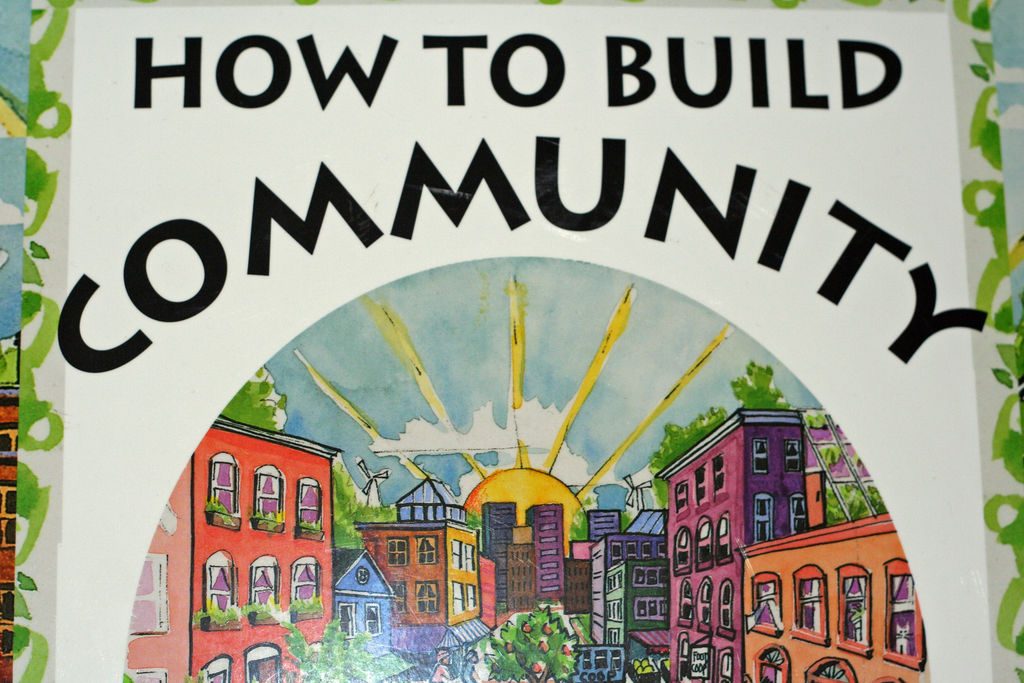
“If you are unable to understand the cause of a problem,
it is impossible to solve it.”
– Naoto Kan
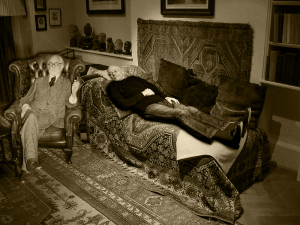
Most people think of psychologists in very traditional ways. For example, if you were to close your eyes and imagine a psychologist, there is a good chance you would think of a clinician or therapist. Clinical psychologists in their office settings often treat people with psychological problems one at a time by trying to change thought patterns, perceptions, or behavior. This is often called the “medical model” which involves a therapist delivering one-on-one psychotherapy to patients. There is a similar medical model in the field of medicine, and examples of this model would involve a physician fixing a patient’s broken arm or providing antibiotics for an infection. Although there is a clear need for this traditional model for those with medical or psychological problems, many do not have access to these services, and a very different approach will be required to successfully solve many of the individual and community problems that confront us.
Throughout this textbook you will learn about this different, strength-based approach, called Community Psychology. In the US, it emerged in the 1960s during a time when the nation was faced with protests, demonstrations, urban unrest, and intense struggles over issues such as the Vietnam War and the Civil Rights Movement. Many psychologists wanted to find ways to help solve these pressing societal issues, and some therapists were becoming increasingly disillusioned with their passive role in solely delivering the medical model, office-based psychotherapy (Cowen, 1973). At the 1965 Swampscott Conference in the US, the term “Community Psychology” was first used, and it signaled new roles and opportunities for psychologists by extending the reach of services to those who had been under-represented, focusing on prevention rather than just treatment of psychological problems, and by actively involving community members in the change process (Bennett et al., 1966). Over the past five decades, the field of Community Psychology has matured with recurring themes of prevention, social justice, and an ecological understanding of people within their environments. The goals of Community Psychology have been to examine and better understand complex individual–environment interactions in order to bring about social change, particularly for those who have limited resources and opportunities.
One of the primary characteristics of the Community Psychology field is its focus on preventing rather than just treating psychological problems, and this can occur by boosting individual skills as well as by engaging in environmental change. The example in the box below provides an example of prevention directed toward saving lives at a beach, as drowning is one of the leading causes of death.

Imagine a beautiful lake with a long sandy beach surrounded by high cliffs. You notice a person who fell from one of the cliffs and who is now flailing about in the water. The lifeguard jumps in the water to save him. But then a bit later, another person wades too far into the water and panics as he does not know how to swim, and the lifeguard again dives into the water to save him. This pattern continues day after day, and the lifeguard recognizes that she cannot successfully rescue every person that falls into the water or wades in too deep. The lifeguard thinks that a solution would be to install railings to prevent people from falling from the cliffs and to teach the others on the beach how to swim. The lifeguard then attempts to persuade local officials of the need for railings and swimming lessons. During months of meetings with town officials, several powerful leaders are hesitant about spending the money to fund the needed changes. But the lifeguard is persistent and finally convinces them that scrambling to save someone only after they start to drown is dangerous, and the town officials budget the money to install railings on the cliffs and initiate swimming classes.
This example highlights a key prevention theme in the field of Community Psychology, and in this case, the preventive perspective involved getting to the root of the problem and then securing buy-in from the community in order to secure resources necessary to implement the changes. As illustrated in the textbox above, there are two radically different ways of helping others, which are referred to as first- and second-order change. First-order change attempts to eliminate deficits and problems by focusing exclusively on the individuals. When the lifeguard on the beach dove into the water to save one person after another, this was an example of a first-order intervention. There was no attention to identifying the real causes that contributed to people falling into the water and being at risk for drowning, and this band-aid approach would not provide the structural changes necessary to protect others on the beach or walking on the cliffs. A more effective approach involves second-order change, the strategy the lifeguard ultimately adopted, and this involved installing railings on the cliff and the teaching of swimming skills. Such changes get at the source of the problem and provide more enduring solutions for the entire community. A real example of this approach involved low-income African American preschool children who participated in a preventive learning preschool program (called the High/Scope Perry Preschool)—40 years later, participants in this program were found to have better high school completion, employment, income, and lower criminal behavior (Belfield et al., 2005).
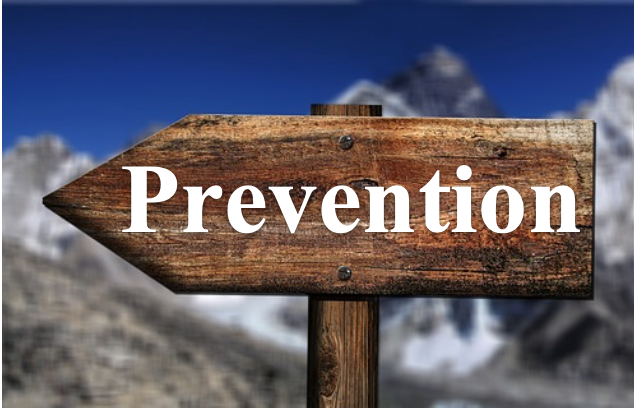
There is a considerable appeal for a preventive approach, particularly as George Albee (1986) has shown that no condition or disease has ever been eliminated by focusing just on those with the problem. Prevention is also strongly endorsed by those in medicine who have been trained in the Public Health model, where services are provided to groups of people at risk for a disease or disorder in order to prevent them from developing it. Public Health practitioners seek to prevent medical problems in large groups of individuals through, for example, immunizations or finding and eliminating the environmental sources of disease outbreaks. Community Psychology has adopted this preventive Public Health approach in its efforts to analyze social problems, in addition to its unique characteristics, which you will read below and throughout this textbook.
An impressive example of prevention occurred with community efforts to change the landscape of tobacco use over the past 60 years. Today, attitudes have changed toward tobacco use, and community organizations aided by community psychologists made important contributions to this second-order change effort that involved reducing tobacco use. This began with the landmark Surgeon General’s Report in the 1960s, which summarized serious health problems caused by smoking. Advocacy groups such as Action on Smoking and Health helped to create non-smoking sections on planes and public transportation, and other organizations used strategies to promote nonsmokers’ rights in public buildings, restaurants, and work areas. Still, other work involved preventive school and community-based interventions as well as efforts to reduce youth access to tobacco, as shown in Case Study 1.1.
Case Study 1.1
Youth Tobacco Prevention

In the 1980s, school students informed community psychologist Leonard Jason that store merchants were openly selling them cigarettes. The students’ critical input was used to launch a study assessing illegal commercial sales of tobacco, and Jason’s team found that 80% of stores in the Chicago metropolitan area sold cigarettes to minors. When results of this study were publicized on the evening television news, Officer Bruce Talbot from the suburban town of Woodridge, Illinois contacted Jason to express interest in working on this community problem. Talbot and the Woodridge police with technical help from Jason’s team collected data showing that the majority of Woodridge merchants sold tobacco to minors. With these data, Woodridge passed legislation that fined both vendors caught illegally selling tobacco and minors found in possession of tobacco. Two years after implementing this program, rates of stores selling to minors decreased from an average of 70% to less than 5%. Woodridge was the first city in the US to demonstrate that cigarette smoking could be effectively decreased through legislation and enforcement. Jason later testified at the tobacco settlement hearings at the House Commerce Subcommittee on Health and Environment. Due to this study, Officer Talbot had become a national authority on illegal sales of cigarettes to minors. Talbot advised communities throughout the country on how to establish effective laws to reduce youth access to tobacco, and he testified at congressional hearings in Washington D.C. in support of the Synar Amendment, which required states to reduce illegal sales of tobacco to minors using similar methods to those developed in Woodridge. Due to the enactment of the Synar Amendment, there has been a 21% nationwide decrease in the odds of tenth graders becoming daily smokers (Jason, 2013).
This case study illustrates how preventive government policies can be fostered by community-based groups, with the support of community psychologists. These are referred to as bottom-up approaches to second-order change, as the policies emerge from concerned individuals, community activists, and coalitions. Community psychologists have clear roles to play in dialoguing and collaborating with community groups in these types of broad-based, preventive community change efforts.
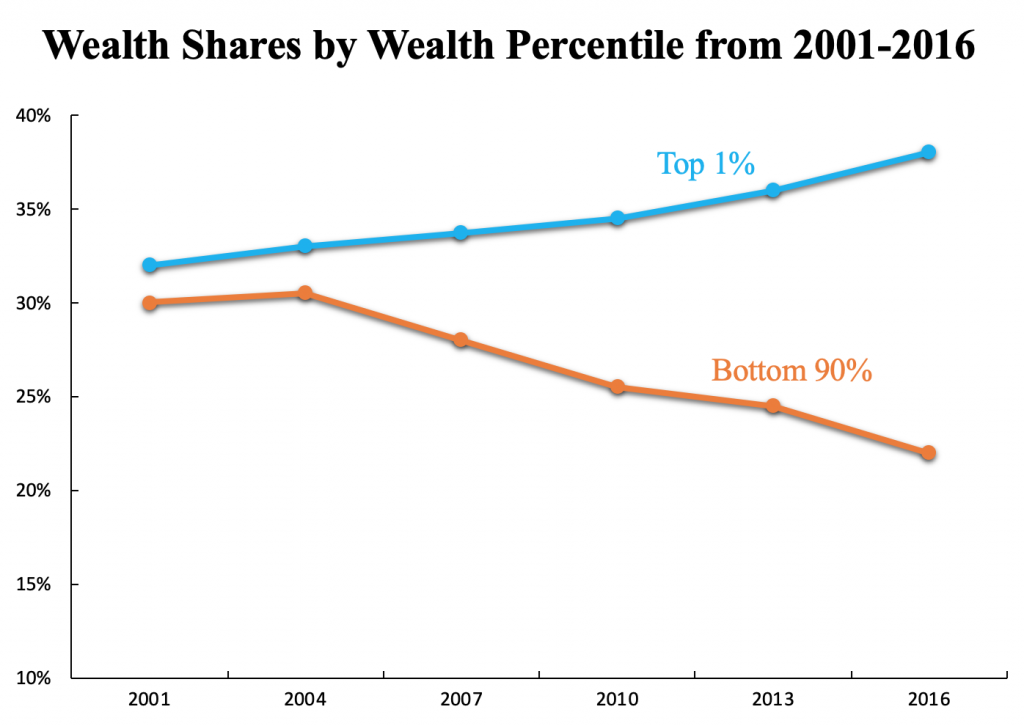
Community Psychology’s focus on social justice is due to the recognition that many of our social problems are perpetuated when resources are disproportionately allocated throughout our society; this causes social and economic inequalities such as poverty, homelessness, underemployment and unemployment, and crime. Albee (1986) has concluded that societal factors such as unemployment, racism, sexism, and exploitation are the major causes of mental illness. In support of this, Richard Wilkinson and Kate Pickett’s (2009) book The Spirit Level documents how many health and social problems are caused by large inequalities throughout our societal structure. Economic inequalities not only cause stress and anxiety but also lead to more serious health problems. Studies of income inequality have shown how adult incomes have varied by race and gender, and this link allows you to make comparisons that provide animations for any combination of race, gender, income type, and household income level. Clearly, we need to look beyond the individual in exploring the basis of many of our social problems. Yet, most mental health professionals, including psychologists, have a tendency to try to solve mental health problems without attending to these environmental factors.
Community Psychology endorses a social justice and critical psychology perspective which looks at how oppressive social systems preserve classism, sexism, racism, homophobia, and other forms of discrimination and domination that perpetuate social injustice (Kagan, 2011). Clearly, there is a need to bring about a better society by dismantling unjust systems such as racism. In addition to identifying and combating systems that are unjust, community psychologists also challenge more subtle negative practices supported by psychological research and practice. For example, a person with a social justice orientation would object to imposing intervention manuals, based on white middle-class norms, on low-income minority students. Such materials would not be applicable or appropriate to the lived experiences of minority students.
The need for this social justice orientation is also evident when working with urban schools that are dealing with a lack of resources, overcrowded classrooms, community gang activity, and violence. Traditional mental health services such as therapy that deals with a student’s mental health issues would not address the income resource inequalities and stressful environmental factors that could be causing children’s mental health difficulties. Second-order change strategies, in contrast, would address the systems and structures causing the problems and might involve collaborative partnerships to bring more resources to the school as well as support community-based efforts to reduce gang activity and violence. As an example, Zimmerman and colleagues investigated what it takes to cultivate a safe environment where youth can grow up in a safe and healthy context (Heinze et al., 2018). These community psychologists found that improving physical features of neighborhoods such as fixing abandoned housing, cutting long grass, picking up trash, and planting a garden resulted in nearly 40% fewer assaults and violent crimes than street segments with vacant, abandoned lots.
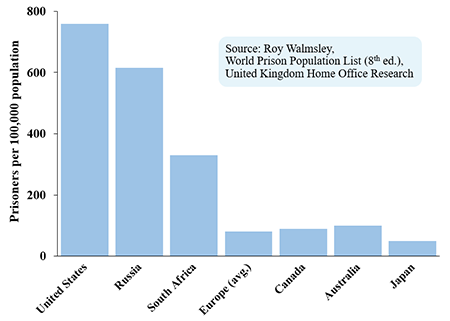
This social justice perspective can also be used to examine the institutionalization of millions of individuals in the US criminal justice system. According to an individualistic perspective, people end up in prison because of factors such as mental illness, substance abuse, or a history of domestic violence. On the other hand, the Community Psychology social justice perspective posits that larger, structural forces (e.g., political, cultural, environmental, and institutional factors) need to be considered. A social justice perspective recognizes that millions of people have been locked up in US prisons due to more restrictive and punishing laws (such as mandatory minimums, and three-strikes which requires lifetime prison sentences), and there have been changes in how we have also dealt with patients in mental institutions. Through the 1960s and 1970s, many state-run mental hospitals were closed, which meant that discharged patients were supposed to be treated in our communities. However, funding to support these community-based treatment programs was significantly reduced in the 1980s, and as a consequence, many former patients of mental institutions became homeless or involved with the criminal justice system. Unfortunately, our prison system became the new settings where mentally ill people were warehoused. This is an example of first–order change, which has involved shifting mental patients from one inadequate institutional setting to another. Adopting a social justice perspective clearly broadens our understanding as to why millions of people in the US are incarcerated.
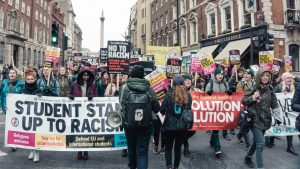
The tragedy of being forced to live in overcrowded and unsafe prisons is further compounded by the way 600,000 or more prison inmates are released back into communities in the US. Most prisons have at best meager rehabilitation programs, so most inmates have not been adequately prepared for transitioning back into our communities. Clearly, criminally justice-involved people need more than weekly psychotherapy provided by traditional clinical psychologists.
Individuals who are released from jail uniformly state their greatest needs are for safe housing and employment but are rarely provided these critical resources. Given these circumstances, we should not be surprised that so many released inmates soon return to prison. A moving story by Scott about his heroin addiction and prison experiences is in Case Study 1.2.
Case Study 1.2
A Chance for Change through Oxford House

“I was born to an addicted mother who was a heroin addict and meth user as well. She left when I was 2 and I’ve only seen my mother one time when I was 17. I was adopted by my grandparents and was raised in a great family. I grew up having the best things in life and I was a standout sports player in high school until my life took a turn – for the worst. I dabbled with drugs and, after an injury that caused me to never play again, I turned to drugs. I became addicted to cocaine and meth and painkillers. Thinking I had it all under control, I caught my first felony and was sent to prison at 19. I became a prison gang member and later on was a gang leader of one of the most dangerous and second-largest gangs in the United States prison system. Once released after two years, I got out and didn’t know how to readjust to living normal. I started using Heroin and my life and addiction became the worst. Nineteen days later I was charged with an organized crime case and after bonding out, I went to treatment but never took it seriously. I was just addicted to the money and power I possessed and, no matter how much my family begged me to just stop, I went back to shooting dope… I was given a 7-year sentence and I served six and a half years at the deadly Ferguson unit here in Texas. Five years of that I spent in solitary confinement, locked down 23 hours a day due to my gang affiliations and actions in prison where I continued to use drugs and was just as much strung out as if I was still in the world. In 2013, I was paroled back home. I only lasted five months and was indicted on 2 first-degree felonies and offered 80 years. I went to jury trial where I was found not guilty but ended up with another indictment that I signed a five-year sentence for. I did four years, eight months, on that charge and was released back home in 2018. I lasted 2 days until I relapsed once again [on] heroin and on July 24, I did the last shot of heroin I’ll ever do. I overdosed and died in the ambulance only to be brought back and I woke up in Red River Detox, beat down and broken. I was there when I saw Philip and Cristen came to do a presentation. As I listened to Philip tell his story, I saw myself in him and realized that this is what I want. I wanted to finally make it and live a real life so I got into Oxford House where I’m sober today, working have my family back in my life and holding my head up high each day because I can stand to look at the man in the mirror. I owe this to Oxford Chapter 14; they have saved my life and now I’m Re-Entry coordinator and have a chance to help people like me get a chance of making it. Thank you, Oxford House” (Oxford House Commemorative Program, 2018, page 57).
This case study shows that the social justice needs for individuals coming out of prison include community-based programs that provide stable housing, new connections in terms of friends, and opportunities to earn money from legal sources. Oxford House, which is mentioned in this case study, is a community-based innovation for re-integrating people back into the community. The Oxford House network was started by people in recovery with just one house in 1975, and today it is the largest residential self-help organization that provides housing to over 20,000 people in cities and states throughout the US. The houses are always rented, and house members completely self-govern these homes without any help from professionals. Residents can live in these Oxford Houses indefinitely, as long as they remain abstinent, follow the house rules, and pay a weekly rent of about $100 to $120 per week. Oxford Houses represent the types of promising social and community grassroots efforts that can offer people coming out of prisons and substance abuse treatment programs a chance to live in an environment where everyone is working, not using drugs, and behaving responsibly. Best part of all is that this program is self-supporting, as the residents rather than prison or drug abuse professionals are in charge of running each home. Here, the residents use their income from working to pay for all house expenses including rent and food (this video illustrates the Oxford House approach in a brief segment on the 60 Minutes TV broadcast). There are these types of innovative grassroots organizations throughout our communities, and community psychologists have key roles to play in helping to document the outcomes of these true incubators of social innovation, as illustrated on this link.
The prevention and social justice examples that we have provided above about installing railings at the cliff to prevent people from accidentally falling into the water or providing housing for those exiting from prison are examples of changing the environment or context. In fact, there is now considerable basic laboratory research that indicates that context or environment can have a shaping influence on the lives of humans and animals. For example, laboratory rats who are raised in “enriched” environments show brain weight increases of 7-10% (heavier and thicker cerebral cortexes) in comparison to those in “impoverished” environments (Diamond, 1988). There was a time when scientists did not believe that the brain could be changed by any environmental enrichment, but it is now commonly accepted that context can have a lasting and shaping influence on our behavior and even our brains. We need to attend to the environments of those living in poverty and exposed to high levels of crime, as these factors are associated with multiple negative outcomes including higher rates of chronic health conditions.
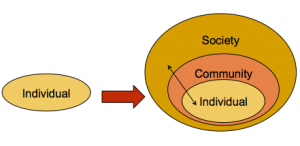
An aspect of Community Psychology that sets it apart from a more traditional Clinical Psychology is a shift beyond an individualistic perspective. Community psychologists consider how individuals, communities, and societies are interconnected, rather than focusing solely on the individual. As a result, the context or environment is considered an integral part when trying to understand and work with communities and individuals embedded in them.
This shift in thinking is referred to as an ecological perspective. Ecological means that there are multiple levels or layers of issues that need to be considered, including the individual, family, neighborhood, community, and policies at the national level. For example, let’s continue our examination of the criminal justice system with another case example. A person, who we shall call Jane, had been involved in an auto accident causing severe pain, and subsequently became addicted to painkillers. When it became more difficult to purchase these medications, she began using heroin to reduce the pain, became involved in buying and selling illegal substances, became estranged from her family, and was caught and sentenced to prison. At the individual level, Jane is certainly distressed and addicted to painkillers, and this has now disrupted relationships with her family and friends. But an ecological perspective would point to a number of factors beyond the individual and group level contributing to this unfortunate situation. Health care organizations contributed to this problem, as many physicians were all too willing to profit by overprescribing pain medications to their patients. The pharmaceutical industry was part of the problem as they reaped huge profits by oversupplying these drugs to pharmacies. At the community level, the criminal justice system also shares blame for delivering punishment in crowded, unsafe prisons for individuals clearly in need of substance use treatment. Finally, at a societal level, federal regulators allowed opiate drugs like OxyContin to be sold for long-term rather than just short-term use, and legislators inappropriately passed laws extending sentences for those who are in prison due to offenses caused by substance use disorders. These types of difficult and complex social problems are produced and maintained by multiple ecological influences, and corrective second–order community solutions will have to deal with these contextual issues.

In addition to thinking about these multiple ecological levels, the community psychologist James Kelly (2006) has proposed several useful principles that help us better understand how social environments affect people. For example, the ecological principle of “interdependence” indicates that everything is connected, so changing one aspect of a setting or environment will have many ripple effects. For example, if you provide those released from prison a safe place to live with others who are gainfully employed (as occurs in Oxford Houses), this setting can then lead to positive behavior changes. Living among others in recovery provides a gentle but powerful influence for spending more time in work settings in order to pay for rent and less time in environments with high levels of illegal activities. The ecological principle of “adaptation” indicates that behavior adaptive in one setting may not be adaptive in other settings. A person who was highly skilled at selling drugs and stealing will find that these behaviors are not adaptive or successful in a sober living house, so the person will have to learn new interpersonal skills that are adaptive in this recovery setting. The ecological perspective broadens the focus beyond individuals to include their context or environment, by requiring us to think about how organizations, neighborhoods, communities, and societies are structured as systems.
This ecological perspective helps us move beyond an individualistic orientation for understanding many of our significant social problems such as homelessness, which in the US affects over a half a million people (National Alliance to End Homelessness, 2018). At the individual level, many of these individuals do suffer from substance abuse and mental health problems, and they often cycle in and out of the criminal justice system. However, the ecological perspective would focus attention on the lack of affordable housing for low-income people, and thus call for higher-order interventions that go beyond the individual. As an example, Housing First is an innovative intervention founded by clinical-community psychologist Sam Tsemberis, which provides the homeless a home first and then treatment services. This Community Psychology intervention is based on the belief that by providing housing first, there will be many positive ripple effects that lead to beneficial changes in the formerly homeless person’s behaviors and functioning. In this video link, Sam talks about the founding of Housing First innovation, which is a model now used throughout the US.
In Case Study 1.3 below is the story of Russell, who used the Housing First program to find a home and successfully integrate back into the community.
Case Study 1.3
Pathways to Housing: Russell’s Story
“Russell grew up in Southeast DC before becoming homeless more than three decades ago. Struggling with schizophrenia, Russell was in and out of jail and the hospital. He spent the last ten years sleeping on a park bench downtown. This fall, with the help of his Pathways team, Russell moved off the streets and into a permanent apartment. For the first time since 1980, Russell finally has a roof over his head and a place to call home. His favorite thing about the new space? “The television.” A die-hard Washington Redskins fan, Russell is thrilled to be able to cheer his team on—hopefully all the way to the Super Bowl—from the comfort of his living room. For Russell though, it is more than just watching his favorite team play. After just two months, Russell is beginning to thrive in his new home. He has accomplished a number of personal goals including saving to buy a new bike (Russell is a former DC courier) and attending his first-ever Nationals game. Because of you, Russell will not be out in the cold this winter” (Pathways to Housing: Russell’s Story).
The ecological perspective provides an opportunity to examine the issues associated with homelessness beyond the individual level of analysis. Through this framework, we can understand homelessness within complicated personal, organizational, and community systems. In the case of Russell described in the above case study, at the individual level he was dealing with chronic stress, poor health, and mental illness, and felt hopeless. But his sense of despair was in part due to a group level factor, which was the lack of available support from friends or family members. Providing him temporary shelter at night and access to food kitchens represented first-order, individualistic solutions that had never been successful. The Housing First innovation was at a higher environmental level, and once placed in this permanent supportive setting, it had ripple effects on Russell’s sense of hope, connection with others, and ultimately his improved quality of life. Outcome studies have indicated that Housing First is successful in helping vulnerable individuals gain the resources to overcome homelessness, and this program was included in the Substance Abuse and Mental Health Services Administration’s National Registry of Evidence-Based Programs.
This ecologic perspective can also be applied to more preventive interventions, such as when Thompson and Jason (1988) stopped gang recruitment by providing urban youth anti-gang classroom sessions and after-school activities that consisted of organized sports clinics that encouraged intragroup cooperation as well as opportunities to travel out of their neighborhood to participate in events and activities with similar groups from other locations. However, those only provided the person-centered anti-gang classroom sessions were still vulnerable to being recruited by gangs after school. There are many examples of how a multi-scale, ecological systems model of people-environment transactions can broaden our understanding of societal problems (Stokols, 2018).

There are other key features of the field of Community Psychology, as will be described in the subsequent chapters, and below we briefly review them.

Community Psychology has a respect for diversity and appreciates the views and norms of groups from different ethnic or racial backgrounds, as well as those of different genders, sexual orientations, and levels of abilities or disabilities. Community psychologists work to counter oppression that is due to racism (white persons have access to resources and opportunities not available to ethnic minorities), sexism (discrimination directed at women), heterosexism (discrimination toward non-heterosexuals), and ableism (discrimination toward those with physical or mental disabilities). The task of creating a more equitable society should not fall on the shoulders of those who have directly experienced its inequalities, including ethnic minorities, the disabled, and other underprivileged populations. Being sensitive to issues of diversity is critical in designing interventions, and if preventive interventions are culturally-tailored to meet the diverse needs of the recipients, they are more likely to be appreciated, valued, and maintained over time.
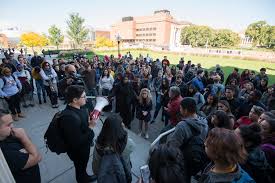
Paulo Freire (1970) wrote that change efforts begin by helping people identify the issues they have strong feelings about, and that community members should be part of the search for solutions through active citizen participation. Involving community groups and community members in an egalitarian partnership is one means of enabling people to re-establish power and control over the obstacles or barriers they confront. When our community partners are recognized as experts, they are able to advocate for themselves as well as for others, as indicated in Case Study 1.1 that described how Officer Talbot became an activist for reducing youth access to tobacco. Individuals build valuable skills when they help define issues, provide solutions, and have a voice in decisions that ultimately affect them and their community. This Community Psychology approach shifts the power dynamic to a less hierarchical, more equal relationship, as all parties participate in the decision-making. Community members are seen as resources who provide unique points of view about the community and the institutional barriers that might need to be overcome in social justice interventions. All partners are involved equally in the research process in what is called community-based participatory research.
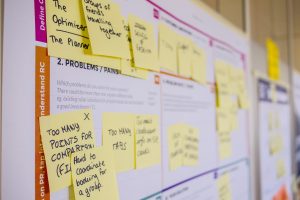
In striving to understand the relationship between social systems and individual well-being, community psychologists base advocacy and social change on data that are generated from research and apply a number of evaluation tools to conceptualize and understand these complex ecological issues. Community psychologists believe that it is important to evaluate whether their policy and social change preventive interventions have been successful in meeting their objectives, and the voice of the community should be brought into these evaluation efforts. They conduct community-based action-oriented research and often employ multiple methods including what are called qualitative, quantitative, and mixed methods research (Jason & Glenwick, 2016). No one method is superior to another, and what is needed is a match between the research methods and the nature of the questions asked by the community members and researchers. Community psychologists, like Durlak and Pachan (2012), have used adventuresome research methods to investigate the effects of hundreds of programs dedicated to preventing mental health problems in children and adolescents, and the findings showed positive outcomes in terms of improved competence, adjustment, and reduced problems.
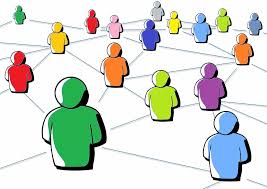
Social issues are complex and intertwined throughout every fiber of our society, as pointed out by the ecological perspective. When working with individuals who have been marginalized and oppressed, it is important to recognize that issues such as addiction and homelessness require expertise from many perspectives. Community Psychology promotes interdisciplinary collaboration with professionals from a diverse array of fields. For example, a community psychologist helped put together the multidisciplinary team evaluating Oxford House efforts to help re-integrate individuals with substance use problems back into the community. One member of the team was a sociologist who studies social networks, and one of the important findings was that the best predictor of positive long-term outcomes was having at least one friend in the recovery houses. Also, part of this team was an economist who found that the economic benefits were greater, and costs were less for this Oxford House community intervention than an intervention delivered by professionals. Other important contributions were made by a social worker, a Public Health researcher, Oxford House members, and undergraduate and graduate students who each contributed unique skills and valuable perspectives to the research team. You can see how these types of collaborations can emerge by using the idea tree exercise, which different disciplines can work together to create new ideas and advance knowledge across fields.
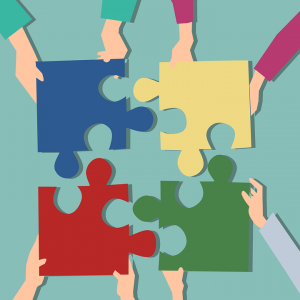
One of the core values of Community Psychology is the key role of psychological sense of community, which describes our need for a supportive network of people on which we can depend. Promoting a healthy sense of community is one of the overarching goals of Community Psychology, as a loss of connectedness lies at the root of many of our social problems. So understanding how to promote a sense of belonging, interdependence, and mutual commitment is integral to achieving second-order change. If people feel that they exist within a larger interdependent network, they are more willing to commit to and even make personal sacrifices for that group to bring about long-term social changes. From a Community Psychology perspective, an intervention would be considered unsuccessful if it increased students’ achievement test scores but fostered competition and rivalry that damaged their sense of community.

Another important feature of Community Psychology is empowerment, defined as the process by which people and communities who have historically not had control over their lives become masters of their own fate. People and communities who are empowered have greater autonomy and self-determination, gain more access to resources, participate in community decision-making, and begin to work toward changing oppressive community and societal conditions. As shown in Case Study 1.3, individuals such as Russell who have been homeless often feel a lack of control over their lives. However, once provided stable housing and connections with others, they feel more empowered and able to gain the needed resources to improve the quality of their lives.

Community psychologists also enter the policy arena by trying to influence laws and regulations, as illustrated by the work on reducing minors’ access to tobacco described in Case Study 1.1. Community psychologists have made valuable contributions at local, state, national, and international levels by collaborating with community-based organizations and serving as senior policy advisors. It is through policy work that over the last century, the length of the human lifespan has doubled, poverty has dropped by over 50%, and child and infant mortality rates have been reduced by 90%.
Over the next decades, there is a need for policy-level interventions to help overcome dilemmas such as escalating population growth (as this will create more demands on our planet’s limited drinking water, energy, and food resources), growing inequalities between the highest and lowest compensated workers (which will increasingly lead to societal strains and discontent as automation and artificial intelligence will eliminate many jobs), increasing temperatures due to the burning of fossil fuels (which will result in higher sea levels and more destructive hurricanes), and the expanding needs of our growing elderly population. The principles of Community Psychology that have been successfully used to change policy at the local and community level might also be employed to deal with these more global issues that are impacting us now, and will increasingly do so in the future. This video link shows what is possible when we reflect upon policy.

Finally, the promotion of wellness is another feature of Community Psychology. Wellness is not simply the stereotypical lack of illness, but rather the combination of physical, psychological, and social health, including attainment of personal goals and well-being. Furthermore, Community Psychology applies this concept to also include groups of people, and communities—in a sense, collective wellness.
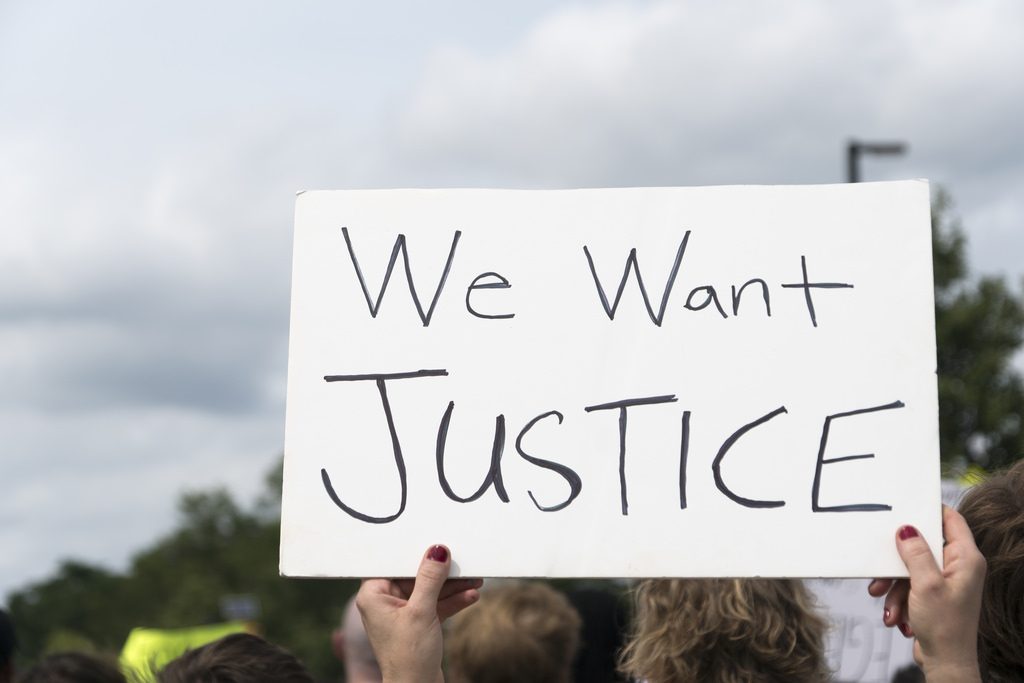
This chapter has reviewed the key features of the Community Psychology field, including its emphasis on prevention, its social justice orientation, and its shift to a more ecological perspective. The case studies presented in this chapter illustrate ways in which community psychologists have engaged in systemic and structural changes toward social justice. Students who read the chapters of this textbook will learn how we can mount in community-based research and practices that emphasize fair and equitable allocation of resources and opportunities. This social justice perspective of Community Psychology recognizes inequalities that often exist in our society. Our field works toward providing greater access to resources and decision making, particularly for communities that have been marginalized and oppressed.
Critical Thought Questions
Take the Chapter 1 Quiz
View the Chapter 1 Lecture Slides
____________________________________________________________________
Albee, G. (1986). Toward a just society. Lessons from observations on the primary prevention of psychopathology. The American Psychologist, 41(8), 891-898. doi:10.1037//0003-066X.41.8.891
Badger, E., Miller, C. C., Pearce, A., & Quealy, K. (2018). Income mobility charts for girls, Asian-Americans and other groups. Or make your own. The New York Times, The Upshot. Retrieved from https://www.nytimes.com/interactive/2018/03/27/upshot/make-your-own-mobility-animation.html
Brickler, J., Dettling, L. J., Henriques, A., Hsu, J. W., Jacobs, L., Moore, K. B., …Windle, R. A. (2017, September). Changes in U.S. family finances from 2013 to 2016: Evidence from the Survey of Consumer Finances. Washington, DC: Federal Reserve Bulletin. Retrieved from https://www.federalreserve.gov/publications/files/scf17.pdf
Belfield, C., Barnett, W., & Schweinhart, L. (2005). Lifetime effects: The High/Scope Perry Preschool study through age 40 (Monographs of the High/Scope Educational Research Foundation, no. 14). Ypsilanti, MI: High/Scope Press.
Bennett, C. C., Anderson, L. S., Cooper, S., Hassol, L., Klein, D. C., & Rosenblum, G. (1966). Community Psychology: A report of the Boston Conference on the Education of Psychologists for Community Mental Health. Boston, MA: Boston University Press.
Cowen, E. (1973). Social and community interventions. Annual Review of Psychology, 24(1), 423–472.
Diamond, M.C. (1988). Enriching heredity: The impact of the environment on the anatomy of the brain. New York, NY: Free Press.
Durlak, J. A., & Pachan, M. (2012). Meta-analysis in community-oriented research. In. L. A. Jason & D. S. Glenwick (Eds.), Methodological approaches to community-based research. (pp. 111-122). Washington, DC: American Psychological Association.
Freire, P. (1970). Pedagogy of the oppressed. New York, NY: Herder and Herder.
Heinze, J. E., Krusky-Morey, A., Vagi, K. J., Reischl, T. M., Franzen, S., Pruett, N. K., …Zimmerman, M. A. (2018). Busy streets theory: The effects of community-engaged greening on violence. American Journal of Community Psychology, 62(1-2), 101-109. doi:10.1002/ajcp.12270
Jason, L. A. (2013). Principles of social change. (pp. 17-21). New York, NY: Oxford University Press.
Jason, L. A. & Glenwick, D. S. (Eds.). (2016). Handbook of methodological approaches to community-based research: Qualitative, quantitative, and mixed methods. New York, NY: Oxford University Press.
Kagan, C., Burton, M., Duckett, P., Lawthom, R., & Siddiquee, A. (Eds.). (2011). Critical Community Psychology (1st ed.). West Sussex, UK: Wiley-Blackwell.
Kelly, J. G. (2006). Being ecological: An expedition into Community Psychology. New York, NY: Oxford University Press.
Oxford House, Inc. (2018). Oxford House Recovery Stories. 2018 Annual Oxford House World Convention. Kansas City, Missouri.
Pathways to Housing: Russell’s story. Retrieved from https://www.pathwaystohousingdc.org/stories/russell
Stokols, D. (2018). Social ecology in the digital age: Solving complex problems in a globalized world. London, UK: Academic Press. Retrieved from https://www.elsevier.com/books/social-ecology-in-the-digital-age/stokols/978-0-12-803113-1
State of homelessness. National Alliance to End Homelessness. Retrieved from https://endhomelessness.org/homelessness-in-america/homelessness-statistics/state-of-homelessness-report/
Thompson, D. W., & Jason, L. A. (1988). Street gangs and preventive interventions. Criminal Justice and Behavior, 15, 323-333.
Wilkinson, R., & Pickett, K. (2009). The spirit level: Why more equal societies almost always do better. Essex, England: Allen Lane.
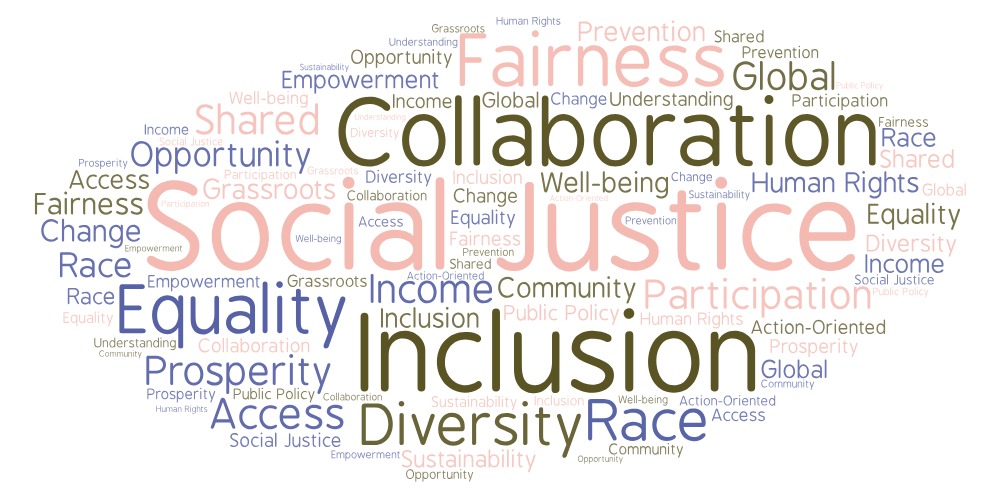
Interests into Action with SCRA!
SCRA has several interest groups that provide networking opportunities and diverse ways to pursue interests that matter to you. Find out more at here!
Acknowledgments: We wish to thank Bridget Harris and Laura Sklansky for their superb help in editing this chapter, as well as Mark Zinn for his expert assistance with helping us overcome a wide range of internet and computer problems.
Chapter Two Objectives
By the end of this chapter, you will be able to:

Any historical account (whether it involves politics, culture, or a profession) is bound to be subjective, so it makes sense that much of the history of the field of Community Psychology will also be subjective. Most existing Introductory Community Psychology textbooks (Jason, Glantsman, O’Brien, & Ramian, 2019; Kloos, Hill, Thomas, Wandersman, Elias, & Dalton, 2012; Moritsugu, Duffy, Vera, & Wong, 2019) begin by discussing the social, political, scientific, and professional contexts that influenced the development of the field. Although we will review some of this history briefly, we will focus mainly on the past 50-plus years, since the term Community Psychology was first used by those attending what we now call the “Swampscott Conference” of 1965 (Bennett et al., 1966).
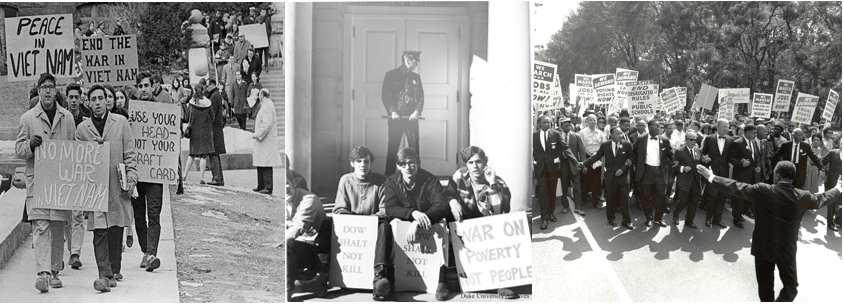
One needs to consider the social and political events of the 1960s in understanding the beginnings of Community Psychology. These were turbulent times, marked with protests and demonstrations involving the Civil Rights movement in the US. In 1965, the Voting Rights Act, an important accomplishment of the Civil Rights Movement, was signed into law by President Lyndon Johnson. The Feminist Movement was also developing momentum during the 1960s and into the 1970s, as would a similar rights movement for gays and lesbians, the environmental movement, and widespread protests against the Vietnam war. This socially-conscious atmosphere was ideal for the development of the field of Community Psychology, whose values emphasized social justice.

During this time, there also was widespread deinstitutionalization of mental patients, as various media accounts portrayed horrendous conditions in mental hospitals. The development of antipsychotic medications such as Thorazine and the growing research evidence on the harmful effects of mental hospitalization (e.g., Goffman) were key factors in this movement. In 1961, the report of the Joint Commission on Mental Health and Illness was released, which recommended that we reduce the size of mental hospitals and train more professionals and paraprofessionals to meet the largely unmet need for mental health services in our society (Bloom, 1975). These recommendations, vigorously championed by President Kennedy, led directly to the passage of the 1963 Community Mental Health Centers Act, which established community-based services widely throughout the nation. The Community Mental Health Movement was gaining momentum and many large state mental hospitals across the nation would be closed in the next 20 years. With these developments in the background, it was in 1965 that a group of clinical psychologists gathered in Swampscott, MA, and gave birth to the field of Community Psychology, which they hoped would allow them to become social change agents to address many of these pressing social justice issues of the 1960s. Click on this link for a more comprehensive description of events that led up to the Swampscott Conference.
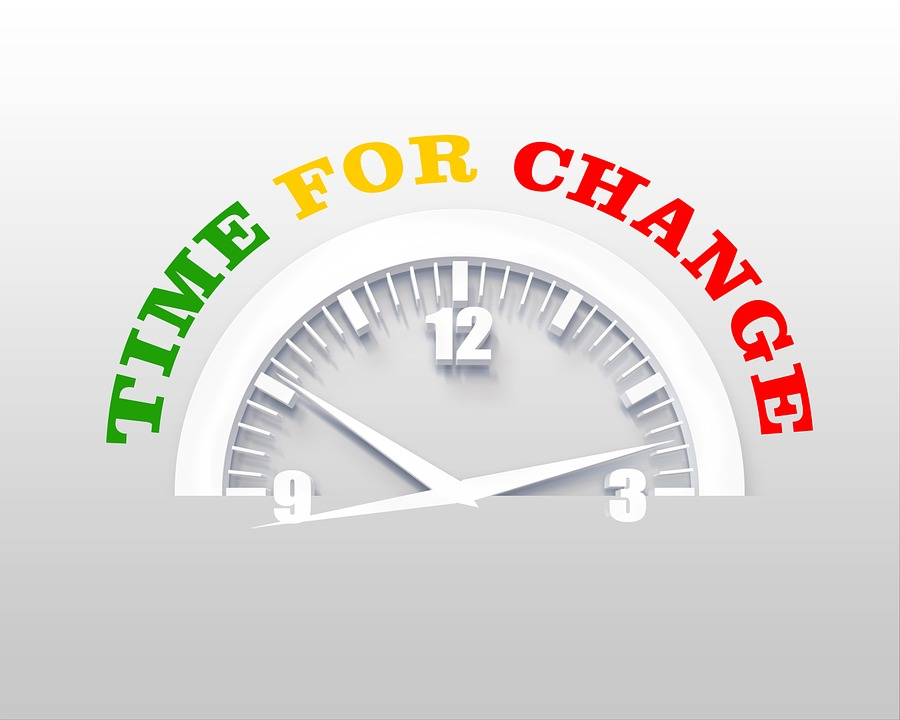
In the years immediately after the 1965 Swampscott Conference, a number of training programs in community mental health and Community Psychology developed. For example, Ed Zolik established one of the first clinical-community doctoral programs in the US at DePaul University in 1966. A free-standing doctoral program was also established in 1966 at the University of Texas at Austin by Ira Iscoe. By 1969, there were 50 programs offering some training in Community Psychology and community mental health, and by 1975 there were 141 graduate programs offering training in these areas.
Several important “early settings” for community research and action also developed, often in connection with one of the training programs. These settings included the Primary Mental Health Project at the University of Rochester, founded by Emory Cowen (1975) (click here to see a video of Cowen describing this innovative program). The Primary Mental Health Project identified children in the primary grades (K-3) showing some initial trouble adjusting to school and provided help through the school year from paraprofessional child associates. Cowen, his graduate students, and staff built this intervention for a single school in Rochester in 1958 and it is used by 2,000 schools worldwide today. The Primary Mental Health Project was one of the first widely researched and publicized prevention programs developed by community psychologists. Cowen provided training for a large number of people who later would become prominent in Community Psychology (below is Cowen’s “family tree” initially developed by Fowler & Toro, 2008a).
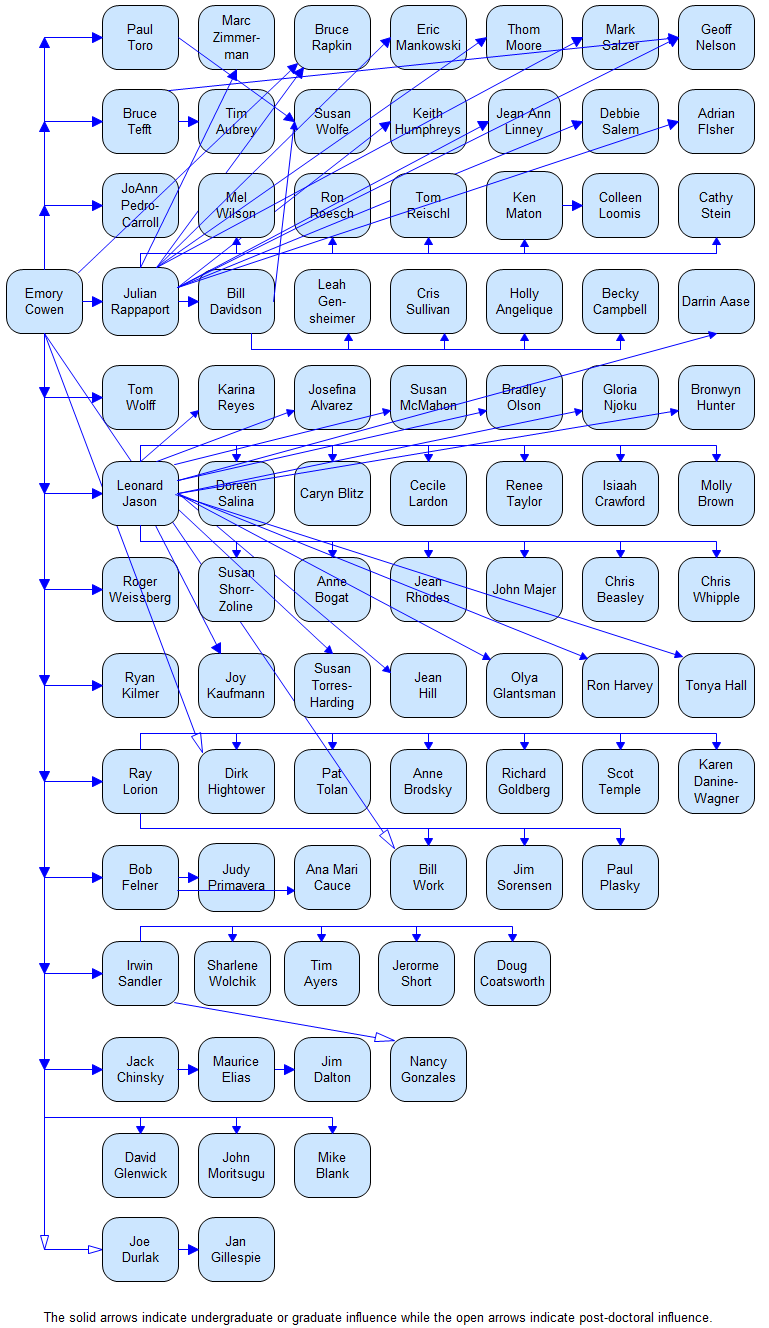
The Community Lodge project, initially developed by George Fairweather at a Veteran’s Administration psychiatric hospital, was another of these important “early settings.” The Lodge provided an alternative to traditional psychiatric care by preparing groups of hospitalized mental patients in a shared housing environment for simultaneous release into the community. The released patients established a common business to support themselves (e.g., a lawn care service) and eventually took full control of the Lodge project from the professionals who helped them establish the Lodge initially. The first rigorous evaluation of the Lodge found that patients randomly assigned to the Lodge spent less time in a hospital than those in the control group who received traditional services (see Fairweather et al., 1969). Fairweather later helped to establish the doctoral program in Ecological Psychology at Michigan State University and also provided training for many community psychologists.

In 1966, just a year after the Swampscott conference, Division 27 (Community Psychology) of the American Psychological Association (APA) was established. Shortly after, James Kelly (1966), one of the Swampscott attendees and another “founder” of Community Psychology, published an article on the ecological perspective in the widely circulated American Psychologist. Like Cowen and Fairweather, Kelly has been important in training a large number of community psychologists.
The Journal of Community Psychology and the American Journal of Community Psychology were both first published in 1973. These journals have become the two most influential professional journals in the field. The first Community Psychology textbooks came out during the field’s first decade (Bloom, 1975; Zax & Spector). Both of these texts viewed Community Psychology as an outgrowth of the broader field of Clinical Psychology. Over time, the field would portray Community Psychology in a much broader context, deriving from many other sources in addition to Clinical Psychology. Other important publications of this first decade included Ryan’s Blaming the Victim (still, today, one of the most cited publications in the field) and Cowen’s Annual Review of Psychology chapter on social and community interventions. At the end of this decade, the Austin Conference was an opportunity to bring together the key figures in this field during the first 10 years, and provide informal opportunities to examine the field’s conceptual independence from clinical psychology.

The late 1970s and early 1980s could be considered the “heyday” of Community Psychology. During this time period, the political climate made Community Psychology both relevant and necessary, and membership in the US in APA’s Division 27 (Community Psychology) rose to over 1,800 in 1983 (Toro, 2005, p.10).
The first Midwest Ecological Community Psychology Conference took place in 1978 at Michigan State University. This conference provided an opportunity for like-minded community psychologists and students to get together informally to discuss new developments, new training programs, and new research. This conference has now expanded beyond the Midwest to other regions of the US. These conferences have provided a new generation of community psychologists opportunities to put their theoretical ideas about collaboration, empowerment, and the creation of health-promoting settings into practice in their own environments. For a history of these conferences, see Flores, Jason, Adeoye, Evans, Brown, and Belyaev-Glantsman. Case Study 2.1 provides more information about students assuming a major role in the conference’s organization over time.
Case Study 2.1
Students Assume Leadership Roles at the Midwest Ecological Community Psychology Conference

Professors planned and organized the first few informal Midwest Ecological Community Psychology Conferences, but something very special happened in 1980 at the conference at Bowling Green State University. At the end of that meeting, several community psychologists were in a room discussing who would host next year’s event, when a graduate student in the room spoke up suggesting that because the conference was meant for graduate students, then the students should be planning and organizing it. Following this suggestion, students from the University of Illinois Chicago began the long-standing tradition of these conferences being student-run. The Midwest Ecological Community Psychology Conferences have kept going since then with student leadership. This informal support system has led to many networking opportunities over the years for faculty and students to get to know each other, and it has led to many job and training opportunities. As an example, at one of these meetings, Stephen Fawcett was invited to participate in a session to demonstrate how behavioral approaches could be integrated into the field of Community Psychology. Fawcett brought two of his graduate students, Yolanda Suarez-Balcazar and Fabricio Balcazar, and both had a chance to meet Chris Keys at the meeting. This contact eventually led to both graduate students finding their first jobs in Chicago. This is just one example of the networking that continues to lead to important professional and personal relationships among attendees of this student-run conference.
During this second decade, many community psychologists in the US became dissatisfied with the field of Community Psychology’s association as one of APA’s many Divisions. There was a desire to bring more non-psychologists into the field. In addition, there were concerns about APA increasingly emphasizing clinical practice issues over all others. Also, there was a recognition that the term “psychology” no longer fit well with the work of many community psychologists. The group’s organizational name was then changed to the Society for Community Research and Action (SCRA), and the first Biennial Conference on Community Research and Action occurred in 1987. Though many community psychologists still remain members of APA and its Division 27, SCRA now has more non-APA members than ones who belong to APA; the Biennial has become the major national professional venue for Community Psychology.
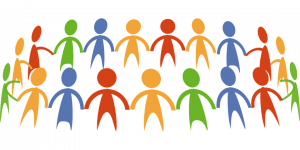
Looking back on this second decade, this was a time of “soul searching” in the field of Community Psychology, the separation from APA and the initiation of the Biennial Conference both being signs of this. Another sign came from a string of “dueling addresses.” Different community psychologists were trying to strongly encourage the field to adopt one particular emphasis. In his Presidential address to the field of Community Psychology, Emory Cowen argued for prevention to become “front and center” in the field. A few years later, Julian Rappaport argued for an emphasis on empowerment rather than prevention. Ed Trickett argued for an emphasis on an ecological perspective in the field, as did James Kelly. Kelly’s ecological analysis sought to understand behavior in the context of individual, family, peer, and community influences. Prevention, empowerment, and the ecological perspective are three of the most important aspects of the world view that Community Psychology has adopted. We can embrace all the various perspectives in Community Psychology without dismissing those who have a perspective different from our own, in what might be called a “big tent” (Toro, 2005). A belief in the value of “diversity” can apply to how we interact with our own colleagues in Community Psychology.
During this second decade, two new textbooks were published in 1977 by Heller and Monahan and Rappaport. Rappaport’s (1977) text, like his controversial Presidential address, presented a much more radical view of Community Psychology that emphasized the empowerment of the poor and otherwise disadvantaged, and a more active advocacy stance for community psychologists of the future.
In the late 1970s and early 1980s, there was significant growth in the field of Community Psychology outside of the US and Canada. This growth included the first courses taught in Latin America (at the University of Puerto Rico; see Montero) and in Australia (see Fisher), where the first professional organization of community psychologists outside of North America occurred in 1983. Since this time, some of the greatest growth in formal membership has occurred in Community Psychology organizations in areas of the world outside of North America (Toro, 2005).

In 1987, James Kelly edited a special issue of the American Journal of Community Psychology to commemorate the field which had just turned 20 years old (Kelly, 1987). Some of the 12 articles in the issue were brief reminiscences, while others were more substantive. Beth Shinn, for example, urged community psychologists to enter an even wider range of domains, including schools, work sites, religious organizations, voluntary associations, and government. Annette Rickel made an analogy to Erikson’s developmental stages in reviewing the status of our field at the time. She suggested that Community Psychology had progressed through adolescence and was entering early adulthood. Extending this analogy, the field is now over 50 years old, well into “middle age.” And, consistent with the sorts of issues that Erikson suggested might crop up during middle-age, perhaps our field is concerned about its “long-term legacy.”
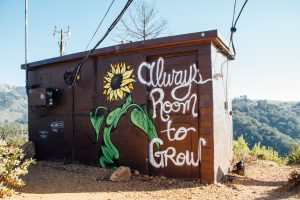
The “dueling addresses” mentioned above continued into the third decade. Annette Rickel in her 1986 Presidential address emphasized prevention, much like Cowen did in his address almost 10 years earlier. Beth Shinn in her 1992 Presidential address urged community psychologists to engage in new ways to cope with the social problem of homelessness. Irma Serrano-Garcia, based at the University of Puerto Rico, emphasized the need to empower the disenfranchised in her 1993 Presidential address. During this third decade, another new Community Psychology textbook was published (Levine & Perkins, 1987).
In 1988, there was a major conference in Chicago, IL trying to better define the theories and methods used by community psychologists (Tolan, Keys, Chertok, & Jason, 1990). Those in attendance discussed the role of theory in Community Psychology research. There was also an extended examination of the central and thorny methodological issue of taking into account the ecological levels of analysis. Also addressed were issues of implementing their research, which for community psychologists is a matter of actualizing their values in working collaboratively with community partners.
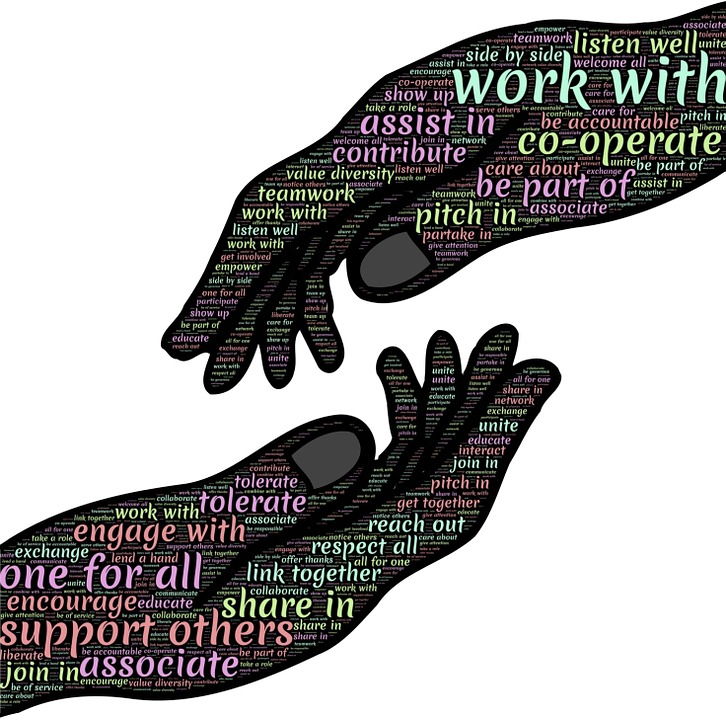
Starting in 1995, Sam Tsemberis (1999), a community psychologist from New York City, developed a program that has come to be called “Housing First.” The program, described in Chapter 1 (Jason, Glantsman, O’Brien, & Ramian, 2019), targets persons who are both homeless and seriously mentally ill. The intervention is a reaction to poorly researched transitional housing models that have rapidly become common in the US. Housing First combines up-front permanent housing with ongoing support services. In a few randomized trials, Housing First clients have become stably housed significantly quicker, and remained housed for significantly longer, than those in the control groups. Positive results have also recently been obtained in an evaluation of Housing First across five Canadian cities (Aubry et al., 2016). Housing first has also become very popular in Europe and in other developed nations. For the past three years, there has been an annual international conference to continue this work (see Tsemberis, 2018).

More attention during this decade was provided to one of the key themes of the field: participatory approaches to research, which are characterized by the active participation of community members in the planning, implementation, and evaluation of research. Greater knowledge of this approach was essential for developing ways to collaborate with community members in order to define and intervene with the numerous social problems they faced. Due to this need, the 2nd Chicago Conference on Community Research was hosted at Loyola University in Chicago in June of 2002 (Jason et al., 2004), and it focused on the refinement of the theories and methodologies that can guide participatory research.
In 2004, SCRA, the main professional organization promoting Community Psychology in North America, gained solid financial security, perhaps for the first time in its history, by acquiring the American Journal of Community Psychology from its original owner, the international publisher Kluwer/Plenum.

As another sign of the international growth of Community Psychology, in 2005 the European Community Psychology Association was formed. Prior to this development, Europeans had for many years a more informal “Network for Community Psychology.” The European Community Psychology Association has been operating an annual conference, held in different cities throughout Europe. As yet another sign of international growth, the first “International Conference on Community Psychology” was held in 2006 in San Juan, Puerto Rico. Held in even-numbered years, so as not to conflict with SCRA’s Biennial held in odd-numbered years, there have been International Conferences held in Portugal, Chile, Mexico, and South Africa. This international growth is very consistent with Community Psychology’s values emphasizing cultural diversity. Many community psychologists from around the world are actively collaborating with those in various nations around the world and an “internationalization” of the field is occurring in terms of practice, research, training, and theory (Reich, Riemer, Prilleltensky, & Montero, 2007).

In 2005, following the 40th anniversary of the founding of the field, a special issue on the history of Community Psychology was published in the Journal of Community Psychology (Fowler & Toro, 2008b). Articles in the special issue included a genealogical analysis of the influence of 10 key founders of the field (Fowler & Toro, 2008a), an account of “trailblazing” women in Community Psychology (Ayala-Alcantar et al., 2008), and documentation of the development of Community Psychology in different regions of the world (Latin America, see Montero and Australia, see Fisher).
Many community psychologists have made substantive contributions to the development of the field through their applied work, and have also impacted the development of the field through their teaching, mentorship, and conference presentations. Pokorny et al. (2009) tried to gauge the “influence” of community psychologists based on publications and citations to articles in the American Journal of Community Psychology and Journal of Community Psychology. Although many publications were by males from academic institutions, there were also publications from influential women, including Barbara Dohrenwend who contributed groundbreaking research dealing with a psychosocial stress model. She was also one of the original founders of the field of Community Psychology. Pokorny et al. did find that the number of women publishing articles has increased over time, as is evident in Case Study 2.2.
Case Study 2.2
Publications of Women in the Field

In 1970, around the time of the founding of the field of Community Psychology, women comprised approximately 20% of Ph.D. recipients in psychology. By 2005, nearly 72% of new psychology doctoral students were women. In many ways, articles published in journals are records of changing times as they illustrate how marginalized groups, like women, have transitioned to greater prominence. Patka, Jason, DiGangi, and Pokorny in 2010 found that in the early 1970s, women represented less than 12% of publishing authors in the two major Community Psychology journals, but by 2008, the number of women publishing in the two journals had increased to 61%. The findings from this study highlight the evolving role of women in the field of community psychology.
Community Psychology continued to make advances during this period in attempting to better understand social change in a world that is both complicated and often unpredictable. This field has increasingly worked to take into consideration dynamic feedback loops, which need to transcend simplistic linear cause and effect methods. In other words, the theories and methods of the field of Community Psychology are increasingly trying to capture a systems perspective, or the mutual interdependencies that Kelly’s ecological model has pointed to, regarding how people adapt to and become effective in diverse social environments.

New methods during the past 15 years have helped community psychologists conceptualize and empirically describe these dynamics, with quantitative and qualitative research methods that support contextually and theoretically-grounded community interventions (Jason & Glenwick, 2016). More attention is being directed to mixing qualitative and quantitative research methods in order to provide a deeper exploration of contextual factors. More sophisticated statistical methods help community psychologists address questions of importance as they work to describe the dynamics of complex systems that have the potential to transform our communities in fresh and innovative ways.
Finally, this free online textbook that you are reading, like the earlier development of the Ecological Community Psychology Conferences, is an illustration of how community psychologists put the field’s principles and theories into practice. Community psychologists believe that “giving psychology away” is the best course of action for an organization committed to prevention, social change, social justice, and empowerment. In addition, during the effort to assemble this online textbook, the editors worked with SCRA leadership to provide free SCRA Student Associate membership to undergraduates, which is another example of recent efforts to help lower barriers to participation in the field of Community Psychology.
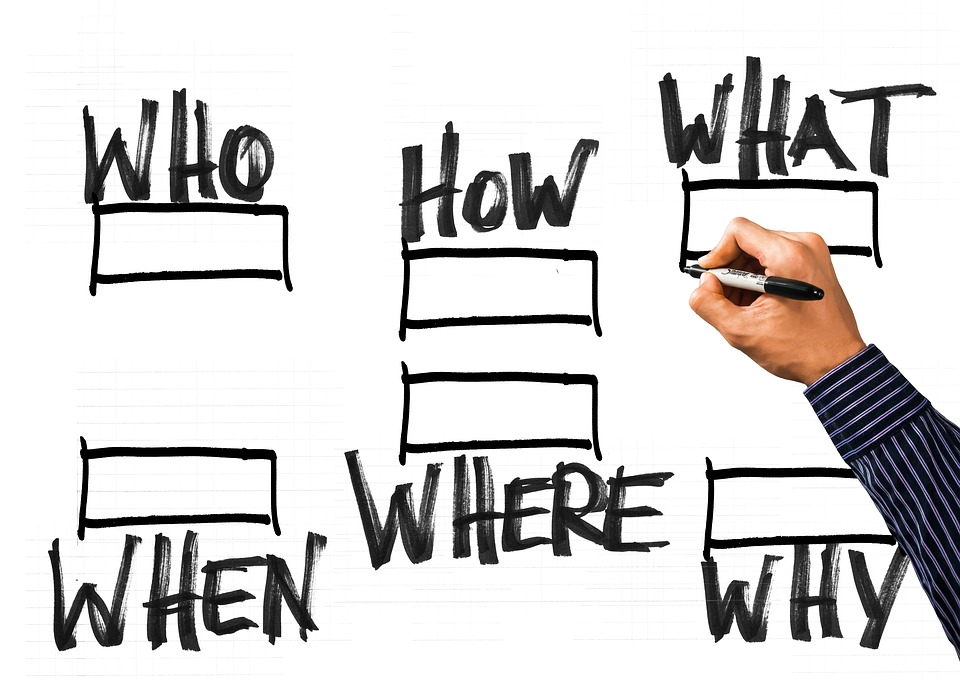
This chapter has reviewed the last 50-plus years in which the field of Community Psychology has developed after its start in 1965 at the Swampscott Conference. With a focus on prevention, ecology and social justice, the field has offered society new ways of thinking about how we might best solve our social and community problems. The chapter has documented key events that have occurred, including organization changes, key publications and conferences, and international developments. The field has had some “growing pains,” but now appears to be well-established and mature.
Critical Thought Questions
Take the Chapter 2 Quiz
View the Chapter 2 Lecture Slides
____________________________________________________________________
Aubry, T., Goering, P., Veldhuizen, S., Adair, C. E., Bourque, J., Distasio, J., . . . Tsemberis, S. (2016). A multiple-city RCT of Housing First with Assertive Community Treatment for homeless Canadians with serious mental illness. Psychiatric Services, 67(3), 275-281.
Ayala-Alcantar, C., Dello Stritto, E., & Guzman, B. L. (2008). Women in community psychology: The trailblazer story. Journal of Community Psychology, 36, 587-608.
Bennett, C. C., Anderson, L. S., Cooper, S., Hassol, L., Klein, D. C., & Rosenblum, G. (1966). Community psychology: A report of the Boston Conference on the Education of Psychologists for Community Mental Health. Boston: Boston University Press.
Bloom, B. L. (1975). Community mental health: A general introduction. Monterey, CA: Brooks/Cole.
Cowen, E. L., Trost, M. A., Izzo, L. D., Lorion, R. P., Dorr, D., & Isaacson, R. V. (1975). New ways in school mental health: Early detection and prevention of school maladaptation. New York: Human Sciences Press.
Fairweather, G. W., Sanders, D. H., Maynard, H., & Cressler, D. L. (1969). Community life for the mentally ill. Chicago: Aldine.
Fowler, P. J., & Toro, P. A. (2008a). Personal lineages and the development of community psychology: 1965 to 2005. Journal of Community Psychology, 36, 626-648.
Fowler, P. J., & Toro, P. A. (2008b). The many histories of community psychology: Analyses of current trends and future prospects. Journal of Community Psychology, 36, 569-571.
Jason, L. A., Glantsman, O., O’Brien, J. F., & Ramian, K. N. (2019). Introduction to the field of Community Psychology. In L. A. Jason, O. Glantsman, J. F. O’Brien, & K. N. Ramian (Eds.), Introduction to Community Psychology: Becoming an agent of change. Retrieved from https://press.rebus.community/introductiontocommunitypsychology/chapter/intro- to- community-psychology/
Jason, L. A. & Glenwick, D. S. (Eds.). (2016). Handbook of methodological approaches to community-based research: Qualitative, quantitative, and mixed methods. New York: Oxford University Press.
Jason, L. A., Keys, C. B., Suarez-Balcazar, Y., Taylor, R. R., Davis, M., Durlak, J., Isenberg, D. (Eds.) (2004). Participatory Community Research: Theories and methods in action. Washington, D.C.: American Psychological Association.
Kelly, J. G. (1966). Ecological constraints on mental health services. American Psychologist, 21, 535-539.
Kelly, J. G. (1987). Swampscott anniversary symposium: Reflections and recommendations on the 20th anniversary of Swampscott. American Journal of Community Psychology, 15(5).
Kloos, B., Hill, J., Thomas, E., Wandersman, A., Elias, M. J., & Dalton, J. H. (2012). Community psychology: Linking individuals and communities. Belmont, CA: Wadsworth.
Levine, M., & Perkins, D. V. (1987). Principles of Community Psychology: Perspectives and applications. New York: Oxford University Press.
Moritsugu, J., Duffy, K., Vera, E., & Wong, F. (2019). Community Psychology (6th ed). New York: Routledge.
Pokorny, S. B., Adams, M., Jason, L. A., Patka, M., Cowman, S., & Topliff, A. (2009). Frequency and citations of published authors in two community psychology journals. Journal of Community Psychology, 37, 281-291.
Rappaport, J. (1977). Community psychology: Values, research, and action. New York: Holt, Rinehart, & Winston.
Reich, S., Riemer, M., Prilleltensky, I., Montero, M. (Eds.). (2007). International Community Psychology. History and theories. New York, NY: Springer.
Tolan, P., Keys, C., Chertok, F., & Jason, L. A. (Eds.). (1990). Researching Community Psychology: Issues of theories and methods. Washington, DC: American Psychological Association.
Toro, P. A. (2005). Community psychology: Where do we go from here? American Journal of Community Psychology, 35, 9-16.
Tsemberis, S. (1999). From streets to homes: An innovative approach to supported housing for homeless adults with psychiatric disabilities. Journal of Community Psychology, 27, 225-241.
Tsemberis, S. (June, 2018). Housing First: Why person centered care matters? Third International Housing First Conference, Padua, Italy.

Chapter Three Objectives
By the end of this chapter you will be able to:

Community psychologists seek to improve community well-being through a cycle of collaborative planning, action, and research in partnership with local community members. As indicated in the first chapter (Jason, Glantsman, O’Brien, & Ramian, 2019), we emphasize exploring issues with a systems lens approach, and focus on prevention and community contexts of behavior. Community psychologists embrace the core values of the field which include 1) individual and family wellness, 2) sense of community, 3) respect for human diversity, 4) social justice, 5) empowerment and citizen participation, 6) collaboration and community strengths, and 7) empirical grounding.

The settings of community psychologists range from academia to non-profit organization. Typically, community psychologists complete graduate work in the field, but that is not required to engage in community work. The work of a community psychologist is dependent on an individual’s interest, training, and experience. Community psychologists can work as researchers, policy developers, educators, program evaluators, or program coordinators within academic, government and non-profit settings (SCRA, 2018). These are not the only roles and settings of community psychologists and within this chapter, we will explore a diversity of career paths and employment options. All community psychologists have a passion for a specific community need or topic. What community issues are you most excited about addressing?

Community Psychology practice typically refers to applied or practical work of community psychologists, which can involve a variety of activities related to a cycle of action and research such as community organizing, coalition building, program development or program evaluation, policy, advocacy, grant writing, data collection, data analysis, or report writing. Community Psychology practice occurs in many community settings outside of the classroom or research center such as schools, community-based non-profit organizations, places of worship, health clinics, parks, community centers, or other neighborhood gathering spaces.

Due to the diversity of activities and settings for Community Psychology practice and its focus on systems, context, programs, and organizations as opposed to individuals, the field has decided not to have their members receive a license to practice. Rather, members of SCRA have developed competencies for Community Psychology practice to “…provide a common framework for the discussion of skills involved in Community Psychology practice, and how those skills can be learned” (SCRA, 2012, p. 9). The 18 competencies help define and clarify the unique combination of skills and values that differentiate community psychologists from other people working in community settings. They fall into five categories: 1) foundational principles, 2) community program development and management, 3) community organizational capacity building, 4) community and social change, and 5) community research. See the chapter by Wolfe (2019) to view a complete list of the competencies by category. To learn more about the competencies in Community Psychology check out Dalton and Wolfe (2012) and Wolfe and Price (2017).
If you want to dig even further into how a specific competency is used in work settings, see Elias, Neigher, and Johnson-Hakim (2015) which provides case examples of how each competency is enacted in practice. See Scott and Wolfe’s Community Psychology: Foundations for Practice (2015) which provides case examples of how each competency is enacted in practice. In addition, the Community Tool Box has an Ask An Advisor Tool which provides more examples of how to apply the competencies in different settings. Note that some Community Psychology scholars have raised concerns about the potential limiting aspects of focusing on competencies or provided counterpoints for their value (e.g., Dzidic, Breen, & Bishop, 2013). There are also some additional models or ways to categorize the skills of a community psychologist such as the one by Arcidiacono (2017), who describes the TRIP model (which stands for Trustfulness, Reflexivity, Intersectionality, and Positionality) as the core methodological skills acquired by community psychologists in their training as well as their basic values.
Practical Application 3.1 below can help you start the process of examining your current skills, the skills you want to acquire, and how you can find a career in Community Psychology that’s right for you.
Practical Application 3.1
Your Personal Fit with Community Psychology
Think of the competencies as a set of tools in a toolbox. You can pick and choose which competency to apply in various settings. In specific settings, some competencies are used more than others. Are there skills that are you are interested in gaining that you do not currently have? How can you build your skill set? This activity will help you start thinking about which skills you can build upon throughout your career.
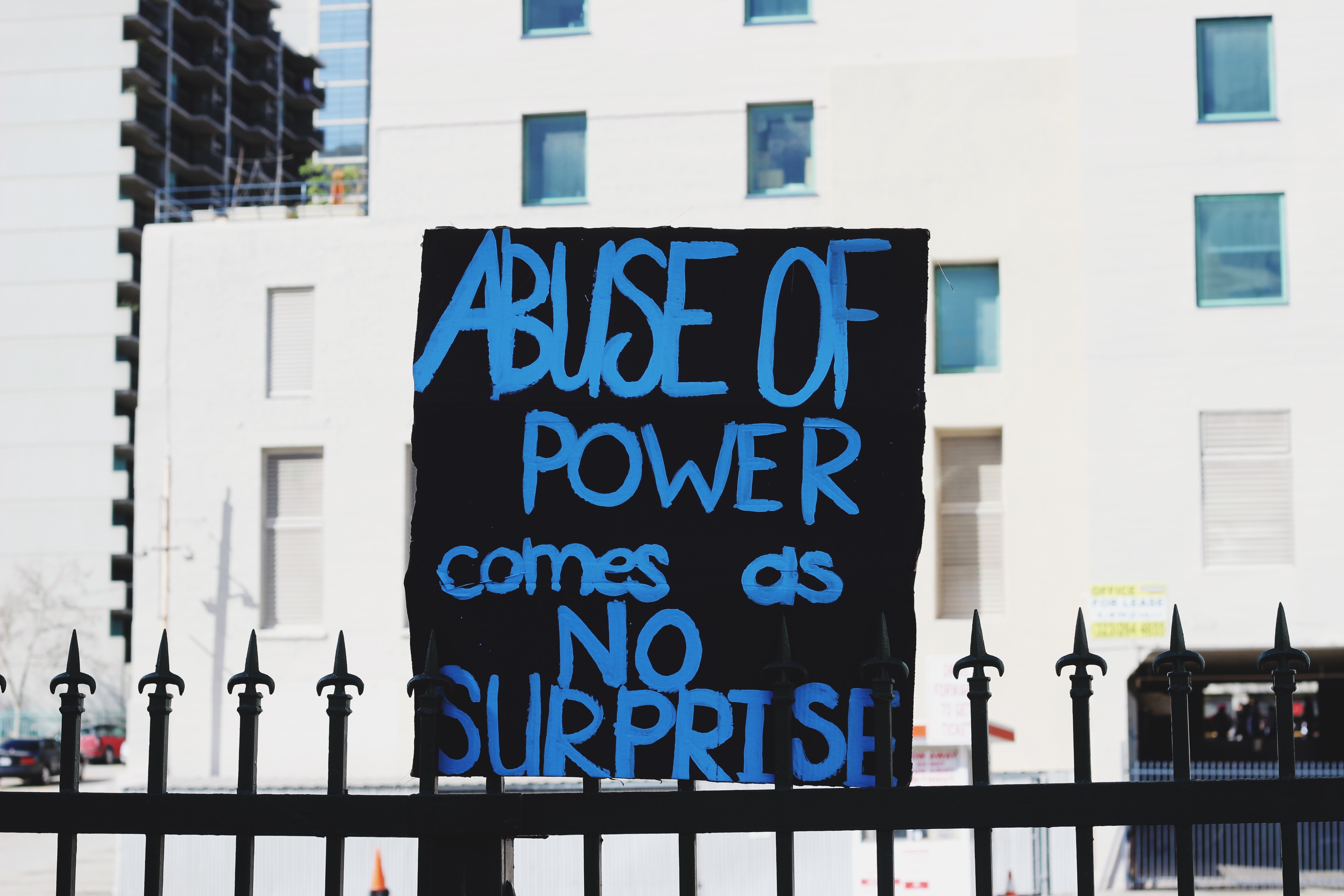
It is important to keep in mind that there is no one path to becoming a community psychologist. The path is determined based on the needs and preferences of an individual, which makes the journey flexible. Non-traditional community psychologists pursue training in other academic fields or have lived experiences as a community advocate. They do not take the traditional route of pursuing formal graduate training in Community Psychology. For example, some community psychologists pursue training in other fields that share similar values and approaches (e.g., Public Health, public service management, Social Work, Applied Anthropology, Applied Social Psychology, Sociology, and disability studies). In fact, many community psychologists have diverse training, backgrounds, and experiences that allow them to make the field rich in diversity. Check out these unique paths of community psychologists in Case Study 3.1. and Case Study 3.2.
Case Study 3.1
Nicole Freund
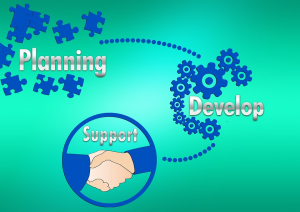
“As an undergrad, I found psychology fascinating, but had no idea there was a discipline outside of clinical work. I did not want to be a clinician, so I didn’t consider psychology as a major, instead graduating with a degree in English and theater. I went on to graduate school for English and got an MA in rhetoric and composition and then spent my first year in Wichita (I got married and moved to Wichita, KS after receiving my MA) adjunct teaching 6 intro writing classes at 4 universities. I did so much adjunct work (and couldn’t get a full-time instructor gig), that I burned right out and my newlywed family couldn’t make ends meet, so I jumped ship and started working in public relations for a private consumer goods company. I did PR and brand marketing work at that company for about 5 years, earning an MBA along the way. At the 4-5 year mark, I started doing marketing research for the company and pretty soon, that became my full focus. I was the sole researcher at the company, so I was responsible for understanding consumer behaviors across a bunch of different activities, cultures, and products. It really got me interested in why people think the way they do, and why they behave in certain ways. After 11.5 years at the company, the context had changed so much that it was just not healthy for me to stay, and I started looking at exit strategies. I came across psychology again after last having considered it more than a decade before, and this time I was introduced to community psych, which really resonated with me. I applied for a spot in the Wichita State University PhD program and spent the next 5 years learning about what I should have learned so many years before. It felt like home. For my practicum, I began working at what is now the Center for Applied Research and Evaluation at the Community Engagement Institute. We do primarily program evaluations, and being able to juggle multiple partners, understand that what a partner needs is not always an RCT (randomized control trial) or “bullet-proof” report, and handle a wide variety of methodologies was incredibly useful. The practice of community psych as an evaluator is something of a different animal than practicing in other ways and definitely different than an academic path. After my practicum, I was offered and accepted a full-time position as a research associate, and now that I’ve successfully defended, I plan to stay at CARE as a research scientist. I came to my position through a winding path that ultimately provided me with skills I wouldn’t have had otherwise. The relationships I was able to cultivate in my PhD program certainly impacted where I ended up, and I’m so grateful to know and work with the people I do. The future is obviously unwritten, but I feel like my weird journey to a PhD at 41 (technically 42 by the time I walk), has definitely set me up to find opportunities I wouldn’t otherwise have.”
Case Study 3.2
Monica Adams-Terraso
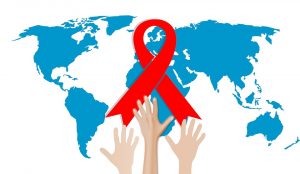
“As with many community psychologists, I followed a circuitous path to my current role. As an undergraduate psychology major at the University of Iowa, I volunteered at the local AIDS care center and completed a mixed methods internship at the University of Iowa Hospital in the HIV/AIDS clinic. I really enjoyed the qualitative interviews and working with patients to share their needs and voices, and soon presented my first scientific poster. After a summer internship in London, I realized that the individualized nature of clinical work, especially with a psychoanalytical orientation, was not my path, and abandoned the idea of going to graduate school for clinical psychology. I was at a loss for what to do next when a mentor introduced me to the field of public health. I joined the Master of Public Health program at the University of North Carolina-Chapel Hill (UNC). Here I encountered my first community psychologist—a professor doing innovative research on marketing and internet tobacco sales. I conducted research on adolescent alcohol and tobacco use and did a practicum with a rural anti-smoking coalition. After graduation, I moved to Chicago to work at DePaul University’s Center for Community Research. My boss and later advisor mentored me in the application of Community Psychology to real-world problems. I saw how you could blend both public health and psychology to advocate for underrepresented populations and concentrate on systems. This led me to apply for the Community Psychology program at DePaul University. In graduate school, I continued my work on tobacco policy—with an emphasis on the school setting and geo-spatial analysis. I conducted applied research projects, and after receiving my Ph.D. focused heavily on evaluation and practice around substance use prevention and community engagement. The emerging opioid epidemic pushed me to focus more on data to action, and I applied to the Epidemic Intelligence Service—the Center for Disease Control and Prevention’s training program for disease investigation and epidemiology. This fellowship transported me to a local public health department in Las Vegas. There I responded to several outbreaks including setting up a measles vaccination clinic at a large casino, evaluating lab results for Zika virus, and importantly, traveling to Sierra Leone to support Ebola prevention efforts. While there, I worked on the health promotion team to conduct rapid community assessments in ongoing transmission areas and worked with disease survivors, a much-stigmatized group. Once the fellowship was over, I went back to my first public health interest area—HIV/AIDS—to find my current home as an epidemiologist within the Centers for Disease Control and Prevention. Here I support bio-behavioral disease surveillance to understand HIV transmission within networks of people who inject drugs. My training as a community psychologist gave me skills to conduct research with marginalized populations, think about policy levers, and apply varied analysis methods and tools. It ultimately led me to a federal agency where I get to use my expertise to support and impact national initiatives around HIV elimination.”
As mentioned, graduate training in Community Psychology is not required to engage in community work. You may fall into this category of having a passion for community work but with no desire to receive formal graduate training. Non-traditional community psychologists have not received formal training (e.g., graduate training in Community Psychology or related field). They are typically community members and/or leaders who identify as community psychologists due to their work in the community. The community-grounded work aligns with the principles and values within the field. One common approach of community psychologists is to collaborate with community members. In addition, non-traditional and traditional community psychologists share in common an understanding that the solutions to community challenges lie within communities. The approach is bottom-up and ensures that the voices of the community drive the search for and implementation of solutions. The Asset-Based Community Development Institute is a great resource to support community-engaged work that does not necessarily require traditional training.

When exploring working in the field of Community Psychology, consider which job setting aligns with your interest and skill set. Be open to trying different settings to figure out what works best for you. One of the great things about the field is that you can create a career path that is uniquely yours. There is no perfect roadmap to working as a community psychologist. Community Psychology-oriented job seekers may desire working in one or both of the following setting tracks: academic or practice.
Academic community psychologists often have faculty appointments and teach at the collegiate level and/or engage in community-based participatory research or evaluation work. Higher education settings also include research or evaluation centers or institutes and student support services units that focus on the health and academic success of students. Community psychologists who work in academia typically receive formal graduate training. To learn more about graduate training, review the last chapter of this textbook (McMahon & Sánchez, 2019).
Practice settings include non-profit organizations, consulting, government, health care, or for-profit organizations. What setting will fit you? Check out Practical Application 3.2 below to learn more about different opportunities. Each setting description gives insight into what takes place at each setting. Also, visit the websites of the examples to get a better picture of how people in each environment engage in their work. In some cases, practice environments may fall into multiple categories due to their scope of work. Explore the different options and think about which setting is best for your interests.
Practical Application 3.2
Practice Settings
The practice setting categories listed below are not mutually exclusive. Some organizations may fall in multiple categories.
Non-profit Organizations
Local or national organizations that focus on a specific cause. They invest their income back into the organization to further their cause as opposed to distributing the earnings to shareholders, leaders or members. They are often tax-exempt due to their charitable purpose and the value they add to the public.
Examples of Non-profit Organizations:
Consulting and Research Firms
Community psychologists may work as independent consultants, principles, or employees, or small, medium, or large consulting firms that provide advice and support to other organizations looking to make decisions or change something within their organization.
Examples of Consulting and Research Firms:
Government Positions
A legislative, executive, or judiciary department, agency, or commission that establishes and enforces laws and regulations and provides basic infrastructure, health, education, public safety, and commerce/trade to support its citizenry. Community psychologists work in local municipalities, county, state, and the federal government.
Examples of Government Positions:
Health Care Organizations
An organization that provides health care or related services (e.g., health-focused research).
Examples of Health Care Organizations:
Educational Sector Opportunities
Community psychologists can be found in just about every setting you can imagine within the educational sector. We work in public and private daycare centers, pre-school, primary and secondary schools (pre-K through 12th grade), school district research and assessment/evaluation offices, tutoring centers, after-school enrichment programs and prevention programs, colleges and universities, and more.
Examples of Educational Sector Opportunities:
Practice settings allow community psychologists to use Community Psychology practice in an applied environment. Typically, job responsibilities do not focus on gaining publications in scholarly journals, which is usually emphasized in academia. While these practice-oriented community psychologists might not focus on research and publishing, the methods and approaches used in practice settings are based on previous research. Job titles can range from Program Coordinator to Director of Program Evaluation. While each job title may or may not require a degree in Community Psychology, it is important to understand job responsibilities.
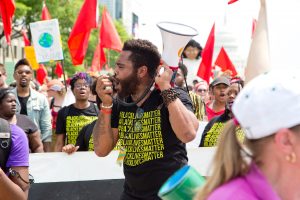
If you are not sure which setting you prefer, volunteer or complete an internship, fellowship, or service year (e.g., AmeriCorps, PeaceCorps, Teach for America), in order to figure out which experience is the best fit for you. In addition, professional organizations offer mentorship programs to connect professionals with students and/or community members who desire more guidance in the field (e.g., SCRA, American Evaluation Association, Society for Research on Adolescence’s Undergraduate Scholars Program, Society for Research in Child Development, Millennium Scholars Program, Early Career Interdisciplinary Scholars Fellowship Program). Individuals who are interested in gaining more experience in the area of research or policy should consider looking into relevant programs (e.g., American Psychological Association Fellowship, the American Association for the Advancement of Science, Center for Disease Control and Prevention Fellowship).

Now that we have gone over some different settings for understanding career paths, let’s connect to some community psychologists working in the field. The Diverse Careers in Community Psychology book includes over 20 detailed examples of community psychologists describing their jobs and careers in the field. Here are examples of titles of working community psychologists who contributed to the book. To learn more about each community psychologist, click on their name to connect to their personal page. As you are exploring each community psychologist, do you notice any trends in career paths? How does their education relate to their job setting? What professional skills are listed? How are the community psychologists describing themselves in their bio description? Of the settings described in Practical Application 3.2, which ones pique your interest? Start exploring the community psychologists in that field first. Other great sources to learn about the career trajectories of individual community psychologists include Gloria Levin’s 60+ longtime interview-based columns, “Living Community Psychology” within The Community Psychologist (TCP).
Theresa L. Armstead—Behavioral Scientist in the Research and Evaluation Branch, Division of Violence Prevention, National Center for Injury Control and Prevention, CDC
Case Study 3.3
Theresa Armstead

Theresa Armstead is a member of the Intimate Partner Violence/Teen Dating Violence team and serves as the scientific lead for the evaluation of the DELTA FOCUS (Domestic Violence Prevention Enhancement and Leadership Through Alliances, Focusing on Outcomes for Communities United with States) program. She has nine years of program evaluation experience in the public health areas of chronic disease prevention, violence prevention, HIV and AIDS prevention, and emergency response.
Richard A. Jenkins—Health Scientist Administrator in the Prevention Research Branch of the National Institute on Drug Abuse, National Institutes of Health (NIH).
Fabricio E. Balcazar—Professor in the Department of Disability and Human Development, the University of Illinois at Chicago
Ronald Harvey—Assistant Professor of psychology at American University in Bulgaria
Gregor V. Sarkisian—Associate Professor of psychology at Antioch University, Los Angeles, CA
Cari Stevenson—Professor at Kankakee Community College
Lindsey Back—Senior Analyst in the office of Institutional Research and Assessment at Northeastern Illinois University
Luciano Berardi—Director of the McNair Scholars, Arnold Mitchem Fellows, and Research Lab programs at the Center for Access and Attainment at DePaul University
Crystal Reinhart—Research Program Specialist with the Center for Prevention Research and Development at the University of Illinois, Urbana–Champaign
Small firms typically have 1-10 employees and larger firms include more than 10 or in the hundreds.
Michelle Bloodworth—Senior Research and Evaluation Specialist at Apex Education
Ashley Boal—Research Associate at WestEd in Los Alamitos, CA
Geraldine (Geri) L. Palmer—Managing Director at the Community Wellness Institute
Manolya Tanyu—Senior Researcher at the American Institutes for Research
Case Study 3.4
Manolya Tanyu

Manolya Tanyu has expertise in interventions in schools and community settings, program evaluation in youth development, mentoring, and social-emotional learning. Tanyu is a skilled methodologist, and she has worked on a number of evaluation projects to investigate processes, practices, and outcomes using qualitative and quantitative methods. She earned her doctoral degree in Community Psychology and prevention research from the University of Illinois at Chicago with a minor in methods and statistics.
Foundations are considered grantmaking institutions and focus on awarding grants to non-profit organizations.
Teresa Garate—Vice President of Strategic Partnerships & Engagement at the Gateway Foundation
Judith Meyers—President and Chief Executive Officer of the Children’s Fund of Connecticut
Sharon Johnson –Hakim—Manager for Population Health Sciences at Atlantic Health System in Morristown, NJ
Alison J. Martin—Assessment and Evaluation Coordinator for the Oregon Center for Children and Youth with Special Health Needs

Just like with any career path, mentorship is critical for success as a community psychologist. Mentors can help with guidance, support, and advice. When thinking about who to reach out to for mentorship, consider who is doing the work that you would like to do. Mentors can come from applied and academic settings or both. In fact, mentors do not have to be community psychologists but they can engage in community work or use an approach that you want to learn more about. Do not limit yourself to just one mentor. Create a library of mentors that you can reach out to for when you need a sounding board or advice on how to engage with a community population in which you are unfamiliar. If you are not sure where to start in identifying mentors, start with a basic Google search. Then, try the various professional organizations that are listed in the chapter. Next, develop a list of questions to ask a potential mentor to help you determine if the mentorship is a good fit. Your mentor must have the time, dedication and interest in investing in your growth. Do not get discouraged if a mentoring relationship does not work out. Remember to always build a library of mentors with various expertise in different fields. The more diverse your mentors the more likely you are to learn something new and continue to grow in your journey as a community psychologist.

Community Psychology jobs typically do not specifically advertise “seeking a community psychologist,” so one challenge with the field is that its connection to psychology causes employers to make assumptions about the applicant’s skill set that is inaccurate. For example, an employer may assume community psychologists are trained in clinical work or therapy (McMahon & Wolfe, 2017). Therefore, it is important to first have a good sense of your expertise. Next, examine the job description to ensure it fits your skill set, interests, and alignment with Community Psychology competencies. When promoting yourself as a community psychologist, share the values of the field and the specific skills that match the desired role. Write a job description of your ideal job which includes work setting, salary, job description, and geographic region. Is your description similar to a typical description of a community psychologist? Why? Why not?
In Practical Application 3.3 below, there are some excerpts from job descriptions for positions held by community psychologists.
Practical Application 3.3
Community Psychology Job Descriptions
Health Care
Consulting
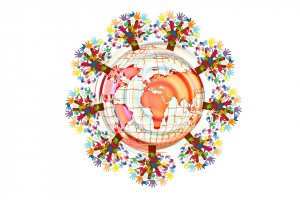
SCRA offers different ways to connect with others and gain additional career support. As a result of the diversity of topic interests among community psychologists, SCRA interest groups help to bring together others in the field with similar interests. If you are primarily interested in learning more about careers, we recommend checking out Early Career Interest Group. Also, consider participating in initiatives hosted by the Community Psychology Practice Council. For example, the council organizes monthly calls to gain support for career challenges. Have you been working on a community project and hit a brick wall? Participating in peer consultation calls can help you overcome that obstacle and connect with potential mentors with expertise in the field.
Attending conferences and participating in professional development opportunities helps to network and identify mentors for potential job opportunities. At conferences, people with similar interests connect and establish future collaborations. The Midwest Eco Conference is a training opportunity that is completely run by students in the field to share their work and gain supportive feedback. Each year a different academic institution in the Midwest hosts the conference which serves as a leadership opportunity for students. To learn more about the history of the conference check out The Evolution and Growth of the Eco-Community Psychology Conferences. There are now similar conferences in different regions of the US.
Some community psychologists obtained their jobs through building relationships and created their own jobs. Another strategy is to join group email lists or “listservs,” such as those for SCRA, Community Based Participatory Research, and Culturally Responsive Evaluation and Assessment, to receive emails of new job postings in the field. For additional email lists related to public health see Partners in Information Access for the Public Health Workforce.
Professional development opportunities exist beyond conferences and these are typically workshops or webinars. The opportunities are offered through professional membership organizations, experts, consulting firms, government, and/or non-profit organizations (e.g., Tamarack Institute, American Evaluation Association Education Webinars, Evaluator’s Institute, American Educational Research Association, Association for Talent Development). These professional development opportunities listed above are examples but they are not the only options for professional development. An internet search will come up with additional options as well. Reach out to other professionals in the field to learn about which professional development opportunities that they can recommend for your interest. See Practical Application 3.4 for a list of employment-seeking strategies.
Practical Application 3.4
Employment-Seeking Strategies
(Cited directly from Viola, Glantsman, Williams, & Stevenson, 2017).
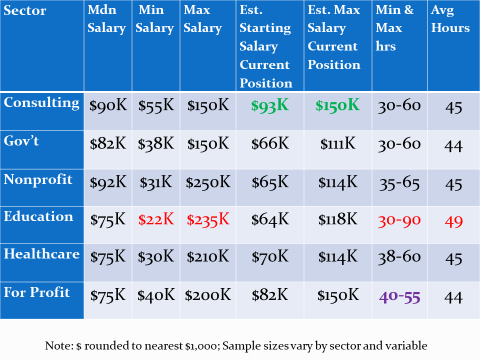
A common question among those considering Community Psychology as a career is, “What do community psychologists make as a salary?” Like most jobs, salaries vary according to job setting, geographic region, and job responsibilities. In Viola, Glantsman, Williams, and Stevenson (2017), 420 community psychologists completed The Diverse Careers in Community Psychology Survey. Respondents shared that the median salary range for a community psychologist was $75,000- $90,066 (as of 2015). The salary ranges were specific to the following job settings: consulting, government, non-profit, education, health care, and for-profit across various geographic regions. Check out Viola and Glantsman (2017) to learn more about salaries in the field across work settings and job titles.

Community psychologists apply various Community Psychology practice competencies in their job roles. The two main job tracks within Community Psychology are academia and practice, and career paths of community psychologists can be traditional or non-traditional. Community psychologists work in various settings such as non-profit organizations, consulting, government, health care, for-profit, and academic settings. Community psychologists find jobs through networking, responding to postings on email listserv and online job postings, and can also co-create jobs with organizations they respect and work with on community projects.
Critical Thought Questions
Take the Chapter 3 Quiz
View the Chapter 3 Lecture Slides
_____________________________________________________________________
Arcidiacono, C. (2017). The Community Psychologist as a reflective plumber. Global Journal of Community Psychology Practice, 8(1), 116. Retrieved from http://www.gjcpp.org/
Dzidic, P., Breen, L. J., & Bishop, B. J. (2013). Are our competencies revealing our weaknesses? A critique of Community Psychology practice competencies. Global Journal of Community Psychology Practice, 4(4), 110. Retrieved from http://www.gjcpp.org/
Elias, M. J., Neigher, W. D., & Johnson-Hakim, S. (2015). Guiding principles and competencies for community psychology. In V. C. Scott & S. M. Wolfe (Eds.), Community psychology foundations for practice (pp. 35–62). Thousand Oaks, CA: Sage Publications.
Jason, L. A., Glantsman, O., O’Brien, J. F., & Ramian, K. N. (2019). Introduction to the field of Community Psychology. In L. A. Jason, O. Glantsman, J. F. O’Brien, & K. N. Ramian (Eds.), Introduction to Community Psychology: Becoming an agent of change. Retrieved from https://press.rebus.community/introductiontocommunitypsychology/chapter/intro-to-community-psychology/
McMahon, S. D., & Sánchez, B. (2019). Looking into your future. In L. A. Jason, O. Glantsman, J. F. O’Brien, & K. N. Ramian (Eds.), Introduction to Community Psychology: Becoming an agent of change. Retrieved from https://press.rebus.community/introductiontocommunitypsychology/chapter/looking-into-the-future/
McMahon, S. D., & Wolfe, S. M. (2017). Career opportunities for Community Psychologist in APA. In C. M. Bond, I. Serrano-Garcia, C. B. Keys, & M. Shinn (Eds.), APA handbook of Community Psychology: Methods for community research and action for diverse groups and issues (Vol. 2, pp. 645-659). Washington DC: American Psychological Association.
Scott, V. C., & Wolfe, S. M. (2015). Community Psychology: Foundations for Practice. Sage Publications: Thousand Oaks, CA.
Society for Community Research and Action (2012). Competencies for community psychology practice: Draft August 15, 2012. The Community Psychologist, 45(4), 7-14.
Viola, J., Glantsman, O., Williams, A., & Stevenson, C. (2017). Chapter 1-Answers to all your questions about careers in Community Psychology. In J. J. Viola & O. Glantsman (Eds.), Diverse careers in Community Psychology. (pp. 1-19). New York, NY: Oxford University Press.
Wolfe, S. M. (2019). Community Psychology practice competencies. In L. A. Jason, O. Glantsman, J. F. O’Brien, & K. N. Ramian (Eds.), Introduction to Community Psychology: Becoming an agent of change. Retrieved from https://press.rebus.community/introductiontocommunitypsychology/chapter/practice-competencies/
Wolfe, S. M., & Price, A. W. (2017). The application of the Community Psychology practice competencies for community consulting practice in the U.S. Global Journal of Community Psychology Practice, 8(1), 1-14. Retrieved from http://www.gjcpp.org/

Chapter Four Objectives
By the end of this chapter you will be able to:

“The farther one travels, the less one knows.”
– George Harrison, “The Inner Light”
In this book, you will learn about the different theories of Community Psychology and how community psychologists work and interact with people in their communities, as well as with local and national governments and policy makers to promote social change. Now, think about doing Community Psychology work in a country you know little about. This is called International Community Psychology, and it occurs when community psychologists from one country work or train in a country other than their own. The opening Harrison quote, inspired by the 2500-year-old text the Tao Te Ching, implies that exposure to diverse environments and context helps us realize how much more we need to learn. Although humbling, this is the value of adopting an international perspective in Community Psychology.
In this chapter, we will describe some of the similarities and differences International Community Psychology has with “domestic” Community Psychology, and give examples of some of the unique challenges and rewards of doing International Community Psychology work.

Why might you be interested in International Community Psychology? First, we believe international work can sharpen your Community Psychology skills because international research and practice can intensify values and goals compared to doing work in more familiar in-country environments. Experienced International Community Psychology practitioners often report that their international work creates opportunities for reflection and self-discovery, and helps them to better understand context (Harvey & Mihaylov, 2017). We will explore this in more detail later in the chapter.
Second, because of globalization, the world is becoming more interconnected via communications technology, travel, immigration, and trade. While trade is occurring in money, goods, and services, trade is also occurring in symbols, morality, cultural values, governmental systems, and most importantly, people. We live in an ever increasingly global community where we must consider the global context to address the root causes of local social problems. Community Psychology practices must be informed by global perspectives to understand the contexts in which people live.

International Community Psychology practice occurs when Community Psychology practitioners from one country work in a different country or culture. This may occur because the practitioners are invited to do research by native residents, or because the practitioners have initiated this contact.
Invitations to do International Community Psychology happen for many reasons: the community psychologist may have expertise in an intervention or field in which the host country lacks, or is invited to teach Community Psychology methods to students and practitioners. The following case study from Harvey and Mihaylov (2017) illustrates such an invitation given to Douglas D. Perkins, a community psychologist at Vanderbilt University in the US.
Case Study 4.1
Douglas D. Perkins Engaging in International Work In 1998
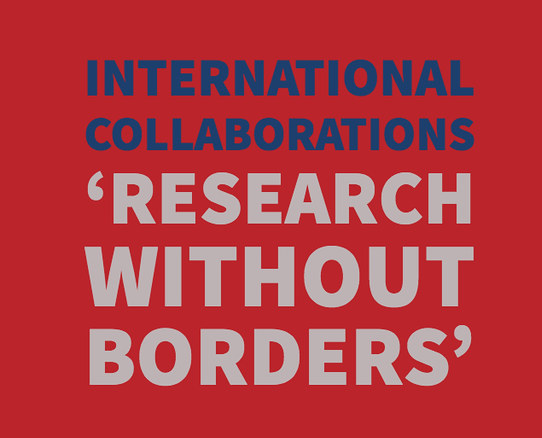
[…] I was invited as a visiting professor in Perth, Australia. The trip involved giving Community Psychology and community development research and academic program development talks and consultations all over Australia (and I also spent time in New Zealand). But I did not really consider myself an international researcher until 2003, when as director of the Program in Community Research & Action at Vanderbilt, I was invited to deliver a keynote address at the National Congress on “Prevention in Schools and Communities: Development of Social Capital for Health Promotion and Prevention” at the University of Padova, Italy, and to teach a 2004 graduate master class at Otto-von-Guericke University in Magdeburg, Germany. These opportunities produced my first international research collaborations. I subsequently developed other collaborative research and educational projects with other faculty and students in Italy, China, and South Africa, and many of those faculty and students have also been visiting scholars in our program at Vanderbilt.
In contrast, initiating International Community Psychology may occur because a home practitioner desires to learn something new or useful that can only be obtained by doing the research or intervention in an international setting. For example, Vassileva et. al (2007) explored the changes in impulsivity in former heroin users over time. However, they faced the issue that the vast majority of people with substance use disorders in the US abused more than one substance before seeking treatment. This methodological challenge was overcome by recruiting participants in Bulgaria, who, because of societal and economic factors, tended to only use heroin.
A third, but not recommended, model of International Community Psychology is research or intervention forced upon the local or indigenous culture. This sometimes occurs when large funders (such as the World Health Organization) attach conditions to the funds being spent. For example, Burchett (2012) interviewed Ghanan psychologists who had a negative view of international health policy from foreign funders that de-legitimized traditional birth attendants for home births. The funders forced an intervention using only non-traditional birth workers but provided no funding for training additional birth workers to make up the deficit. This is something that we do not advocate because it is a form of colonialism and violates many Community Psychology values. Colonialism is the act of an invading culture establishing political and economic control over an indigenous people. We need to do all that is possible to not support Colonialism when working internationally.
The last example is when Community Psychology training occurs in another country. See the case study below for an example describing Nikolay L. Mihaylov, at the Medical University—Varna, Bulgaria.
Case Study 4.2
Nikolay L. Mihaylov Meets Community Psychology

In 2009 I was applying to study psychology in the US with the long-term goal of working on social issues in my home country Bulgaria. Community Psychology was not the instrument I sought: it was absent in textbooks or lectures available in Bulgaria (some of them popular US intros to psychology). Based on an Elliot Aronson-inspired view of social psychology, I applied to a dozen such programs only to discover, to my dismay, that none would admit me, despite my eloquent action-focused personal statement and despite the boost of a Fulbright grant. Then fortune and the Fulbright Commission put me in touch with Ron Harvey, at the time a PhD student at DePaul University. And so I met Community Psychology.
Community Psychology captivated me with its inherent direct work with and in communities, with people. I found that to be the essence of psychology, what drew me to it in the first place – human contact and a spontaneous need to share human presence. In this regard, I felt there was too little training and emphasis on interpersonal skills, consultation, leadership, group dynamics and community organizing in the Community Psychology programs I was first introduced to.
The last impression I would like to share is of my initial awe of how rigorous and busy research in Community Psychology was. Compared to European and Eastern European academic styles, the tempo and rigor in the US is mind-blowing. This makes US academia much more productive and relevant. On the downside, business-like benchmarks for good work seem to prioritize efficiency over reflection in the process of research. In Community Psychology, such a trade-off might be bad for community.
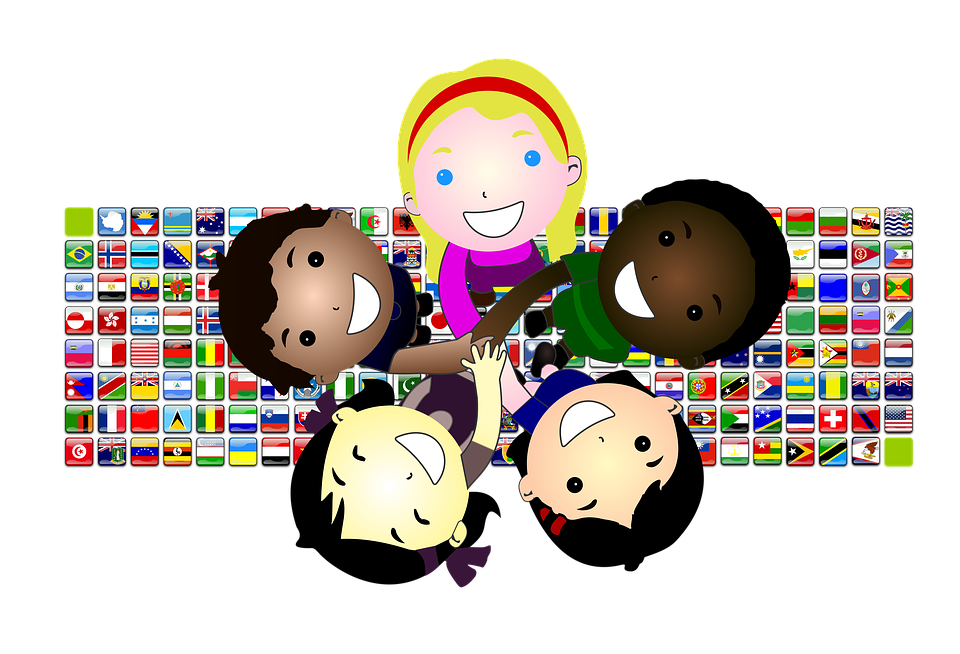
International Community Psychology is not different in kind from domestic Community Psychology, but it does differ in scope, logistics, open-mindedness, power dynamics, expressiveness, and sensitivity (SLOPES). The most obvious differences when working in another country is its culture. Broadly, culture is the “way things are done around here” (Shweder, 1990). Culture includes everything from the foods we eat and like (and dislike) to language, customs, symbols, artifacts, history, roles, beliefs, and arts. Culture is a large part of the ecological model in which individuals live.

Culture is everywhere; nations, towns, and even your university has its own unique culture. We are often unaware of the impact of our own culture on our thinking. David Foster Wallace related the story in a 2005 commencement speech to Kenyon College graduates, which we roughly paraphrase: if you asked a fish what it is like to be a fish, the fish would probably tell you lots of things except that they are wet – all the time. We may not comprehend this impact until we travel to another place and experience the disorientation of the “way things are done around here.”
This disorientation is called culture shock. Community psychologists working internationally will most like experience culture, but analyzing this disorientation can be one of the great values of doing International Community Psychology work. Although all Community Psychology practitioners have interdisciplinary training and strive for cross-cultural competence, experiencing culture shock when doing International Community Psychology work exposes hidden contexts and encourages self-examination.
For example, when working on creating recovery homes in Bulgaria, Ronald Harvey, who is from the US, learned of a group of recovering individuals in Bulgaria who self-organized and lived together in a communal apartment in Sofia, the capital city. Through his Bulgarian collaborators, a meeting was arranged so the guest researcher could learn about how these Bulgarian grassroots efforts are similar to and different from the Oxford House recovery home system that was developed in the US, without being marginalized from society at large (watch Ron Harvey talk about the Oxford House model). This is also an opportunity for a guest community psychologist to understand the Bulgarian context for recovery. This grassroots model of self-help recovery that is emerging in Bulgaria could have enormous implications for those needing these services in Bulgaria and other countries in Europe. Conversations such as these help the international researchers to learn things that may help others, and to ask questions to determine what, how, and why systems or beliefs exist in that society. Experiences such as these can make one realize the privileges one takes for granted in their home country.

Community Psychology is concerned with societal and systemic themes of prevention, social justice, and an ecological understanding of people within their environments, as indicated in Chapter 1 (Jason, Glantsman, O’Brien, & Ramian, 2019). Indeed, the concepts of prevention, social justice, and even “community” are likely different in the culture one is working in. Therefore, the main challenge of research and practice of International Community Psychology is to work through the discomforts and disorientation. This is reflected in the proverb, “A bad day for the ego is a good day for the soul.”
Another valuable experience gained in international settings is to expose ethnocentrism – using one’s own culture as the normative standard to judge another culture. When working in another country, one is a guest – and to pre-judge a different culture limits our understanding of context. Community Psychology takes a systems perspective, meaning that the international community psychologist is required to more deeply examine context to understand why things are the way they are. This tends to quiet the ethnocentric voice and opens the International Community Psychology practitioner to new possibilities for solving social problems. Because international settings likely have a radically different history and culture from one’s own, it is important to understand some of these historical forces that shape culture. The next section explores some of these forces.

Community psychologists understand that existing power structures and institutionalized injustice can make it difficult to bring about change (Fetterman & Wandersman, 2007; Zippay, 1995). Therefore, transforming communities, changing lives, and promoting equity and social justice through action will often require us to gain an understanding of how power manifests itself within a global context. Imperialism, capitalism, and colonialism are often where the power is located, and we need to do all we can to think about how these affect the people we are working with. The development of Community Psychology in the Americas, Asia-Pacific, Europe, the Middle East, and Africa was different in origins, histories, and applications based on these regions’ sociopolitical context. In Latin America and South Africa, the history of the field is based on liberation and social justice (Reich, et al., 2007). Understanding the historical context allows us to highlight current issues. For example, Palestinian mental health healthcare, under an occupation and apartheid system, reveals the complex intersections of mental health, human rights, and social justice, which apply to diverse racialized and indigenous groups locally and globally.
Let’s look at the following case study when considering the effect policy has on society. One of the most debilitating illnesses is called Myalgic Encephalomyelitis, and those who have it have more limitations than just about any other chronic condition. Yet, in the mid-1980s, the Centers for Disease Control in the US changed the name to “chronic fatigue syndrome” (CFS), and soon after, public officials and scientists throughout the world were using this term. The name is stigmatizing and extremely disliked by patients throughout the world because the term trivializes the illness, as everyone feels fatigued at some point so it does not seem like a serious illness. It would be like calling an illness “chronic cough syndrome” when the person really had bronchitis or emphysema. The case study below illustrates what can occur to deal with this problem and the global negative consequences of these unfortunate naming policies enacted in the US.
Case Study 4.3
The Importance of a Name
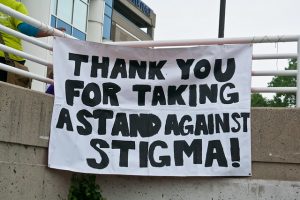
Patient advocates with the above-mentioned illness have wanted a more medically sounding name, like Myalgic Encephalomyelitis (ME). Gathering data that proved or disproved a stigma can help provide patients with ammunition to officially change the name of chronic fatigue syndrome (CFS). Along with patient advocates, a DePaul team conducted several studies to support this attempt at change.
In one of these, medical school students were given a description of a patient with common symptoms of CFS. The trainees were randomly assigned to several groups, and each group was given a different diagnostic label for the patient, such as CFS or ME. Results of these studies showed that the students’ beliefs about CFS changed depending on which diagnostic labels were used (Jason, Taylor, Stepanek, & Plioplys, 2001). When the most serious medical-sounding term, ME, was used, the patient’s condition was taken more seriously and participants were more likely to assume the illness had a real medical cause. Name-change advocates quickly cited the study’s findings that diagnostic labels can influence perceptions to justify establishing a new name for CFS.
Due to these findings and the persistence of patient advocate groups, patient groups around the world have now begun using other names like ME and ME/CFS for both their organizations and the illness (the major CFS scientific organization changed its name to the International Association of CFS/ME).

In our work, it is important to establish collaborative relationships with stakeholders and communities. Collaboration involves building relationships, particularly methods that focus on respect for diversity, difference, trust, and leaving space for accountability and responsibility. To be successful, it is first important to understand the culture and context in which members of the community operate, engage in the process of making sense of the problem, and collectively explore solutions. Community psychologists, working nationally or internationally, are committed to raising critical awareness that undermines abusive conditions.
Another danger in our work with communities has been referred to as heroism. Heroism is when a person works with underprivileged, disadvantaged populations and indicates that he or she has solutions to the community’s problems. Sometimes you see this in journals or presented on television or travel documentaries (e.g., Parts unknown, cuisines, cultures and politics). This is something that community psychologists avoid when working with communities.
As an international community psychologist, it is important to be aware of other ways of seeing and being (Schostak & Schostak, 2008). Doing Community Psychology means creating a relatively safe space to speak up and share experiences and feelings. Working in international settings is all about having the ability to listen and acknowledge the capacities of others to solve their problems. However, it is important to not allow those with power, representing the status quo, to impose their values on communities (Prilleltensky, 1994).
In this sense, our work is of an ideology designed to alleviate the suffering of oppressed people, serve the refugee camps and marginalized communities, and respond to the need for psychosocial support and services.

As you are perhaps becoming aware, there are unique barriers to doing International Community Psychology work. Here are just a few.
A barrier to doing Community Psychology work is finding collaborators. As with at-home Community Psychology, the key to finding collaborators is to reach out and build networks. Attending local and international conferences and seeking out foreign attendees are also winning strategies. (Both APA and SCRA offer both domestic and international travel grants for students to attend such conferences.) Another source of contacts and collaborators are workshops and presentations on campuses by international organizations such as non-governmental organizations, charitable and non-profit organizations, including religious organizations, businesses, and international professional associations.
Another way is to participate in international special issues of journals. Doug Perkins of Vanderbilt (see Case Study 4.1) notes that researchers in other countries tend to be more open to international collaborations – perhaps even more open than US-based researchers. If you read an interesting journal article – contact the author! Because these researchers are typically in non-English-speaking countries, they may wish to collaborate with you to improve their language skills.
If visiting a country on holiday or excursion, we advise searching for research in that country or viewing the local university faculty listing of the psychology department beforehand. Of course, before visiting you should contact people in writing with a brief introduction of yourself and politely initiate contact while in-country.

Another obvious barrier to doing Community Psychology work is not speaking the local language. You might be surprised to learn that English is the standard language used in international conferences. According to the interviewees in Harvey and Mihaylov (2017), learning the local language is not necessary, and often collaborators speak English and wish to develop this skill with international collaborators. However, learning some of the local languages is always appreciated and shows respect.
You might also inadvertently use offensive language—or hear it. Remember, international perspectives mean that people view the same things differently, and these discomforts are part of the experience. If used as “teachable moments” they will become enriching and eye-opening. In many parts of Eastern Europe, the English word “community” evokes something negatively associated with life under repressive communist regimes that ended in 1989-1991. This negative association led to the decision to name a Community Psychology class “The Psychology of Social Change,” which is taught to English-speaking undergraduates from the region at the American University in Bulgaria.
One of the ways that community psychologists work to promote social change is through public policy. In many cases, this means working with local and national governments. In international settings, positive and negative views about politics, and of what governments can and cannot do because of resources, priorities, levels of accountability, and how they are viewed by the community will all have an impact on “how things are done around here.” This awareness is crucial—if political action is viewed as futile or hopelessly corrupt, then perhaps a more grass-roots approach is necessary.
In addition, International Community Psychology “guests” may have widely varying influence on public policy – from being welcomed as an “outside expert” to being viewed as a “foreign intruder.” The individual international community psychologist may or may not have an influence on how they are perceived by the locals or the government. Again, knowing the context and depending on local experts is recommended.

Experienced International Community Psychology practitioners report that their international work creates opportunities for creativity, reflection and self-discovery, as well as striving toward new visions of human life that could not be accomplished in one’s native setting. Below is a list of practical skills and examples from doing International Community Psychology work.
The former poet laureate Robert Pinsky (2002) wrote: “American culture as I have experienced it seems so much in process, so brilliantly and sometimes brutally in motion, that standard models for it fail to apply.” Pinsky’s observation suggests that cultural change requires two fundamental attributes: knowing what is possible and that the ability and speed of cultural change is also a part of the culture.
International Community Psychology teaches us that all issues of social change involve cultural changes. What does this mean in practical terms? It means that the timescale of International Community Psychology interventions might be years or even be intergenerational. It means working on small, incremental, bottom-up changes rather than large-scale, top-down changes. It certainly means taking the long view, as advocated by Jason (2013).
Cultural competence is not only working with our collaborators and participants; it also applies to the field of Community Psychology itself. And we stated earlier, International Community Psychology lends itself to exposing one’s competence (or need to develop more thereof) as a fundamental benefit of International Community Psychology work.
The value of International Community Psychology is to experience radically new contexts. An international community psychologist cannot “parachute” into an international setting and expect to get things done in the way they might be accustomed to. Our field is an applied field; learning how to bring about social change in a radically different cultural context requires a lot of exploration.

Like the diagram above, what is visible in a culture is small compared to the reality underneath the surface. The experience of working below the surface can inform the community psychologist of their own deficiencies and areas for improvement. Working below the surface can remind you of your goals in the work. It teaches pragmaticism. When working in an environment where blatant corruption such as bribing is necessary, confronting the corruption as a foreign guest might leave you feeling judgmental (see ethnocentrism).
The benefit is that these experiences develop competence by relying on collaborators and local expertise to achieve the goals of the work. This helps the international researcher to develop empathy while helping to confront personal biases and limitations. Many international community psychologists learn to welcome this discomfort. If one lives like a local in the community, and embraces the ambiguity of the unexpected and unplanned, things will start to happen on their own. This reminds us to be open for opportunities for interactions with local populations, where the best information may be gathered while on a bus, waiting in line, or even when stranded. “What seems like chaos can turn into something beautiful” (Harvey & Mihaylov, 2017, p. 291).
Cultural competence is one of the integral values of Community Psychology established at the Swampscott Conference. But as the interviewees explained in Harvey and Mihaylov (2017), if you do not yet have cultural competence in an international setting, you can certainly foster cultural humility. Humility is a concept that might erroneously be conflated with humiliation. This is most emphatically not what we mean. Humility, at its simplest, is the attribute of being teachable and accepting that one has much more to learn—so much so that one is not really sure what one does not know. One of the benefits of being teachable is that it forces the international community psychologist to listen and to ask questions through their collaborators. Although perhaps inefficient, it allows for much more interaction and time to build valuable trust and knowledge.
In International Community Psychology practice, you may be entering a community in which conditions are dire. You might witness extreme poverty, sexism, or indifference to the suffering of others. You might see blatant corruption of government officials and the effects of that corruption on the community. Remember, people live their entire lives in conditions very different from your own. You might experience feelings of guilt and become acutely aware of the privilege of being a person living in the “wealthy” US.
As you will learn from this book, Community Psychology is unique in its approach, but it is not as well-known as Clinical or Social Psychology. This is especially true in international settings, where even the word “psychology” may mean “mental illness” and have the stigma associated with that label.
According to Perkins (2019), Community Psychology is represented least in countries where it is needed the most. The good news is that people need not be familiar with Community Psychology to benefit from the sort of actions, interventions, and useful knowledge community psychologists can generate. These include participatory action-research, needs assessment, strengths-based approaches, and program evaluation. Given the right collaborators and approaches, the welcome an international community psychologist may experience on entry into a community can be overwhelmingly positive (Harvey & Mihaylov, 2017).

In addition, there is an advantage starting from small beginnings. A small beginning in International Community Psychology work can have a real impact on a school, village, family, or community. Like a tiny mustard seed growing into a huge tree, a small project can lead to significant developments as people become empowered and begin to take control of their lives and communities. Very often in international work, you have the opportunity to create something brand new and see the effects first-hand. This is what makes international work unique and satisfying.

A good place to start is the SCRA International Committee to explore the international experiences of others. These are invaluable for connecting Community Psychology students and researchers from all over the world. APA’s Division 52: International Psychology promotes global perspectives on mental health and research.
If you want to see international research in action, we advise visiting the Community Innovators page on The Community Toolbox and clicking on a pin on the map.

International work is rewarding and challenging. Regardless of whether working “at home” or internationally, the principles are the same: We cannot ignore injustices just because they occur far away from home; besides violating community psychologist’s core values, all injustices—asylum seekers fleeing from war and armed violence, enforced poverty, and sexual slavery—will eventually affect us at home too. We must consider the global context to address the root causes of local social problems. For every complex problem, there is no simple, easy, or right solution. According to Steve Herbret, complex problems invariably require complex and difficult solutions. Community psychologists who foster such “brave spaces” can awaken liberation knowledge and practices anywhere they work.
Culture and context is the water in which we International Community Psychology fish swim. This view is that culture is not a “thing” – it is a process that influences how we see others and how others see us (Geertz, 1973). International Community Psychology work can reveal strengths in us and in our international collaborators that may not have been discovered otherwise. Taking a risk by being a fish in different waters can accomplish this.
We wish you happy swimming!
Critical Thought Questions
Take the Chapter 4 Quiz
View the Chapter 4 Lecture Slides
____________________________________________________________________
Burchett, H. E. D., Lavis, J. N., Mayhew, S. H., & Dobrow, M. J. (2012). Perceptions of the usefulness and use of research conducted in other countries. Evidence and Policy, 8(1), 7–16. https://doi.org/10.1332/174426412X620100
Fetterman, D., & Wandersman, A. (2007). Empowerment evaluation: Yesterday, today, and tomorrow. American Journal of Evaluation, 28(2), 179–198. https://doi.org/10.1177/1098214007301350
Geertz, C. (1973). Thick description: Toward an interpretive theory of culture. In The interpretation of cultures: Selected essays (pp. 3-30). New York, NY: Basic.
Harvey, R., & N. Mihaylov (2017). Doing Community Psychology internationally: Lessons learned in the field. In J. J. Viola & O. Glantsman (Eds.), Diverse careers in Community Psychology. New York, NY: Oxford University Press.
Jason, L. A. (2013). Principles of social change. New York, NY: Oxford University Press.
Jason, L. A., Glantsman, O., O’Brien, J. F., & Ramian, K. N. (2019). Introduction to the field of Community Psychology. In L. A. Jason, O. Glantsman, J. F. O’Brien, & K. N. Ramian (Eds.), Introduction to Community Psychology: Becoming an agent of change. Retrieved from https://press.rebus.community/introductiontocommunitypsychology/chapter/intro-to-community-psychology/
Jason, L. A., Taylor, R. R., Stepanek, Z., & Plioplys, S. (2001). Attitudes regarding chronic fatigue syndrome: The importance of a name. Journal of Health Psychology, 6, 61-71. doi: 10.1177/135910530100600105
Perkins, D. D. (2019). The global development of applied community studies: Comparison and evaluation of trends in psychology, sociology, social work and other community sciences. Published in Liminales: Escritos sobre Psicología y Sociedad / Writings on Psychology and Society By the Facultad de Ciencias Sociales, Universidad Central de Chile. Based on invited addresses at UC-Chile: Santiago and La Serena, Chile (October 1-2, 2018) and at the Biennial Conference of the Society for Community Research and Action (2017: Ottawa, Canada) in recognition of the 2016 SCRA Award for Distinguished Contributions to Theory and Research in Community Psychology. Retrieved from https://www.researchgate.net/project/Global-Development-of-Applied-Community-Studies
Pinsky, R. (2002). Democracy, culture and the voice of poetry. Princeton University Press. Retrieved from http://www.jstor.org/stable/j.ctt7rxs5
Prilleltensky, I. (1994). The morals and politics of psychology. Albany, N.Y: State University of New York Press.
Reich, S. M., Riemer, M., Prilleltensky, I., & Montero, M. (2007). International community psychology: History and theories. New York, NY: Springer Science + Business Media.
Schostak, J., & Schostak, J. (2008). Radical research: Designing, developing, and writing research to make a difference. London, England and New York, NY: Routledge Taylor & Francis Group.
Shweder, R. (1990). Cultural Psychology – what is it? In J. Stigler, R. Schweder, & G. Herdt (Eds.), Cultural Psychology: Essays on Comparative Human Development (pp. 1-44). Cambridge, England: Cambridge University Press.
Vassileva, J., Petkova, P., Georgiev, S., Martin, E. M., Tersiyski, R., Raycheva, M., . . . Marinov, P. (2007). Impaired decision-making in psychopathic heroin addicts. Drug and Alcohol Dependence, 86(2-3), 287-289.
Zippay, A. (1995). The politics of empowerment. Social Work, 40(2), 263-267.
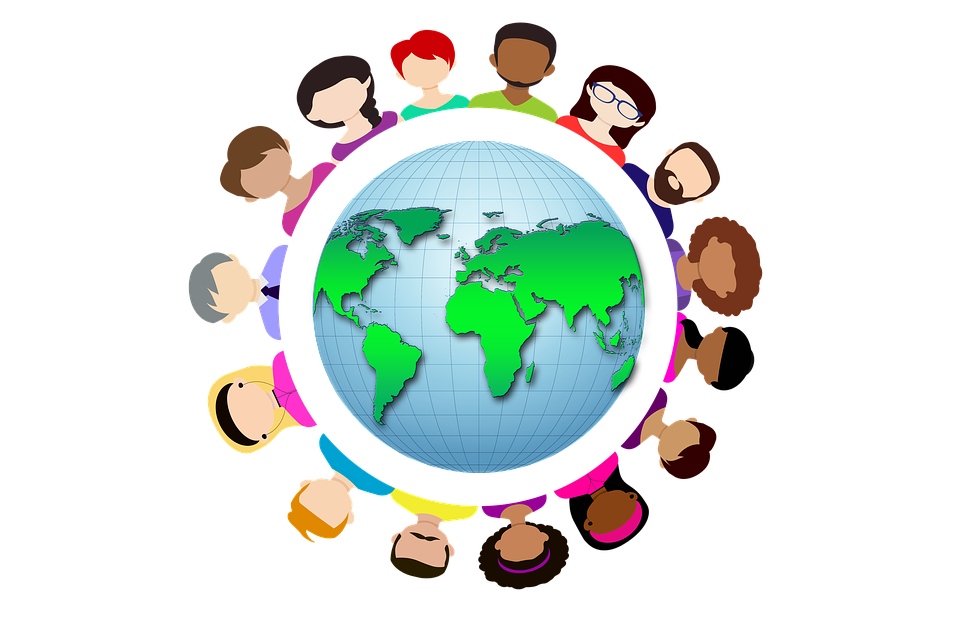
Chapter Five Objectives
By the end of this chapter you will be able to:
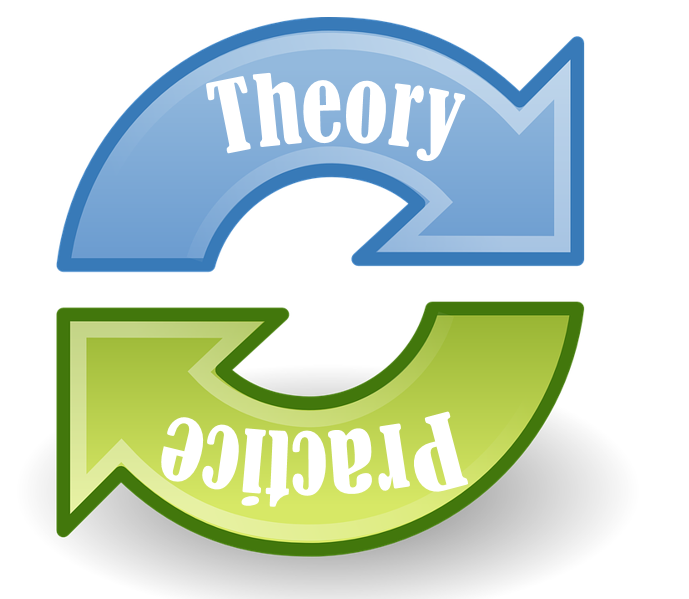
Theories are important for anyone that is trying to bring about social change. They help point us to what is really important to change, versus what might be more trivial and lead to ineffective action. But first, let’s look closely at what theories enable us to do. Most simply, theories allow us to describe, predict, and better understand something. Here is an example: Newton observed that an apple fell from a tree. In that famous story, he was able to first describe the apple falling. It is the first part of the scientific journey, to describe something that you might see. The second step is to predict something based on what you just saw. For example, when Newton dropped a ball or other object, he predicted it would also fall, and that allowed him to be able to make predictions, which is the second part of a theory. Finally, a theory provides an “explanation” of what you just saw, in this case, the explanation being that gravity was causing the objects to fall to the earth.
Why are theories important?
That brief example reviews all the basic parts of a theory and can help us understand the role of theories in the field of Community Psychology. Theories have provided us with useful ways of thinking about the importance of the individual in relationship to the environment or community. The individual is influenced by the environment, which means that we must look beyond just individual factors when we try to analyze social problems or develop community interventions. Case Study 5.1 illustrates why theory matters, as it can provide us a lens to see the individual closely connected and influenced by the context.
Case Study 5.1
Ecological Theory
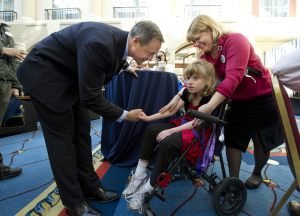
Partners in Policy making™ is a national model of leadership training for people with developmental disabilities, and parents or family members of those with those disabilities. Partners in Policy making™ is designed to provide knowledge about issues related to disability and to develop competencies of the participants to become effective advocates in influencing public policy in their local settings and at all levels of government. Partners in Policy making™ uses Ecological theory in how they have designed the training for participants so they understand how ecological principles influence their advocacy. Partners in Policy making™ uses an Ecological model of disability advocacy that takes into consideration the perspectives of people at multiple levels of community, including 1) the experiences of the individual person with the disability, 2) others in the local area affected by the same challenges, 3) the local policies that need to change to make things better for the whole community, and 4) the policy changes that may also need to change at the national level. For example, a person with a disability who uses a wheelchair may be struggling to find adequate housing that has an elevator for their full inclusion in that building community. They will need to find out if this is a shared experience of other people in the community area and organize locally to pressure local policy change to enforce building requirements for people using wheelchairs. This could also become an opportunity for national policy change. Community psychologists are collaborating and supporting the work of community advocates through a state-funded agency that facilitates funds, and evaluates this training and community intervention.
As this case study illustrates, theories in Community Psychology help us think about developing interventions that involve not just the challenges experienced by certain people with disabilities but also the environmental factors that maintain these challenges. In this case, we may learn that the community of people with disabilities extends to people that might temporarily or long-term need to use a wheelchair. Toward this goal, the theories of Community Psychology assist in understanding how to bring about change by involving both the youth and their schools and other community settings. As indicated in Chapter 1 (Jason, Glantsman, O’Brien, & Ramian, 2019), theories in Community Psychology are based on core values and principles that involve a commitment to social justice for marginalized groups, creating more equitable distribution of resources across groups, an appreciation for a diverse array of worldviews, working in collaboration with communities, and adhering to a strengths-based approach to working with others. Community psychologists want to address the needs of people affected by natural disasters, people who have been historically marginalized (e.g., people living as ethnic minorities in the US, aboriginal people living in Australia, etc.), and people who identify with a community that is dealing with some type of societal discrimination (e.g., people with disabilities, people identifying with the LGBTQ community, etc.). Ultimately, Community Psychology theory helps to broaden our understanding of the social contexts in which we live so we can better work with others to identify important levers for change and assist in creating healthier spaces within our communities. As we will show in this chapter, theories help focus community psychologists on these areas for both their research and activism.
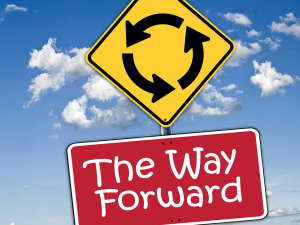
In a survey that recently asked community psychologists to nominate theories that have been used in their work, over 30 were mentioned (Jason, Stevens, Ram, Miller, Beasley and Gleason, 2016). Barker (1968) for example developed behavior setting theory to understand the relationship between individual behaviors and varying characteristics of the physical environment. A behavior setting is considered to be a place, a time, and a standing pattern of behavior. The main finding of this research was that settings generally have rules where any person within the same setting would act similarly; that people are interchangeable and you would still get the same behavior patterns. Understanding this information helps us to better understand the features of settings, including the social and cultural dynamics that maintain certain types of settings. This type of work can explain why some settings, such as prisons, often end up producing similar negative outcomes for individuals that are confined to these total institutions.
As several of the theories have been described in other chapters in this book (e.g., Empowerment and Behavioral models), they will not be reviewed below. This chapter will review some of the more prominent and influential theories that have laid the foundations of this field.

The ecological theory was developed by James Kelly (1966) who was one of the founders of the field of Community Psychology. The purpose of his theory, as shown in Table 1 below, is to provide a framework for understanding the structure and function of community. This theory assists in learning how the characteristics of the environment of the community can play a central role in the ways people interact and relate to each other. Through this framework, we can consider the dynamics among groups, organizations, and whole communities as they relate within certain settings, and help guide thinking around the development of community interventions (Kelly, 1968).
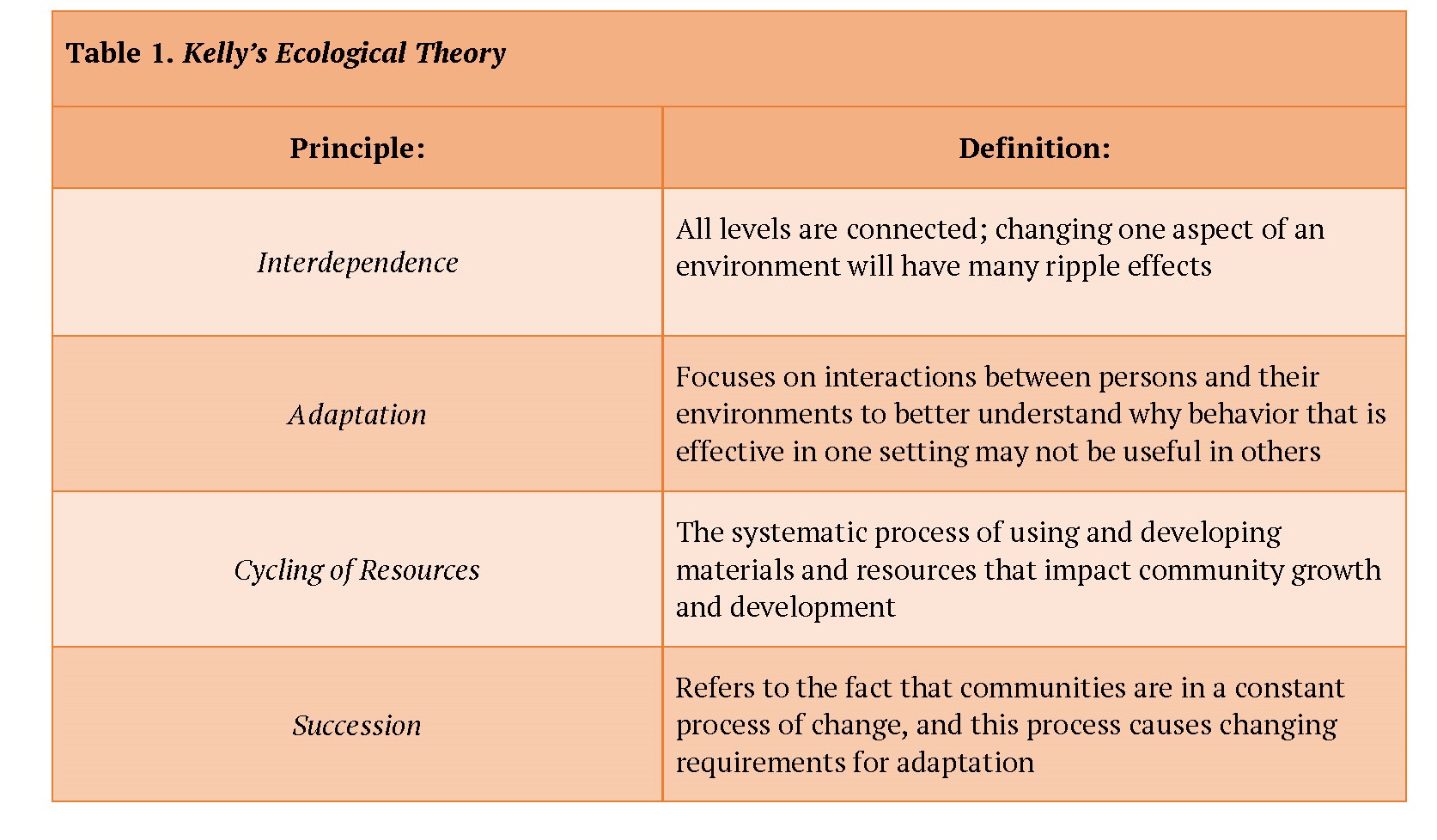
Kelly’s theory outlines four principles necessary for understanding inherent undercurrents within social systems that can be used to guide the assessment, development, and evaluation of preventive community interventions. The four principles include 1) Interdependence, 2) Adaptation, 3) Cycling of resources, and 4) Succession.
The principle of Interdependence helps us understand that any change in one component of a system can affect changes in other components of the system as well, such as a domino effect. The concept of interdependence is central to the theory and practice of Community Psychology because it helps individuals to recognize that everything is interconnected. Case Study 5.2 provides an example of this principle.
Case Study 5.2
Mini-Grants Can Have Radiating Effects
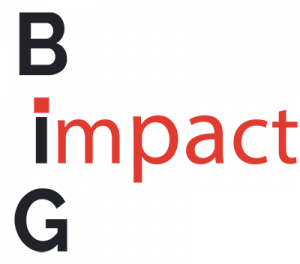
One intervention developed by community psychologists that captures how interdependence works is a local community mini-grant program. The program provided “mini-grants” to community residents that were designed to improve the physical structure and appearance of neighborhoods (i.e., refurbished schools, fixing broken windows on local houses, recreational and park systems, etc.). When community residents were provided with mini-grants, they not only improved their neighborhoods and school systems, but more importantly, they were provided with opportunities to build relationships with other neighbors through increased interactions and communication. Community psychologists would recommend that investigators assess and capture these types of interdependent dynamic processes that often occur with these types of easy to implement change strategies (Foster-Fishman, Nowell, & Wang, 2007).
Adaptation refers to the process of change and how what might be adaptive in one environment might not be in another. A child might be very extroverted and sociable, and have many friends due to these characteristics. But the child’s popularity among peers might not be valued by the teachers in the school, who might not appreciate if this child talks to others and socializes frequently in the classrooms. So, what might be very adaptive in one type of setting might not be in another setting. Kelly (1979) found that schools that had many new students entering each year facilitated more youth exploratory behavior than schools that were stable in terms of enrollment. These types of findings help us understand this process of adaptation, to better understand the factors that account for why certain environments are more effective than others.
The third ecological principle is cycling of resources. Cycling of resources refers to the process of how communities identify, incorporate, and use different types of resources that exist within their communities. Resources can be skills and expertise, information, networks of social support, access to supplies or equipment, and socialization processes that either deter bias (i.e., gender or racial) or provide events (e.g., celebrations) for social and cultural cohesion. Using this principle, psychologists might either uncover existing competencies in a setting or match individuals with the settings that provide the resources they need, as indicated in Case Study 5.3.
Case Study 5.3
Resources Within Community Gardening
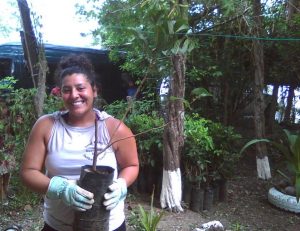
Community gardening, forestry, and fruit tree planting programs provide unique opportunities in demonstrating the importance of teaching community residents the psychological and physical benefits of green space sustainable activities (Hoffman, 2019). In a sense, these are resources available to everyone if we just notice them in our environment. Community gardening and horticultural programs can promote valuable educational skills as they provide opportunities for individuals to collaboratively engage in healthful restorative and sustainable practices with other community residents and understand the multiple benefits of basic gardening knowledge and skills. The basic resources of soil, compost, and seeds are used to grow foods and the garden area is used to teach younger children (and adults) the principles of horticulture and healthy food production. In community gardening, what may have once existed as a piece of unused land within a community would be converted to a community garden, where healthy foods are produced and consumed by the community members, promoting a new local resource for healthy natural foods cultivated by local people at minimal cost. Read more about the project here.
The final component of Kelly’s ecological theory is Succession, which refers to the fact that communities are in a constant process of change, and this process causes changing requirements for adaptation. What is true about a person or setting today may not be true tomorrow. The process of change and development within the community over time is inevitable and communities have an obligation and need to help residents meet the demands of changing environments. For example, as populations within the community tend to age, newer and younger families can work with older residents by sharing information and creating a more holistic environment for all community members. Additionally, as new family groups from different ethnic backgrounds become prevalent within the community, traditional institutions (i.e., school systems and community businesses) will need to evolve and adapt to meet the demands of a changing population. An example of a problem with succession in practice is illustrated in Case Study 5.4.
Case Study 5.4
The Evolution of Coalitions Over Time
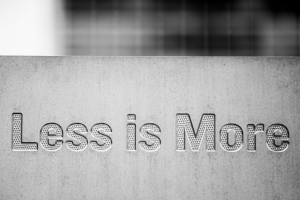
Campbell, Greeson, Bybee, & Fehler-Cabral (2012) found that communities can become “over-coalitioned” or have too many coalitions, leading to poorer outcomes. These community psychologists studied a community coalition that was working to facilitate better case outcomes for sexual assault cases in the criminal justice system involving adolescent victims. They found that over time, the addition of a related coalition in the same community—focusing on sexual assault cases involving young children—led to poorer outcomes for the first coalition. They theorized that the new coalition spread thin the existing human and other system capital needed to ensure good outcomes.
The theory of Sense of Community was first described by the community psychologist Sarason (1974). This theory was meant to capture the feeling a person experiences when they perceive themselves as having an interdependent connection with a broader community outside themselves. More specifically, Psychological Sense of Community is: “the feeling one is part of a larger dependable and stable structure” (p. 157). McMillan and Chavis (1986) defined Sense of Community as a feeling that members have of belonging where members feel that they matter to one another and the group. There is a shared faith that members’ needs will be met through their commitment to be together. Community psychologists measure Sense of Community by assessing: 1) Membership, 2) Influence, 3) Integration and fulfillment of needs, and 4) Shared emotional connection. Membership involves clear boundaries regarding who is in and who is out of the specific community. Influence refers to the ability one feels they have to influence the broader community- and individual-level norms that guide the practices of the community. Integration and Fulfillment of needs refer to feeling connected to a network that holds shared values, that exchanges resources, and meets needs. Shared emotional connection refers to participating in the celebrations of others, and participation in specified rituals or ceremonies.
If Sense of Community is a core value, then it is important to try to find ways to reliably assess and measure it so that we can assess how an intervention might affect the Sense of Community. If for example, an intervention is effective in a particular outcome, such as increasing academic grades in youth, but has the negative consequence of reducing the Sense of Community for the students in the classroom, then community psychologists would judge this an ineffective and potentially harmful intervention. There have been attempts at better conceptualizing and measuring Sense of Community, in order to understand how people experience their connection with their community. The following case study used a brief and reliable scale developed by Jason, Stevens and Ram (2015) to measure the psychological Sense of Community among those involved in the Columbian peace process.
Case Study 5.5
Columbian Peace Process and Sense of Community
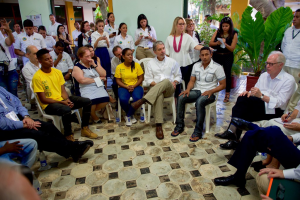
As part of the Colombian Peace Process victim assistance programs, Maya-Jariego, De La Peña-Leiva, Arenas-Rivera, and Alieva (2019) used the nine‐item Psychological Sense of Community scale which evaluates the value attributed to the community (e.g., “I am not planning on leaving this neighborhood”), the relationships among the members of the collective (e.g., “neighbors can get help from other neighbors if they need it”), and the emotional connection of the individual with the collective (e.g., “I feel good helping the neighborhood and its neighbors”). The study was part of the effort to reincorporate into civilian life the ex‐combatants, and demobilized persons of the armed conflict. They interviewed 143 community leaders, and they found a significant relationship between the density of personal networks and the Psychological Sense of Community. They concluded that socio-geographic segregation derived from housing policies can be an obstacle to the effective functioning of the coexistence and reintegration programs of victims and demobilized persons of the armed conflict.

Rudolf Moos (2003), another influential community psychologist, developed the Social Climate theory in an effort to better understand the natural interplay between individuals and their social contexts. Social Climate theory helps to understand how people adapt to their social environment and how contexts adapt to people. Social climate taps these three main dimensions: 1) how people perceive a setting organizes their perceptions of social relationships, 2) how people perceive they are being supported in their personal development, and 3) how people perceive the setting handles the maintenance of norms and supports change processes. From a psychological measurement perspective, scores of social climate are very much related to indicators of individual well-being. This measure has been useful for assessing setting dynamics within schools and juvenile treatment programs.

An example of a situation where you might use this theory is when seeking to understand the experience of people in a particular setting, such as an organization where people are said to be experiencing discrimination. You would use a social climate survey to assess to what extent the people within this organization are experiencing similar challenges in all corners of the organization. Depending on which departments/offices are experiencing the highest levels of discrimination, this may have implications for ways a community psychologist could intervene to change how the setting is experienced moving forward.
Scores to measure Social Climate are very much related to indicators of individual well-being. This measure has been useful for assessing setting dynamics within schools and juvenile treatment programs (Moos, 2003). Theories and measures need to be rigorously tested so that they can be improved, as witnessed by Leipoldt, Kayed, Harder, Grietens, and Rimehaug (2017). They found that the original subscales developed by Moos needed to have weak items removed, and once this occurred, the revised version showed acceptable measurement qualities.

Liberation Psychology (or psicología de la liberación) is based within a more critical perspective which acknowledges the role of power and the ongoing battle for resources. As part of the critique of traditional psychology, Liberation Psychology was developed in Latin America during the 1970s as a theoretical framework to better understand oppressed and impoverished communities (Montero & Sonn, 2009).
Many people around the world live in an oppressive society where one group has power over another (See Chapter 4; Palmer et al., 2019), and this contributes to unequal distribution of resources. Liberation psychology emphasizes helping people to gain more control over the resources that affect their lives. Aspects of Liberation Psychology are embedded within Empowerment Theory (See Chapter 10; Balcazar, Keys, & Vryhof, 2019).
Core components of Liberation Psychology include praxis and dialectics. Praxis can be thought of as a tool for acquiring knowledge and transforming oppressive realities involving a conscious integration of theory and practice to make theory more grounded in reality (Montero & Sonn, 2009). Dialectics is a philosophy of praxis emphasizing that knowledge is not created unless acquired through a method of mediated social discourse. In other words, we develop knowledge about the world and simultaneously work to bring about change. Dialogue needs to occur between power holders and the oppressed to raise the consciousness of all to understand the meaning of oppressive actions (see Chapter 17; Olson, O’Brien, & Mingo, 2019). This raised awareness of conditions challenges the status quo and may create a desire for those in power to be more humane. Ultimately, the hope if for the encouragement of a rethinking of problems “with and from, the oppressed; with a commitment to unveil and characterize conditions of oppression and exploitation suffered by large sectors of the population” (Montero & Sonn, 2009; pp. 31).

Theories are used in Community Psychology to ensure we are addressing the community dynamics in all the ways needed to be most effective in promoting a social justice agenda. Community Psychology represents an innovative perspective focused on understanding how environments shape and are shaped by people’s life. This requires theoretical frames that help us better understand community settings and physical contexts rather than more traditional approaches where we might only try to change the individuals experiencing a problem, such as through individual therapy or medication. In fact, individuals from around the world are drawn to the ideas of Community Psychology because it has suggested ways to respond to the social issues and needs of marginalized populations struggling with colonization, racism and oppression in North America, Latin America, South Africa, Australia, and New Zealand (Reich, et al., 2017).
Given that Community Psychology is embedded in a deep understanding of community context. Our theories help us to more clearly critically analyze the social context and historical context within which we need to consider the allocation and distribution of resources, as well as the assumptions that have developed the world we live in.
Critical Thought Questions
Take the Chapter 5 Quiz
View the Chapter 5 Lecture Slides
____________________________________________________________________
Balcazar, F. E., Keys, C. B., & Vryhof, J. A. (2019). Empowerment. In Jason, L. A., Glantsman, O., O’Brien, J. F., & Ramian, K. N. (Eds.), Introduction to Community Psychology: Becoming an agent of change. Retrieved from https://press.rebus.community/introductiontocommunitypsychology/chapter/empowerment/
Barker, R. G. (1968). Ecological psychology: Concepts and methods for studying the environment of human behavior. Stanford, CA: Stanford University Press.
Campbell, R., Greeson, M., Bybee, D., & Fehler-Cabral, G. (2012). Adolescent sexual assault victims and the legal system: Building community relationships to improve prosecution rates. American Journal of Community Psychology, 50(1-2), 141-154. doi:10.1007/s10464-011-9485-3
Foster-Fishman, P. G., Nowell, B., & Wang, H. (2007). Putting the system back into system change: A framework for understanding and changing organizational and community systems. American Journal of Community Psychology, 39, 197-215.
Hoffman, A. J. (2019). Creating a culture of transformation in Guatemala: One fruit tree at a time. Electronic Green Journal, 1(40). Retrieved from https://escholarship.org/uc/item/3p03s4gk
Jason, L. A., Glantsman, O., O’Brien, J. F., & Ramian, K. N. (2019). Introduction to the field of Community Psychology. In L. A. Jason, O. Glantsman, J. F. O’Brien, & K. N. Ramian (Eds.), Introduction to Community Psychology: Becoming an agent of change. Retrieved from https://press.rebus.community/introductiontocommunitypsychology/chapter/intro-to-community-psychology/
Jason, L. A., Stevens, E., & Ram, D. (2015). Development of a three-factor psychological sense of community scale. Journal of Community Psychology, 43, 973-985.
Jason, L. A., Stevens, E., Ram, D., Miller, S. A., Beasley, C. R., & Gleason, K. (2016). Theories in the field of community psychology. Global Journal of Community Psychology, 7(2), 1-27.
Kelly, J. G. (1979). Adolescent boys in high school: A psychological study of coping and adaptation. Hillsdale, N.J: L. Erlbaum Associates.
Kelly, J. G. (1966). Ecological constraints on mental health services. American Psychologist, 21, 535-539.
Kelly, J. G. (1968). Toward an ecological conception of preventive interventions. In J. Carter (Ed.), Research contributions from psychology to community mental health (pp. 75-99). New York, NY: Behavioral Publications.
Leipoldt, J. D., Kayed, N. S., Harder, A. T., Grietens, H., & Rimehaug, T. (2017). Refining the COPES to measure social climate in therapeutic residential youth care. Child & Youth Care Forum, 47(2), 173–197. doi:10.1007/s10566-017-9424-z
, , , . Personal networks, social media, and community cohesion in the strategies of peace‐building agents in Colombia to counteract the segregation of displaced populations. J Community Psychol. 2019; 1– 13. https://doi.org/10.1002/jcop.22173
McMillan, D. W., & Chavez, D. M. (1986). Sense of community: A definition and theory. Journal of Community Psychology, 14, 6-23.
Moos, R. H. (2003). Social contexts: Transcending their power and their fragility. American Journal of Community Psychology, 31, 1-13.
Montero, M. & Sonn, C. (2009). Psychology of liberation: Theory and applications. New York, NY: Springer
Olson, B. D., O’Brien, J. F., & Mingo, E. (2019). Social and political change. In L. A. Jason, O. Glantsman, J. F. O’Brien, & K. N. Ramian (Eds.), Introduction to Community Psychology: Becoming an agent of change. https://press.rebus.community/introductiontocommunitypsychology/chapter/social-and-political-change/
Palmer, G. L., Ferńandez, J. S., Lee, G., Masud, H., Hilson, S., Tang, C., . . . Bernai, I. (2019). Oppression and power. In L. A. Jason, O. Glantsman, J. F. O’Brien, & K. N. Ramian (Eds.), Introduction to Community Psychology: Becoming an agent of change. Retrieved from https://press.rebus.community/introductiontocommunitypsychology/chapter/oppression-and-power/
Reich, S. M., Bishop, B., Carolissen, R, Dzidic, P., Portillo, N., Sasao, T., & Stark, W. (2017). Catalysts and connections: The (Brief) history of Community Psychology throughout the world. In M. A. Bond, I. Serrano-Garcia, & C. B. Keys (Eds.), APA handbook of Community Psychology: Theoretical foundations, core concepts, and emerging challenges (Vol. 1, pp. 22-66). Washington, DC: American Psychological Association.
Sarason, S. B. (1974). The Psychological Sense of Community; prospects for a community psychology. San Francisco, CA: Jossey-Bass.

Chapter Six Objectives
By the end of this chapter you will have a better understanding of:
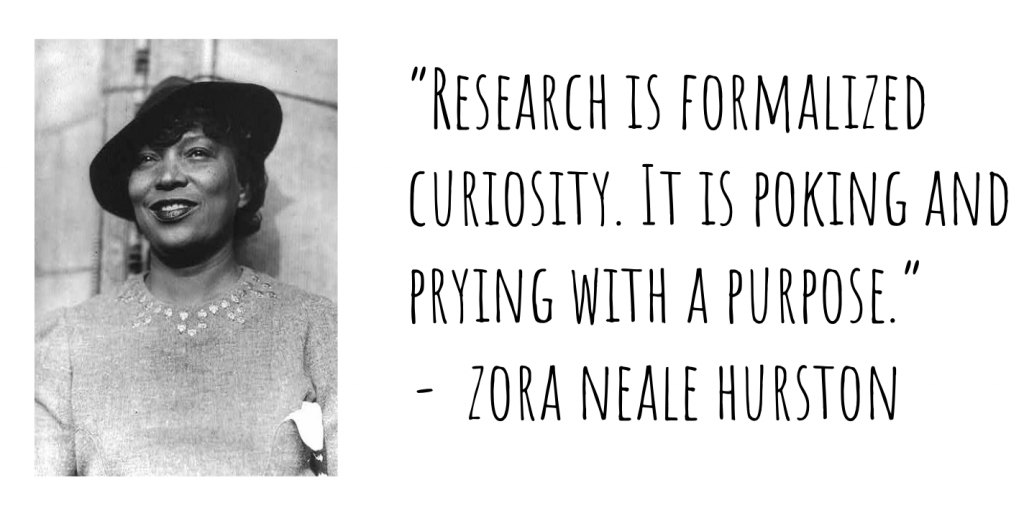
In psychology, we generally call the results of our research “findings” or “outcomes.” In this chapter, we will explore how a Community Psychology lens can help shape our research and ultimately influence our findings and outcomes. We will learn how the way we measure programs cannot exist in a vacuum, and therefore we must consider the context and environment of any situation. Take this for an example: a number of years ago in a low resourced urban community, a mental health professional approached community and school leaders with an innovative program aimed at dealing with the problem of youth substance use. They agreed to use a preventive school-based intervention, and after it was launched, the research outcomes were very successful (i.e., youth substance use was reduced). However, funding for the program dried up after two years, and the mental health professional left the community when he no longer had the financial resources to mount the intervention. The school and community leaders were disappointed as they felt it had helped their youth. The mental health professional later published the outcomes in a scientific journal and described the intervention as successful. However, the community members were bitter about the program shutting down because they did not have the resources or skills to sustain it. When another mental health professional approached the same community leaders a year later with another innovative idea for a preventive program, the community was no longer receptive.
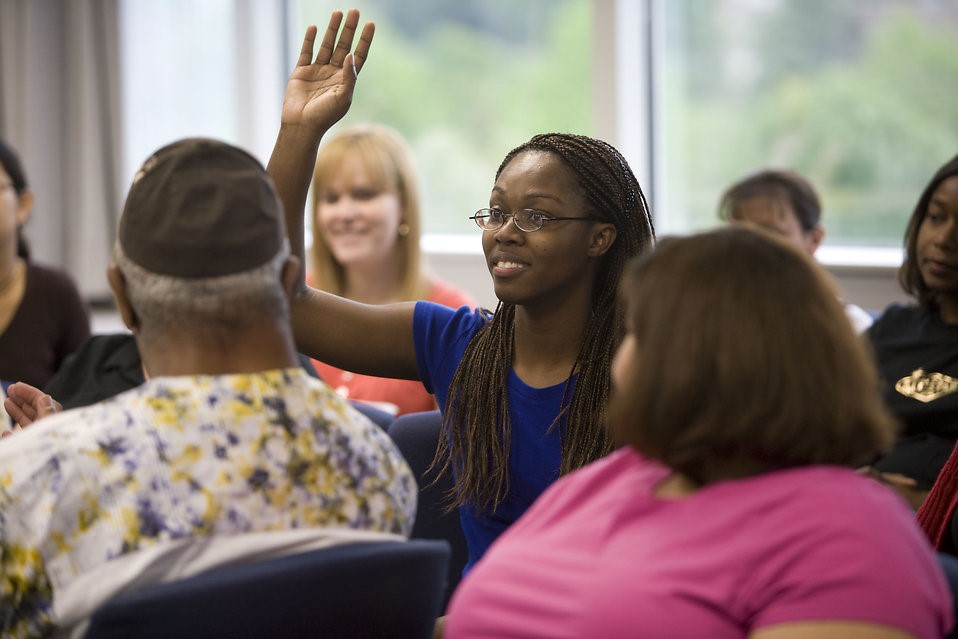
You might be wondering, was the example above considered a successful intervention? To answer this question, we need to specify the essential characteristics of evidence when measuring factors of success. Not all evidence is created equal, as the example above indicates. The best and most useful evidence is relevant, credible, believable, and trustworthy. Additionally, there are various lenses we might look through to decipher the evidence gathered from the example. From a traditional perspective, the intervention was a credible success, as youth experimented less with drugs after the intervention took place. However, from a Community Psychology perspective, the intervention was not successful as the program was not sustained, and even more important, the community members became less trusting, less open, and less willing to collaborate with others from outside their community. It is only by adopting a more ecological perspective that we can understand that interventions have impacts on individuals, groups, organizations, and communities, and even if there are positive outcomes for the youth recipients of an intervention, we must also assess a community’s receptivity for future efforts. In other words, Community Psychology would argue for broadening our research objectives to gauge the community members’ relationship to those who brought the intervention into their schools, including whether they considered them trustworthy.
To summarize, although it is important that youth might have learned certain positive skills from an intervention, it is also crucial to examine the larger context that involves whether community members feel competent to bring about effective and sustainable changes. The goals of our research need to go beyond measuring skills or abilities within youth in order to assess whether the interventions have influenced higher-level ecological issues. In this chapter, we will learn that research can be used to add to or modify our beliefs and understanding, especially when we consider how Community Psychology focuses on people and their ecological context.
The introduction of new or additional evidence can challenge existing beliefs. Consequently, there are a number of examples of research evidence that have led to changes in beliefs and behaviors, as well as the way we educate people on certain concepts. For example, as indicated in Chapter 1 (Jason, Glantsman, O’Brien, & Ramian, 2019), up until the 1960s, television, radio, and print ads encouraged adults to smoke. An example of this can be found in “The cigarette preferred by doctors” video advertisement above. Later, in 1964, the US Surgeon General’s Report on Smoking and Health reviewed over 7,000 research articles as a basis for the report, which concluded that smoking was a cause of lung cancer and chronic bronchitis. Important criteria for evidence at the time included that it was replicable and reliable. Smoking was assessed as a health hazard by checking causes of death, looking at the current health of smokers versus non-smokers, monitoring smokers versus non-smokers health over time, etc. The strongest case occurred after many investigations using multiple methods, which found similar or supporting results. After the Surgeon General’s Report in the US, policies slowly began to change regarding cigarettes and smoking. For example, advertising was significantly curtailed, cigarettes were subject to extensive state and federal taxation, and there were new regulations to reduce minors’ ability to purchase tobacco from retail establishments. As a result, rates of tobacco use declined over time.

You may have encountered the scientific process in your early schooling, and maybe you were even asked to use “description” to support conclusions that you came to. But how do we interpret and draw conclusions using the research we collect? Let’s use an example to illustrate what the term “describe” means in the research process. A description could involve the number of people living in poverty, but the exact boundaries must be set for what income falls above and below the poverty line. Another example involves describing what behaviors and characteristics qualifies someone as misusing drugs. In other words, what is the definition of “misuse of drugs”? Clearly, alcohol and tobacco kill more people than all other drugs combined, and yet both of them are legal. If you define something by whether it is legal or not, there might be varying standards in different settings. For example, in the US using heroin is illegal, so it would be thought of as “misuse of drugs,” but in the Netherlands, a government-sponsored heroin distribution program began in 1988; therefore, heroin use in the Netherlands is not illegal. In describing a social or community problem, it is apparent that cultural and societal norms need to be considered. Traditional researchers might ignore these important influences, but Community Psychology researchers would put considerable efforts into understanding the politics and values that surround and give meaning to the behaviors and conditions we intend to change.
In addition to initially describing and determining how to measure a social or community problem, research also investigates how the problem or issue is associated with other behaviors. For adolescent misuse of drugs, a traditional researcher might investigate how it is related to family history, age at first use, mental health status, etc. However, a community psychologist may focus on peer use as well as locations within the community where alcohol, drugs, and tobacco are made available to youth. As indicated in Chapter 1 (Jason, Glantsman, O’Brien, & Ramian, 2019), if a school-based tobacco prevention program is launched, but youth in the community have easy access to commercial sources of cigarettes at gas stations and liquor stores, the youth receive mixed messages that compromise the outcomes of the school-based tobacco reduction interventions. Again, community psychologists give considerable weight to these types of ecological variables when trying to understand the various environmental influences on youth behavior.

Being able to explain why certain people develop drug misuse behaviors can be complicated as well and involve many factors that need to be considered when conducting research. Many traditional psychologists would focus on trying to understand biological and psychological reasons for substance use (such as depression or feelings of isolation). Community psychologists, on the other hand, would be more inclined to examine norms and opportunities within the environment. For example, if youth in a neighborhood admire apparently wealthy drug dealers who engage in illegal activities, then this risky environment and these inappropriate role models could be some of the primary reasons for increased illegal drug use. To the extent we can describe, predict, and explain why misuse of drugs occur, we are more likely to develop effective Community Psychology based interventions which deal with factors beyond the traditional individual level of analysis.

The Belmont Report (1978) outlined basic ethical principles and applications for research. The three major ethical principles are Respect for Persons, Beneficence, and Justice. When seeking institutional approval for research with human subjects, these three areas are addressed in the application. Once again, most traditional researchers focus on individual factors (e.g., level of self-esteem, mental health issues) when considering these areas, and they would assure that youth in a preventive program have informed consent to be involved in the intervention. Community psychologists would also be concerned with ecological factors. For instance, let’s consider college students being trained to provide psychiatric ward patients with mentoring and social support. If the hospital setting was poorly run and degrading, and provided limited opportunities for skill development to prepare the patients to ultimately return to the community, this mentoring program would be considered ineffective and even unethical. If the setting’s abusive features were not addressed, then the intervention would not be able to successfully help patients reintegrate back into the community.
Professional ethics from the American Psychological Association (2003) also indicate that mental healthcare professionals should have adequate skills and abilities for the roles in which they portray themselves as competent. For traditional psychologists, this might involve being knowledgeable about current testing and therapy techniques. For community psychologists, who often work with community-based samples of individuals who have been marginalized or who have suffered other systemic disadvantages, it might be more complicated, as these populations warrant extra care. For example, criminally justice-involved individuals who are exiting prison need more than aptitude tests and one-on-one therapy, as their greatest needs after leaving jail are housing and decent jobs. Community psychologists might not be trained to provide housing or jobs; however, this is where collaboration comes into play. Community psychologists would partner with community-based organizations which have the skills and competencies to provide ex-offenders opportunities for inexpensive housing and jobs. Thus an ecological perspective, as illustrated throughout this book, would focus our efforts on providing resources and changing the environment in order to provide these vulnerable individuals with concrete opportunities to successfully transition back into society.
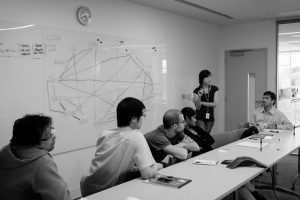
Finally, the Society for Community Research and Action (SCRA) also has specified ethical practice competencies for professionals (Dalton & Wolfe, 2012). Some of these include recognizing the influence of one’s personal background on the collaboration, so if one is from a privileged group, this could have an influence when working with community members who did not have such advantages. One essential practice competency in the field of Community Psychology is dissemination. Dissemination is the deliberate sharing of research findings to groups and communities that would benefit from said findings. Along with dissemination is implementation, which takes dissemination a step further. Implementation is the adoption of evidence-based interventions by any organization for the purpose of better serving its population. It is most helpful to develop a professional network in order to seek consultation and advice regarding these complex issues that are being encountered in analyzing social problems as well as implementing community-based interventions.
Research evidence also informs us as to whether our efforts actually adhere to these ethical standards, and an ineffective prevention program that consumes resources (e.g., time and money) may be considered unethical, as the case study below illustrates.
Case Study 6.1
A Cautionary Tale: Drug Abuse Resistance Education
The drug prevention program DARE (Drug Abuse Resistance Education) began in the mid-1980s in Los Angeles schools, and soon was implemented nationally. During the 1990s and early 2000s, roughly 75% of students in the US were taught using this DARE program to prevent drug use. However, research performed as early as 1994 suggested DARE was ineffective, and by 2004, it became clear DARE did not work (West, & O’Neal, 2004). For more than 20 years, tens of millions of students were “trained” in DARE and billions of dollars were spent on a useless program. Parents, students, and schools were, in effect, misled by “experts.”
The DARE example demonstrates how best intentions are not sufficient in performing ethical practice, as well as shows the importance of evidence in evaluating whether harm has occurred. Without the means, resources, or system to evaluate the impact of a program, ethical concerns go unaddressed. Rather than working separately from community activists and organizations, community psychologists are trained to evaluate and conduct research with members of a community (see Chapter 7; Wolfe, 2019).
Other research issues endorsed by SCRA (2019) include active collaboration among researchers, practitioners, and community members. This work is undertaken to serve those community members directly concerned, and should be guided by their needs and preferences, as well as by their active participation. This standard recognizes the importance of the population’s voice(s) in developing and executing a research plan that has the greatest likelihood of improving the population’s well-being and minimizing harm. This principle is one of the core values of Community Psychology, and it is often referred to as community-based participatory research, which was defined in Chapter 1. Nevertheless, there will be times when funding sources have their own agendas which may not accurately reflect a population’s needs, and this can pose unique challenges for those within the field of Community Psychology. In addition, the SCRA principles embrace multiple methodologies to best generate knowledge. These attributes are more likely to lead to many studies being conducted over an extended period of time, and the development of evidence-based practices to achieve improvements.
Ethics are important in the design and performance of research. Community Psychology reduces risks by valuing the diversity of methods, encouraging collaboration and participation, seeking to serve others, and focusing on the issues needing to be addressed by the community.
The purpose or objectives of the research generally define the major elements of an investigation. Based on their goals and objectives, community psychologists develop a research design to best conduct their investigation. It’s important to understand that the scope of research encompasses flexibility and creativity. The basic process can be thought of as trying to achieve an objective, as well as considering what resources and sequence of activities will result in a likely success. Community psychologists specify why the research is important, determine whether the design to likely to result in credible evidence, and secure the collaboration and/or approval of stakeholders. Some of the major design elements include:
SCRA has identified five foundational competencies that underlie all areas of research, including specifying research questions, engaging in participatory community research, managing collaborations, developing community change models, and evaluating programs. Other competencies are in areas of research design (e.g., survey design, sampling) and data analysis (Haber et al., 2017).

Qualitative methods are very useful in the early stages of defining the topic of interest and selecting measures. This type of research usually utilizes relatively small sample sizes (less than 30) to allow an in-depth inquiry per individual. Thus, individual cases have significant weight. Qualitative data are usually collected through interviews, observation, or analysis of archival content. The interview may be unstructured (having minimal questions or anchoring by the interviewer) or structured (specific topics and questions that are consistent across the sample). The content of either interviewing or observing then undergoes analysis, and this process is how insights are formed that may be more generalizable than a single narrative.
Many analytic approaches are used in qualitative research. Four common methods are ethnography, phenomenology, grounded theory, and content analysis. Each of these has a different focus but they all place value on the “voice” of the individual being studied. The rich and complex information inherent in qualitative content should be “listened” to very closely before any sort of evaluation or judgment is made.
Ethnography, which has its roots in anthropology and cultural studies, seeks to understand the culture or ties of a group or community from an insider’s perspective. The method used is participant observation, as shown in Figure 1, and this results in an in-depth written account of a group of people in a particular place, such as a rural area that involves migrants and farming. Additionally, this method can also focus on an aspect of contemporary social life. As an example, a community psychologist may want to better understand the operation and benefits of a cancer survivors self-help group. Ethnography may be a good analytic approach to understanding the culture, attitudes, behaviors, and benefits that group membership signifies.
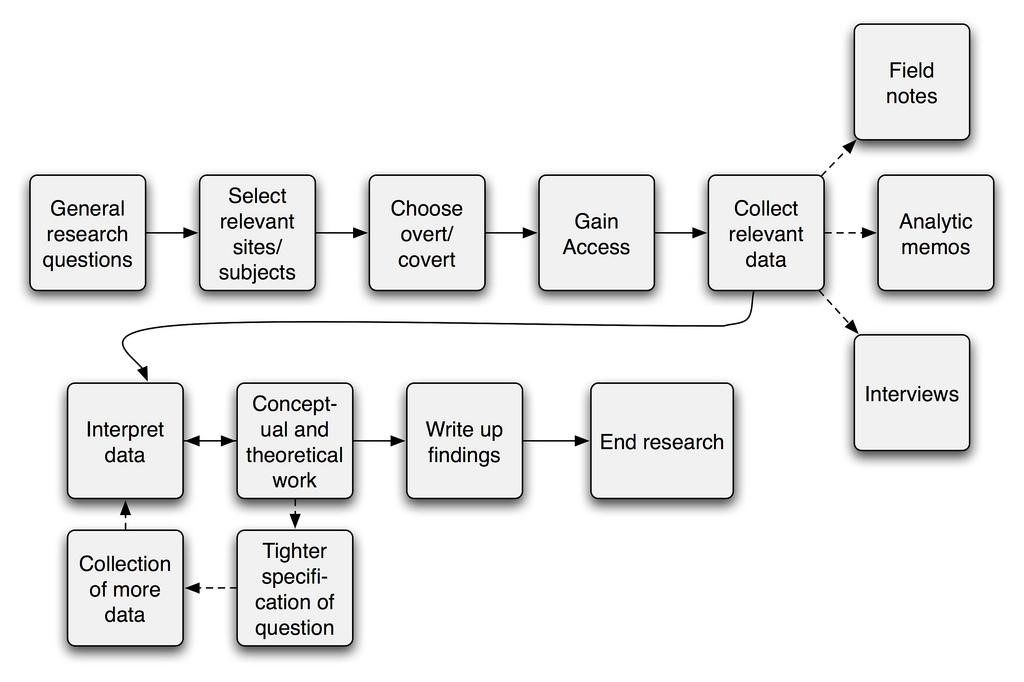
Phenomenology focuses on the individual and is directed to examine a person’s narrative to capture their perceptions and lived experiences. The researcher is often thought of as an “indirect” participant due to the coding and interpretation processes involved because the goal is to expose these perceptions and experiences as unfiltered as possible. In other words, there is an attempt to set aside any preconceived assumptions about a person’s feelings, thoughts, or responses to a particular issue. Across multiple participants, common themes may emerge, but often the real insights occur from the variability and range of lived experiences within a shared context. For example, a researcher may find a theme of “to feel better” when investigating reasons for youth drug use.
Grounded theory focuses on using unstructured interviews to formulate theory that emerges from the data. The general aim is to compare and code data when interviewing participants so that an updating of what “explains” the data emerges and eventually stabilizes. When no new set of ideas or theory emerges, data collection can be halted. Guidelines would suggest 10 to 25 in-depth interviews for coding. The most important perspective of grounded theory is that the data speaks for itself, and the researcher constructs theory from the interviews and without imposing their theories on the participants. This method has been most helpful in uncovering social processes, which are social relationships and behaviors of individuals in groups.
Content analysis includes an array of techniques for investigating material which may be text, photographs, video, audio, etc. The objective is to use a replicable, standardized process that reveals meaningful insights and patterns. Content analysis is can involve text analysis where computer algorithms manipulate text to extract structured information that may be interpreted. An example of content analysis is PhotoVoice. This is a participatory, qualitative research method where individuals tell “their story” through photographs as indicated in Case Study 6.2.
Case Study 6.2
Content Analysis with a Participatory Process
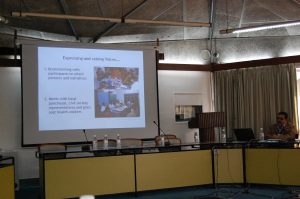
PhotoVoice based research in Hawaii involved participants who were residents of Housing First (see Chapter One). Individuals took photographs and/or aided in interpretation as to their experiences in homelessness and Housing First. Fourteen major themes were developed after a participatory process of coding and summarizing findings. These included opportunity to rest, privacy, opportunity to reconnect socially, and improved mental health (greater hope, self-efficacy, and self-esteem). These findings were useful to researchers exploring different types of housing models for homelessness (Pruitt et al., 2018).

Quantitative methods involve being able to count or “quantify” something. Of course, you have to be able to define the “something” but quantitative methods can help with that as well. Even the simplest of quantitative studies can have great value—for example, having a population list their top ten problems and rank them may provide greater insight than having an outside researcher come in and survey the population on a researcher-priority problem.
The case study below is an example of this type of quantitative research, using what is called a randomized design where some individuals are provided the intervention and some are not, and then both groups are followed over time.
Case Study 6.3
A Quantitative Evaluation of a Home Visitation Program

A home visitation program was developed for at-risk low-income first-time pregnant women. Participants were randomly assigned to one of two groups. The first group received services such as transportation to prenatal care, routine child development screening, and referrals. In the experimental group, participants received the same services and, in addition, nurses conducted home visits during the prenatal period through early childhood. A 15-year follow-up study showed that the outcomes of the home visit group were fewer unwanted pregnancies, less use of welfare, and reduced child abuse and neglect. Additionally, the children showed fewer instances of running away from home and fewer sexual partners, as well as reduced alcohol consumption and criminal behavior (Olds et al., 1998).
The purpose of the research greatly determines the design and methods used in quantitative studies. Some common design decisions involve whether the research is:
The quantitative evaluation of interventions can encompass many methods and designs from a cross-sectional comparison post-intervention with a control group to pre-test and post-test studies with and without controls. The choice of these designs and methods is often limited by practical constraints (e.g., no access to a control group). A large effect size in a weaker design may be more convincing than a weak signal in a more sophisticated design.

Research in Community Psychology encompasses a broad range of real-world, ecological contexts, and mixed methods research uses both qualitative and quantitative methods to capture this scope within the same study or project. In essence, there are many important strategies provided by both qualitative and quantitative research in helping us better understand the transactions between persons and community-based structures. Mixed methods provide ways to stay true to Community Psychology’s values by helping to amplify the voices within the lives of unheard and historically silenced communities. This type of research can increase validity because data are collected simultaneously on the same individuals and settings using independent methods of data collection and analysis. This method can help us better understand the complexity of the multiple levels of analysis, including individuals, families, groups, neighborhoods, communities, and cultures, as indicated in the following case study.
Case Study 6.4
A Mixed Methods Approach to Institutional Change
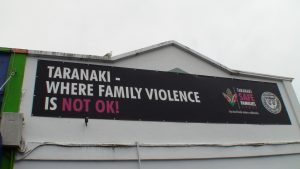
Allen, Walden, Dworkin, and Javdani (2016) combined qualitative approaches with quantitative ones to enrich our understanding of a statewide network of family violence coordinating councils. Throughout the inquiry process, these authors used qualitative and quantitative methods. The methods were used in a sequential way so that one data collection method informed the next in terms of analysis and understanding of the data. For example, these community psychologists started by examining years of archival data, which then allowed them to better understand how the violence coordinating councils were associated with access to orders of protection across sites. This archival qualitative data allowed the investigators to better understand how the councils achieved positive outcomes. They then collected current data from councils, and this quantitative data showed a high degree of leader effectiveness. Qualitative interviews they conducted allowed them to better understand the roles of other council members not in the convener role. This helped them to better understand all the roles involved in building council capacity for institutionalized change efforts.
This innovative way of collecting data allows community psychologists to see research as a dynamic process, which helps uncover the texture and inner workings of how groups try to bring about important changes to their communities.

Several other methods that are becoming increasingly useful as tools have evolved to include meta-analysis, which is a method for statistically summarizing the findings of multiple studies to quantify an average effect and identify possible predictors of variability of outcomes. A meta-analysis of primary prevention, mental health programs for children and adolescents, found that very few programs reported negative results (Durlak, & Wells, 1997). This research incorporated 177 studies and the findings provided strong evidence that prevention is beneficial for fostering the mental health of children. Another meta-analysis of youth mentoring programs suggested that evidence and theory-based programs did better (DuBois, Holloway, et. al., 2002). Overall, meta-analysis is a powerful technique to understand what past research offers as evidence. In the mentoring arena, many of these summary studies have been listed in the Chronicle for Evidence-Based Mentoring, which is a website developed by community psychologist Jean Rhodes.
Practical Application 6.1
The Chronicle
The Chronicle of Evidence Based Mentoring translates research into practice recommendations and is an important forum for researchers, practitioners, policy-makers, and volunteers. Since its launch, the Chronicle has attracted over a million views from its tens of thousands of monthly visitors and nearly 8,000 subscribers. The site features an impressive editorial board and an ever-changing array of research summaries, profiles, etc.
Geographical information systems (GIS) is a method that can be useful in identifying and measuring visual influences on a map. For example, the presence of “food deserts” (i.e., areas without access to affordable, quality food) among neighborhoods can be both visually and quantitatively understood by using mapping with analytic capabilities. The presence or absence can then be modeled with other neighborhood and demographic characteristics to better understand possible remedial policy or action. For example, Chilenski (2011) found that closeness to alcohol and tobacco retailers was a significant predictor of adolescent problem behaviors.
Social network studies provide insight on how relationships may influence attitudes and behaviors. Let’s assume Joey ends up primarily socializing with a group where most members use alcohol. We then learn that Joey begins using alcohol. Did the group influence Joey to begin using alcohol or did Joey join the group to be able to drink with others and not be negatively judged? This question of why youth take on risky behaviors is important to know for the development of interventions and policy. Below is a very practical use of social network analysis in school settings.
Case Study 6.5
A Social Network Analysis of a School-Based Intervention

Social network analysis was used with a school-based intervention focusing on improving the academic, behavioral, and social success of elementary school African American and Latino boys. The intervention included mentoring, family involvement activities, and after-school programming. The elementary school classroom teachers were supported by one or two “lead teachers,” who were meant to provide support and help with teaching strategies to improve student achievement. Social network analysis was used to help understand the teachers’ existing advice networks for spreading intervention strategies and helping document the lead teachers’ abilities to influence their colleagues. This method allowed the community psychologists to understand how the structure of teacher advice networks could either facilitate or hinder the spread of successful classroom intervention practices (Kornbluh, & Neal, 2016).

Community psychologists feel that effective research can utilize a multitude of designs and methods (Jason, & Glenwick, 2012). One possible framework for conceptualizing methods maps the relationship between the degree of structure and the purpose of the research. The most tightly controlled experiments are focused on testing an intervention’s effect. While unstructured investigations are unlikely to lead to definite conclusions, they are, instead, an exploration of how things operate in the world. Figure 4 below portrays this arrangement.
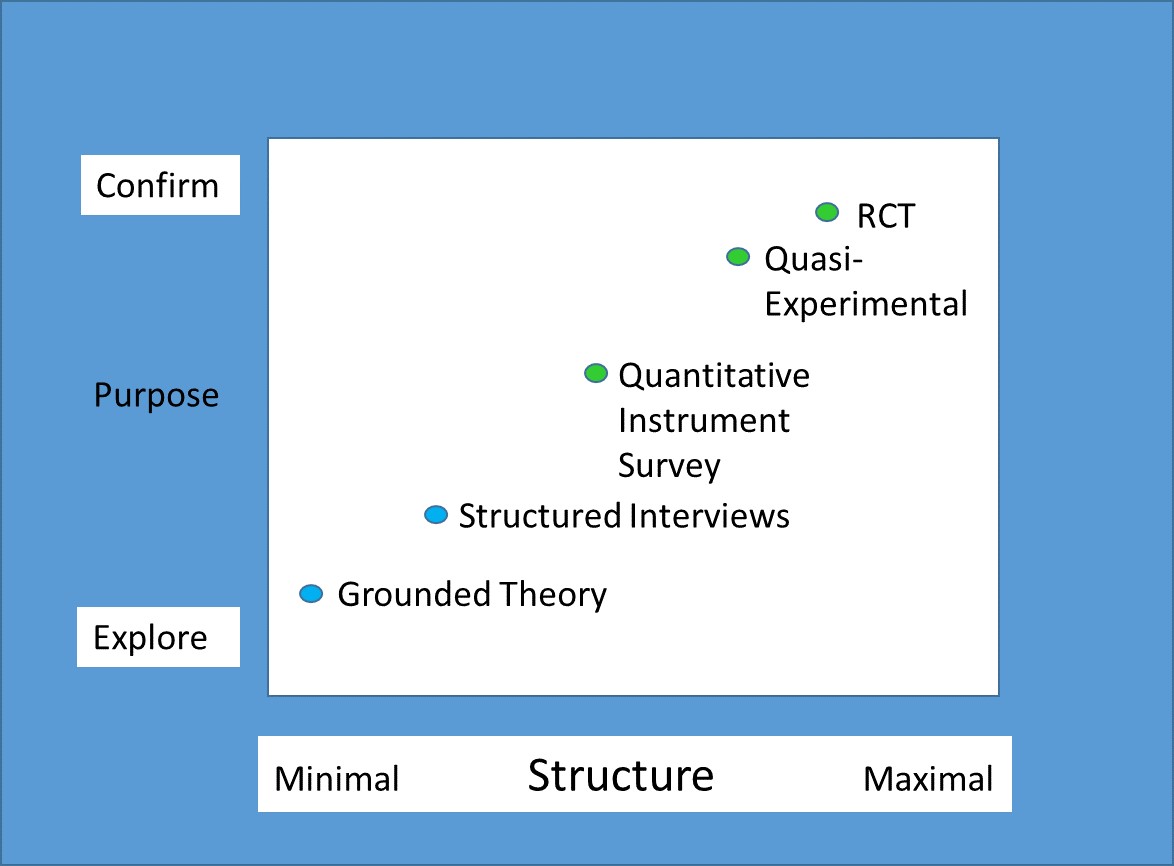
Research is a powerful tool that helps us better define phenomena, measure it, make predictions about it, develop theories to explain it and put our knowledge to use for the betterment of our world. Community psychologists are trained to use research to understand what might be accounting for certain community problems like homelessness, as well as to evaluate whether particular interventions are effective. The ecological framework allows community psychologists to broaden the evaluation to include how the intervention affected a community’s commitment, openness, and readiness for change.
Community psychologists might have similar goals as community organizers, but their training in research and their ecological perspective provide them unique contributions to bringing about social justice. Ethics and research are interconnected—as good research should ethically generate evidence and evidence should guide ethical action. Clearly, the commitment of community psychologists is always “first do no harm” and that ineffective and resource wasteful action should be stopped. There are a variety of ecological research methods that can help point the way to bringing about social justice and more equitable distribution of resources.
Critical Thought Questions
Take the Chapter 6 Quiz
View the Chapter 6 Lecture Slides
_____________________________________________________________________
Allen, N. E., Walden, A. L., Dworkin, E. R., & Javdani, S. (2016). Mixed methodology in multilevel, multisetting inquiry. In L. A. Jason & D. S. Glenwick (Eds.), Handbook of Methodological Approaches to Community-Based Research: Qualitative, Quantitative, and Mixed Methods. (pp. 335-343). New York: Oxford University Press.
American Psychological Association (2003). Ethical Principles of Psychologists and Code of Conduct. Retrieved from https://www.apa.org/ethics/code
Chilenski S. M. (2011). From the macro to the micro: A geographic examination of the community context and early adolescent problem behaviors. American Journal of Community Psychology, 48(3-4), 352-64.
Dalton, J. & Wolfe, S. M. (2012). Joint column: Education Connection and The Community Practitioner. Competencies for community psychology practice. The Community Psychologist, 45(4), 8-14.
DuBois, D. L., Holloway, B. E., Valentine, J. C., & Cooper, H. (2002). Effectiveness of mentoring programs for youth: A meta-analytic review. American Journal of Community Psychology, 30, 157–197.
Durlak, J. A., & Wells, A. M. (1997). Primary prevention mental health programs for children and adolescents: A meta‐analytic review. American Journal of Community Psychology, 25, 115-152.
Haber, M. G., Neal, Z., Christens, B., Faust, V., Jackson, L., Wood, L. K., Scott, T. B., & Legler, R. (2017). The 2016 survey of graduate programs in Community Psychology: Findings on competencies in research and practice and challenges of training programs. The Community Psychologist, 50(2), 12-20.
Jason, L. A., & Glenwick, D. S. (Eds.). (2012). Methodological approaches to community-based research. Washington, DC: American Psychological Association.
Jason, L. A., Glantsman, O., O’Brien, J. F., & Ramian, K. N. (2019). Introduction to the field of Community Psychology. In L. A. Jason, O. Glantsman, J. F. O’Brien, & K. N. Ramian (Eds.), Introduction to Community Psychology: Becoming an agent of change. Retrieved from https://press.rebus.community/introductiontocommunitypsychology/chapter/intro-to-community-psychology/
Kornbluh, M., & Neal, J. W. (2016). Social network analysis. In L. A. Jason & D. S. Glenwick (Eds.), Handbook of methodological approaches to community-based research: Qualitative, quantitative, and mixed methods. (pp. 207-217). New York: Oxford University Press.
Olds, D., Pettitt, L. M., Robinson, J., Henderson Jr., C., Eckenrode, J., Kitzman, H., … Powers, J. (1998). Reducing risks for antisocial behavior with a program of prenatal and early childhood home visitation. Journal of Community Psychology, 26, 65-83.
Pruitt, A. S., Barile, J. P., Ogawa, T. Y., Peralta, N., Bugg, R., Lau, J., Lamberton, T., Hall, C., & Mori, V. (2018). Housing First and Photovoice: Transforming lives, communities, and systems. American Journal of Community Psychology, 61,104-117
Society for Community Research and Action (2019). Principles. Retrieved from http://www.scra27.org/who-we-are/
Smoking and Health (1964). US Surgeon General’s Report of the Advisory Committee to the Surgeon General of the Public Health Service. US Department of Health, Education, and Welfare. Washington, DC: US Government Printing Office.
The Belmont Report (1978). National Commission for the Protection of Human Subjects of Biomedical and Behavioral Research. Department of Health, Education and Welfare. Washington, DC: United States Government Printing Office.
West, S. L., & O’Neal, K. K. (2004). Project D.A.R.E. outcome effectiveness revisited. American Journal of Public Health, 94(6), 1027-1029.
Wolfe, S. M. (2019). Practice Competencies. In L. A. Jason, O. Glantsman, J. F. O’Brien, & K. N. Ramian (Eds.), Introduction to Community Psychology: Becoming an agent of change. Retrieved from https://press.rebus.community/introductiontocommunitypsychology/chapter/practice-competencies/
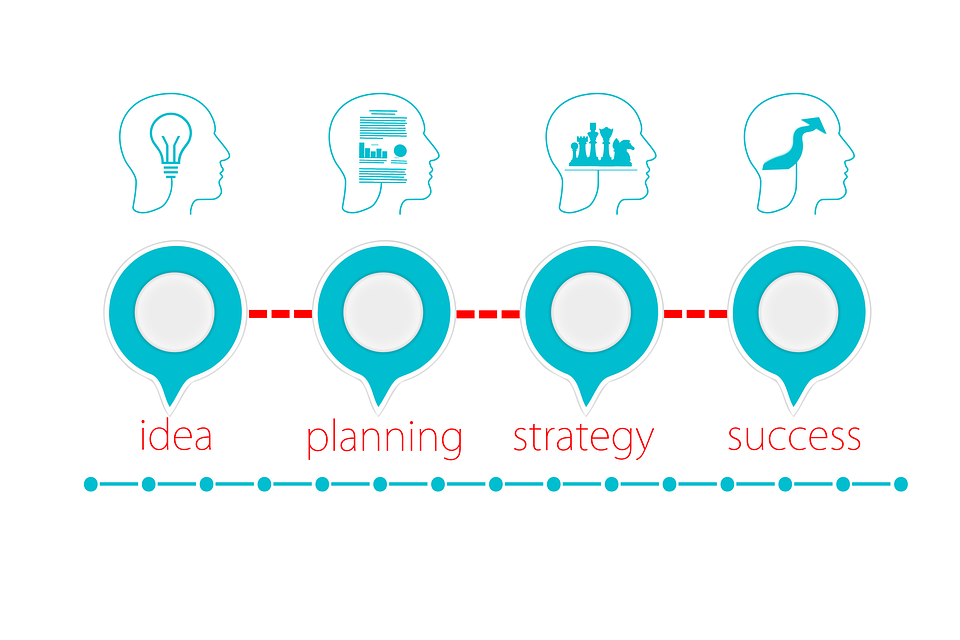
Chapter Seven Objectives
By the end of this chapter you will be able to:

Every job requires a specific set of skills and knowledge, and Community Psychology is no different. In this chapter, you will find a set of knowledge and skills that a Community Psychology practitioner needs. It starts by describing what “practice competency” means and why it is important. After presenting a brief overview of where the competencies came from and the levels of competence, the chapter will provide information about what each competency means, case examples of the competencies being used, how someone can become competent, resources related to each competency, and some self-reflection and critical thinking questions.
Case Study 7.1
A Community Psychology Consultant and Her Competencies

A Community Psychology consultant just received a contract to build collaboratives to promote well-being in five rural communities. In this role, she will provide guidance and technical assistance to help the coalitions recruit historically excluded community residents, conduct a needs assessment, and use the results to develop a plan for systems-level change. When she visits these communities, she discovers that some coalitions have formed without including the historically excluded residents; three of the counties have no idea where to begin, two counties have long histories of racism and segregation, and all the counties are resource-poor in terms of health, mental health, housing, employment, transportation, and many other basic needs. The Community Psychology consultant realizes that she is going to need all the knowledge and skills she developed throughout her training and employment experiences. As you read through this chapter, reflect upon each competency and think about how it could be applied for the Community Psychology consultant’s work with these collaboratives.

You might be wondering, what does “practice competency” mean? The Community Psychology practice competencies were developed to provide a common framework to describe the skills involved in Community Psychology practice (Dalton & Wolfe, 2012). It means that someone who is a Community Psychology practitioner has mastered some or all these skills and knowledge to some extent. Community Psychology practice competency means that the community psychologist has mastered enough of the skills to implement their work in real life situations dealing with individuals and communities in need.
Why “practice competencies” and why is this important to the work that we do? When students are deciding on their careers and what to study in college or graduate school, they usually focus on the type of work they would like to do first. The next step is to find out what degree will give them the skills needed for the work they want to do. The Community Psychology practice competencies accurately reflect the set of skills students can obtain if they get a degree in this field. Another reason having a list of competencies is important is that graduates of Community Psychology programs can easily describe their skills to potential employers. Alternately, potential employers who have job openings that require these skills will know that they need to look for in someone who is trained in Community Psychology. A common vocabulary amongst practitioners, communities, and employers will help everyone to know what to expect when working with community psychologists (Neigher & Ratcliffe, 2010).
Where did these practice competencies come from? The competencies were created collaboratively by a task group made up of members of the Society for Community Research and Action’s (SCRA) Community Psychology Practice Council and Council of Education programs. They began the work in 2010 and after many iterations and reviews, the list of competencies was approved by the SCRA's Executive Committee in 2012.
What levels of competence are there? As with any field of study, an individual can develop any of the Community Psychology practice competencies to a different level of mastery. The first level is “exposure” which means that they have learned about the competencies and how it can be applied in practice. At the next level, “experience,” the community psychologist has actually used the competencies in supervised practice, or practice on their own, to perform the tasks related to the competency. “Expertise” means the community psychologist has had several experiences with applying the competencies in work and developed a high level of skill.
To whom do these competencies apply? While many of these competencies apply to community psychologists all over the world, this particular set of competencies in their entirety apply primarily to community psychologists practicing in the US. Community psychologists in other countries sometimes need different skills in their work because of cultural, economic, legal, political, or other differences.

The foundational principles are the five competencies that all Community Psychology practitioners working in the US need, listed in Table 1 below. They represent knowledge, skills, and principles that help to guide practice work from a Community Psychology perspective, as well as the values and perspectives of Community Psychology and the competencies needed to apply the values in practice, as also indicated in the first chapter (Jason, Glantsman, O’Brien, & Ramian, 2019). These competencies are combined with the remaining more technical skills-based competencies to ensure they are exercised using a Community Psychology approach. Elias, Neigher, and Johnson-Hakim (2015) suggest that you think of them as “foreground” processes because Community Psychology practitioners need to pay constant attention to these principles and make sure that their actions align with them.

For example, in our case study, the Community Psychology practitioner will need to work with communities to develop their coalitions. There are many coalitions in place across most communities in the US, but when the Community Psychology practitioner works with the communities to develop their coalitions, they will be sure they include community members and develop structures that empower the historically excluded populations to lead the coalitions and determine the actions to be taken on their own behalf. This contrasts with coalitions that typically include professionals who make decisions and take action from outside the community.
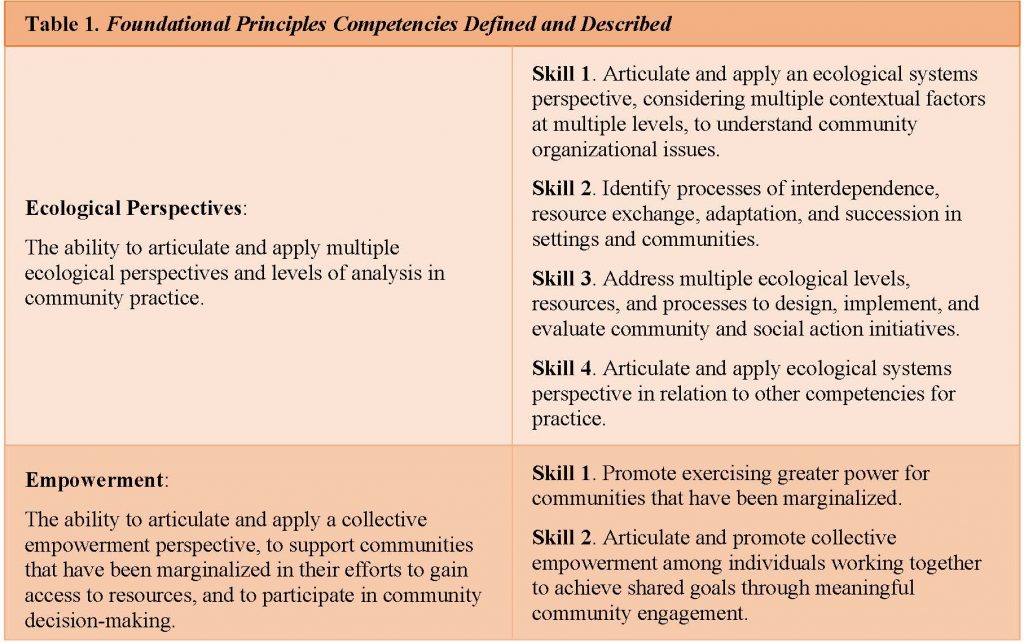
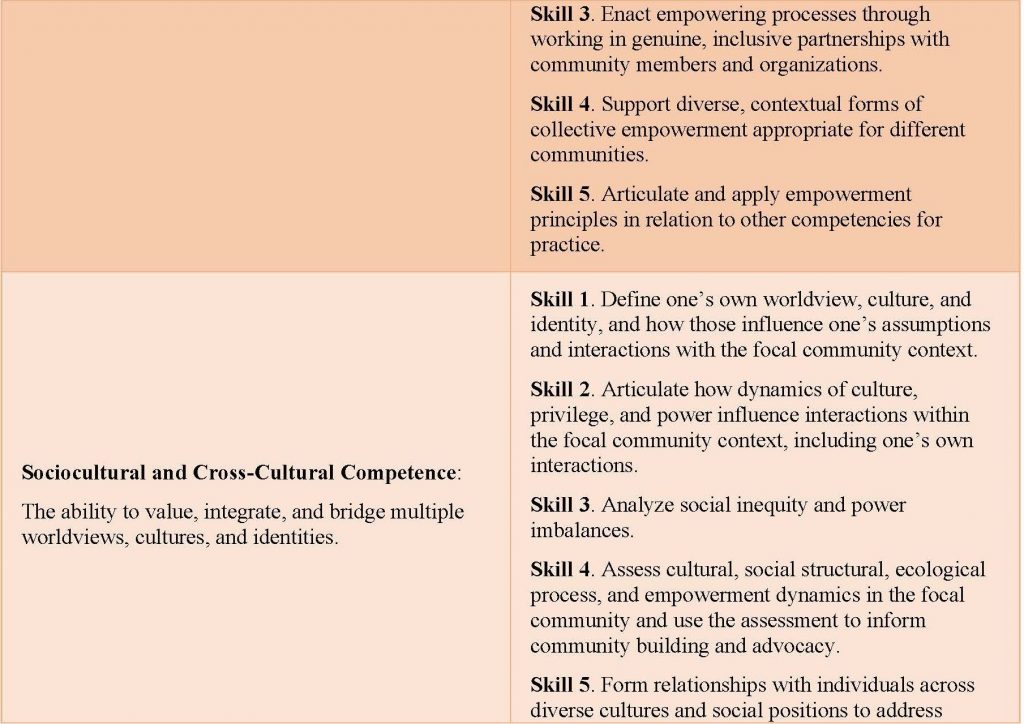
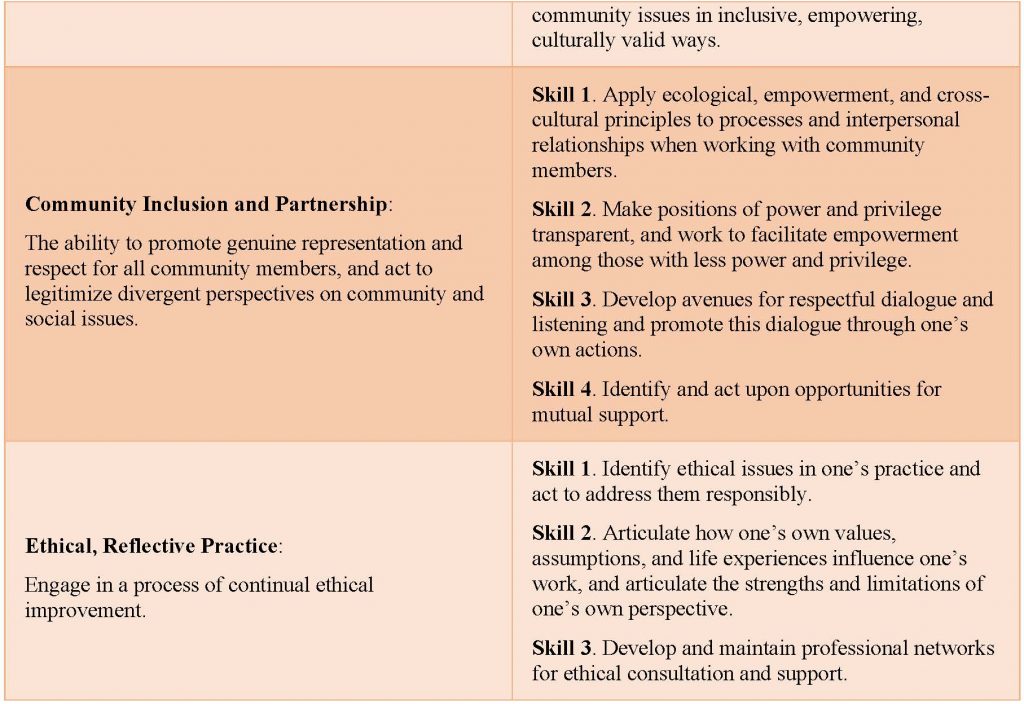

This set of two competencies include a large skill set whereby Community Psychology practitioners can partner with community stakeholders from start to finish to develop and implement programs in their communities to meet identified needs, to prevent problems, and to promote health (See Table 2). The case study at the beginning of this chapter mentions that the communities are resource poor. If the collaborative decides they need to create after-school programs for youth, then the Community Psychology consultant may use the particular skills connected with community program development and management to help them with program design and implementation.
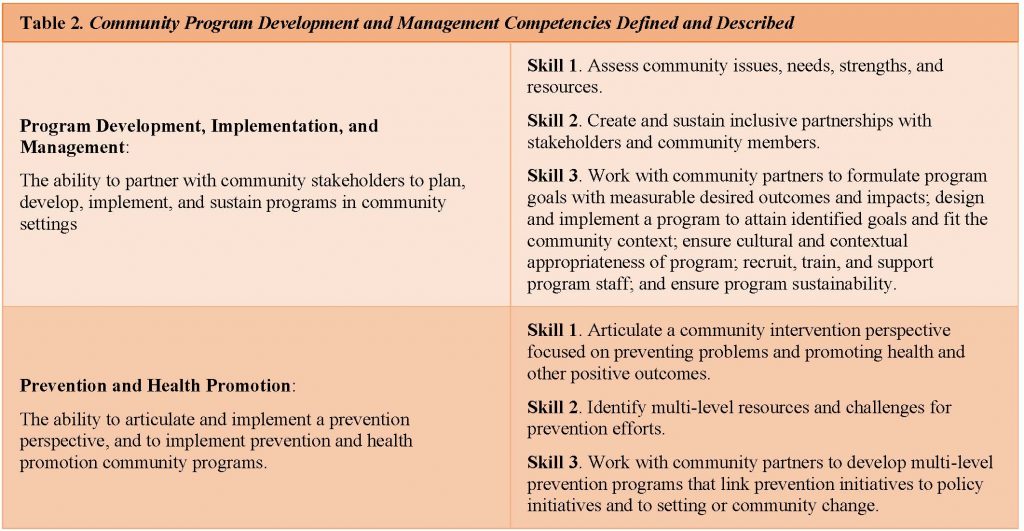

One hallmark of Community Psychology practice is that instead of going into communities and acting on their behalf, Community Psychology practitioners work to strengthen communities so they can act on their own behalf. This requires a strong, trusting relationship between the community psychologist and the various stakeholders, such as community partners, advocates, members of the target population, treatment providers, and governmental entities (Elias, Neigher, & Johnson-Hakim, 2015). If Community Psychology practitioners are successful in their work, communities they work in should eventually not need their help at all. The goal is to create change which is then adopted by the community and managed by the community members to the point where they sustain it over time. This is really important for working in disadvantaged communities that have been traditionally disempowered. By giving away our skills and knowledge, we empower them to make the changes their communities need and reduce their reliance on outside professionals. These four competencies are designed to help us do that (See Table 3). When the Community Psychology consultant in our first case study goes into the communities to work with them to build their collaboratives, she will not do any of the work for them. She will provide training and technical assistance to strengthen the skills and capacity of the community members to build and maintain their collaborative.
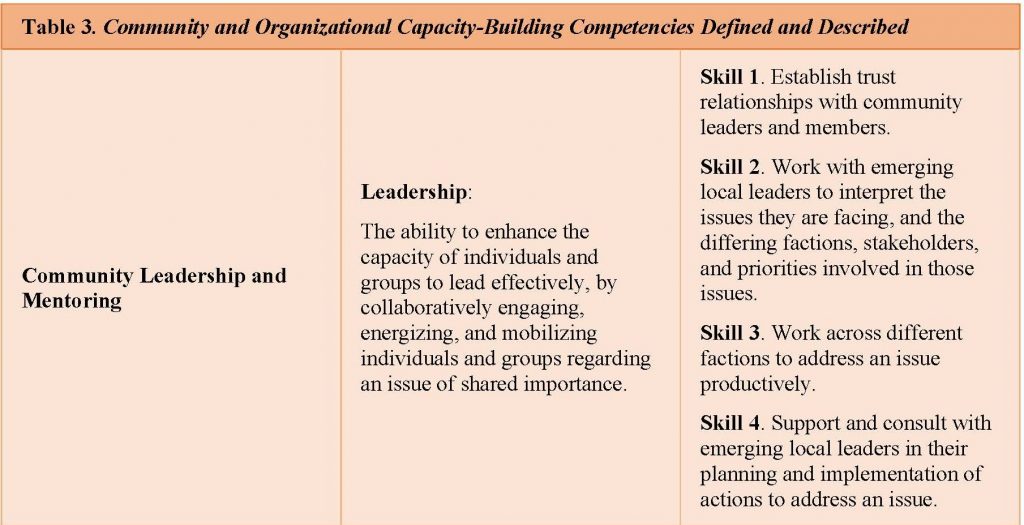
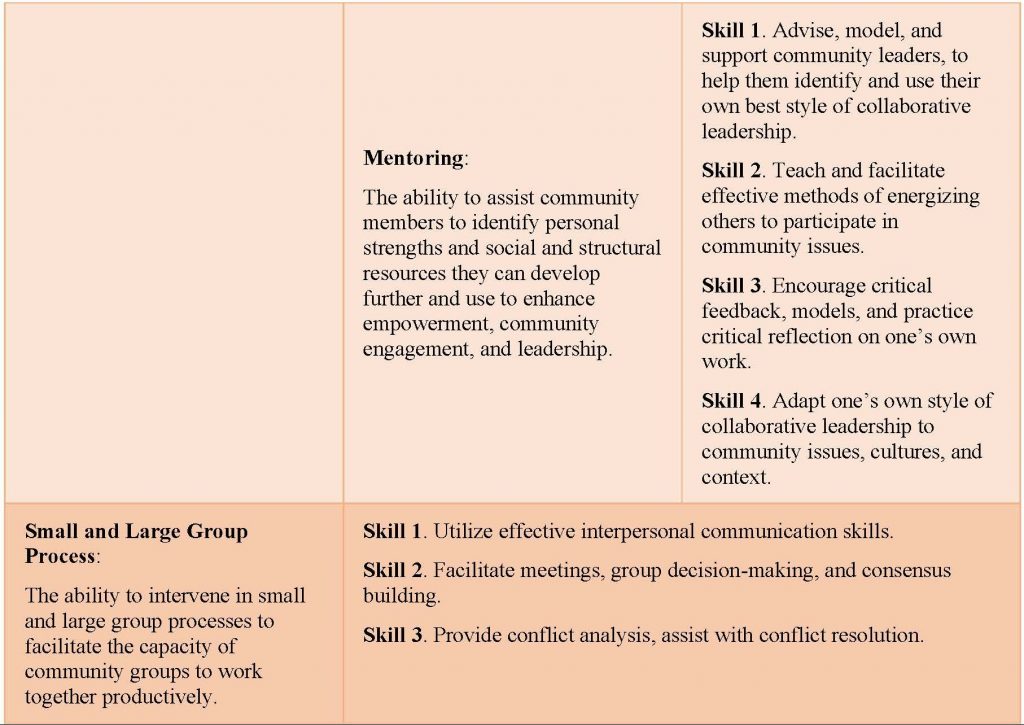
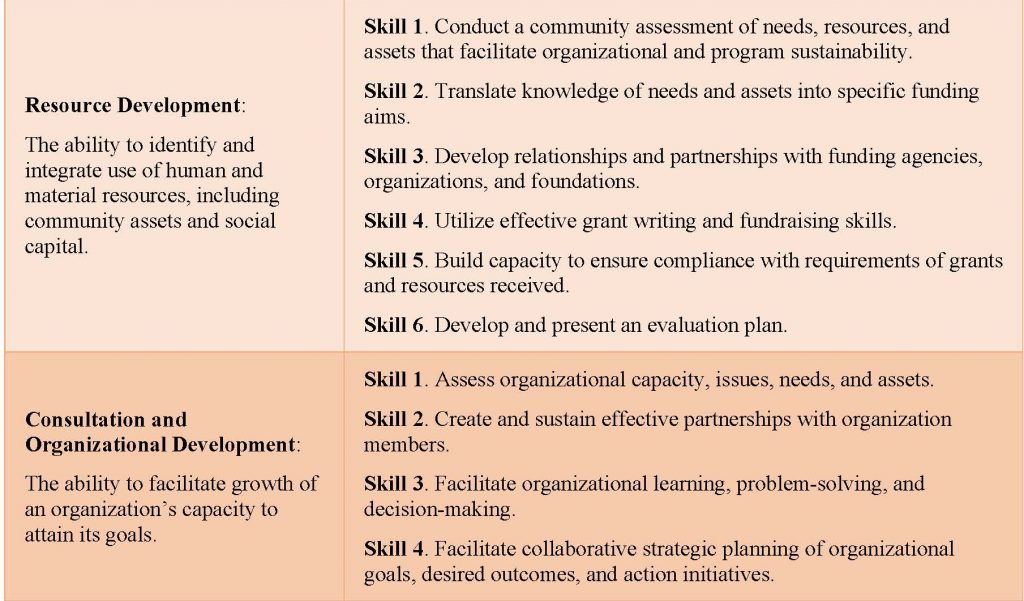
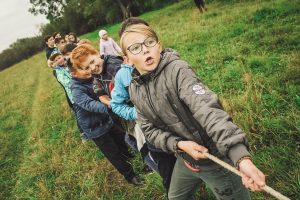
Typically, when there is a problem in a community, we address it by creating another program to help solve some of the issues that have arisen. For example, in one community the response to childhood obesity was to teach children and parents how to improve their diet and exercise. Nobody would dispute that this is helpful information for all people to have. That said, what happens when parents want to fix healthy meals for their children, but they don’t have access to the food they need to make them? Or, what if they don’t have a car and there is no grocery store in their neighborhood? And what if a family can’t get out to walk or ride bicycles or get exercise of some kind because they live in a neighborhood where there are no sidewalks to walk on, or it isn’t safe because of high crime? Many of our social problems cannot be fixed by working to change people’s behavior, especially if they live or work in environments that won’t support their behavior changes. We need to have the skills to change systems, policies, and the environments in which people live. This set of five competencies provides Community Psychology practitioners with the skills to make these changes to create second-order change processes that focus on ways to rearrange current relationships, roles, and power dynamics within a setting (See Table 4). The goal is to establish a more just, inclusive, and health-promoting environment (Elias, Neigher, & Johnson-Hakim, 2015). The Community Psychology consultant in the Case Study 7.1 will need these skills to help the collaboratives build their own skills to change systems, and not just focus on creating programs.
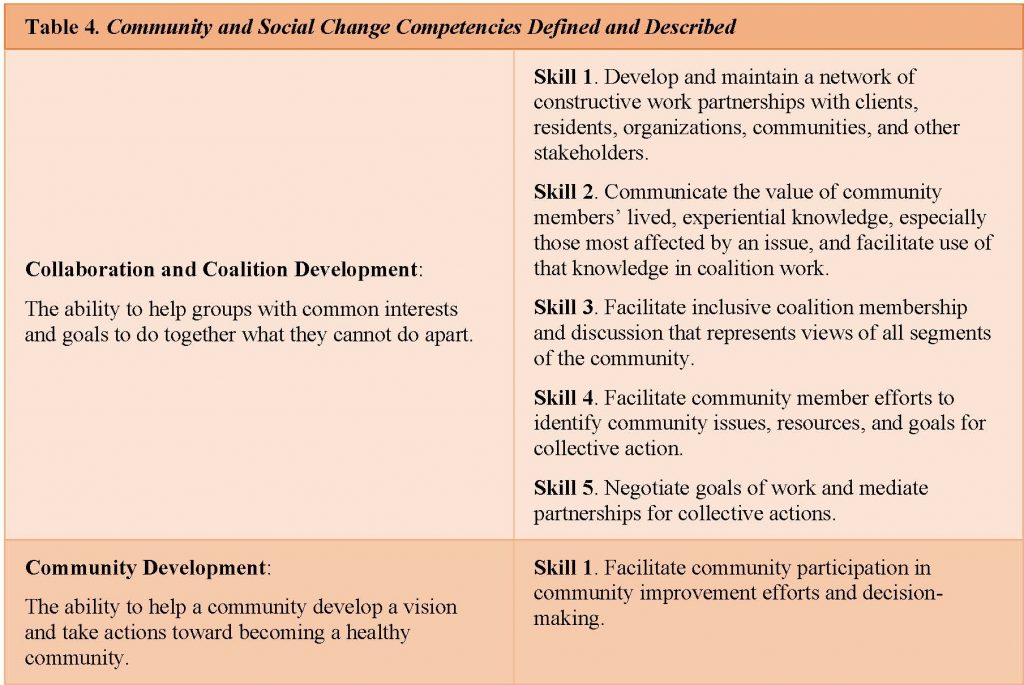
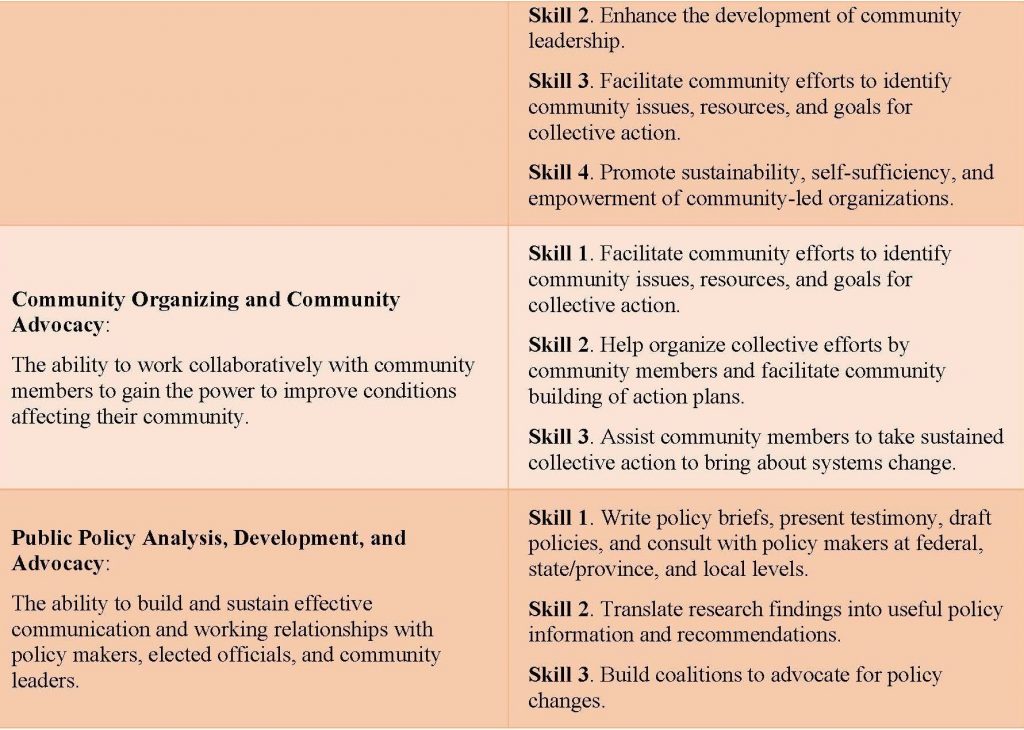
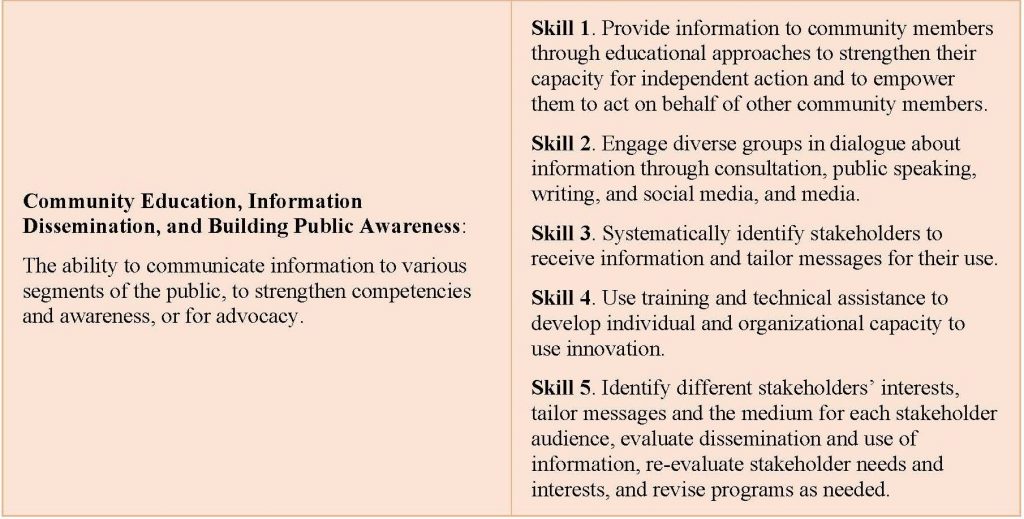
Case Study 7.2
The Community Driven Development of The Gateway
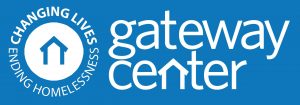
There is much one can do with Community Psychology practice competencies focusing on community and social change, even outside the field itself. Debi Starnes has served in elected positions in the local government of Atlanta, Georgia and has also held key policy advisory roles over the course of her career (Scott, & Wolfe, 2015). Dually trained in both clinical psychology and community/organizing psychology, Debi was actively involved in various leadership roles in her community. She understood the importance of being an active member of her community regardless of her education. In fact, she said, “I didn’t get elected because I was a community psychologist, but being a community psychologist helped enormously in my perspective and how I approached different issues and tasks,” when serving as an elected official. During her 11-year career as a city council member, Debi was able to develop a Homeless Action Group, which brought together a wide variety of community members and groups to talk about and address issues facing people experiencing homelessness. Debi used her skills and was able to practice community and organizational capacity-building while enacting community and social change in a different role than a practitioner. Due to her efforts, the city developed The Gateway, a central intake and assessment facility that provided vital housing and services for people experiencing homelessness. This successful program required collaboration between city officials, business leaders, treatment providers, law enforcement, and community members. Debi was able to use her training and expertise, as well as her dedication to community service, to bring these groups together and enact social change. Find out more about The Gateway program.
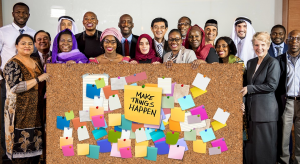
These last two competencies allow Community Psychology practitioners to learn about the communities they work with, and to determine whether what they have done has made a difference. Unlike more traditional research, community psychologists do research and evaluate programs with community members rather than on or about them. They use their scientific set of skills to collect and analyze data to help communities answer their questions, evaluate what they are doing, and use research to plan, learn, and make decisions. The community consultant will need research and evaluation skills to help communities to conduct needs assessments and gather data to use for planning and to evaluate the outcomes of their initiatives.
There are so many advantages when community psychologists collaborate with community members and organizations. These types of collaborations can provide mutual benefits to the investigators as well as the community members, and help get the word out regarding new innovative ways of delivering services. The following Case Study 7.3 provides some glimpses of interactions that occurred during a 25-year collaborative relationship between a DePaul University group and the Oxford House recovery organization. By having members of the recovery community guide the types of questions that were asked, the research helped capture more crucial aspects of the changes that were occurring among residents.
Case Study 7.3
Community Partners Identifying Areas for Research
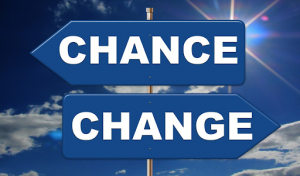
During one of the annual Oxford House conventions, an individual living in one of these homes approached Leonard Jason, one of the DePaul University investigators and suggested that measures of tolerance be included in this collaborative research. He explained that prior to living in an Oxford House, he had been very prejudiced against people who were different from him, such as people who were HIV positive. But while in Oxford House, he met a woman who was HIV positive; she was now his girlfriend. He wanted to point out that, for him, living in Oxford House went beyond staying clean and sober—it made him a more accepting and generous person. That participatory input led to a series of mixed methods investigations, which allowed both the community members and university researchers to better understand the rich experiences and outcomes of residents living in these recovery houses. For example, in one randomized study, with individuals being assigned to an Oxford House or usual aftercare condition, over time, those assigned to the Oxford House condition demonstrated significantly greater values of tolerance than usual aftercare participants. These changes occurred due to living in a recovery setting where members could share time with one another, exchange life stories, discuss their prior drug use, talk about personal and group goals, enjoying eating and attending 12-step meetings, and participating in a variety of non-substance use social outings. With this type of involvement, it is likely that a sense of cohesion developed which led to increases in tolerance (Olson, & Jason, 2015).
This type of collaborative research led to the non-profit being endorsed by the federal government as the current “gold standard” for residential aftercare. Receiving this recognition from the federal government helped this community organization expand to now serving over 20,000 individuals in recovery.
An important element of community research and action in practice is the dissemination of successful interventions that have benefited communities (Scott, & Wolfe, 2015). Dissemination is a strategic, systematic sharing of information about an intervention or research to individuals and groups who can use this information to help the people they work with. The goals are to influence policy and change community psychologists’ methods in an area of practice so it is of greater benefit to the populations they are working with. An even more concentrated form of dissemination is implementation, or “the use of strategies to adopt and integrate evidence-based health interventions and change practice patterns in specific settings” (Chamber, 2009; as cited in Scott, & Wolfe, 2015). A focus on implementation leads to innovative interventions that are more effective for the groups they are meant to help. This allows the practice to advance as a whole and creates an open dialogue among practitioners to collaborate on solutions and share their work.
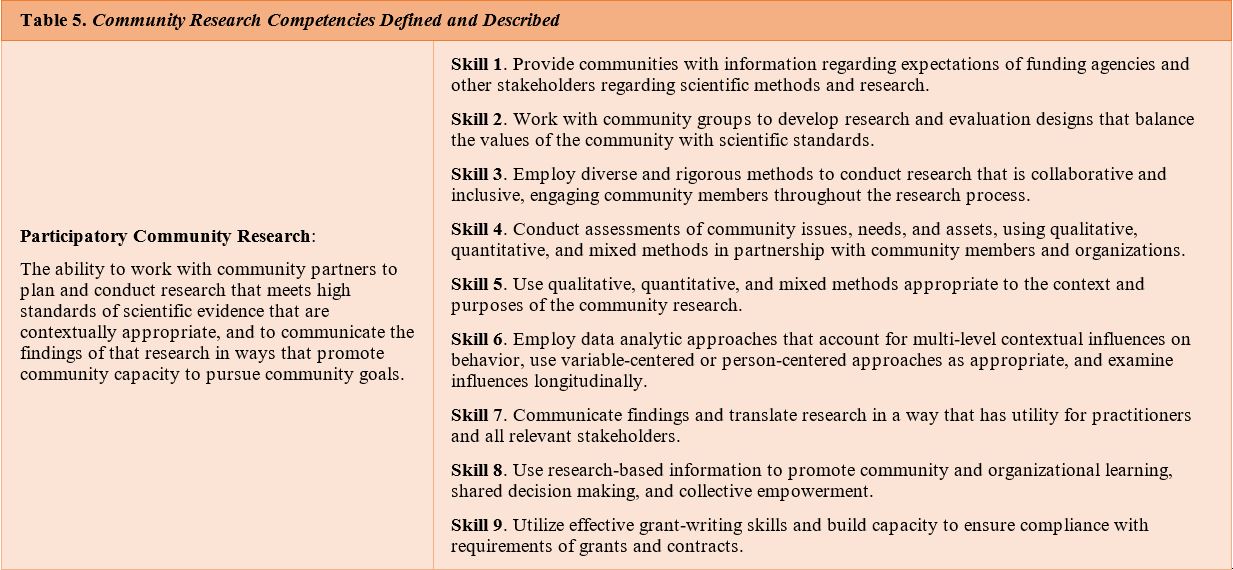

But why should community psychologists in practice share what they find with each other? Well, this is because practitioners have to keep sustainability in mind as they are developing and implementing programs. This is especially true if a program is a success because the goal is to change best practices and policies so that the methods can be used to help more people and be spread to other locations. Focusing on sustainability can ensure that an effective program, intervention, or research finding is preserved and continues to affect practice and public policy, even after the practitioner has started working on something else. If a practitioner does not account for sustainability, it can lead to the old adage of “history repeating itself,” as their intervention and findings are ignored and lost over time.
The case study below will highlight the importance of sharing the methodology with peers in the field with a focus on dissemination and sustainability.
Case Study 7.4
The Fairweather Lodge and a Successful Dissemination
An instructive example showcasing dissemination and sustainability is the work of Bill Fairweather and his colleagues. Fairweather’s seminal work was a 25-year examination and experimentation of group problem solving with people with mental disorders living in inpatient hospital facilities (Scott, & Wolfe, 2015). Fairweather wanted to understand, through experimentation, how to give people in these institutional settings some semblance of freedom in the real world. Fairweather and his colleagues understood the importance of empowerment and community integration, and recognized that this vulnerable, institutionalized group could benefit greatly from community-based living. His team spent an additional 10 years implementing a community living setting for these patients, with both work and social opportunities, called the Community Lodge. The lodge was very successful in giving patients economic, social, and interpersonal opportunities and vastly improved their quality of life. Their findings were successfully disseminated to other practitioners focusing on people with mental illness, and this led to many other works involving the importance of community living in improving people’s lives.
Take a moment to think about how long it took to create this successful program for people with mental illness in hospital settings: it took 35 years total to fully understand the problem, evaluate solutions, and implement it successfully through intervention. That is quite an investment on the part of Fairweather and his colleagues, and yet they knew the importance of creating an intervention grounded in an empirical understanding of the issue and potential solutions. They wanted to make sure that their program would be effective, and they took the time to learn as much as they could before trying their lodge idea out. And they made sure to study the most effective dissemination methods to make sure their results were spread and reached a wide audience.

The first way to learn the competencies discussed is to study Community Psychology, especially at the graduate level. As an undergraduate, there is a good chance that you have never heard of Community Psychology, as Bauer, Glantsman, Hochberg, Turner, and Jason (2017) found that most introductory psychology textbooks contain no reference to this field (but there are now ongoing efforts to change this). Many universities offer Master’s level programs that train students in these competencies, or you can pursue a Ph.D. for more in-depth education. Not all Community Psychology graduate programs teach all of the competencies, so someone considering graduate education in Community Psychology should first decide what kind of work they are interested in doing, and then find a graduate program that focuses on the competencies they will need. All Community Psychology graduate programs focus on the foundational principles, but for other competencies, a prospective community psychologist should explore programs. For example, some graduate programs focus more on community research competencies, and others on community and organizational capacity-building.
However, there are some universities that offer an undergraduate psychology degree with an emphasis on Community Psychology. These undergraduate programs are an excellent means of learning more about the field and getting the relevant experiences for graduate school or work post-graduate work. You can find a list of undergraduate Community Psychology programs here.
Sometimes you can also find these competencies taught in other academic departments. For example, social work programs might offer program development, implementation, and management, and public health schools offer public policy analysis, development, and advocacy. You might take organizational psychology classes to learn more about organizational development. You could even explore anthropology departments for more training in qualitative methods, business schools to learn more about managing people and programs, or political science to learn more about policy and government.
Once you have had exposure to the competencies, if you want to use them you will need to acquire experience. Internships and volunteer work offer opportunities to work with more experienced professionals under supervision as you gain experience. Just be really clear when you sign up that you are interested in learning more about the competency and want to get experience, so you can make sure the opportunity will support your need. Many entry-level jobs will also provide you with access to experienced individuals and opportunities to participate in supporting activities that use these competencies.
You can also look for additional outside training to further develop them. Many professional associations have professional conferences, and some of them even include pre-conference workshops and training opportunities. For example, workshops are often offered before the beginning of conferences sponsored by such organizations as SCRA, the American Psychological Association, and the American Evaluation Association. Then you can attend the actual conferences and hear presentations that describe the results of the application of these competencies.

Attending professional conferences is also a good way to learn more about competencies and network with individuals who are using the competencies. There are large, national conferences such as the SCRA’s Biennial Conferences that are held every other year. There are also regional conferences that are smaller and provide better opportunities to meet community psychologists and learn more about their work and how they apply the competencies.
Finally, look for online training opportunities as well. There are free online courses offered through Coursera; online training through professional associations; and opportunities through private organizations, such as The Evaluator’s Institute. There are often online certifications available through various universities. For example, Michigan State University offers an online Program Evaluation Certification. The Community Toolbox, which was developed by a group of community psychologists, offers a large amount of information and resources to develop the Community Psychology practice competencies.
You can also read The Community Psychologist to learn about recent research, practice, and programs developed by community psychologists. There are specific issues of The Community Psychologist that deal with competencies in the Spring and Fall 2010 issues of the Community Psychologist (The Joint Council of Education and Community Practitioner) that are about building competency for collaboration with citizens and communities and group processes. Also, the Spring 2011 column is about building Leadership and Mentoring competence and the Spring 2013 column is about policy analysis, development, and advocacy. There is also The Community Psychology website, where you can learn much more about the field.
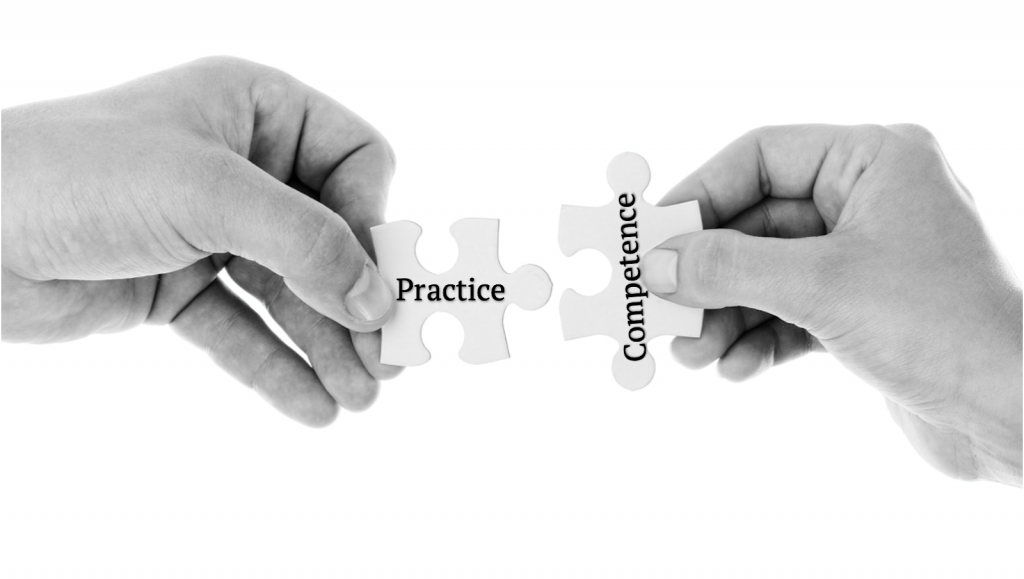
Developing expertise in any of the Community Psychology practice competencies requires a combination of education, extra training and skill building, mentorship, and experience. Keep in mind that no matter how much anyone learns and develops expertise for any one of the competencies, there is always more to learn. It is an ongoing process that unfolds throughout a Community Psychology practitioner’s career.
Critical Thought Questions
Take the Chapter 7 Quiz
View the Chapter 7 Lecture Slides
____________________________________________________________________
Bauer, H. M., Glantsman, O., Hochberg, L., Turner, C., & Jason, L. A. (2017). Community psychology coverage in introduction to psychology textbooks. Global Journal of Community Psychology Practice, 8(3), 1-11. Retrieved from https://www.gjcpp.org/en/article.php?issue=27&article=172
Dalton, J., & Wolfe, S. M. (2012). Joint Column. Education connection and the community practitioner: Competencies for community psychology practice. The Community Psychologist, 45(4), 7-14.
Elias, M. J., Neigher, W. D., & Johnson-Hakim, S. (2015). Guiding principles and competencies for community psychology practice. In V. C. Scott & S. M. Wolfe (Eds.). Community Psychology: Foundations for practice. Los Angeles, CA: Sage Publications.
Jason, L. A., Glantsman, O., O’Brien, J. F., & Ramian, K. N. (2019). Introduction to the field of Community Psychology. In L. A. Jason, O. Glantsman, J. F. O’Brien, & K. N. Ramian (Eds.), Introduction to Community Psychology: Becoming an agent of change. Retrieved from https://press.rebus.community/introductiontocommunitypsychology/
Neigher, W., & Ratcliffe, A. (2010). What is a community psychologist? Why should I hire one? The Community Psychologist, 43(2), 5.
Olson, B. D., & Jason, L. A. (2015). Participatory mixed methods research. In S. N. Hesse-Biber & R. B. Johnson (Eds.) Oxford handbook of mixed and multimethod research. (pp. 393-405). New York: Oxford University Press.
Scott, V. C., & Wolfe, S. M. (Eds.). (2015). Community Psychology: Foundations for practice. SAGE Publications.

Chapter Eight Objectives
By the end of this chapter you will be able to:
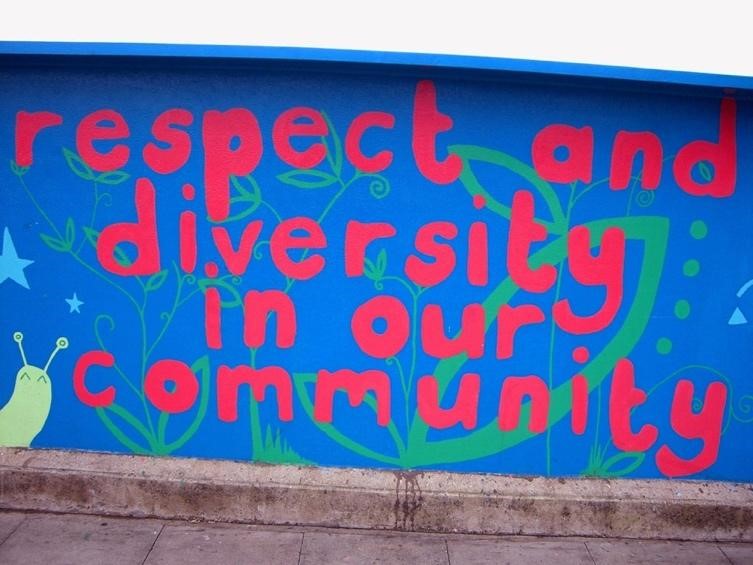
Respect for diversity has been established as a core value for Community Psychology, as indicated in Chapter 1 (Jason, Glantsman, O’Brien, & Ramian, 2019). Appreciating diversity in communities includes understanding dimensions of diversity and how to work within diverse community contexts, but also includes a consideration of how to work within systems of inequality. Community psychologists must be mindful of diverse perspectives and experiences when conducting research and designing interventions, as well as working to combat oppression and promote justice and equality. By working within a framework of cultural humility, this chapter attempts to provide a basic understanding of the dimensions of diversity that are most common in Community Psychology research and practice. Further, we explore how these dimensions contribute to complex identities and considerations for community practice.

As our world becomes increasingly diverse and interconnected, understanding different cultures becomes crucial. Without a basic understanding of the beliefs and experiences of individuals, professionals can unintentionally contribute to prejudice and discrimination or negatively impact professional relationships and effectiveness of services. To understand cultural experiences, it is important to consider contexts of social identity, history, and individual and community experiences with prejudice and discrimination. It is also important to acknowledge that our understanding of cultural differences evolves through an ongoing learning process (Tervalon, & Murray-Garcia, 1998).
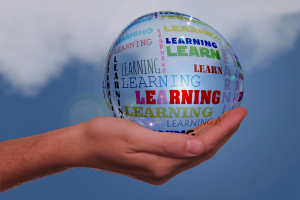
Cultural competence is generally defined as possessing the skills and knowledge of a culture in order to effectively work with individual members of the culture. This definition includes an appreciation of cultural differences and the ability to effectively work with individuals. The assumption that any individual can gain enough knowledge or competence to understand the experiences of members of any culture, however, is problematic. Gaining expertise in cultural competence as traditionally defined seems unattainable, as it involves the need for knowledge and mastery. Instead, true cultural competence requires engaging in an ongoing process of learning about the experiences of other cultures (Tervalon, & Murray-Garcia, 1998). Further reading on cultural competence by Stanley Sue can be found here.
Cultural humility is the ability to remain open to learning about other cultures while acknowledging one’s own lack of competence and recognizing power dynamics that impact the relationship. Within cultural humility it is important to engage in continuous self-reflection, recognize the impact of power dynamics on individuals and communities, embrace “not knowing”, and commit to lifelong learning. This approach to diversity encourages a curious spirit and the ability to openly engage with others in the process of learning about a different culture. As a result, it is important to address power imbalances and develop meaningful relationships with community members in order to create positive change. A guide to cultural humility is offered by Culturally Connected.
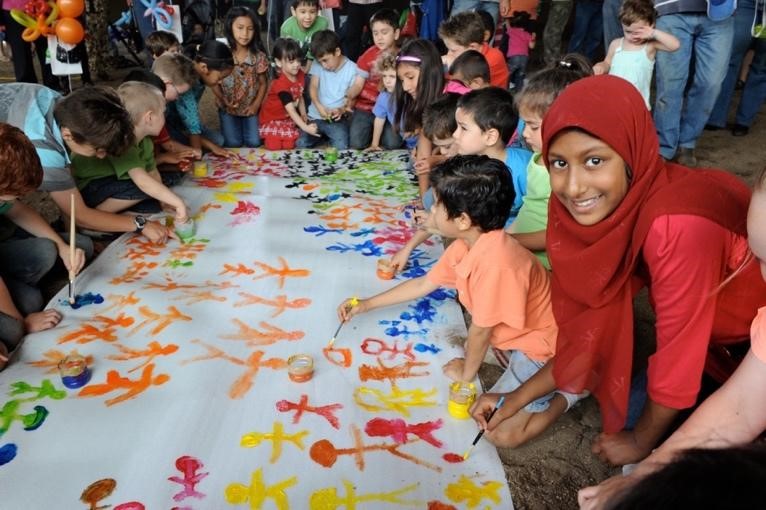
The recognition and appreciation of diversity is a core principle for the field of Community Psychology. Although it is impossible to discuss all of the dimensions of human diversity in this section, we present some common dimensions examined in Community Psychology research and action and point toward where our field could place more emphasis. We also acknowledge the importance of intersectionality, which will be touched upon throughout this chapter, and the process of cultural humility in understanding diversity.
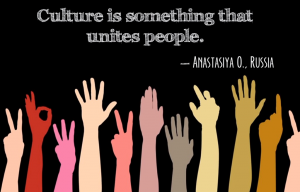
Culture is an important dimension of diversity for community psychologists to examine. In general, culture has been challenging to define, with modern definitions viewing culture as a dynamic concept that changes both individuals and societies together over time. Further, culture in today’s society refers to more than just cultural and ethnic groups but also includes racial groups, religious groups, sexual minority groups, socioeconomic groups, nation-states, and corporations. While numerous definitions for culture are available, there are key defining components such as shared meanings and shared experiences by individuals in a group that are passed down over time with each generation. That is, cultures have shared beliefs, values, practices, definitions, and other elements that are expressed through family socialization, formal schooling, shared language, social roles, and norms for feeling, thinking, and acting (Cohen, 2009).
Using a Community Psychology approach, culture can be examined at multiple ecological levels to understand its impact. This means that culture can influence the norms and practices of individuals, families, organizations, local communities, and the broader society. For example, cultural influences can have an impact on how members function and interact with one another. Further, culture should be understood within a broader context of power relationships, and how power is used and distributed (Trickett, 2011).
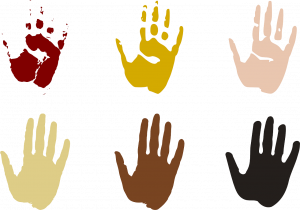
While physical differences often are used to define race, in general, there is no consensus for this term. Typically, race has been defined using observable physical or biological criteria, such as skin color, hair color or texture, facial features, etc. However, these biological assumptions of race have been determined to be inaccurate and harmful by biologists, anthropologists, psychologists, and other scientists. Research has proven no biological foundations to race and that human racial groups are more alike than different; in fact, most genetic variation exists within racial groups rather than between groups. Therefore, racial differences in areas such as academics or intelligence are not based on biological differences but are instead related to economic, historical, and social factors (Betancourt, & Lopez, 1993).
Instead, race has been socially constructed and has different social and psychological meanings in many societies (Betancourt, & Lopez, 1993). In the US, people of color experience more racial prejudice and discrimination than white people. The meanings and definitions of race have also changed over time and are often driven by policies and laws (e.g., one drop rule or laws).
Case Study 8.1
Is Race a Selected Identity?
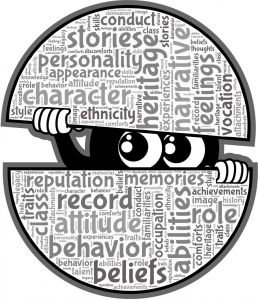
Rachel Dolezal, also known as Nkechi Amare Diallo, was born to white parents with no known African ancestry. As a young adult, she became involved in civil rights, became a college instructor of Africana Studies, and began self-identifying as a black woman. She even became president of the Spokane, Washington chapter of the National Association for the Advancement of Colored People (NAACP). She resigned from her position with the NAACP and was dismissed from her role as an instructor after information surfaced casting doubt upon her racial heritage. She later acknowledged that she was born to white parents but continued to insist that she strongly identifies as a black woman. Read more here.
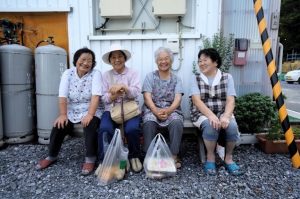
Ethnicity refers to one’s social identity based on the culture of origin, ancestry, or affiliation with a cultural group (Pinderhughes, 1989). Ethnicity is not the same as nationality, which is a person’s status of belonging to a specific nation by birth or citizenship (e.g., an individual can be of Japanese ethnicity but British nationality because they were born in the United Kingdom). Ethnicity is defined by aspects of subjective culture such as customs, language, social ties, etc. (Resnicow, Braithwaite, Ahluwalia, & Baranowski, 1999).
While ethnic groups are combined into broad categories for research or demographic purposes in the US, there are many ethnicities among the ones you may be familiar with. Latina/o/x or Hispanic may refer to persons of Mexican, Puerto Rican, Cuban, Spanish, Dominican, or many other ancestries. Asian Americans have roots from over 20 countries in Asia and India, with the six largest Asian ethnic subgroups in the US being the Chinese, Asian Indians, Filipinos, Vietnamese, Koreans, and Japanese (read more here).
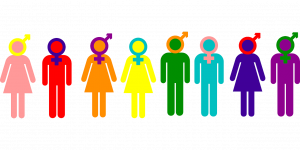
Gender refers to the socially constructed perceptions of what it means to be male or female in our society and how those genders may be reflected and interpreted by society. Gender is different from sex, which is a biological descriptor involving chromosomes and internal/external reproductive organs. As a socially constructed concept, gender has magnified the perceived differences between females and males leading to limitations in attitudes, roles, and how social institutions are organized. For example, how do gender norms influence types of jobs viewed as appropriate or not appropriate for women or men? How are household or parenting responsibilities divided between men and women?
Gender is not just a demographic category but also influences gender norms, the distribution of power and resources, access to opportunities, and other important processes (Bond, 1999). For those who live outside of these traditional expectations for gender, the experience can be challenging. In general, the binary categories for sex, gender, gender identity, and so forth have received the most attention from both society and the research community, with only more attention to other gender identities (e.g., gender neutral, transgender, nonbinary, GenderQueer, etc.) in recent years (Kosciw, Palmer, & Kull, 2015).
But the attention to other gender identities is increasing, both academically and publicly. One example is when Nicole Maines challenged her elementary school’s restroom policy, which resulted in a victory when the Maine Supreme Judicial Court ruled that she had been excluded from the restroom because of her transgender identity. While community psychologists are making efforts to conduct more research on the various gender identities on the gender spectrum, more research needs to continue in this area.

Community Psychology’s emphasis on context has also included aging, or the developmental changes and transitions that come with being a child, adolescent, or adult. Power dynamics, relationships, physical and psychological health concerns, community participation, life satisfaction, and so forth can all vary for these different age groups (Cheng, & Heller, 2009). Although the field has started to include aging issues in research, Cheng and Heller (2009) searched for publications on older adults in major Community Psychology journals and found that this segment of the population has been neglected. Although the skills, values, and training of community psychologists would likely make a difference in the lives of older adults, the attitudes within our profession and society are current barriers.
Similar to the other components of diversity, social class is also socially constructed and can affect our choices and opportunities. This dimension can include a person’s income or material wealth, educational status, and/or occupational status. It can include assumptions about where a person belongs in society and indicate differences in power, privilege, economic opportunities and resources, and social capital. Social class can also indicate culture by shaping a person’s worldview or understanding of the world; influencing how they feel, act, and fit in; and impacting the types of schools they attend, access to health care, or jobs they work at throughout life. The differences in norms, values, and practices between lower and upper social classes can also have impacts on well-being and health outcomes (Cohen, 2009). Social class and its intersection with other components of one’s identity are important for community psychologists to understand. Unnatural Causes: Is Inequality Making Us Sick? is a seven-part documentary that focuses on the connection between social class, racism, and health.

Sexual orientation refers to a person’s emotional, romantic, erotic, and spiritual attractions toward another in relation to their own sex or gender. The definition focuses on feelings rather than behaviors since individuals who identify with a minority sexual orientation experience significant stigma and oppression in our society (Flanders, Robinson, Legge, & Tarasoff, 2016). Sexual orientation exists on a continuum or multiple continuums and crosses all dimensions of diversity (e.g., race, ethnicity, social class, ability, religion, etc.). Sexual orientation is different from gender identity or gender expression. Over time, gay, lesbian, asexual, and bisexual identities have extended to other sexual orientations such as pansexual, polysexual, fluid, and increasingly more research is being conducted on these populations within the field of Community Psychology (Kosciw et al., 2015). As a historically marginalized and oppressed group with inadequate representation in the literature, sexual minority groups face a variety of problems and issues that necessitate further research. The empowering and participatory approaches and methods used in Community Psychology can be beneficial for research with sexual minority groups.

Disabilities refer to visible or hidden and temporary or permanent conditions that provide barriers or challenges, and impact individuals of every age and social group. Traditional views of disability follow a medical model, primarily explaining diagnoses and treatment models from a pathological perspective (Goodley, & Lawthom, 2010). In this traditional approach, individuals diagnosed with a disability are often discussed as objects of study instead of complex individuals impacted by their environment. Community Psychology, however, follows a social model of ability in which diagnoses are viewed from a social and environmental perspective and consider multiple ecological levels. The experiences of individuals are strongly valued and participatory action research is a valuable way to explore experiences while empowering members of a community with varying levels of ability/disability. Learn more by watching the Employment Choice for People with Severe Physical Disabilities video.
Culture must be considered when viewing ability from a social perspective (Goodley, & Lawthom, 2000), and may impact whether or not certain behaviors are considered sufficient for inclusion in a diagnosis. For example, cultural differences in the assessment of typical development have impacted the diagnosis of Autism Spectrum Disorders in different countries. Further, diagnoses or symptoms can be culturally-specific, and culture may influence how symptoms are communicated. The experience of culture can significantly impact lived experience for individuals diagnosed with a disability.
It is important to consider how intersectionality impacts the experience of disability. For example, students of color and other underserved groups have a higher rate of diagnosis of learning disabilities, emotional and behavioral disabilities, and intellectual disabilities (Artiles, Kozleski, Trent, Osher, & Ortiz, 2010), which may be due to economic, historical, and social factors. Diagnosis must be considered as disabled youth are at a disadvantage in a number of indicators of educational performance, leading to more substantial disparities later in life.
How one identifies individuals with a particular label, such as race, gender or sexuality is rather complicated, and unless investigators are careful in their descriptions of these terms, many problems can be encountered as has been reviewed above. Identifying who has a disability or health condition can also be a challenge and can have real, tangible consequences for an affected group. As an example, if prevalence research suggests that a particular disability or health condition is relatively rare, it is possible that few federal and state resources will be devoted to those individuals. But if the methodology for selecting individuals is flawed, then the prevalence rates will be inaccurate and potentially biased. This is what occurred with the health condition known as Chronic Fatigue Syndrome, now also known as Myalgic Encephalomyelitis, as indicated in Case Study 8.2.
Case Study 8.2
How Flawed Research Can Lead to More Stigma
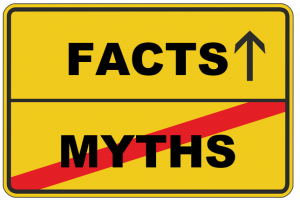
When the Centers for Disease Control tried to estimate the prevalence of those with this illness, they concluded that only about 20,000 people had this condition in the US, and most with this illness tended to be white, middle-class women, which is what led to the stigmatizing label “Yuppie-Flu disease”. However, the way the investigators conducted this research was flawed, as they asked health care personnel to identify individuals with this illness, but as many health care professionals did not believe that this was a real or legitimate, they tended to refer few individuals to the study. In addition, as many individuals with a chronic health condition do not have access to the health care system, many individuals with this illness were not able to be brought into the prevalence study. However, when a group of community psychologists used better research methods that involved deriving their sample from randomly contacting people in the community, without depending on referrals from physicians, they estimated that about a million individuals had ME/CFS. In addition, those identified tended to be from lower socioeconomic status groups and communities of color (just the opposite of what had been characterized as Yuppie Flu) (Jason et al., 1999). The findings from this study were widely disseminated and it led to reductions in some of the bias and stigmatization that has been directed to those with this illness.
The impact of disability on identity and intersection with other social identities is important for community psychologists to understand. Community Psychology’s unique perspective has contributed to applied research conducted among communities and individuals with disabilities. The need for understanding, empowerment, and advocacy through participatory action research continues to exist for individuals with disabilities.

There are many definitions of religion, most of which typically include shared systems of beliefs and values, symbols, feelings, actions, experiences, and a source of community unity (Cohen, 2009). Religion emphasizes beliefs and practices, relationships with the divine, and faith, all of which differentiate it from common definitions of culture. Further, religion is an important predictor for wellbeing, satisfaction, and other life outcomes (Tarakeshwar, Stanton, & Pargament, 2003). While religion has been neglected in psychological research, it has been included in Community Psychology’s conceptualization of diversity since the beginning of the field.
Religion and spirituality were formerly considered a joint concept but have been differentiated in the past century. Definitions of spirituality typically focus on relationships with the divine and a quest for meaning. The differentiation between religion and spirituality has become more relevant recently as many individuals consider themselves more spiritual than they are religious. Community Psychology has long considered religion as a dimension of diversity, but the importance of spirituality in our understanding of community has been a more recent development.
The importance of religion and spirituality to physical and emotional well-being and a strong sense of community merits the inclusion of both in research and practice (Tarakeshwar et al., 2003). Community psychologists understand the importance of working in natural settings, which frequently include religious and spiritual settings. Collaboration with religious organizations and embedding interventions into these settings may have positive impacts on individuals in the community and may also help religious organizations reach goals.
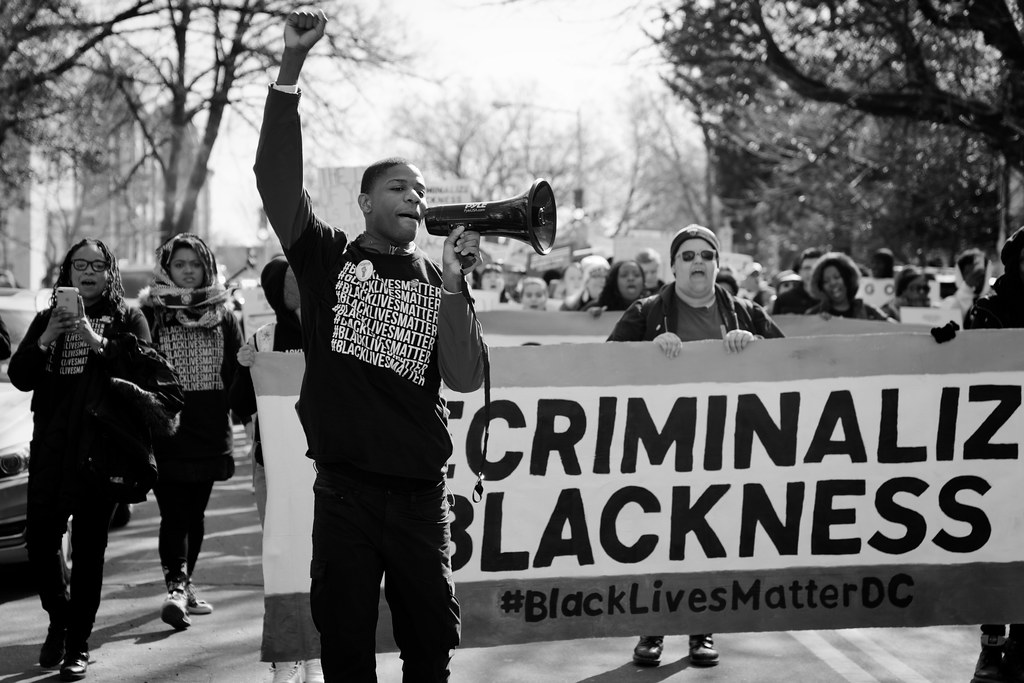
While the various dimensions of diversity discussed above are a start to understanding human diversity, they do not fully describe an individual, community, or population. Instead, we must consider that these dimensions do not exist independently of each other and that the interaction of these dimensions is referred to as intersectionality (Crenshaw, 1989). Intersectionality focuses on how the dimensions can overlap and give rise to different experiences as well as multiple privileges or inequities; for example, racial/ethnic and sexual minority men will experience more health disparities than white and/or heterosexual men. Community psychologists recognize the significance of intersectionality but published research in this area is still lacking compared to other disciplines. “The Urgency of Intersectionality” video can help you learn more about intersectionality.
Privilege, or the unearned advantages that individuals have based on membership in a dominant group (e.g., race, gender, social class, sexual orientation, ability), contribute to the systems of oppression for non-privileged individuals and groups. While privilege can come in multiple forms and individuals can have multiple privileges; white privilege, or the advantages that white people have in society, are important for psychologists to examine more extensively to understand how white people participate in systems of oppression for racial minority groups in the US (Todd, McConnell, & Suffin, 2014). For example, white experiences and perspectives tend to be pervasive in curriculum, policy, pedagogy, and practices (Suyemoto, & Fox Tree, 2006) at the exclusion of work and research by people of color.
Janet Helms’ (1995) important work on the white racial identity model describes how white people move from a racist identity to a non-racist identity as they become more aware, move beyond an effective understanding of racial minorities to an experiential one, and understand their role in a racist society. Other community psychologists have explored how to create organizational contexts that are more inclusive and address white privilege (Bond, 1999) or examined how white privilege influences commitment and interest toward social justice (Todd et al., 2014). While community psychologists are contributing to this research, more studies are needed to understand the relationship between identity, privilege, and social justice and action in community contexts.
Using a framework of cultural humility, community psychologists consider context when working with communities which provides the ability to view various dimensions of diversity while considering the impacts of prejudice and discrimination. It is also important to consider how cultural practices differ in all settings in which the individual operates. Considering context expands the perspective of culture to include historical context, intersectionality of identities, and the experience of prejudice and discrimination.
The Society for Community Research and Action (SCRA) has identified sociocultural and cross-cultural competence as one of the 18 foundational principles of Community Psychology-practice, which is defined as “the ability to value, integrate, and bridge multiple worldviews, cultures, and identities.” SCRA expands upon the importance of recognizing multiple contexts to integrate elements of cultural humility in practice settings. Prior to working in communities, it is important to examine one’s own worldview and consider how it interacts with the community through culture and power dynamics. It is important to recognize and articulate dynamics related to culture and power differentials with the communities in which community psychologists work. Due to the complexity of these dynamics, respecting diversity in practice may require the formation of relationships with various members of a community who may be able to serve as a guide for working with the community in culturally valid ways.
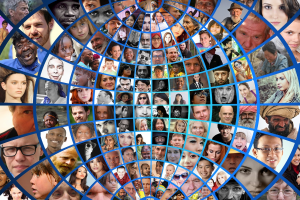
Adopting cultural humility is necessary for considering diversity in research. In research, it is important to consider how questions are asked or which samples are included in a study. In addition, the importance of topics of research to diverse communities must be considered, which may require developing research topics and questions with the populations that are being impacted. Participatory action research (PAR) is a valuable tool for developing topics in an inclusive way and is a method frequently used by community psychologists to find solutions in the social environment (Kidd, & Kral, 2005).
Research must also consider the power dynamics between the researcher and the community as well as the dynamics within the community. The use of culturally-anchored methodologies is important for exploring research questions in the appropriate context. Marginalized groups are often compared to a majority group, but these comparisons may not always acknowledge the implications of power dynamics present in such comparisons. When developing the methodology, it is important for the researcher to acknowledge one’s own cultural assumptions, experiences, and positions of power. Recognition of these aspects of self will lead to a more careful framing of the research question within context. Finally, it is important to consider where to disseminate research findings to reach wide audiences.

Designing programs in the community need to start with an understanding of the diverse cultures and communities in which they will be situated. To that end, collaborative and ecological systems approaches used by community psychologists are incorporated throughout the design of community prevention and intervention programs. Altogether, these approaches situate culture at every level of planning a program from the conceptualization to the implementation. In Case Study 8.3, Trickett (2011) provides a cautionary example of what can happen when culture is not more deeply considered in community interventions.
Case Study 8.3
Water Boiling in a Peruvian Town
In “Water Boiling in a Peruvian Town” by Ed Wellin (1955; see Trickett, 2011), a three-year public health intervention was implemented to decrease the water-related health risks in Los Molinos, a rural Peruvian town. The evidence-based practice of boiling water targeted women, with the assumption that increased knowledge about the health benefits of boiling water would persuade them to change. The intervention was delivered by a health worker who took up residence in Los Molinos and her goal was to have the women boil their water before using it. The intervention turned out to be unsuccessful as the majority of women did not start this practice and this was due to several reasons steeped in cultural beliefs and local customs or conditions. For example, the cultural meanings of hot and cold in their culture meant that boiled water was used for certain health issues, but it was not associated with germs or diseases. Over time, boiled water was culturally linked to illness and very much disliked by the local people. The intervention’s impact was also further affected by the women’s inability to boil because of their daily routines, social ostracization for boiling because of the meanings of cold and hot water, and lack of interest in women’s lives by the gendered town’s leadership.
This case study demonstrates the significant impact of culture on well-intentioned and scientifically-based interventions meant to improve community health and well-being. For that reason, Trickett provides recommendations about how Community Psychology can contribute more to the understanding of culture in research and practice. Some of these recommendations include focusing on communities more than programs, understanding that choice is more important than change, working with local experts in the community, and using research designs and methods that are appropriate for diverse cultures and populations.
Another approach proposed by Resnicow and colleagues (1999) considers surface structure and deep structure for designing culturally-anchored community programs. Surface structure includes aspects of the program that are observable such as gender, race, and ethnicity of the staff members; setting; language(s) used; and choices of cultural components, such as music or food. Deep structure includes knowing the historical, social, and psychological knowledge of the culture to understand core cultural values, beliefs, and practices. However, attending to both surface and deep structures will not guarantee the success of the program. Matching the race or ethnicity of the staff to program participants is not always enough to establish trust or resolve all cultural differences. Similarly, programs using deep structures may appeal differently to those with different acculturation statuses; therefore, more research is necessary to determine the effectiveness of these culturally anchored programs.
Overall, as our knowledge and work with diverse communities continues to expand, the culturally-situated and anchored approaches used by community psychologists will continue to be very important for designing programs. Central to this will be the evolving development of a cultural Community Psychology which incorporates theories and methods from cross-cultural and cultural psychology in research and practice (O’Donnell, & Tharp, 2012).

This chapter presented the framework of cultural humility as an ongoing approach to working with diverse communities. It is important to recognize various dimensions of diversity and how they intersect to produce unique experiences of inequity or privilege. Community psychologists go beyond traditional research and practice by working with members of marginalized groups to challenge oppression through participatory action research and to provide tools for empowerment and self-directed change.
Critical Thought Questions
Take the Chapter 8 Quiz
View the Chapter 8 Lecture Slides
____________________________________________________________________
Artiles, A. J., Kozleski, E. B., Trent, S. C., Osher, D., & Ortiz, A. (2010). Justifying and explaining disproportionality, 1968-2008: A critique of underlying views of culture. Exceptional Children, 76(3), 279-299. doi: 10.1177/001440291007600303
Betancourt, H., & Lopez, S. R. (1993). The study of culture, ethnicity, and race in American psychology. American Psychologist, 48(6), 629-637.
Bond, M. A. (1999). Gender, race, and class in organizational contexts. American Journal of Community Psychology, 27(3), 327-355.
Cheng, S. T., & Heller, K. (2009). Global aging: Challenges for community psychology. American Journal of Community Psychology, 44, 161-173.
Cohen, A. B. (2009). Many forms of culture. American Psychologist, 64(3), 194-204.
Crenshaw, K. (1989). Demarginalizing the intersection of race and sex: A Black feminist critique of antidiscrimination doctrine, feminist theory and antiracist politics. The University of Chicago Legal Forum, 140, 139-168.
Flanders, C. E., Robinson, M., Legge, M. M., & Tarasoff, L. A. (2016). Negative identity experiences of bisexual and other non-monosexual people: A qualitative report. Journal of Gay & Lesbian Mental Health, 20(2), 152-172.
Goodley, D., & Lawthom, R. (2010). Epistemological journeys in participatory action research: Alliances between community psychology and disability studies. Disability & Society, 20(2), 135-151. doi: 10.1080/09687590500059077
Helms, J. E. (1995). An update of Helms’ White and people of color racial identity models. In J. G. Ponterotto, J. M. Casas, L. A. Suzuki, & C. M Alexander (Eds.), Handbook of multicultural counseling (pp. 181-198). Thousand Oaks, CA: Sage.
Jason, L. A., Glantsman, O., O’Brien, J. F., & Ramian, K. N. (2019). Introduction to the field of Community Psychology. In L. A. Jason, O. Glantsman, J. F. O’Brien, & K. N. Ramian (Eds.), Introduction to Community Psychology: Becoming an agent of change. Retrieved from https://press.rebus.community/introductiontocommunitypsychology/chapter/intro -to-community-psychology/
Jason, L. A., Richman, J. A., Rademaker, A. W., Jordan, K. M., Plioplys, A. V., Taylor, R. R.,… Plioplys, S. (1999). A community-based study of chronic fatigue syndrome. Archives of internal medicine, 159(18), 2129-2137.
Kidd, S. A., & Kral, M. J. (2005). Practicing participatory action research. Journal of Counseling Psychology, 52(2), 187-195. doi:10.1037/0022-0167.52.2.187
Kosciw, J. G., Palmer, N. A., & Kull, R. M. (2015). Reflecting resiliency: Openness about sexual orientation and/or gender identity and its relationship to well-being and educational outcomes for LGBT students. American Journal of Community Psychology, 55, 167-178.
O’Donnell, C. R., & Tharp, R. G. (2012). Integrating cultural community psychology: Activity settings and the shared meanings of intersubjectivity. American Journal of Community Psychology, 49, 22-30.
Pinderhughes, E. (1989). Understanding race, ethnicity and power: The key to efficacy in clinical practice. New York: Basic Books.
Resnicow, K., Braithwaite, R., Ahluwalia, J., & Baranowski, T. (1999). Cultural sensitivity in public health: Defined and demystified. Ethnicity & Disease, 9, 10-21.
Suyemoto, K. L., & Fox Tree, C. A. (2006). Building bridges across differences to meet social action goals: Being and creating allies among people of color. American Journal of Community Psychology, 37, 237-246.
Tarakeshwar, N., Stanton, J., & Pargament, K. I. (2003). Relgion: An overlooked dimension in cross-cultural psychology. Journal of Cross-Cultural Psychology, 34, 377-394. doi: 10.1177/0022022103034004001
Tervalon, M., & Murray-Garcia, J. (1998). Cultural humility versus cultural competence: A critical distinction in defining physician training outcomes in multicultural education. Journal of Health Care for the Poor and Underserved, 9(2), 117-125.
Todd, N. R., McConnell, E. A., & Suffrin, R. L. (2014). The role of attitudes toward white privilege and religious beliefs in predicting social justice interest and commitment. American Journal of Community Psychology, 53, 109-121.
Trickett, E. J. (2011). From “Water boiling in a Peruvian town” to “Letting them die”: Culture, community intervention, and the metabolic balance between patience and zeal. American Journal of Community Psychology, 47, 58-68.
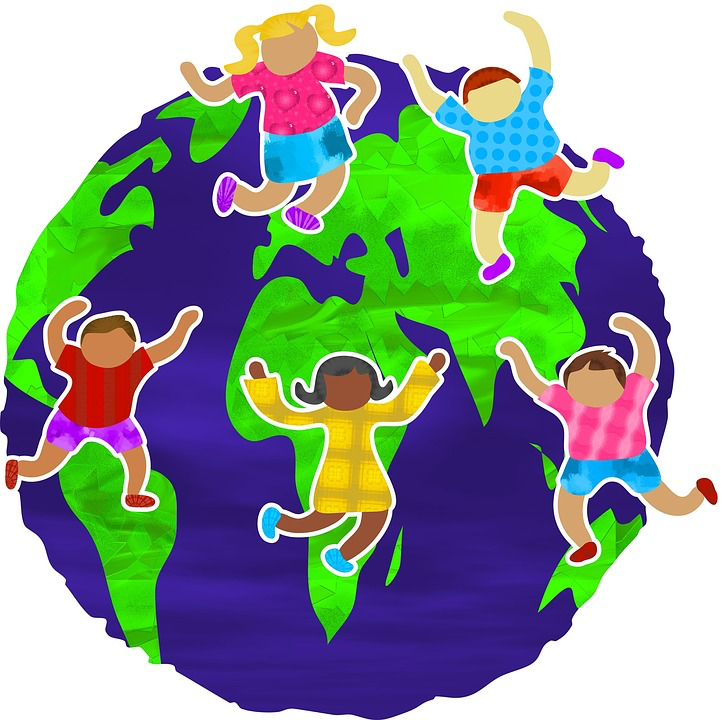
Chapter Nine Objectives
By the end of this chapter you will be able to:

“Healing begins where the wound was made.”
-Alice Walker (The Way Forward is With a Broken Heart)
Community Psychology has grown up amidst times in US history and throughout the world where social change has been the interwoven thread throughout urban and suburban spaces. Social change continues to be the thread we must use to construct new realities. Not uncommon, as community psychologists have discovered over the past few years, social change work can often be more effective starting at the community level and then branching outward to macrosystems.
“….the definition and critical analysis of oppression has left out the complexity, voices and lived experiences of individuals who have been severely impacted by injustice and oppression…”
– bell hooks (1994)Macrosystems include influences of governmental policies, corporations, and belief systems. To this end, having a firm understanding of the dynamics that challenge communities is critical. This understanding must extend to grappling with some of the more unjust practices such as oppression and power that have influenced and shaped many of our communities today, particularly where members are people of color. The purpose of this chapter is to introduce the interrelated concepts of oppression and power and explore their relationship to the health and well-being of communities. We conceptualize oppression and power in upcoming sections. First, we give an overview of what oppression is. Second, we discuss the concept of power. Third, we discuss the relationship between oppression and power, because they typically never act alone. Fourth, we look at methodologies to deconstruct oppression and power. Finally, we offer strategies that can, and are, used in Community Psychology practice.
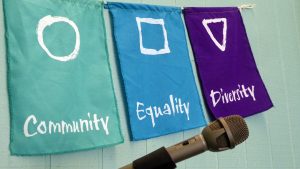
This chapter expands on the discussion of oppression and power in Chapter 1 (Jason, Glantsman, O’Brien, & Ramian, 2019) and other current Community Psychology textbooks, primarily through the lens of those who have been and continue to be oppressed. Broadly defined through theoretical and abstract concepts, the definition and critical analysis of oppression have left out the complexity, voices, and lived experiences of individuals who have been severely impacted by injustice and oppression. Our ways of knowing and being are credible and of critical importance to students learning how knowledge and power are created and what evidence is most credible in discussing them. We also include information that portrays the strength and resiliency of community members as a balance to the scholarship. The authors’ perspectives and inclusion of the lived experiences of others will add richness and depth to your studies.
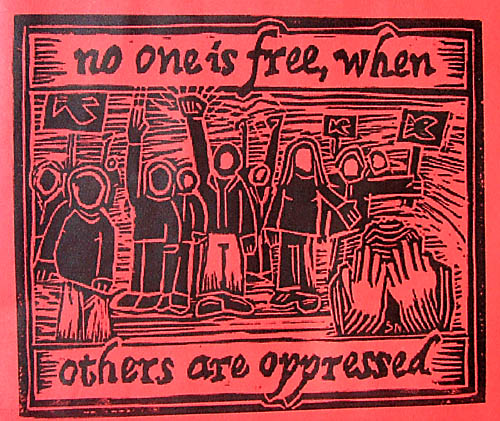
Oppression is defined in Merriam-Webster dictionary as: “Unjust or cruel exercise of authority or power especially by the imposition of burdens; the condition of being weighed down; an act of pressing down; a sense of heaviness or obstruction in the body or mind”. This definition demonstrates the intensity of oppression, which also shows how difficult such a challenge is to address or eradicate. Further, the word oppression comes from the Latin root primere, which actually means “pressed down”. Importantly, we can conclude that oppression is the social act of placing severe restrictions on an individual, group, or institution.

Moreover oppression is often discussed in the same context as the terms “dehumanization” and “exploitation”. These are terms that portray unjustness and cruelty. To adequately prepare you to effectively address the challenges many communities are facing, we include the terms to help familiarize you with what oppression feels like to the receiver. Understanding the perceptions, meanings, and experiences of community members is critical for work in Community Psychology in order to address social issues such as oppression. The excerpt below gives an example of a person, who also happens to be a community psychologist, describing their lived oppressive experiences:
Case Study 9.1
A Personal Communication
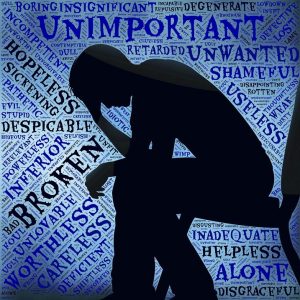
“…I felt this fullness, unexplainable presence, inner pain but it was not tangible, almost like a phantom ache or pain, that sensation a person has when they have lost a limb and it feels like it is still there but it hurts. It filled my body. I was grief-stricken. Sad. I felt that I, WE, THEY, have let our children down. Our Village is no longer protecting our children. That sacred piece of our legacy.
If I can take accountability or acknowledge this wrong, why doesn’t our oppressor? What is the value in destroying a child, a people, their dreams? It is mean, evil, greedy, disastrous, ugly, devilish, and immoral. It is every gunshot into the backs of Black men. It is an assassination of the human spirit. It rapes us of our purpose. Our young people should never, never feel uncared for, unwanted or invisible….
I bow my head with my hands over my ears and I sit in silence. I realize that these feelings have been sitting dormant…”
(-J. Samuel, personal communication, 2018)
It is important to note that while we are providing you with a framework of oppression and power, we will also provide you with examples of action strategies for how community psychologists and allies are supporting the resiliency in communities so that you can feel encouraged to discover your own way into combating oppression.

After studying the concept of oppression, you might be asking- what is the reason for oppression? Typically, a government or political organization that is in power places these restrictions formally or covertly on groups so that the distribution of resources are unfairly allocated—and this means power stays in the hands of those who already have it (a discussion on power follows this section). We understand that oppression occurs when individuals are systematically subjected to political, economic, cultural, or social degradation because they belong to a certain social group—this results from structures of domination and subordination and, correspondingly, ideologies of superiority and inferiority.
According to decolonial theory, over the last 500 years, the colonial matrix of power, patron colonial de poder has been and is one of the primary sources of oppression. Decolonial theory uses a framework that attempts to answer questions pertaining to knowledge, coloniality, and globalization. The “western world” is a production of coloniality and modernity. The latter two terms refer to the socio-cultural norms developed after the 18th century and the chapter in European history known as the Enlightenment. It is defined loosely by industrialization, science, division of labor, capitalism, secularism, education, and liberalism (Smith, 1999). Further western modernity created and constructed the idea of ‘race’ as a biological function, as part of a narrative to indicate the superiority of the white race and the inferiority of all other races (peoples). Western modernity and the colonial matrix of power have constructed a particular place: the West. Read more about the nature and origin of oppression here.
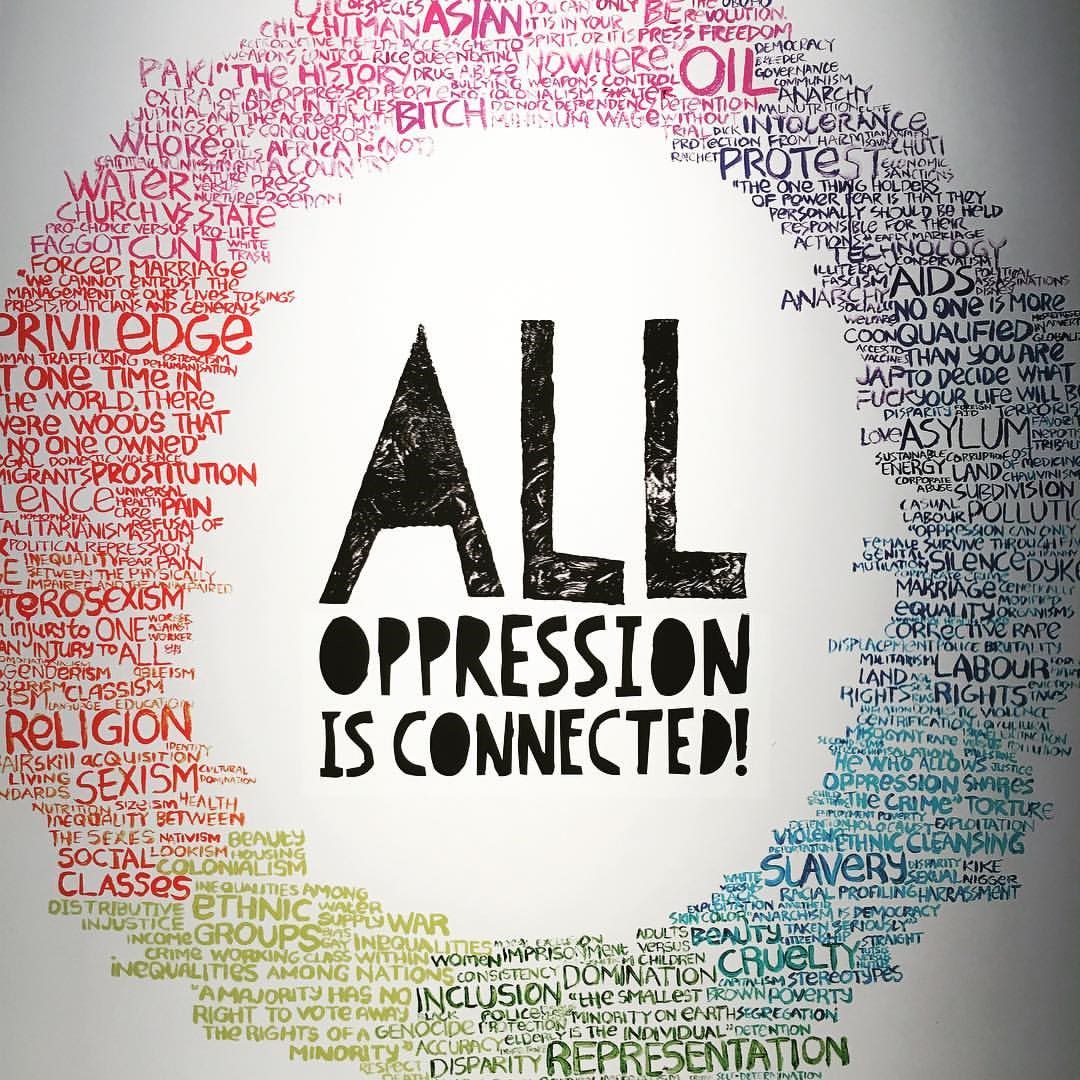
Oppression is described in psychology as states and processes that include psychological and political components of victimization, agency, and resistance where power relations produce domination, subordination, and resistance (Prilleltensky, 2003). The oppressed group suffers greatly from multiple forms of exclusion, exploitation, control, and violence. The literature on the psychological impact of oppression suggests that the erasure and removal of intrinsic cultural identities influenced by oppressive practices can lead to negative outcomes such as “internalization of negative group identities and low self-esteem.”
In understanding psychology of oppression, the oppressed initially adopt “avoidance reactions” which are responses that prevent adverse outcomes from occurring. This happens before one truly internalizes the ideologies of the oppressor, which ultimately results in engaging in self- destructive behaviors before reaching the point of internalized racism and assimilation. Lastly, oppression is not a static concept nor does it have a fixed relationship to racism and discrimination. It changes and can be extremely non-transparent—both covert and overt. The tools of oppression are often disguised or hidden as privileges. Read more here on the impact of oppression and power on communities of color. Case Study 9.2 below provides a number of factors indicative of the impact of oppression from political, economic, and socio-cultural factors on one community in Chicago, IL.
Case Study 9.2
Englewood: Struggling to Rise
Once known as Junction Grove, the rich history of Englewood began in the mid-1800s as the area quickly developed into a rail and commerce crossroads. Junction Grove changed its name to Englewood in 1868, and in 1889, it became part of the City of Chicago. With its cross streets at 63rd and Halsted, the four railroad stations, and the 63rd Street ‘L’ stop, Englewood has long been a transportation hub of the southwest side. This easy access helped to make Englewood one of the largest outlying business districts in the country for much of the first half of the 20th century (Roberts, & Stamz, 2002).
Yet, as racial strife shook the 1950s and ’60s, white flight occurred from US communities while African Americans moved in. Subsequently, banks refused to lend money to people trying to start businesses or buy homes in African American neighborhoods, and major grocery stores and other companies refused to open branches. Englewood was no exception (Lydersen, 2011). Further, political redistricting has resulted in Englewood being divided into five districts, each of which is assigned to a different Illinois district. This has created more division and strife. Can you identify the political, economic and socio-cultural factors resulting from oppression and power?
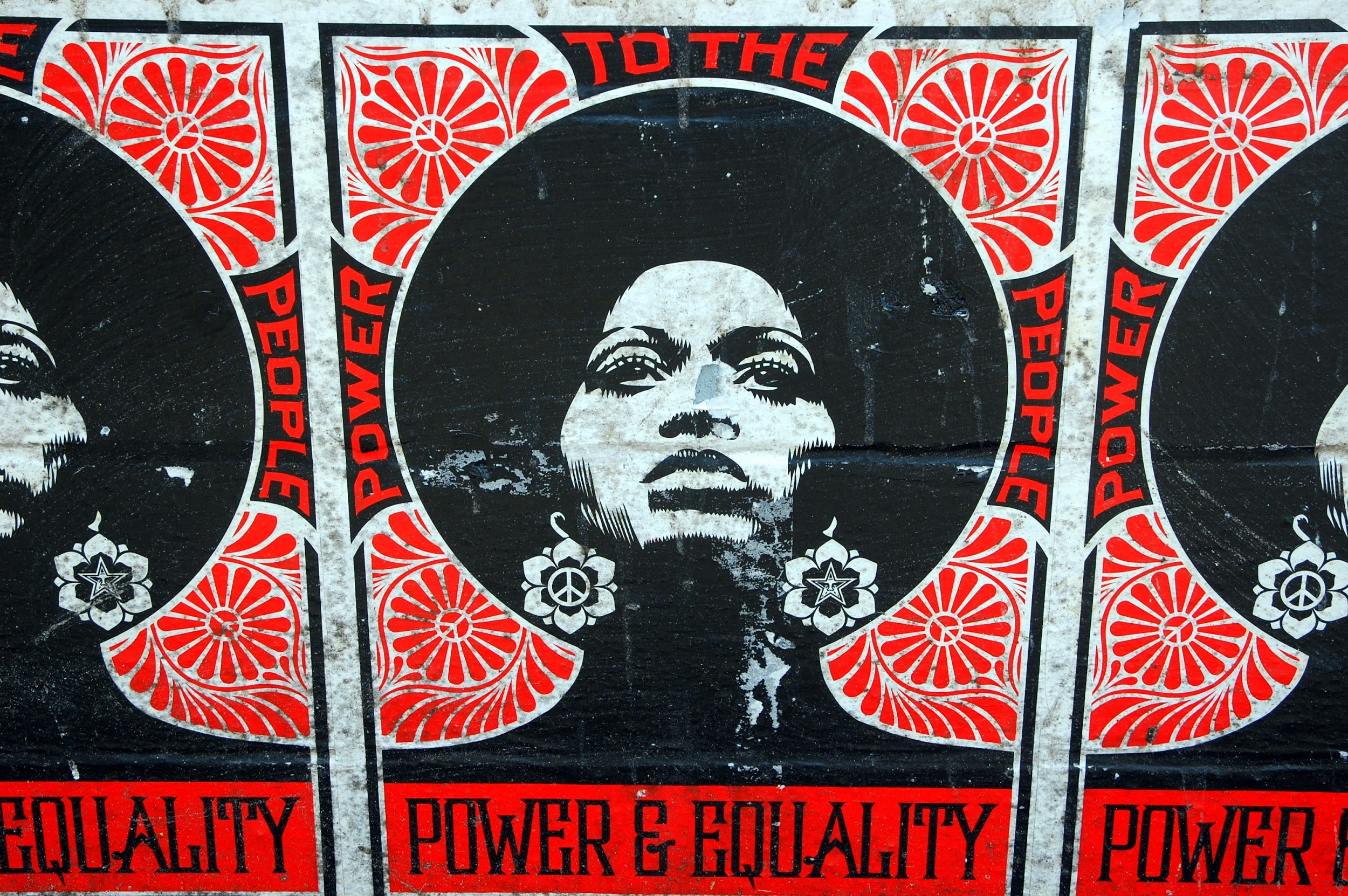
Power is a concept that has come to possess numerous meanings for different individuals. Power is multifaceted and takes various forms: power over, power to, and power from (Kloos et al., 2012). Power over is the ability to compel or dominate others, control resources, and enforce commands. Power to is the ability of people to pursue personal and/or collective goals and to develop their own capacities. Power from is the ability to resist coercion and unwanted commands/demands.
Much of the conversations on power have been through the lens of empowerment (Riger, 1993; Rappaport, 1981; Rappaport, 1987). Rappaport (1981) proposed empowerment as a phenomenon of interest for the field, stating the need for a distinction between actual power (i.e., political empowerment) and perceived power (i.e., psychological empowerment).
Furthermore, we understand empowerment as an individualistic concept which needs to incorporate social power. These theorists have conceptualized empowerment as a manifestation of social power and propose three instruments of its implementation. First, it is having control over resources in such a way that they can be used to reward and punish various people. Second, it is the ability to control barriers to participation through defining what we talk about and how we talk about it. One example is expert power, which is based on the “perceived knowledge, skill, or experience of a person or group” (Kloos et al., 2012). Third, it is a force that shapes shared consciousness through myths, ideology, and control of information. To support these concepts, Serrano-García (1984), a community psychologist, discusses both the successes and failures of a community development intervention in her homeland of Puerto Rico in Case Study 9.3.
Case Study 9.3
Proyecto Esfuerzo (Project Effort)

Irma Serrano-Garcia (1984) wrote, “As a member of a group of people who believe in equality and freedom and in the capacity of human beings to achieve both, I write as a Puerto Rican and community psychologist. My work stems from a social change perspective. As a community psychologist with a commitment to the “disadvantaged” groups of society, I believe that my values should be clearly stated… the island was under Spanish rule from 1843 to 1898 making our traditions mainly hispanic and our language, Spanish. The country was turned over to the US as a war booty of the Spanish American War in 1898” (Serrano-Garcia, 1984, p. 174).
To this end, the country was under the rule of the US for some aspects such as citizenship and foreign trade, and some areas were ruled by Puerto Rico’s internal governmental structure. Economically 60% of the citizens earned an annual income of $2,500 or less, while 70% received food stamps (SNAP Benefits) or other public benefits. Unemployed rates soared at 22.7% of the population and 99% of the food was imported. Serrano-Garcia further shared, “Our reality is one of colonization and not self-determination, of hispanic not anglo-saxon traditions and of underdevelopment and not economic growth” (p. 174). This and other factors prompted the onset of community development efforts to foster change directed by the quest for empowerment. The intervention framework to address this challenge included both a community development and research model. Six key points acted as guidelines including familiarization with the community, needs and resources, linking reality, concrete activities and resident’s integration, transition, and end of project…Read more here. How do the six guidelines used in the framework intersect with each other?

Systems of domination often work not only through physical force but through language. Cultural racism deems a group’s culture as inferior, including its language. A group’s social and political power typically coincides with the status of their language within the society (Belgrave, & Allison, 2019). A byproduct of colonialism is the fact that millions of people around the world speak languages not indigenous to their own lands, but to former colonial powers (England, France, Spain, Portugal, etc.). Native cultures and languages were overthrown by the culture and language of the colonizers. Translation works both as a language tool and as an instrument of power, and this is used when languages are translated and when people are transformed, or translated, by changing their sense of their place in society.
Control over language and information is referred to as power/knowledge. Focult asserts that power is inherently tied to control over and access to information and vice versa. Knowledge is always related to systems of power. James Baldwin (1979) similarly refers to language as a political instrument. The language a person uses communicates their status within that society. He proposed the language barrier that prevented Africans from communicating with one another limited their collective power. According to Baldwin, the development of Black English is a result of particular relationships of power: “A language comes into existence by means of brutal necessity, and the rules of the language are dictated by what the language must convey.”

Perhaps one of the most expansive and dominating forms of power has been colonialism. During the 19th century, as much as 90% of the world was controlled and/or colonized by western (European and European-derived) nations. This suppression and domination were justified using the construct of race, false research theories that portrayed non-white populations as infantile, incompetent, primitive, savage, and needing Western powers to civilize them and bring them into modernity. The rise of settler societies like the US and Canada are the results of centuries of violent conflict, cultural and spatial displacement, and social, economic, and political oppression. During the 20th century, people across Africa, Asia, and Latin America engaged in anti-colonial struggles for independence. Although formal imperial empires came to an end when these countries gained their independence, informal empires remained, as many nations continued to be dependent on former colonial powers. Consequently, political, economic, and military controls were largely maintained within these nations, as a result of adopting the power and oppression of the colonial powers.

Power and oppression can be said to be mirror reflections of one another in a sense or are two sides of the same coin. Where you see power that causes harm, you will likely see oppression. Oppression emerges as a result of power, with its roots in global colonialism and conquests. For example, oppression as an action can deny certain groups jobs that pay living wages, can establish unequal education (e.g., through a lack of adequate capital per student for resources), can deny affordable housing, and the list goes on. You may be wondering why some groups live in poverty, reside in substandard housing, or simply do not measure up to the dominant society in some facet. We have some idea, but today we are still grappling with these questions and still conducting research studies to better understand.
As discussed at a seminar at the Leaven Center (2003), groups that do not have “power over” are those society classifies or labels as disenfranchised; they are exploited and victimized in a variety of ways by agents of oppression and/or systems and institutions. They are subjected to restrictions and seen as expendable and replaceable—particularly by agents of oppression. This philosophy, in turn, minimizes the roles certain populations play in society. Sadly, agents of oppression often deny that this injustice occurs and blames oppressive conditions on the behaviors and actions of the oppressed group. Oppression subsequently becomes a system and patterns are adopted and perpetuated. Thai and Lien (2019) in Chapter 6 discuss diversity and highlight the impact of “white privilege” as a major contributor to systems and patterns of oppression for non-privileged individuals and groups.
Additionally, socialization patterns help maintain systems of oppression. Members of society learn through formal and informal educational environments that advance the ideologies of the dominant group, and how they should act and what their role and place are in society. Power is thus exercised in this instance but now is both psychologically and physically harmful. This process of constructing knowledge is helpful to those who seek to control and oppress, through power, because physical coercion may not last, but psychological ramifications can be perpetual, particularly without intervention.
As shared, knowledge is sustained through social processes, and what we come to know and believe is socially constructed, so it becomes ever more important to discuss dominant narratives of our society and the meaning it lends to our culture. It is our role as community psychologists to be a witness, to advocate, and to raise the voice and consciousness of those who lack power and /or the capacity to do so themselves. It is also our role to raise the consciousness of those who oppress and disempower. In the next section, we shall take a look at roles community psychologists can play in consciousness raising and deconstructing power and oppression.
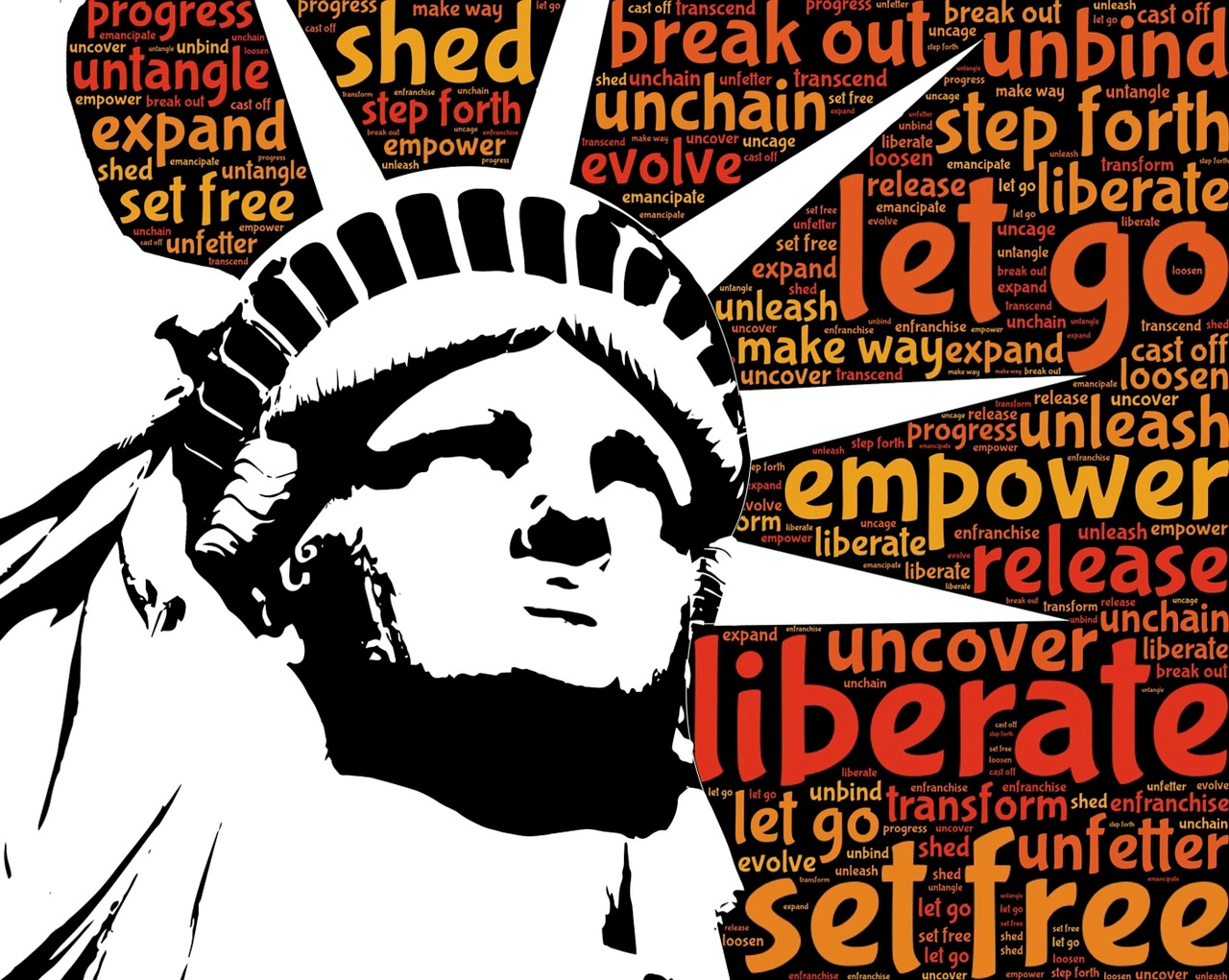
As mentioned in Chapter 1 (Jason, Glantsman, O’Brien, & Ramian, 2019), community psychologists endorse a social justice and critical psychology perspective, where the position is to challenge and address oppressive systems through a number of action strategies including approaches that fall under a dismantling framework. To this end, we now discuss two interconnected, yet distinct community approaches that focus on what is termed the deconstruction and reclaiming of power. Deconstruction has its roots in Jacques Derrida’s work in critical analysis of theoretical and literary language. We speak about reclaiming as simply recovering or getting back. A discussion of liberation, followed by decolonization and reclaiming power through Black Feminist theory, concludes this section, as it demonstrates how power is de-centered and reclaimed for the power and liberation of communities.
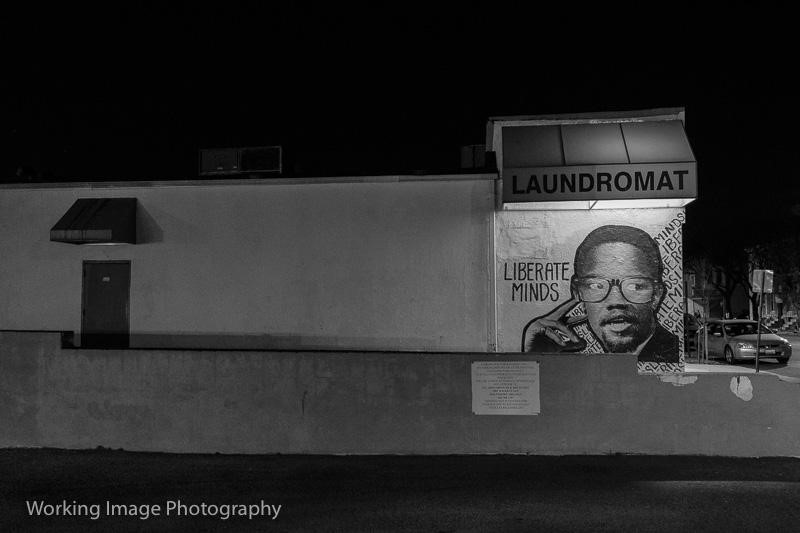
Community psychologists engage topics associated with the dismantling of oppression and power. One of these concepts is liberation. Liberation is defined as the social, cultural, economic, and political freedom and emancipation to have agency, control, and power over one’s life. To live life freely and unaffected or harmed by conditions of oppression is to experience liberation (Watkins, 2002). Although there are varied ways of experiencing liberation – from the individual to the community to the systemic – each one is interconnected with the other. An individual, or psychological sense of liberation, lies in the ability for the person to feel unconstrained by stereotypes and prejudiced ideas that manifest as acts of discrimination. When individuals are constantly feeling that their bodies are being perceived and categorized in biased ways because of their race, ethnicity, gender, sexuality, age, and other visible characteristics, their capacity to act with free will is constrained. For example, students of color at predominantly white institutions of higher education often experience higher levels of stress and anxiety because they experience more micro-aggressions (Hope et al., 2018). Students of color are therefore marked by these experiences in ways that are detrimental to their well-being and academic success. Liberation for these students is limited by the culture of racism and colorblindness inherent in the university. At a collective or community level, liberation is possible when the group is able to gain power and control over the knowledge, systems, and institutions that surround their lives. As Brazilian popular educator, Paulo Freire suggests, liberation is a social act, a process of becoming free from ideologies that limit our freedom and the institutions or structures that constrain people’s collective determination. Liberation must be understood as having a critical consciousness of the circumstances and conditions of oppression that challenge and limit opportunities for freedom. Liberation is also a practice of working to create change. As Martín-Baró proposes, liberation is the dismantling of oppression and power, and striving to create social change that recognizes the humanity and dignity of all people. As an example of this work, we have included in Case Study 9.4 an excerpt of a letter adopted by the Society for Community Research and Action (SCRA) in opposition to the Dakota Access Pipeline.
Case Study 9.4
The Dakota Access Pipeline

In July 2016, the Army Corps of Engineers approved the plans for the Dallas-based Energy Transfer Partners to construct the Dakota Access Pipeline, a 1,172 mile underground crude oil transportation system stretching from North Dakota to Illinois. It is estimated that the pipeline will pump just under half a million barrels of fracked crude oil per day across the Missouri River, the Mississippi River, and other sources of drinking water, which will impact surrounding communities. Although many will potentially be affected by the proposed pipeline, the Lakota Sioux and the Standing Rock Sioux Indian Reservation spanning North and South Dakota are among those most directly affected by the pipeline and have voiced strong opposition to its continued construction. As psychologists committed to racial, ethnic, and cultural justice we stand in opposition to the continued construction of the Dakota Access Pipeline so long as that pipeline infringes on the environmental health and sacred spaces of indigenous communities…Read more of the letter here. What are examples of dismantling and liberation?
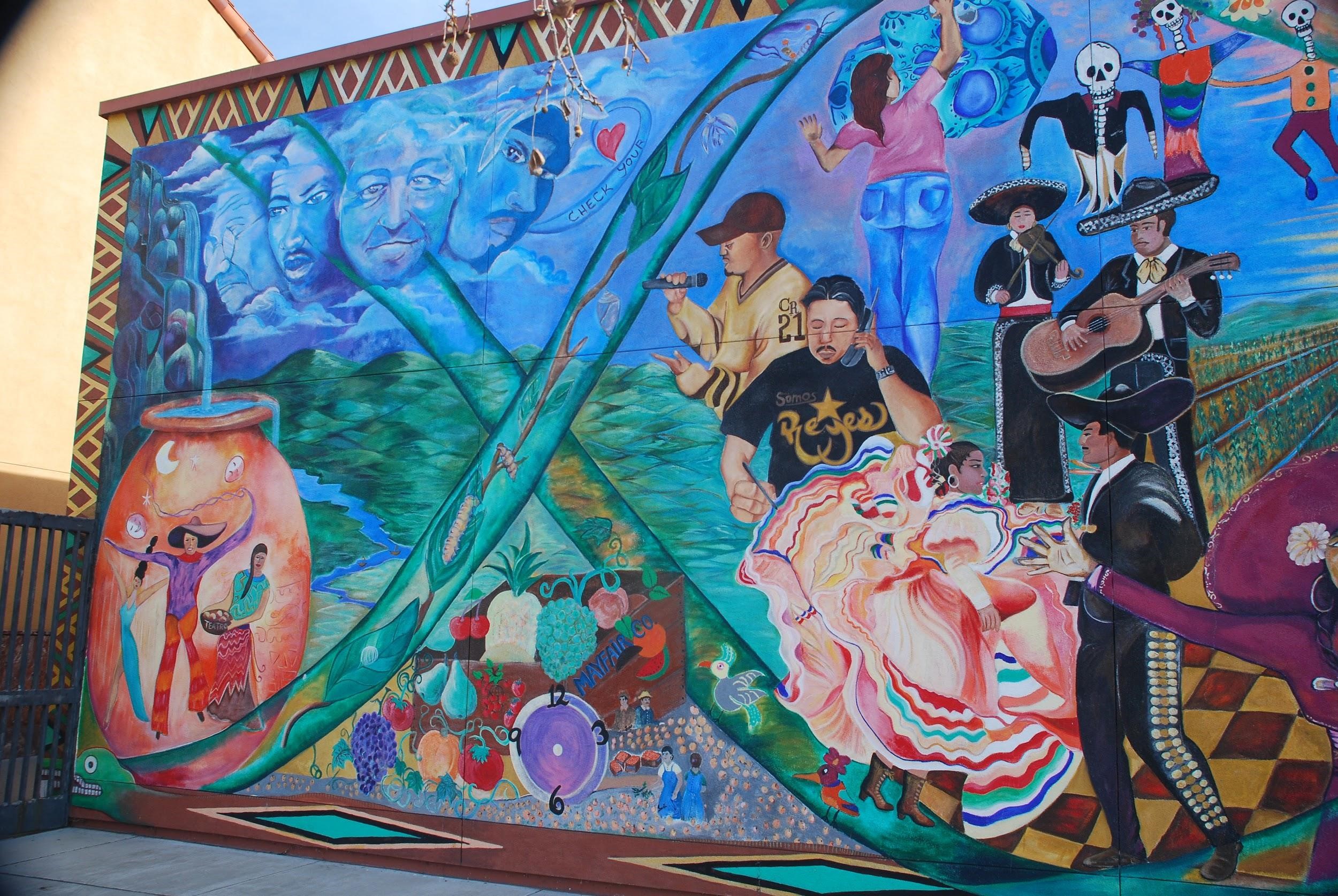
Although often associated with freedom, decoloniality is not the same nor should it be equated with liberation. Decoloniality is characterized by a process of undoing, disrupting, and de-linking knowledge rooted in Eurocentric thinking that ignores or devalues the local knowledge, experiences, and expertise of non-Western peoples or dominant social groups (Maldonado-Torres, 2011). Furthermore, decoloniality challenges coloniality and colonialism – the former defined as the power and control over people and knowledge, and the latter being a process through which power and control are acquired often through violence (Mignolo, 2009). Decoloniality, therefore, contests the assumptions of systems, or the organization of peoples and worlds, into categories. For example, the “othering” of Indigenous communities by forcing them onto reservation lands and then subsequently occupying and exploiting these lands and natural resources, as in the Dakota Access Pipeline examples, is a form of coloniality. This “othering” perpetuates the oppression and dehumanization of Indigenous communities across generations (Gone, 2016). Re-thinking and deconstructing Eurocentric/Western ideologies and practices that uphold coloniality as the power over people, lands, and knowledge is thus the main point of decolonization. A decolonial standpoint in Community Psychology honors and respects the humanity of all communities, especially those that have been institutionally marginalized, and sees values in local knowledge, culture, and place (Moane, 2003). For an example of a decolonial community-based participatory action research project–-collaboratively led by Dr. Jesica Siham Ferńandez and Dr. Laura Nichols with Mexican immigrant mothers in a community undergoing gentrification in the Silicon Valley (California, US). It centers on the voices, culture, and lived experiences of Mexican and Latinx communities (check out a newspaper report covering the making of the mural, and a short news media coverage showcasing the madres speaking about their process).

This section discusses intersectionality as a form of decolonialism that is crucial to a well-rounded understanding of how our multiple identities play into the world around us. Intersectionality, rooted in Black feminist thought, emerged at the turn of the 21st century. Black feminist theory, informed by the work of Collins (1990/2000), Lorde (1984), hooks (1994), the Combahee River Collective, and other Black feminist scholars such as Sojourner Truth and other writers and activists, surfaced as a radical movement. Intersectionality was developed by Kimberlé W. Crenshaw and this short video link should help with understanding. The concept primarily illustrates the intersectional experiences of Black women, whose concerns were neither fully addressed within the Civil Rights Movement, nor the (white) feminist movement. Intersectionality posits that race and gender categories, along with other dimensions of identity and positionality, such as sexuality, age, class and able-bodiness, are clear and have social, legal, political, and economic implications. Within Community Psychology, intersectionality provides a theoretical lens for re-conceptualizing race, along with other categories of difference and positions of power, beyond identity politics. Rather than focusing on the politics of difference, intersectionality describes the interlocking patterns of oppression and marginality that structure people’s lives, opportunities, and enfranchisement. Intersectionality provides a theoretical framework from which we can examine and deconstruct the structures of race and gender oppression (Collins, 1990/2000). Furthermore, intersectionality also offers implications for working toward a practice of solidarity among those interested in advancing social justice.
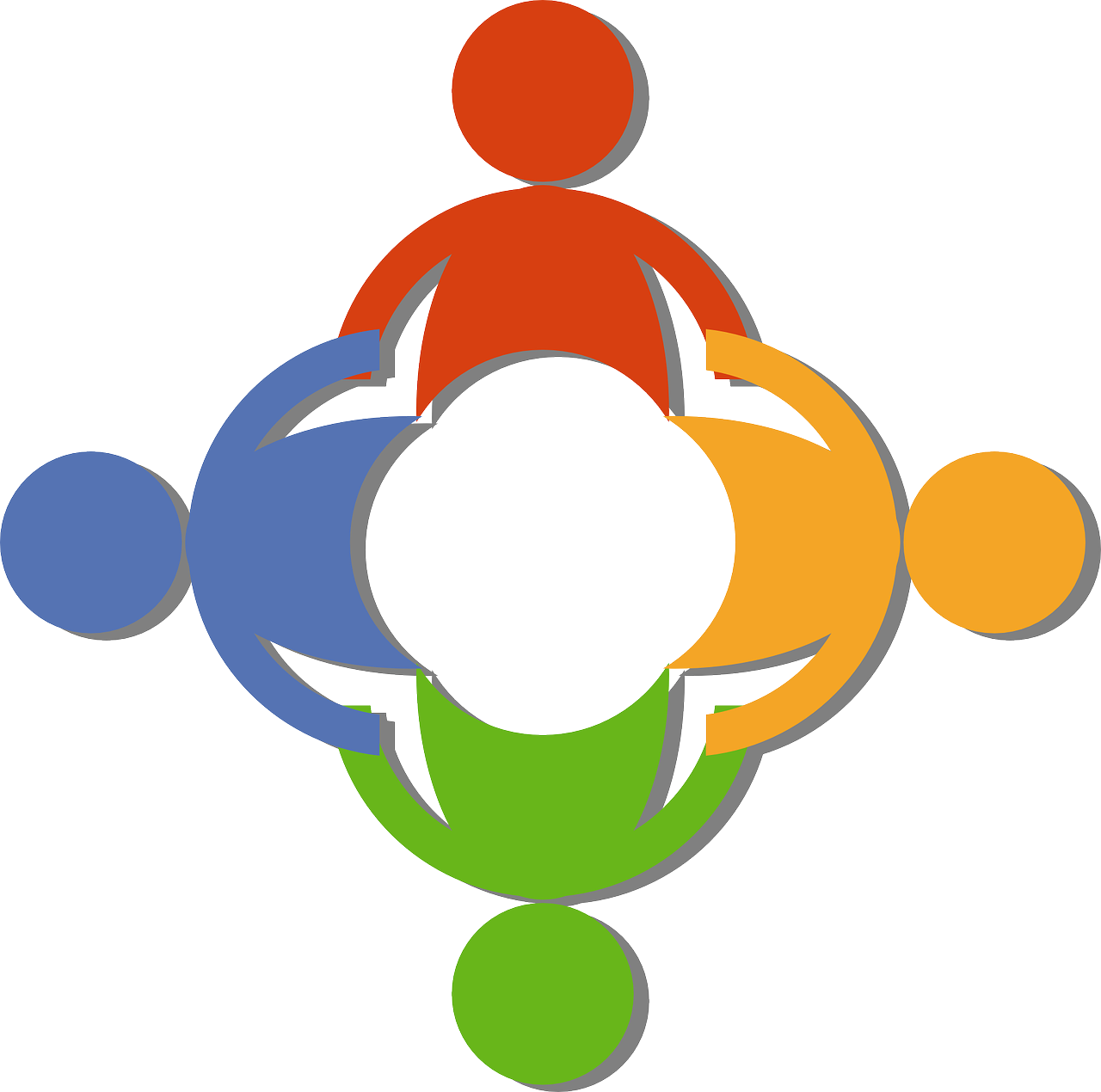
The concepts of oppression and power are not only multi-dimensional but also involve multifaceted, complex means of being executed. In order to effectively conceptualize dismantling and disrupting power and oppression, it is important to delve further into looking at systems by which power and oppression exist and are maintained. Bronfenbrenner’s ecological systems theory provided a framework for us to examine how power and oppression are carried out and perpetuated in individual and community environments. Yet, human behavior is not simply nested as Bronfenbrenner theorized, but our behavior is also networked, where each system is defined in terms of the social relationships surrounding a targeted individual, and where systems at different levels relate to one another in an overlapping fashion (Neal, & Neal 2013). Thus, dismantling power and oppression is a difficult task that requires a community systems approach. It is also important to note that historical events such as colonialism and change across time necessitate that idea that power/oppression must be continually re-examined and monitored.
The Chicanx Student Movement is an example of the results of oppression and power and a social action strategy, to address the issue. See Case Study 9.5 for a discussion on the East LA “Blowouts”.
Case Study 9.5
The Chicano Student Movement and Educational System in East LA

The 1968 East LA blowouts were a direct response to the educational inequities experienced by Chicanx students attending several of the local high schools in the East LA area (e.g., Wilson, Lincoln, Belmont, Roosevelt, Garfield). For example, students attended schools that lacked resources, were placed in overcrowded classrooms where they often faced derogatory comments by teachers, were prohibited from talking in Spanish and where disobedience was met with corporal punishment or janitorial work. Moreover, non-white male students were pushed into non-academic classes like wood shop or auto-mechanic shop classes while females were sent to cooking classes, sewing, and secretary prep courses. Consequently, dropout rates were as high as sixty percent.
However, as the numbers of students walking out grew, so did the challenges. Students who joined the walkouts were met with violence from police deployed to the schools. While many students were beaten during the walkouts, other students, who helped to lead the movement, faced further legal troubles. As a result, 13 male students were charged with conspiracy, only avoiding charges after protests by the community were held and litigations were filed. Fifty years later the Los Angeles Unified School District and Cal State LA a Hispanic Serving Institution (HSI) in the heart of the East LA area, organized a “Walk-In” to commemorate the 1968 blowouts and to highlight the changes that have occurred. Over 500 high school students from the same walkout schools marched onto the Cal State LA campus chanting “Yes we can.” While this is certainly a change the reality for students is they continue to struggle to gain access to higher education.
Protests and other forms of addressing community issues often result in unintended consequences but continue to be strategies employed to advance social justice. What are some strategies for mitigating unintended consequences?
Other action strategies discussed in earlier chapters that have been met with both challenges and successes are in social movements and consciousness-raising efforts. In recent years there has been an explosion of young people’s participation in social movements across the U.S. Some include involvement in long-term struggles such as the fight for equal rights for the LGBTQ+ community, and some are a continuance of prior social movements such as the #MeToo Movement (evolving from the struggle for women’s rights) as well as the Black Lives Matter movement. Read more here.
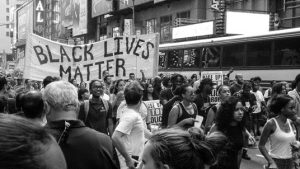
Consciousness-raising efforts have their roots in a number of theorists’ frameworks and movements including Pedagogy of the Oppressed and the feminist movements as previously mentioned. Yet, it is important to also understand that structural systems of oppression are found in the categorical labeling we use to exclude and separate. Case Study 9.6 below illustrates a strategy for dismantling labeling that perpetuates inequality through reframing the language of liberation.
Case Study 9.6
Reframing Language for Liberation
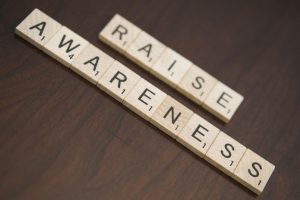
In 2012, Geri Palmer, former executive director of a non-profit organization in Chicago and current community psychologist, became aware of the importance of the influence of public perspectives and attitudes regarding people who are homeless, specifically relative to funding and resources. She recognized that public perceptions and attitudes are formed in many ways, one being the words and terms used to discuss, and refer to marginalized populations. This is important, as terms that describe and categorize people experiencing homelessness, such as “the homeless” and “homeless people” are widely used by those in the helping professions. Yet, they reflect the core ideologies and economic interests of the dominant majority and have their roots in historical systems of inequality and oppression.
Through a series of workshops held in medical and health care facilities, in board development workshops, conferences, and classrooms designed to raise awareness, The Language Reframing Project was initiated. The goal was twofold: (1) Raise awareness of language and labeling and its negative implications; and (2) reframe language and labeling in discourse and in reference to people who are homeless, as well as other populations considered marginalized. This can specifically be applied to all marketing materials including websites and social media. One agency has changed its online marketing materials to align with the campaign’s mission, and former employees of this agency report they are pushing forward the language reframing initiative in their new workplaces and overall worldview. The Salvation Army has adopted a similar campaign (Palmer, 2018)…Read more here. Why does categorical labeling of certain groups of people perpetuate oppression?

Community psychologists are equipped with the skills and training, practice, and lived experience needed to address the most pressing of social issues and concerns in our communities today. The continuation of structural systems of oppression and power, and its grip on our communities, families, and individuals is an ever-present concern and it is no easy task to engage in dismantling and addressing structural systems. Yet, we are advancing social justice through the strategies we mention here and are making great strides by supporting the resiliency in the same communities where oppressive systems exist. We strived to make this portion of the book as realistic as possible, particularly with the help of looking through the eyes of community psychologists who have lived experiences as well as allies who support the work of community psychologists in practice and community-driven research. We wanted a chapter that spoke to the multi-faceted dynamics of oppression and power, but also to provide actionable strategies that are tools for liberation. Moreover, by providing this free online textbook, we are in a very direct way dealing with the high price of textbooks that often is a real hurdle for our college students, who sometimes can not even afford to purchase them and are disadvantaged by this economic barrier. This effort is a strategy that also empowers and liberates.
We have attempted to include a balanced view, discussing the concepts and impact, but showing how resilience and empowerment have been successful at advancing social justice. It is important for undergraduate students, specifically in Community Psychology, to see the fullness of what the discipline embraces and strives to uphold.
Critical Thought Questions
1. What experiences do you have with power and/or oppression? In thinking about the “two faces” of power and oppression, how have you seen power and oppression operate in your life or in the life of others in your community?
2. Reread Dr. Irma Serrano-Garcia’s article. Identify the role of coloniality and colonialism in shaping the Puerto Rican experience. What do coloniality and colonialism look like today?
3. Explain how you have experienced or seen power operate in your life or in your community. What are some contemporary examples of the coloniality of power today?
4. Think back to the other cases studies presented in this chapter. Identify how oppressed and institutionally disenfranchised communities interrupted and sought to deconstruct power.
5. Reflecting back on the experience of power or oppression that you initially identified, what is one theory or concept that stood out to you, and which helps you think about ways of addressing oppressive systems of power? Why does that theory or concept stand out to you the most?
Take the Chapter 9 Quiz
View the Chapter 9 Lecture Slides
____________________________________________________________________
Baldwin, J. (1979). If Black English isn’t a language: Then tell me what is? The Black Scholar, 27(1), 5-6.
Belgrave, F. Z., & Allison, K. W. (2019). African American psychology: From Africa to America. United States: Sage Publications.
Collins, P. H. (1990/2000). Black feminist thought: Knowledge, consciousness and the politics of empowerment. New York: NY: Routledge.
Gone, J. P. (2016). Alternative knowledges and the future of community psychology: Provocations from an American Indian healing tradition. American Journal of Community Psychology, 58(3-4), 314-321.
hooks, B. (1994). Teaching to transgress. New York, NY: Routledge.
Hope, E. C., Velez, G., Offidani-Bertrand, C., Keels, M., & Durkee, M. I. (2018). Political activism and mental health among Black and Latinx college students. Cultural Diversity and Ethnic Minority Psychology, 24(1), 26.
Jason, L. A., Glantsman, O., O’Brien, J. F., & Ramian, K. N. (2019). Introduction to the field of Community Psychology. In L. A. Jason, O. Glantsman, J. F. O’Brien, & K. N. Ramian (Eds.), Introduction to Community Psychology: Becoming an agent of change. Retrieved from https://press.rebus.community/introductiontocommunitypsychology/chapter/intro-to-community-psychology/
Kloos, B., Hill, J., Thomas, E., Wandersman, A., Elias, M., & Dalton, J., (2012). Community psychology: linking individuals and communities. Belmont, CA: Wadsworth Cengage.
Leaven Center (2003). Doing Our Own Work: A Seminar for Anti-Racist White Women.
Visions, Inc. and the MSU Extension Multicultural Awareness Workshop.
Lorde, A. (1984). Age, race, class and sex: Women redefining difference. In Sister outsider: Essays and speeches. Freedom, CA: Crossing Press.
Lydersen, K. (2011, June 18). Culinary school thrives, but neighbors stay poor. The New York Times. Retrieved from https://www.nytimes.com/2011/06/19/us/19cncwashburne.html
Maldonado-Torres, N. (2011). Thinking through the decolonial turn: Post-continental interventions in theory, philosophy, and critique: An introduction. Transmodernity: Journal of Peripheral Cultural Production of the Luso-Hispanic World, 1(2).
Mignolo, W. D. (2009). Epistemic disobedience, independent thought and decolonial freedom. Theory, Culture & Society, 26(7-8), 159-181.
Moane, G. (2003). Bridging the personal and the political: Practices for a liberation psychology. American Journal of Community Psychology, 31, 91–101.
Neal, J., & Neal, Z. (2013). Nested or networked? future directions for ecological systems theory. Social Development, 22(4), 722-737. doi:10.1111/sode.12018
Palmer, G. (2018). People who are homeless are “people” first: Opportunity for community psychologists to lead through language reframing. Global Journal for Community Psychology in Practice. Retrieved from https://www.gjcpp.org/en/article.php?issue=30&article=180
Prilleltensky, I. (2003). Understanding, resisting, and overcoming oppression: Toward psychopolitical validity. American Journal of Community Psychology, 31(1-2), 195-201.
Rappaport, J. (1987). Terms of empowerment/exemplars of prevention: Toward a theory for community psychology. American Journal of Community Psychology, 15(2), 121-148.
Rappaport, J. (1981). In praise of paradox: A social policy of empowerment over prevention. American Journal of Community Psychology, 9, 1-25.
Riger, S. (1993). What’s wrong with empowerment? American Journal of Community Psychology, 21, 279-292.
Roberts, M., & Stamz, R. (2002). Chicago’s englewood neighborhood : At the junction (Images of america). Chicago, IL: Arcadia Pub.
Serrano-García, I. (1984). The illusion of empowerment: Community development within a colonial context. Prevention in Human Services, 3(2-3), 173-200.
Smith, L. T. (1999). Decolonizing methodologies: Research and indigenous peoples. NY, NY: Zed Books, Ltd.
Thai, N. D. & Lien, A. (2019). Respect for diversity. In L. A. Jason, O. Glantsman, J. F. O’Brien, & K. N. Ramian (Eds.), Introduction to Community Psychology: Becoming an agent of change. Retrieved from https://press.rebus.community/introductiontocommunitypsychology/chapter/respect-for-diversity/
Watkins, M. (2002). Seeding liberation: A dialogue between depth psychology and liberation psychology. In D. Slattery & L. Corbett (Eds.), Depth psychology: Meditations in the field. (pp. 204-225). Einsiedeln, SW: Daimon Verlag.

Acknowledgments: We wish to thank Ann Marie Beals for her diligent work in reviewing our chapter. We wish to thank Lenny Jason, Olya Glantsman, Jack O’Brien and Kaitlyn Ramian for their feedback and support of our chapter.
Chapter Ten Objectives
By the end of this chapter you will be able to:

The cries of “Black Power!”, “Student Power!”, and “Power to the People!” rang out in the 1960s and beyond. The idea of power was central to those social movements. The work of those groups led to changes in civil rights, gay rights, and women’s rights. For example, the Women’s Movement raised important issues regarding women’s relative lack of power in personal relationships and their lack of opportunities in the workplace and larger society. Oppressive conditions supported by men-driven laws and policies in the larger society affected women on the individual, organizational, community, and societal levels.
Many participating within these social change movements experienced greater empowerment, which means gaining greater influence and control over important matters in one’s life and environment. Coupled with visions of hope and possibility, empowerment helped spur movements for positive social change for African Americans, students, women, Latinx, LGBT individuals, people with disabilities, Asian-Americans, prisoners, and people with mental illness, among many other groups.
Rappaport (1981) proposed that empowerment should be one of the primary focus of Community Psychology. He believed that empowerment is about helping those with less than their fair share of power to understand their own situation and gain more power. For Rappaport, empowerment includes considering people’s needs, their rights and their choices, and it captures the breadth of concern with the powerlessness that many groups experience.
To fully address the powerlessness of individuals and groups, efforts toward empowerment must be made on multiple levels. At the individual level, awareness of one’s lack of power can make one more likely to work towards increasing personal power. At a higher level, legal and societal sides of oppression may give rise to societal and political change. Thus, empowerment is a multilevel concept that impacts individuals, organizations, communities, and societies. From these beginnings, empowerment has come to be a key idea in Community Psychology and has also been important to fields such as Social Work, Public Health, Education, Political Science, Anthropology, and Community Development (Keys, McConnell, Motley, Liao, & McAuliff, 2017). Now, let’s consider how empowerment is thought of at different levels of analysis.

Individual Empowerment
Individual empowerment allows people to exercise control and increase self-efficacy. Self-efficacy can be described as developing a sense of personal power, strength, or mastery that aids in increasing one’s capacity to act in situations where one feels a lack of power. Individual self-efficacy is sometimes considered a “westernized” or “individualistic” construct built on the idea that simply having a belief in one’s ability to achieve a certain outcome is all a person needs for self-empowerment. This would imply that an internal belief in oneself is both sufficient and desirable for changing a one’s life. But change in self-efficacy without real change in one’s life cannot truly be called empowerment (Cattaneo, & Chapman, 2010).
In contrast, psychological empowerment at the individual and group levels requires increased awareness and understanding of the factors that influence our lives. It is a process by which we become aware of the power dynamics that occur at multiple levels in our lives. This could be something like becoming aware of being treated differently due to the color of one’s skin, or how the lack of resources in the community one lives in affects one’s well-being. People then begin to develop skills for gaining control over relevant aspects of their lives, such as advocating for themselves or working on coping techniques to respond to discrimination. To truly address all the factors that affect a person’s life, people’s actions should also be directed toward changing the conditions of oppression at multiples levels, such as conditions in the home, at work, or in society. These environmental changes can be complemented by an increase in one’s degree of control over aspects of one’s own life.
Psychological empowerment considers the role of the context and the influences from external factors that impact the lives of all people (Keys et al., 2017). For example, women in the 1950s were affected by how they were treated both at home and in the workplace. In both cases, there were clear power differentials, whether it was between husband and wife or employer and worker. These external factors, or contextual factors outside of individual women’s control, impacted women in the environments where they lived and worked. The Women’s Movement and related advocacy efforts were led by women who had developed empowerment skills individually and began supporting the empowerment of others on a societal scale.
Changes individually and on a group level can be accomplished through critically examining the situations people find themselves in. For example, the Black Power Movement in the 1960s and the Black Lives Matter Movement in the present are responses to the personal and societal oppression African Americans felt as citizens of the US. These social movements criticized the cultural norms of the time and challenged people to really think critically about how African Americans were being mistreated and abused on a daily basis. As with all individual and group level change, the context had to be examined through a critical lens.
Critical awareness leads individuals to identify personal and contextual factors that may be part of empowerment for particular individuals or groups. These factors may include additional skills, access to financial capital, access to other resources and opportunities, and access to individuals with greater power. Methods include, but are not limited to, training, developing advocacy skills, studying, becoming self-efficacious, and pursuing resources and opportunities (Cattaneo, & Chapman, 2010). By increasing skills and access to resources, one can work towards achieving an increased sense of individual and psychological empowerment. A good example of psychological empowerment is found in Case Study 10.1, about Ed Roberts and his efforts toward helping people with disabilities live independently.
Case Study 10.1
Independent Living Movement
The life of Ed Roberts—a central figure in the development of the independent living movement for people with disabilities in the US—is an example of psychological empowerment. Ed became severely paralyzed at a young age. In his childhood, Roberts’ mother instilled an appreciation for education in her son. She also taught him how to advocate for what he needed. Roberts experienced firsthand the ways in which society distributed power unfairly. A high school administrator threatened to not allow Roberts to earn his high school diploma because Roberts had not completed a driver’s training or physical education course, which he could not physically perform. He had to fight those decisions. After graduating from high school, Roberts was admitted to the University of California-Berkeley but had to fight for accommodations and support from both the university and his rehabilitation counselor. Roberts’ admission to the university drew more individuals with physical disabilities to attend the college. He began to advocate for changes to be made to the physical environment, such as curb cuts to aid people in wheelchairs. He also helped to create the first student-led disability services program in the United States and advocated for attendant services and wheelchair repairs to be provided on campus. At the University of California-Berkeley, he earned both a bachelor’s and a master’s degree. Because of his work, Ed made this university a more accessible place for himself and other individuals with disabilities.
At the organizational level, it is useful to think of empowerment in two ways: empowering those within the organization and being effective in fairly addressing organization level issues and working well with those outside the organization such as other organizations and governmental policies and laws. Regarding the first meaning of organizational empowerment, empowering, we can think of ways an organization is empowering of those individual and groups within it. We first need to recognize that organizations can control and influence those who are inside the organization (Peterson, & Zimmerman, 2004). For instance, Maton (2008) identified a set of positive core organizational characteristics for empowering community settings. These include a group-based belief system (e.g., the organization inspires change), positive core activities (e.g., active learning), a supportive relational environment (e.g., caring relationships), opportunity role structure (e.g., many roles at multiple levels), leadership (e.g., inspirational vision), and setting maintenance and change (e.g., mechanisms to address diversity or conflict). An organization may foster the empowerment of its members and groups by including these characteristics. an empowered organization also can be effective in working with other organizations and others in the local community and larger society in order to address its needs and meet its goals.
An organization’s ability to empower individuals may be due to interpersonal factors, such as trust. For example, Foster-Fishman and Keys (1997) found that in a large human service organization, employees distrusted system-wide empowerment initiatives set forth by upper management. This lack of trust often reflects perceptions about organizational policies and authority roles. It is important to consider that some organizations are more democratic in the way they operate (e.g., cooperatives) and incorporate more intra-organizational strategies. The way authority and decision making is shared, or not, among employees affects their sense of empowerment. Some organizations try actively to build personal relationships among members and develop greater trust, which provides a better foundation for organizational empowerment initiatives. Regarding the second meaning of organizational empowerment, we can consider ways in which the organization gains and uses enough resources to support its people and activities, For example, a community group advocating for trans rights holds an effective fundraising effort to support its education initiative to include topics of transgender, gender identity and cisgendered prejudice in sex education curriculum in local schools. An empowerment initiative at the organizational level is the focus of Case Study 10.2.
Case Study 10.2
Staff Nurses in Canada

Laschinger, Finegan and Shamian (2001) analyzed the impact of organizational empowerment theory on staff nurses in Canada. Results from their study suggested the workplaces that increased perceptions of individual empowerment also increased trust in organizational authority, commitment to organizational goals, and effectiveness of the organization as a whole. The results also suggested an increased work ethic and desire to remain in the organization. This empowerment was facilitated through a number of intra-organizational strategies. First, the nurses were trusted to act on their expertise when performing their work. This was accomplished, in part, by providing nurses access to both timely information and support. Additionally, nurses were given access to resources. Trust can be diminished in an organization if nurses do not have access to medical equipment and supplies or are forced to work overtime due to staff shortages. The researchers also found a relationship (albeit, less significant) between trust in management and opportunities for career advancement. This view of organizational empowerment required that management nurses and staff nurses work collaboratively towards shared goals, in order to better their organization and improve patient care. In order to foster individual empowerment, management nurses exercised less direct control and practiced providing more feedback, support, and guidance. They also worked to ensure trust both among staff nurses and between staff nurses and management. In this case, greater individual empowerment led to greater organizational empowerment.
The concept of community-level empowerment has also received attention from community psychologists. Community empowerment means a community has the resources and talent to manage its affairs, to control and influence relevant groups and forces within and outside the community, and to develop empowered leaders and community organizations. One example of developing empowered leaders is community members learning to organize so they can take part in improving their communities and take actions toward these improvements. Empowerment may be particularly important for communities rebuilding after trauma, such as survivors of a natural disaster, or for individuals in a war-ravaged country (Anckermann et al., 2005). Indicators of community empowerment include processes such as collective reflection, social participation, and political discussions, as well as outcomes such as having obtained adequate resources for improving community well-being and social justice (Anckermann et al., 2005). Collective reflection means that community members get together and jointly examine the issues that have mattered to them over time. Social participation and political discussions are ways in which these communities can take the actions needed to empower themselves. Case Study 10.3 demonstrates how community members used empowerment tools in changing the mental health care service system in the US.
Case Study 10.3
Mental Health Delivery
Community empowerment has played a role in improving the mental health care system in the US. In the 1970s-1990s, mental health service user activists fought for greater individual autonomy and patients’ rights. They did so by developing their community and giving opportunities for community members to participate in decision making. Additionally, they addressed issues that their community faced. For example, they combated unemployment by supporting legislation such as the Americans with Disabilities Act (ADA), which prohibits workplace discrimination (Masterson, & Owen, 2006). For a number of years, many groups representing different facets of the disability community advocated for the passage of the Americans with Disabilities Act, a major piece of civil rights legislation. This case study places emphasis on mental health/illness. However, the ADA helped all disability groups and individuals with mobility issues were most active in effecting this legislation.
Community empowerment works through increasing the community’s influence over the structures and policies that affect the lived experiences of the community and its members. Increases in influence often occur through partnerships between those in power and other community members. These partnerships may take place in advisory boards, coalitions, or broader community inclusion initiatives (Fawcett et al., 1994). At times, community empowerment may mean that members of the community become empowered with the help of the community leaders and vice versa. Such “co-empowerment” may be challenging, yet can be very beneficial to communities (Bond, & Keys, 1993).
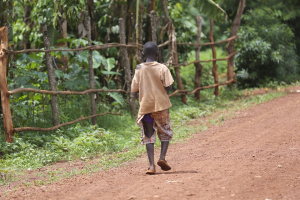
Finally, it is important to examine empowerment on the societal level. Empowerment is concerned not only with a psychological sense of control but also with the equal distribution of resources, attention to material, and political empowerment on the societal level (Nelson, & Prilletensky, 2010). Even if empowerment interventions are carried out at other levels, they typically must take broader, more structural societal forces into account. These forces include the impact of systemic racism, sexism, homophobia, ableism, ageism, or classism over time. Societal empowerment concerns processes and structures affecting the empowerment of individuals, organizations, and communities (for more information on inadequate resource distribution from Habitat for Humanity, click here). An important consideration is to what extent a society fosters equity, or the equal distribution of resources and opportunities, while providing support to those who have less than their fair share of resources.
An empowering society is one that works to distribute resources equitably as well as effectively. Policies and practices that support such equity are critical, as are the voices of individuals, organizations, and communities. Society-wide empowerment is concerned with how well key components of society work, so that everyone has adequate resources. Moreover, society must use resources wisely to address its needs in cultural, governmental, political, business, educational, health, and other major areas of community living. Societal empowerment may take the form of communities supporting and influencing one another and of communities working to promote change in public policy at the state and national levels. Societal empowerment also includes a society’s capacity to influence and work with other societies and to manage its own resources effectively. Empowered societies can take care of themselves. They can work with and influence other societies. They can create positive change with their neighbors and others around the world. In short, many societies face the challenge of helping people who are facing serious limitations in their lives. Rarely, if ever, do these individuals have opportunities to deal with the dehumanizing structures in society that cause such limitations. These challenges are related to histories of oppression, discrimination, or segregation, as well as disparities in income and opportunities that are systemic and very hard to address, as indicated in Case Study 10.4.
Case Study 10.4
Societal Empowerment
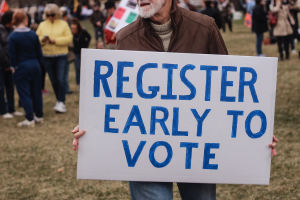
Individuals who experience poverty are often in positions of powerlessness due to their lack of access to necessary resources. In order to address the empowerment of individuals in poverty, societies must develop their critical understanding of the structures that create and sustain poverty. After critical awareness is developed, societies must amend or remove the disempowering structures that have been identified. Empowering people who are experiencing poverty can happen through many different means. For example, addressing workplace discrimination through a legislative action is a step towards creating a more equitable society. Additionally, addressing the barriers to participation in the political system is important to address poverty. People who are impoverished may not be registered to vote. Creating accessible opportunities for voter registration can help to ensure active political participation. On voting days, ensuring that people know they have a right to leave work to vote and providing transportation options is another way that societies can support the empowerment of people experiencing poverty.

As discussed throughout this textbook, some groups often use their power to accumulate privileges over the groups they oppress. This oppression happens with dehumanization and exploitation, as discussed in Chapter 9 (Palmer et al., 2019). Oppression may occur on any level from individual to societal. It also has a psychological piece. Those in power oppress individuals and groups by reducing their opportunities for education, work, housing and health care. Then those on the receiving end of this oppression may take part in negative activity due to feelings of hopelessness and helplessness. In addition to the experience of exclusion and marginalization on a societal level, the problem of oppression is compounded when those oppressed engage in self-destructive patterns due to the internal feelings of hopelessness. For more information on how oppression works on multiple levels, click here.
Unfortunately, conditions of exclusion and disadvantage are often ignored when those individuals with fewer resources try to obtain services. Furthermore, the economic inequality of people of color, people with disabilities, and many other groups in the US and other countries, contributes to their limited access to many services and supports. Economic inequality also limits opportunities for employment, housing, health care, and education. These conditions can only be eliminated by changing unequal power relations and with the redistribution of wealth. Attention to the distribution of power and wealth is consistent with the principles of Community Psychology regarding social justice, respect for diversity, and promoting social change, as discussed in Chapter 1 (Jason, Glantsman, O’Brien, & Ramian, 2019).

According to Paulo Freire (1970), most people who experience social oppression do not necessarily act to change their reality. This is because they have been taught to accept the dominant, or oppressors’, narrative. That narrative has placed them in an inferior position and their oppressor’s in a superior one. Over time, the oppressed come to believe in their inferiority and thereby internalize their oppression. The inferiority is now a part of their identity and affects the actions they take and the decisions they make in life. In turn, their acceptance of an inferior position in society enhances the dominance of their oppressors. Freire also argues that marginalized individuals do not have a critical awareness that allows them to see the injustices in their lives. They tend to be passive and unable to recognize their own capacity to transform their social realities, in part, because their condition of marginalization and oppression keeps them in a state of helplessness. Someone forced to the margins of society who lacks critical awareness may accept their low position. They may see it as the result of fate, bad luck or supernatural forces. This is why helping people develop critical awareness and understanding of the factors that contribute to their situation is an important early step in the process of empowerment. Once people understand the reasons for their situation and the importance of taking action(s) in order to address their own problems, the process of empowerment has begun. An example of an oppressed group, in this case children, becoming empowered through participatory means is illustrated in Case Study 10.5
Case Study 10.5
School-Based Participatory Action Research
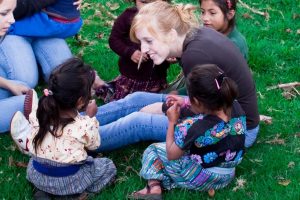
One of the ways in which critical awareness can be developed is through participatory action research. This is a method of research that allows stakeholders to play an active role in determining, assessing, evaluating and addressing a problem. Dworski-Riggs and Langhout (2010) used a participatory action research project in an elementary school to address disciplinary issues during recess. Based on a school survey, multiple stakeholders identified recess as a time in which students had more negative relationships with other students and recess staff. One of the ways in which the issues at recess were addressed was through a peer mediation program. A group of students was trained to resolve conflicts on the playground. This peer mediation program gave students increased control over recess time, as well as increased skills in conflict resolution. Additionally, it empowered the students to meet with the recess staff in order to determine how they could work together more effectively. The researchers did face significant challenges in engaging parents in active participation in the creation and implementation of the intervention. Based on a school climate survey, most parents felt powerless to make changes within the school. However, the students did engage in the process and were satisfied with the outcomes.
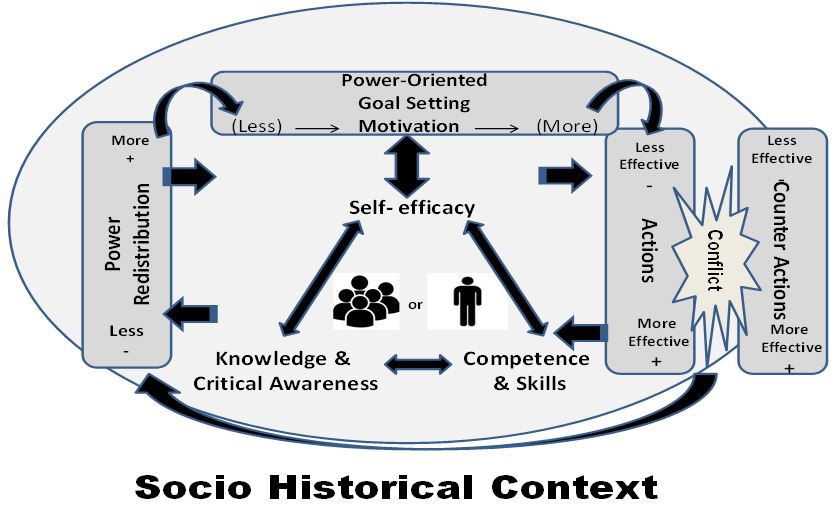
Balcazar and Suarez-Balcazar (2017) offer a model of empowerment that is a framework of analysis for the struggle in the redistribution of resources in a historical context (see Figure 1 above). The model can explain some of the factors that lead people to seek power redistribution, and a redistribution of power is needed to give people the resources necessary for the empowerment process. From this model, it is possible to propose specific strategies that can be used to promote empowerment on the levels we discussed earlier in the chapter. This process is explained further in Case Study 10.6 below.
Case Study 10.6
A Personal People First Story
The empowerment process starts when the individual identifies an injustice that she or he has experienced. Joe grew up in a rural town in Missouri to a family with few economic resources. He was born with Down syndrome, and from his earliest memories recalled being stared at, whispered about, laughed at, and treated differently. In an effort to help him, his parents would always decide what was best for him and advocate on his behalf at school and in the community. When Joe tried to speak up and express himself he was either ridiculed by his peers or defended by his parents. As a result of these experiences growing up, Joe felt disempowered and defective. But, he resolved later in life to find others like him and see if he could do anything to change things for people like him. Joe became aware of historical inequalities, injustices, and grievances that have not been attended to, such as the mistreatment of people with disabilities in his rural town. Joe began to network and organize with other people with disabilities, and expanded beyond those with Down syndrome to include other people with disabilities. He recalls being shocked at the number of people he met while trying to form a support network. While networking and researching, he discovered the People First movement, which was formed to promote the sharing of ideas, cultivate independence and friendship, and advocate for people with disabilities. Joe was taken with the ideals of the movement, proudly saying, “We can speak for ourselves, thank you!” By organizing a new chapter of People First, Joe and his peers were able to create advocacy goals to change how they were being mistreated and marginalized in their community.
As shown in Balcazar and Suarez-Balcazar’s (2017) Empowerment model, goals are developed regarding what is desired in a particular situation or context. There are different degrees of motivation associated with the individual’s goal, depending on the circumstances and sense of urgency.
According to this empowerment model, there are several factors that determine the degree of effectiveness of the individual or group in seeking power redistribution. In the case of Joe and his People First chapter, they were a dedicated group committed to influencing the community on multiple levels. They began to petition the local government to offer special accommodations for people with physical disabilities, such as wheelchair ramps and accessible seating on public transit. And, near and dear to Joe’s heart, they advocated for “People First Language Days,” at the local grade schools and high schools. Joe wanted to change how people viewed and talked about disability, to ensure that kids growing up with disabilities were not ridiculed and picked on. Joe thought that if students had more of an awareness of what it’s like to live with a disability, and how hurtful words can be, then attitudes and treatment of people with disabilities might start to change. He wanted members of the community to view him and others like him as “people first, disability always second. Like any other card normal folks have been dealt, it’s just a part of who we are. But we’re just people.” Joe and the People First chapter were successful in their efforts to implement People First Language Days at the schools, and even started having language days in places of business and legislation. Their group possessed factors necessary to implement meaningful change and empower not only themselves but many others like them in their community. These factors included knowledge of rights and responsibilities, level of skills and degree of self-efficacy (as well as the result of cumulative experience, challenges, and successes) in attaining personal and group goals.
What can be unexpected when working in Community Psychology are the counteractions taken by the opposing individual, group, or organization. There were some people in Joe’s town who opposed using taxpayer funds to increase accessibility for people with physical disabilities. Some educators questioned the need for having time taken from their classes to educate students on People First language. Sometimes the individual or group runs out of options, exhausts their resources, or gets demoralized and concedes defeat. There is no guarantee that the process will result in greater power to the aspiring individual or group. It takes time to empower oneself and to empower a group of people, and there may be setbacks before achieving meaningful power redistribution. The resulting changes in power redistribution may stop the process if the parties are satisfied, meaning the person or group aiming for empowerment feels they have achieved their goals. At some future point, the parties may resume the process in order to pursue better results.
As mentioned earlier, the Women’s Movement of the 1950s and beyond led to great strides for women in America, and the “Me Too” movement is another call for women to receive fair treatment and justice in society. Balcazar and Suarez-Balcazar’s (2017) Empowerment Process Model is cyclical, meaning individuals or groups may seek more knowledge or advocacy training or critical awareness of the members in order to succeed. The individual’s sense of efficacy is affected by the degree of success in conducting these efforts over time, which in turn can lead the person to try to seek empowerment in other situations.

Along with the empowerment model presented here, individuals may use a variety of strategies to address power imbalances (Fawcett et al., 1994). These strategies can help reduce or eliminate barriers, develop networks, and educate others in the community (see Practical Application 10.1). They can also create opportunities for capacity building and allow participants to advocate for changes in policies, programs, or services. To promote empowerment at the environmental and societal level, it is important to examine national, state, and local policies. Many programs and services unexpectedly place barriers and stressors on oppressed groups, such as people with disabilities. Ultimately, empowerment efforts are directed at promoting social justice. The strategies highlighted in this chapter can serve as a guide for individuals interested in promoting empowerment in their communities. It should be noted that there are many tactics that have been used to promote change over time. For example, Sharp (1973) researched and catalogued 198 methods of non-violence actions to promote social change and provided a rich selection of historical examples of the tactics.
Practical Application 10.1
Examples of Advisory Tactics
The tactics below help in thinking about the best approaches to advocacy. Each tactic is supplemented by a real-world example that can help you think of ways to advocate in your community.
Tactics for Understanding Issues
Tactics for Public Education
Tactics for Direct Action
1. Making your presence felt
2. Mobilizing public support
3. Using the system
4. Direction action
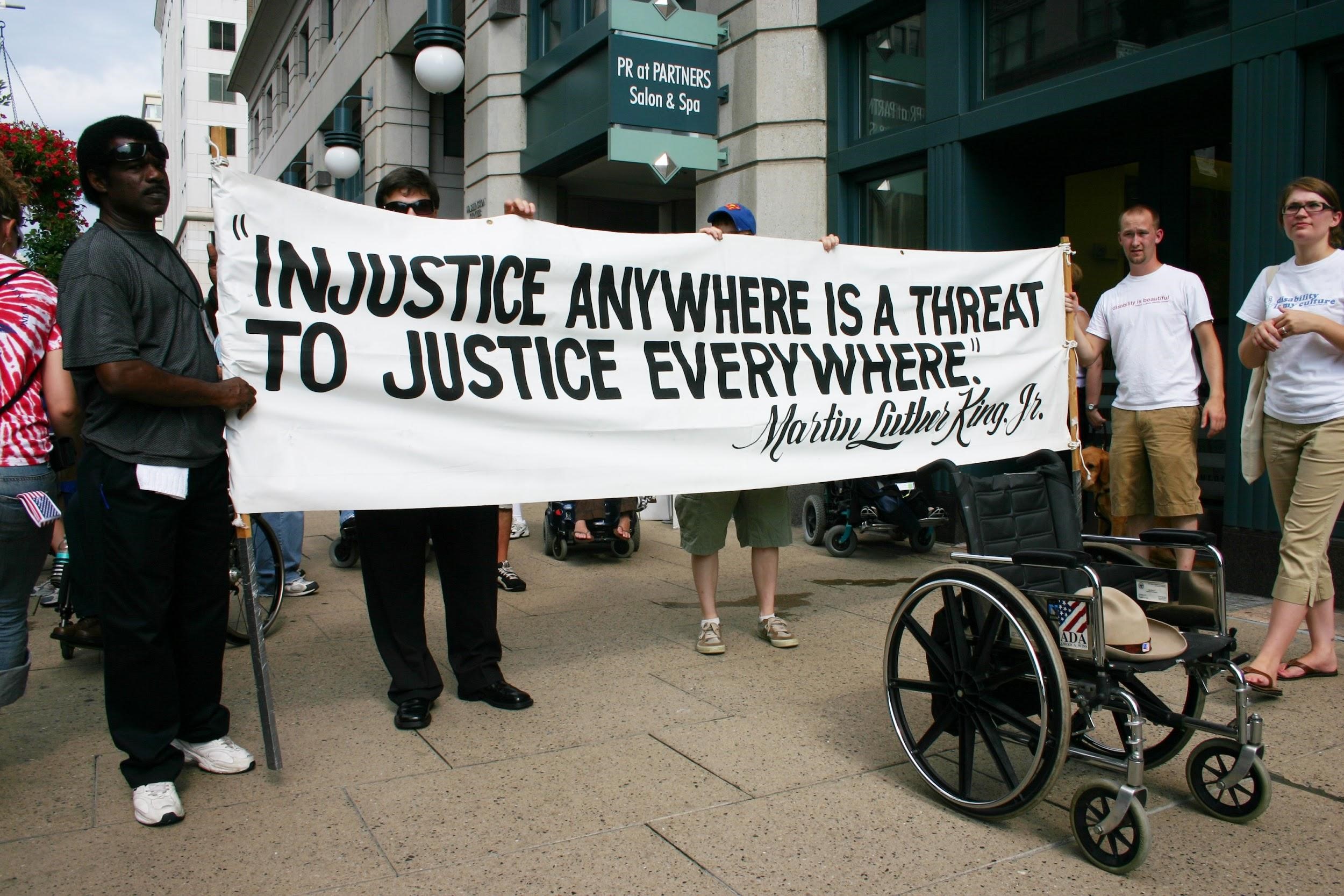
A fundamental principle of Community Psychology is that individuals have the right to live healthy and fulfilling lives, regardless of their ability levels, gender, sexual orientation, race, ethnicity, income, or other characteristics. A person’s well-being depends on personal choices and the dynamic interaction between individual and environmental factors. Community psychologists support the most vulnerable groups of society in their quest for justice and equality. We can work with historically oppressed groups as they claim their rights and their own personal and cultural identities. Research and advocacy efforts must continue until full participation in society has been achieved.
Community psychologists are continually working to refine the effectiveness of empowerment and advocacy efforts. In this chapter, we have provided definitions and successful examples of empowerment and identified some of the strategies, predictors, and facilitators in our efforts to achieve power redistribution. Consistent with an ecological approach, community-based participatory research methodologies help us include the voices of historically oppressed groups in our research and advocacy efforts. Partnering with historically oppressed groups allows us to better understand oppression and allows us to work toward developing effective ways in which they can gain power to address their unmet needs. Our goal is to work toward a more fully empowered and empowering society and realize the promise of equity and quality of life for all. This ongoing commitment will continue to propel our social and community change efforts into the future!
Critical Thought Questions
Take the Chapter 10 Quiz
View the Chapter 10 Lecture Slides
____________________________________________________________________
Anckermann, S., Dominguez, M., Soto, N., Kjaerulf, F., Berliner, P., & Naima-Mikkelsen, E. (2005). Psycho-social support to large numbers of traumatized people in post-conflict societies: an approach to community development in Guatemala. Journal of Community & Applied Social Psychology, 15(2), 136–152.
Balcazar, F. E., & Suarez-Balcazar, Y. (2017). Promoting Empowerment among Individuals with Disabilities. In M. A. Bond, C. B. Keys & I. Serrano-García (Eds.) APA Handbook of Community Psychology (Vol. 2, p. 571-585). Washington, D.C.: American Psychological Association.
Bond, M. A., & Keys, C. B. (1993). Empowerment, diversity and collaboration: Promoting synergy on community boards. American Journal of Community Psychology, 21, 37-57.
Cattaneo, L. B., & Chapman, A. R. (2010). The process of empowerment: A model for use in research and practice. American Psychologist, 65(7), 646–659.
Dworski-Riggs, D., & Langhout, R. D. (2010). Elucidating the power in empowerment and the participation in participatory action research: A story about research team and elementary school change. American Journal of Community Psychology, 45(3), 215-230.
Fawcett, S. B., White, G. W., Balcazar, F. E., Suarez-Balcazar, Y., Mathews, R. M., Paine-Andrews, A., … Smith, J. F. (1994). A contextual‐behavioral model of empowerment: Case studies involving people with physical disabilities. American Journal of Community Psychology, 22(4), 471–496.
Foster-Fishman, P. G., & Keys, C. B. (1997). The person/environment dynamics of employee empowerment: An organizational culture analysis. American Journal of Community Psychology, 25(3), 345-369
Freire, P. (1970). Pedagogy of the oppressed. NY: Continuum Publishing Company.
Jason, L. A., Glantsman, O., O’Brien, J. F., & Ramian, K. N. (2019). Introduction to the field of Community Psychology. In L. A. Jason, O. Glantsman, J. F. O’Brien, & K. N. Ramian (Eds.), Introduction to Community Psychology: Becoming an agent of change. Retrieved from https://press.rebus.community/introductiontocommunitypsychology/chapter/intro-to-community-psychology/
Keys, C., McConnell, E., Motley, D., Liao, C., & McAuliff, K. (2017). The what, the how, and the who of empowerment: Reflections on an intellectual history. In M. Bond, I. Serrano-Garcia, & C. Keys (Eds.). APA Handbook of Community Psychology: Theoretical Foundations, Core Concepts, and Emerging Challenges (Vol. 1). Washington, D.C.: American Psychological Association.
Laschinger, H. K., Finegan, J., & Shamian, J. (2001). The impact of workplace empowerment, organizational trust on staff nurses’ work satisfaction and organizational commitment. Health Care Management Review, 26(3), 7-23.
Masterson, S., & Owen, S. (2006). Mental health service user’s social and individual empowerment: Using theories of power to elucidate far-reaching strategies. Journal of Mental Health, 15(1), 19-34.
Maton, K. (2008). Empowering community settings: Agents of individual development, community betterment and positive social change. American Journal of Community Psychology, 41, 4-21.
Nelson, G. B., & Prilleltensky, I. (2010). Community Psychology: In Pursuit of Liberation and Well-Being (2nd ed.). Basingstoke, UK; Palgrave Macmillan.
Palmer, L., Ferńandez, J. S., Lee, G., Masud, H., Hilson, S., Tang, C… Bernai, I. (2019). Oppression and Power. In L. A. Jason, O. Glantsman, J. F. O’Brien, & K. N. Ramian (Eds.), Introduction to Community Psychology: Becoming an agent of change. Retrieved from https://press.rebus.community/introductiontocommunitypsychology/chapter/oppression-and-power/
Peterson, N. A., & Zimmerman, M. A. (2004). Beyond the individual: Toward a nomological network of organizational empowerment. American Journal of Community Psychology, 34(1), 129–145.
Rappaport, J. (1981). In praise of paradox: A social policy of empowerment over
prevention. American Journal of Community Psychology, 9(1), 1-25.
Sharp, G. (1973). The Politics of Nonviolent Action (3 Vols.) Boston: Porter Sargent.

Chapter Eleven Objectives
By the end of this chapter you will be able to:

Many older people live alone, as is the case with Antonia. Since her husband died, Antonia has been living on her own in a small apartment in the Triana neighborhood in Seville, Spain. Due to problems with her mobility, she barely leaves her home and needs help to clean her house and make food. She misses having company over to chat and hang out with. She is also afraid of falling or having an accident and is worried there is no one who can help her. A neighbor told Antonia that the University of Seville now offers a service where a student from outside the city can live with her during the academic year, in exchange for housing. Antonia decided to join this special Community Psychology oriented program and was very happy that the student could help her with household chores and accompany her on a day-to-day basis.
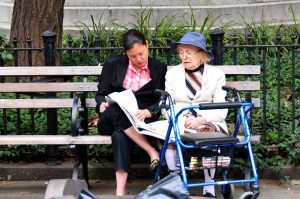
The Community Service of the University of Seville in Spain has developed this community intervention program that matches university students with those who need services, including the elderly, people with disabilities, and single mothers. With this program, students receive free housing in exchange for providing company to the people with whom they live. They are also expected to help out with small domestic tasks and provide assistance to their hosts. The program is based on models of social support and mutual help. The university helps by matching students with those who need these resources, but also provides training, guidance, and ongoing monitoring to ensure that both parties benefit from the program. By being involved in this exchange, the students develop empathy, caring skills, and communication competencies, all attributes necessary to build strong communities. The evaluation of the program has shown improved perceptions of available social support and improved psychological well-being among participants. This program is an example of a successful community intervention.
In general terms, community interventions refer to actions that address social problems or unmet human needs, and take place in a neighborhood, community, or other setting. A community intervention is, therefore, an intentional action to promote change that can be expressed in different ways depending on the needs of the community. One type of program is a more traditional type know as a professionally-led intervention; it involves a program planned and implemented by professionals. For example, a mental health practitioner could have visited Antonia in the example above and provided her medications to relieve her depression. A second type of intervention aligns more with the spirit of Community Psychology, in that it uses approaches of both participation and collaboration, called a grassroots intervention. This second type of community intervention involves bringing volunteers into the homes of people like Antonia, and working together to develop and provide the social support intervention. These types of programs often have recurring themes of prevention, social justice, and an ecological understanding of people within their environments that were described in Chapter 1 (Jason, Glantsman, O’Brien, & Ramian, 2019). Below we will describe in more detail the methods utilized during the development and implementation phases of both traditional and participatory community interventions.

The first of the two types of interventions involves developing and implementing a program in a more traditional style, with a mental health professional designing and implementing the intervention. For example, a psychologist can teach a group of teenagers positive social skills so that they can confidently and voluntarily say “no” to their peers when they are encouraged to consume alcohol or other substances. A second type of intervention involves a participatory approach. For example, imagine security problems are affecting your neighborhood, and you meet with a group of neighbors to address how this issue is impacting your community. Instead of implementing preconceived and predesigned activities (e.g., the educational materials in the traditional example above), everything is decided in collaboration with the neighbors through active citizen participation. The intervention emerges as neighbors establish objectives (i.e., what problems they want to solve in the neighborhood) and decide what actions they can carry out together. The case study below shows how important citizen participation is for solving community problems.
Case Study 11.1
The Rochelambert Lot and Grassroots Organizing

A grassroots movement of residents in Rochelambert, a neighborhood of Seville, formed when the city council and a company announced the construction of a private parking lot in their community. One of the neighborhood leaders explained: “Here we have 300 parking lots on the surface and the neighbors did not see the need to build a parking lot. The town hall and a promoter decided to build an underground car park, together with a building, without consulting the neighbors. We did not see the need, because, in the end, we would pay for a parking space in a place where we already had parking. So we organized ourselves. With the participation of the community presidents in each block we coordinated; each neighbor began to pay one euro per month for the expenses of posters, travel and lawyers; as we thought that the cranes would come at dawn, we made patrols during the night … The press echoed and we were clear that this battle was going to be won, that things are not imposed … I think it was important to have people in the neighborhood who had experienced the transition from dictatorship to democracy and knew the importance of political participation. The fight lasted five months, and in the end we managed to stop the parking lot. Since then we maintain friendship, because that united us a lot.”
These types of bottom-up activities or grassroots movements are going on all the time, and it is our challenge to identify and work with these groups to promote behavioral change in defined community contexts so that social problems can be addressed. Community Psychology emphasizes the importance of community participation as a key process that improves preparation for change, contributes to community organization, and facilitates the implementation of collective actions, as the next case study below also illustrates.
Case Study 11.2
Participatory Research with Fishing Communities

The mouth of the Guadalquivir River is part of a “hotspot of biodiversity” in southern Europe, where fishermen make their livelihood. As there were certain areas of the river that were being overfished, there was a need to address this problem. In a study with fishermen in the area, we analyzed the social networks that connect them, exchanging social support and information about the marine environment (Maya-Jariego, Florido, Holgado & Hernández, 2016). In a later meeting, the fishing communities decided, in a participatory way, on a series of actions that they would carry out in order to conserve the fishing resources of the area. The information on the networks among the fishing community served to reflect on the preferred fishing areas of different groups of participants in the fishing community. Having an overview of the area allowed them to detect the fishing grounds that were being over-exploited so that they could self-regulate fishing practices.
In this case study, the involvement of fishing communities in the management of fisheries was essential for the effective implementation of quota policies as well as restrictions on permitted types of fishing. More information on these types of participatory approaches is available at Research for Organizing, which shows you how to use very practical toolkits for developing action efforts to solve community problems.
In the next section, we will show the importance of designing effective programs, or programs that actually work. Programs that are designed to work effectively are called “evidence-based,” meaning that prior research has shown that these programs are successful in what they are intended to do. Another essential feature of community interventions is that they are implemented interventions to meet the needs and interests of the community. We will show how the outcomes of the intervention depend, in part, on the degree of readiness for change in the community. This means that the community members are generally excited about the intervention and committed to seeing the program through. Finally, community interventions are implemented successfully when the community psychologists have the necessary skills and abilities to work collaboratively with community members to make effective, long-lasting changes.
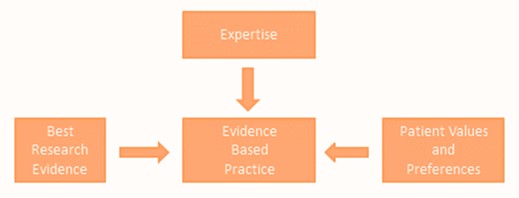
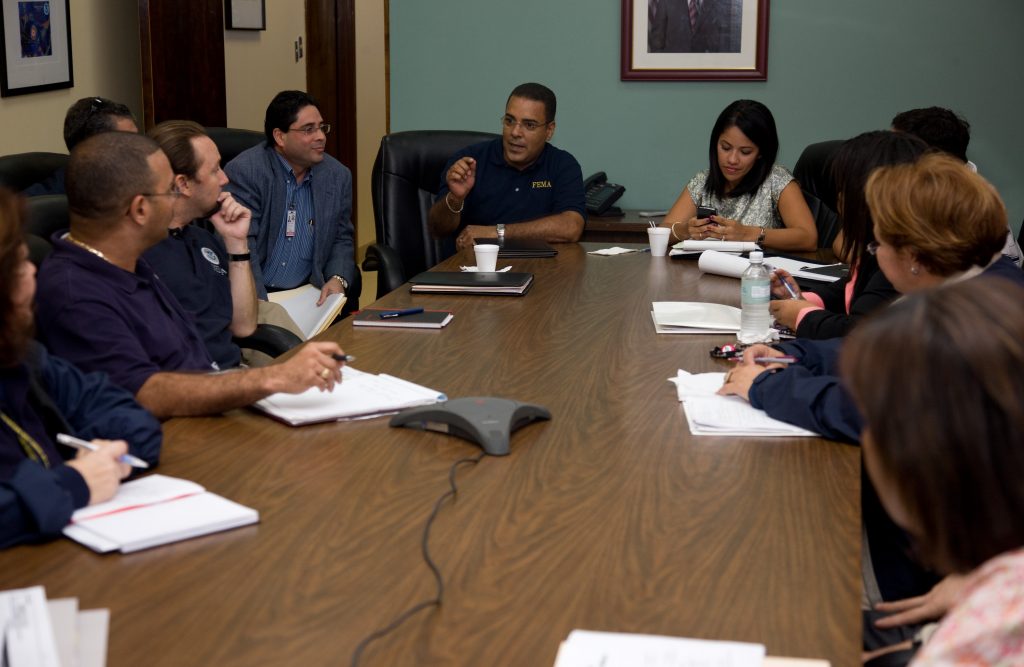
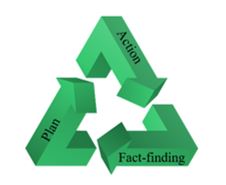
The logic of effectiveness is strongly rooted in the tradition of Kurt Lewin’s (1946) action research. His work involved improving intergroup relations and preventing discrimination, and it helped us understand the importance of using solid research methods and outcome studies to support our work. The key for improving effectiveness is to base programs on previous research evidence and to apply strategies of further research to support the effectiveness of the program. The sequence of planning—action—fact-finding is a learning cycle based on experience. In the first step, the theory guides our action. In the second step, we then implement the intervention. In the third and last step, evaluative research is used to check the effects of the action. However, the intervention does not end there because the results can change the way we think about how we might develop even more effective interventions to solve problems in the future. Community psychologists constantly repeat these three steps to gain more data to improve the effectiveness of their interventions.
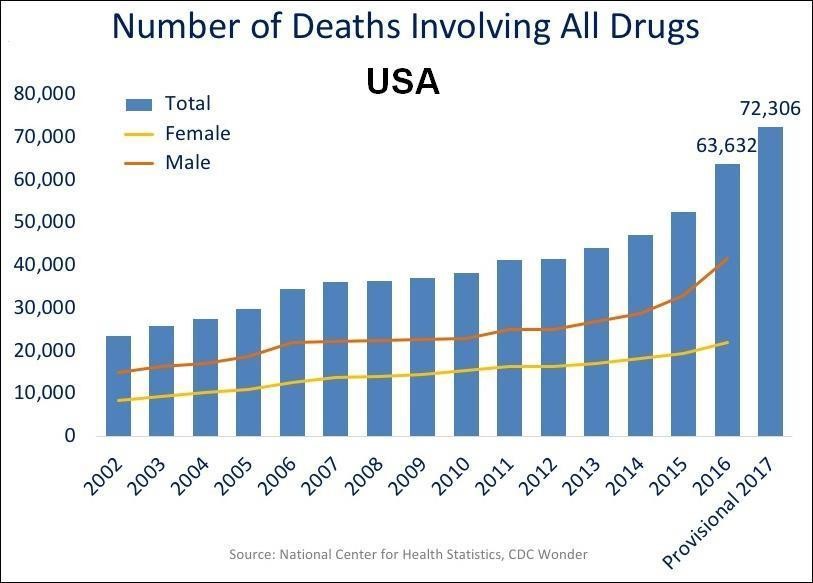
Let’s look at this approach with a specific case. The prevention of drug abuse is important, as thousands of people die each year from addiction. Research has shown that the majority of adults with drug abuse problems start using when they are teenagers, are subject to social peer pressure, and are exposed to negative behavior models in their immediate family and community environment. In addition, a growing number of studies over decades showed that specific programs are effective in overcoming these issues (Griffin & Botvin, 2010), and the results of one program led to even more effective and comprehensive programs. These types of prevention programs have multiple components including providing skills to resist attempts at social influence, improving communication in the family, and reducing adolescents’ access to drugs. Prevention programs at school have provided youths training in social skills to resist peer pressure, raise self-esteem, and reduce favorable perceptions about substance use. In addition, interventions with parents aimed to improve family communication and the establishment of rules against using drugs. Finally, community prevention efforts have confronted larger scale ecological factors, such as the media that often promote alcohol, tobacco, or illegal substance use. In this case, it is important for an intervention to use many of these strategies together, with comprehensive actions being developed through community coalitions. The following case study is an example of community psychologists working on multiple ecological levels when implementing a prevention program.
Case Study 11.3
A Community Intervention to Decrease Adolescent Tobacco Use

Kaufman, Jason, Sawlski, and Halpert (1994) launched a community intervention to decrease the number of new smokers, particularly focusing on African American adolescents. The preventive intervention combined a school-based curriculum with a media campaign. A total of 472 elementary schools provided students with a smoking prevention booklet, while the media campaign reached out to the broader community. A widely distributed local newspaper included parts of the curriculum on their weekly children’s page. A local radio station, with over a million listeners, aired a call-in talk show focusing on better parent-child communication about smoking. The station also aired anti-smoking public service announcements and promoted a smoking prevention rap contest for school children. Winners from five age groups had their raps aired, and the overall winner was a guest DJ. Additionally, owners of approximately two hundred billboards sponsored a contest in which children developed posters conveying anti-smoking messages, and winning posters from each of the five age groups were displayed on billboards. Participants for this preventive trial were randomly assigned to groups that either received the school-based curriculum or did not. However, both groups were exposed to the media messages and over 90% of the students indicated that they listened to the radio program on a regular basis. Smoking significantly decreased over time for students in both groups. But only those students provided with the school curriculum plus media campaign reported reading significantly more of the newspaper content and substantially increased their knowledge about the dangers of smoking, compared to the student group only exposed to the media campaign.
In the case study above, the intervention effects demonstrated the merit of community-wide, comprehensive preventive interventions. As demonstrated, Community Psychology interventions are based on the scientific understanding of the problem (e.g., drug abuse), with an empirical analysis of risk and protective factors. Secondly, the interventions keep in mind the changes that need to be achieved in the community, aiming to consider the ecological levels that were discussed in Chapter 1. As indicated earlier, these interventions also bring in the active participation of community members in planning and implementing the programs.
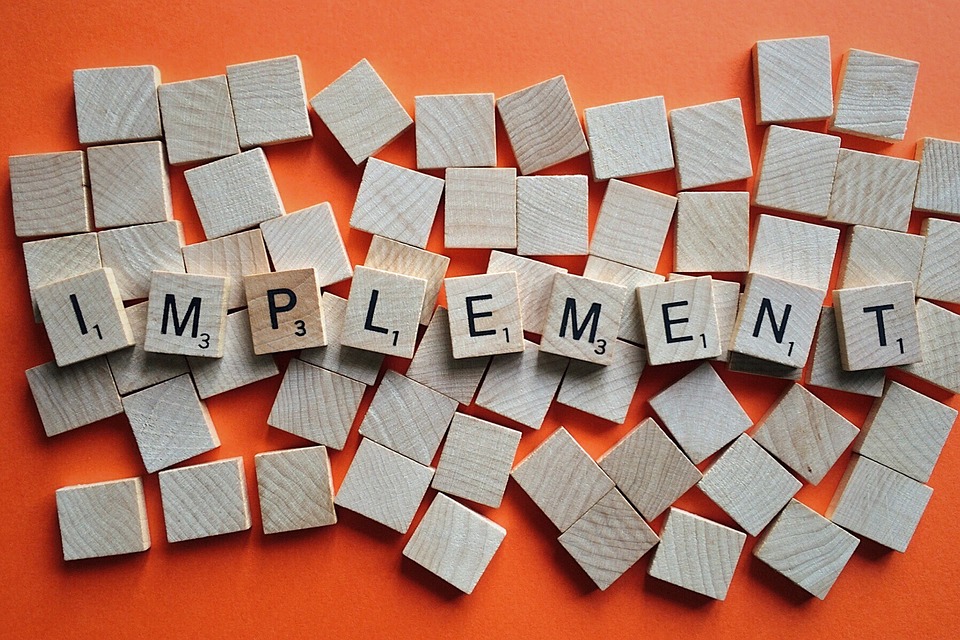
What do we mean by implementation? As mentioned above, having a good community intervention depends on how well the program has been designed and tested out to be effective. It is also important to keep in mind how ready or interested the setting or people are in the intervention because if the community does not really want the program, it is very unlikely to be accepted or used by the community members.
Case Study 11.4
A Classroom Exercise and Lessons in Implementation

One high school teacher performed an interesting exercise with his students in a class. First, he inserted cotton in a transparent bottle. Next, he lit a cigarette and placed it so the smoke entered the bottle. After a while, the students could see that the cotton had blackened and retained a part of the tar and other harmful elements of tobacco. In a simple way, this showed the effect of smoking on the lungs. When adolescents are informed about the negative health consequences of smoking, they may be less likely to use tobacco. However, the achievement of good preventive results with this group of adolescents does not only depend on having clear intervention ideas, such as the demonstration of the cotton in the bottle but also enlists the help of the students and teachers in changing the social pressures to smoke. It also involves the larger community including the media, such as in case study 11.3. Furthermore, it is important to have the groups actively invested in the program, and this can occur when they participate in the design and implementation of the intervention. In part, the success of the intervention also depends on when and where this activity will occur during and after school; these type of factors influence how well the program is implemented.
In Case Study 11.4, we are focusing on community dynamics—a critical factor that is often forgotten when interventions are developed. By considering the community dynamics when implementing an intervention, this helps shape whether the intervention should be more traditional, with an expert delivering a packaged prevention program, or more in line with the spirit of Community Psychology, where community partnerships actively bring those voices into the design of the intervention.
Theory is an important aspect when community psychologists develop and implement ecological community interventions, but there is more that is needed to make long-lasting changes. Other critical areas involve the skill levels and knowledge of those who implement the programs, the interest and readiness for the intervention among the community members, and the availability of the needed resources required by the intervention. We can illustrate these points with the example of smoking, which was reviewed in Chapter 1. If you can believe it, there was a time when commercials had physicians endorsing tobacco use (see the video on physicians endorsing tobacco in Chapter 6; Stevens & Dropkin, 2019)! In the 1940s and 1950s, few people thought that tobacco use was harmful. It was not until tobacco use and its effects were studied for years that public perception, and then policy, were changed. Over the past 50 years, there have been significant reductions in smoking in the US (Biglan & Taylor, 2000). This reduction was due to evidence gathered over time on the consequences of tobacco abuse, which helped change people’s opinions about smoking.
Communities may vary in the degree of awareness to a specific social problem, as few were willing to address tobacco use as a problem before the 1960s. With the Surgeon General’s report, the public began to view tobacco as a harmful social problem. This shows that, in practice, some communities may be more or less prepared for changes. That is why the degree of “community readiness” often determines whether our community interventions will be effective. From this perspective, implementation is a key process: since it is not enough to design effective programs, it is also necessary to attend to the factors that make the desired social change possible.
Case Study 11.5
The Importance of Public Awareness in Prevention Efforts
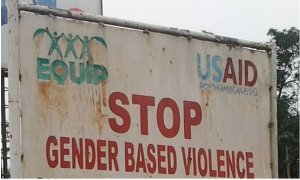
Investigators have tried to prevent intimate partner violence in different Latin American countries. In one of the countries, there was frequent debate on television about gender-based violence, and this led to several organizations advocating for greater protection of women. In another country, there was little publicity or awareness of these types of issues, and there was not the same type of organizational advocacy. In other words, the issue was not publicly discussed nor were there organizations promoting community awareness of this topic.
In the above case study, the level of community readiness was high in the first country but low in the second, which led to more intimate violence prevention programs being launched in one country than the other.
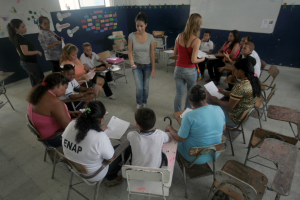
Let’s go back to the above cases 11.3 and 11.4 showing tobacco prevention to again illustrate the importance of community readiness and successful implementation. The “Communities That Care” program well represents this concern for awareness of community contexts and the implementation process (Oesterle et al., 2015). This is a Community Psychology program that aims to reduce drug dependency, criminal behavior, violence, and other harmful behaviors among adolescents. The program is often initiated through a local community coalition, in which different organizations collaborate to develop united action for preventive purposes. This means that adolescents receive a consistent message from different agents of the community and are exposed to social norms that promote healthy habits. In addition, these community agents participate in choosing the evidence-based practices that will be implemented. Accordingly, they are jointly responsible for both the actions that are carried out and the introduction of adjustments to adapt them to the specific characteristics of the community. Finally, it is important that preventive actions have the intensity, continuity, and dose necessary to have the most significant impact in the community context. Dose refers to the number of sessions or the duration of a program and influences the level of results we can achieve. For example, we cannot expect one social skills training session to have the same result as a longer semester-long program. Just like a muscle, the more these programs are exercised, the stronger they are. Thus, beyond the quality of the programs, how the community supports the idea and helps to carry it out affects how the program is applied on multiple levels in the community. The application of the Communities that Care program in neighborhoods has been found to reduce the overall consumption of alcohol, cigarette, and smokeless tobacco, as well as delinquent behavior. This video link provides more information about the Communities that Care model and its effectiveness.
In Figure 3, we have summarized some of the key factors in the implementation process when trying to prevent alcohol abuse.
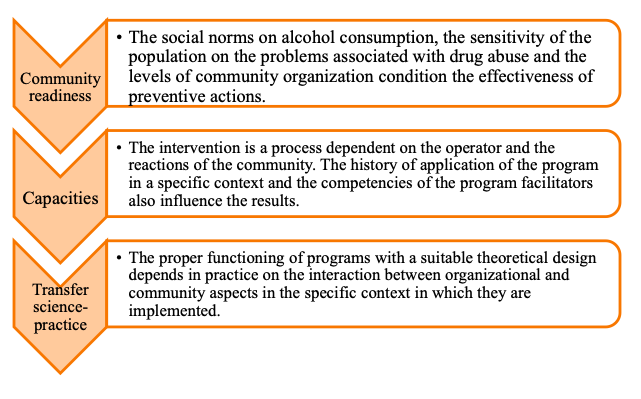
When we seek to address problems through community interventions, we discover the importance of the environment and potential community partners (Shinn & Toohey, 2003). In other words, we need to understand the context, or the neighborhoods and community settings, within which we place the community interventions. We can illustrate this with the following examples involving refugees and the approaches of several countries in dealing with this issue.
In Colombia, displaced persons can access housing when they flee political violence. However, this often places them in a segregated space where they share their day-to-day lives with other people who also suffer from post-traumatic stress. This also occurs in Spain with incoming refugees, who are received in publicly owned “reception centers” that cover their basic housing, food, and health needs. They can also access language courses, workshops to improve employability, and other programs that aim to ease their integration into a new country. However, only a small percentage of the residents in the reception centers are actually able to find work in Spain. Consequently, refugees have not been able to take advantage of the provided psychosocial resources. The case study below illustrates what needs to be taken into consideration when designing effective community interventions.
Case Study 11.6
The Importance of an Ecological Lens: A Family Seeking Asylum

The Patatanian family arrived in Madrid from Armenia, fleeing the harassment they suffered for religious reasons. They were received in the center of asylum seekers and provided accommodation and food. The parents received Spanish classes and made some contacts to learn about the labor market in Madrid while waiting for their case to resolve. Their children joined a school and, despite some difficulties adapting to a new country, made friends and did well enough academically. However, after nine months in Spain, they received a notification that the government did not recognize their refugee status. Consequently, although the Spanish teaching and employment guidance programs were well designed, the legal situation prevented the integration of the Patatanian family in Spain by not providing them the ability to apply for jobs. This resulted in the programs not achieving the objectives they were designed to meet.
The family, however, was fortunate to have another chance for a better life. Shortly after their experience in Spain, they decided to try again in Canada, where they were welcomed with not only the classes and resources but also the opportunities to fully participate in the workforce. The family members learned French and integrated very well with the community of Armenians living in Montreal. They also became friends with some neighbors and, little by little, could normalize their lives and find employment.
The case study of the family above shows why community interventions often need to transcend the individual level and deal with higher ecological levels. That is, it is about introducing deeper, second-order changes such as providing employment opportunities, that can have a more lasting and sustainable effect on individual behavior.
Let’s take child labor as another example. Child labor is a worldwide problem, affecting a large number of developing countries. It has a very negative impact on the cognitive, affective, and social development of the child. Programs can be developed that promote self-esteem, train social skills, or reinforce academic motivation. But, an effective intervention program also needs to focus on the children’s environment. If parents need to have their children work at very young ages to support the family as a whole, community psychologists need to take this into consideration and possibly find better ways for the parents to earn money so that they do not need to depend on their children to earn money, as illustrated in the case study below.
Case Study 11.7
Edúcame Primero
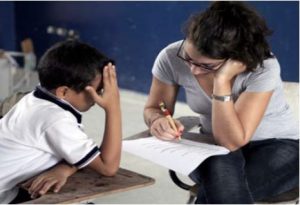
The Edúcame Primero is an initiative that aims to reduce child labor through psychoeducational strategies and community collaboration. Some of the strategies are oriented toward creating safe learning spaces in the school and the involvement of the family in the education of the children, as well as the collaboration with other agents in the community context. A central element of the program is the use of a methodology called Spaces for Growth (SfG): that is, complementary training workshops for formal education that include strategies for facilitating participation and active collaboration for children and young people, as well as their families and the staffs of educational centers. The SfG promote collaboration with different agents in educational and community contexts, namely: teachers, professionals, community leaders, and families. They participate in the design of the workshops, the configuration of the program content, and the adaptation of the program to the characteristics of the educational center. To this end, the involvement of parents, exchange forums with community agents, and regular meetings with staff of the educational centers are organized. Community readiness is evaluated by gathering information on (a) existing resources and key players in the community context, (b) previous experience in the implementation of intervention programs in child labor, (c) the level of awareness about child labor as a problem among community members and (d) the degree of community cohesion around existing needs linked to child labor. Finally, facilitators play a key role in the adjustment to the community context. They are professionals selected on the basis of their capacity for teaching children and young people, their knowledge of the community environments in which the SfG will be implemented, as well as their leadership skills (e. g., abilities for community mobilization). The Edúcame Primero program has proven to be a good practice in the prevention of child labor, with positive results in terms of prevention and reduction of child labor. A video of the Edúcame Primero is available here.
In Latin America, these types of intervention efforts have been developed by international organizations, such as the International Labor Organization (through the International Program on the Elimination of Child Labor), in collaboration with national governments and other third-party entities. In the last two decades, these international organizations have designed and implemented programs that have resulted in the worldwide prevalence of child labor decreasing by about 30 percent. As we can see in the Edúcame Primero example, environmental contexts need to be considered when developing these types of Community Psychology interventions. Figure 4 illustrates the multiple ecological levels of community-based interventions.
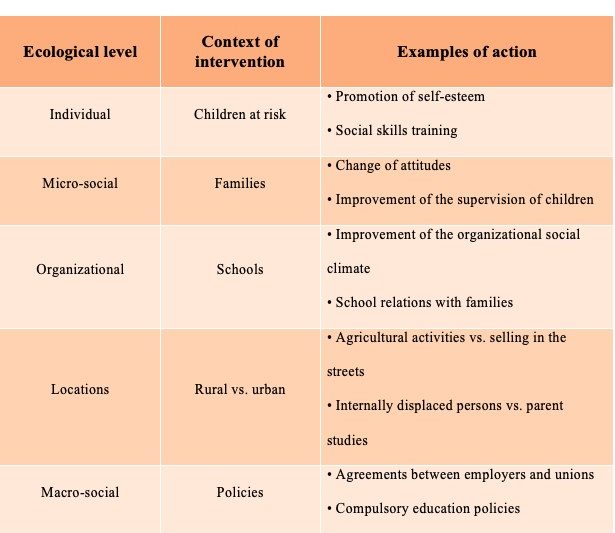
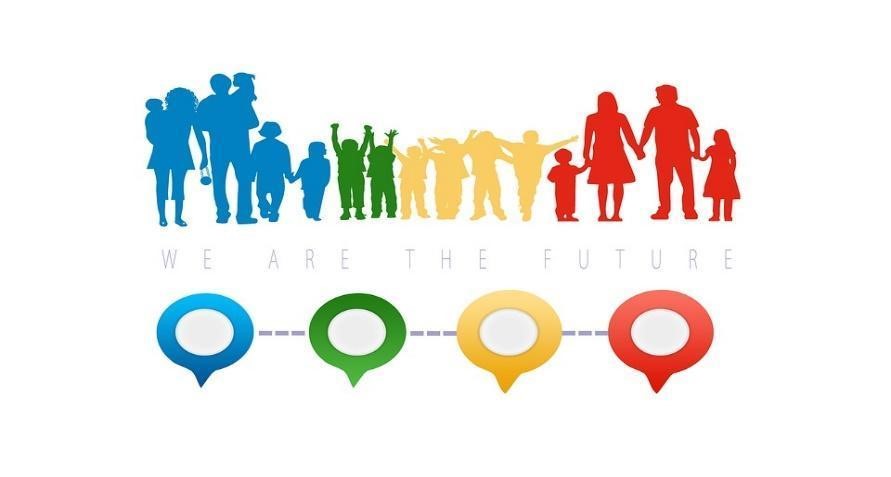
There are many important lessons we can learn from working to develop community interventions. Some of these lessons include the need for using programs that have some evidence that supports them and working collaboratively with the community to be sure that they support and help design the actual program. Community psychologists use good theory and methods with the community members, and this is something that often does not occur with many interventions that are thrust on communities with little input from community members. Active community participation makes it more likely that the intervention is accepted and carried on into the future by the community members.
In summary, community intervention is a planned action aimed at changing behavior in relation to a social problem. Action research consists of a learning cycle based on experience, through which interventions are based on previous theoretical models and in turn, generate new knowledge through the application of programs. Effectiveness is gauged by aiming at obtaining results with the application of evidence-based practices. Implementation should take into consideration the level of community readiness and focus on promoting active community participation.
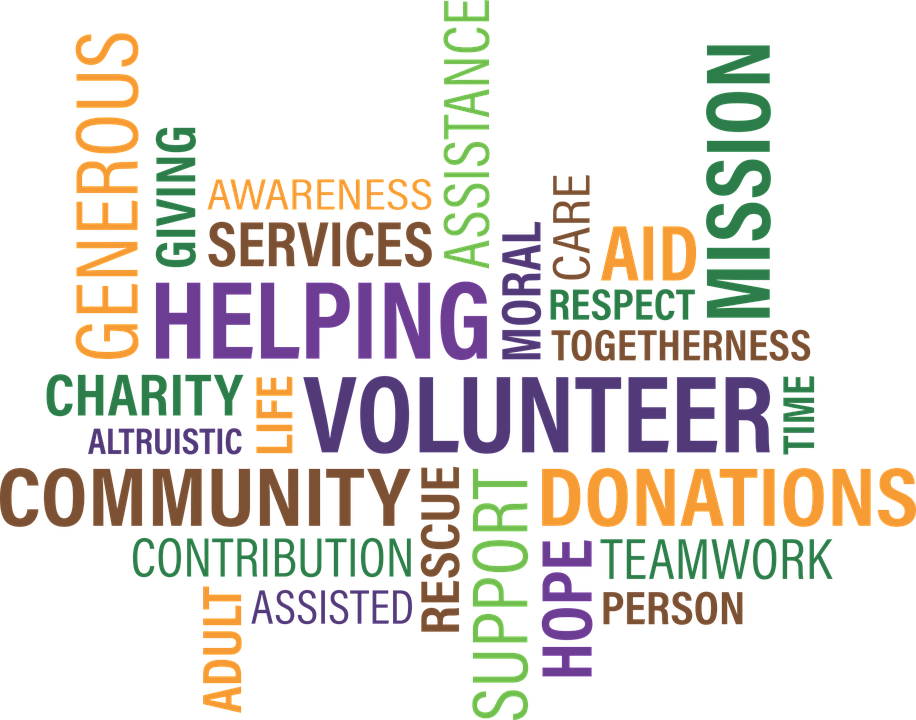
Critical Thought Questions
Take the Chapter 11 Quiz
View the Chapter 11 Lecture Slides
____________________________________________________________________________
Biglan, A., & Taylor, T. K. (2000). Why have we been more successful in reducing tobacco use than violent crime? American Journal of Community Psychology, 28, 269-302.
Griffin, K. W., & Botvin, G. J. (2010). Evidence-based interventions for preventing substance use disorders in adolescents. Child and Adolescent Psychiatric Clinics, 19, 505-526.
Jason, L. A., Glantsman, O., O’Brien, J. F., & Ramian, K. N. (2019). Introduction to the field of Community Psychology. In L. A. Jason, O. Glantsman, J. F. O’Brien, & K. N. Ramian (Eds.), Introduction to Community Psychology: Becoming an agent of change. Retrieved from: https://press.rebus.community/introductiontocommunitypsychology/chapter/intro-to-community-psychology/
Kaufman, J. S., Jason, L. A., Sawlski, L. M., & Halpert, J. A. (1992). A comprehensive multi media program to prevent smoking among black students. Journal of Drug Education, 24, 95-108.
Lewin, K. (1946). Action research and minority problems. Journal of Social Issues, 2(4), 34-46.
Maya-Jariego, I., Florido, D., Holgado, D., & Hernández, J. (2016). Network Analysis and Stakeholder Analysis in Mixed-Methods Research. In L. A. Jason & D.S. Glenwick (Eds.), Handbook of methodological approaches to community-based research: Qualitative, quantitative, and mixed methods, (pp. 325-334). New York: Oxford University Press.
Oesterle, S., Hawkins, J. D., Kuklinski, M. R., Fagan, A. A., Fleming, C., Rhew, I. C., . . . Catalano, R. F. (2015). Effects of Communities That Care on males’ and females’ drug use and delinquency 9 years after baseline in a community-randomized trial. American Journal of Community Psychology, 56, 217-228.
Shinn, M., & Toohey, S. M. (2003). Community contexts of human welfare. Annual Review of Psychology, 54, 427-459.
Stevens, E., & Dropkin, M. (2019). Research methods. In L. A. Jason, O. Glantsman, J. F. O’Brien, & K. N. Ramian (Eds.), Introduction to Community Psychology: Becoming an agent of change. Retrieved from https://press.rebus.community/introductiontocommunitypsychology/chapter/community-research/
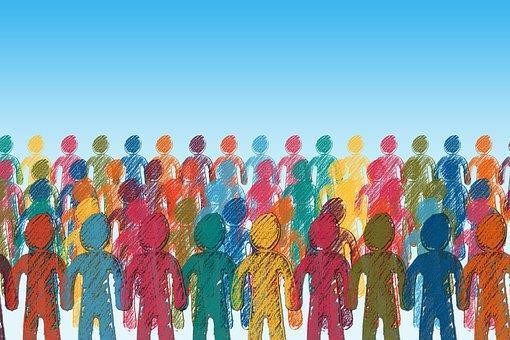
Chapter Twelve Objectives
By the end of this chapter you will be able to:
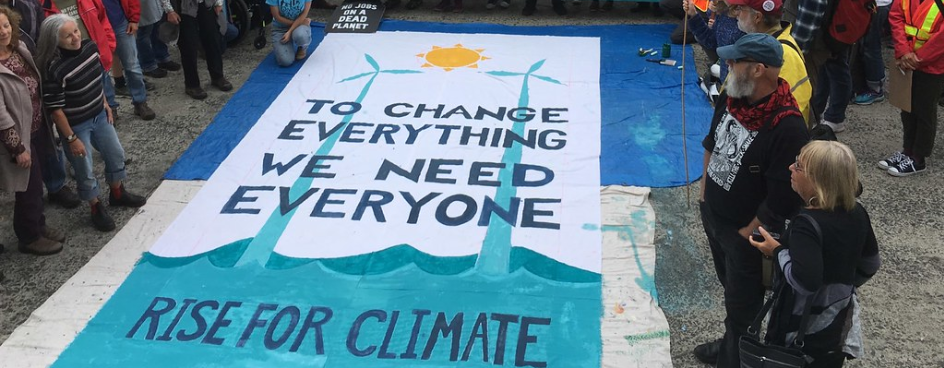
One notable characteristic in the field of Community Psychology is the focus on prevention of problems and wellness promotion, as discussed in Chapter 1 (Jason, Glantsman, O’Brien, & Ramian, 2019). This occurs through addressing individual-level competencies within a community and also through working to change systems and contexts. As highlighted in Chapter 1, prevention serves as an exemplary framework for Community Psychology research and also an innovative way to approach real-world problems. The core belief is that taking action early on can prevent more serious problems from developing in the future. Case Study 12.1 profiles Head Start, an early childhood prevention program for kids aimed to reduce the negative effects of poverty. The case study highlights the way the political and social forces of the time shaped the development of Head Start. This program represents a pivotal tale in the history of prevention, serving as an example of many of the key concepts detailed throughout this chapter.
Case Study 12.1
The Head Start Model

Head Start, an early childhood education program for children experiencing poverty and related stressors, was first established in 1965. Head Start was created in response to President Lyndon B. Johnson’s famous State of the Union address in 1964 where he called for an “unconditional war on poverty” (Watch the speech here). Programs from this era reflected efforts to improve social conditions and prevent the negative outcomes associated with poverty.
The purpose of Head Start programming is to reduce gaps in skills, appearing at kindergarten entry, between children experiencing poverty and their counterparts. These early disparities can continue throughout schooling and into adulthood; therefore, Head Start aims to provide equitable preschool services to improve children’s readiness for entering school. The Head Start model adopts an ecological, whole-child approach and provides comprehensive services to children while promoting the well-being of the whole family that extends beyond academics (watch The Head Start Advantage for a closer look). Head Start involvement has resulted in improved language development, learning/pre-academics, and social-emotional skills of children by the time of kindergarten entry (U.S. Department of Health and Human Services Administration for Children and Families, 2010)
Since its inception over 50 years ago, Head Start has expanded and evolved greatly. See the Office of Head Start’s interactive and detailed timeline. Head Start (and Early Head Start) programs currently serve children from birth to 5 years of age. According to the Office of Head Start, there are Head Start programs across all 50 states and several US territories.
The concept of prevention comes from the field of public health. This is very different from the medical model, which refers to the framework of treating social problems in the same manner that we treat illness. Community psychologists have long been critical of the medical model, given its shortcomings in locating social problems in the individual, which are often rooted in systematic inequalities. This talk describes key distinctions between the medical model and community-based advocacy to address female juvenile delinquency.
Two key aspects of a public health approach to problems include measuring the incidence and prevalence of disease. In Community Psychology, a public health approach requires that the focus is on measuring the incidence or prevalence of a social issue. Incidence refers to the number of new cases during a specified period of time (e.g., the annual rate of new cases of depression among women, the annual rate of new individuals who experience homelessness). Prevalence is the total number of cases in a population (e.g., the total number of women in the population with depression, the total number of people in the population who are homeless in a particular country). Understanding the incidence and prevalence of a social problem is a critical first step to developing a prevention focus.

The 1960s were a critical point in time for the change in focus to prevention, rather than treatment, of individual disease (medical model). As seen in President Johnson’s speech, a focus on prevention was in the spirit of the times. During this point in history, there was a concentrated focus on social inequality and civil rights, the prevention of mental health disorders, and the establishment of innovative prevention programming in the community (e.g., Head Start). This time was not without debates about where to focus resources and how to define social problems. For example, Albee (1983) argued forcefully against the medical model for treating mental illness. That is, no mass disorder that affects large amounts of individuals (e.g., poverty, mental illness, homelessness) has ever been eradicated by providing treatment to each person affected by the problem. Nor is it feasible to train enough professionals (e.g., clinical psychologists) to end a problem (e.g., mental illness) that has roots in deeper social problems such as poverty and oppression. Prevention efforts require an ideology aligned with social change, education, and primary prevention (Albee, 1983).
The field of prevention was somewhat new to many in the field of psychology. The public was also not familiar with this idea as it represented a very different way of thinking about solving problems. As one example, at a psychological convention in 1981, Bob Felner and Leonard Jason, two community psychologists, had a most interesting conversation with Jerry Frank, who was a senior editor at Pergamon, a major book publishing company. What often occurs at these types of meetings is that publishers and authors have discussions about possible book ideas, and Felner and Jason approached Jerry with the idea of an edited book in a new field in psychology. Jerry seemed interested, and then Felner and Jason said they wanted to title the book Preventive Psychology. Jerry looked puzzled and asked them why they would want to prevent psychology. Jerry’s reaction was actually very typical of how many people reacted to this new way of thinking about social problems. Felner and Jason chuckled and said they were not trying to prevent the field of psychology, but rather wanted to provide examples of how prevention could be used to address many problems that psychologists were dealing with such as addictions and school difficulties. Jerry had not thought about this approach before, and after a long discussion, he finally understood the exciting possibilities of this field and agreed to publish the book which was titled: Preventive Psychology: Theory, Research and Practice.
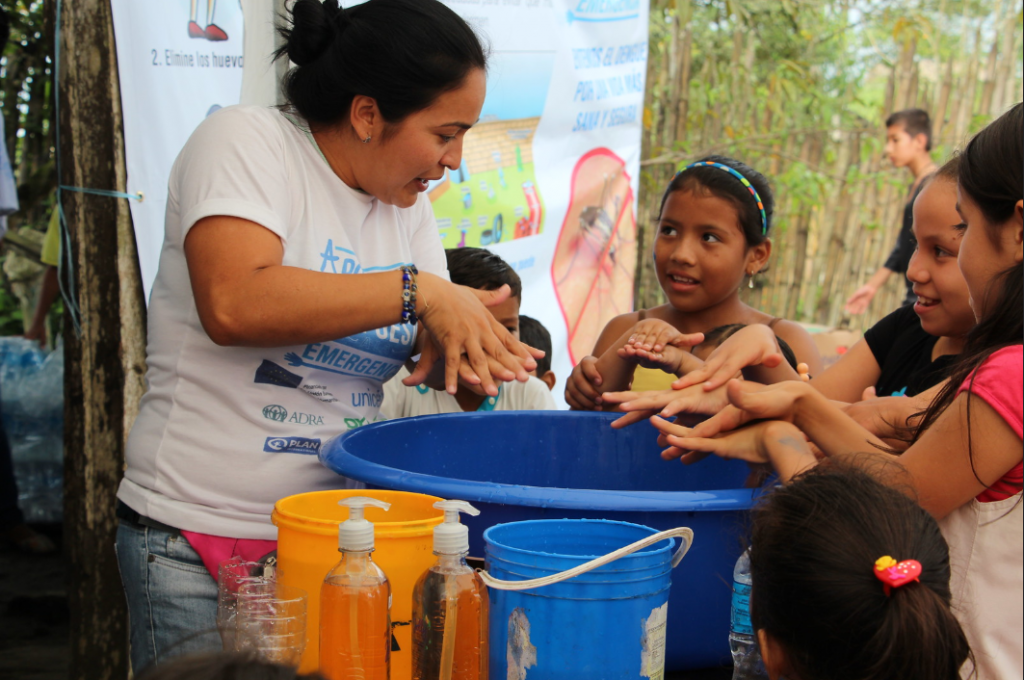
In the wake of these debates, an abundance of programming and empirical research surfaced. This included research on preventive interventions to reduce mental illness and social problems such as crime and homelessness. The findings from these studies demonstrated that taking a prevention focus is effective (e.g., see Durlak & Wells’ 1997 meta-analysis on this topic).

There are three types of prevention: primary, secondary, and tertiary (Caplan, 1964). The corresponding Figure 1 above provides an overview of these types of prevention. Primary prevention includes efforts to stop the problem from beginning in the first place. For example, Durlak and Wells (1997), in a meta-analysis, analyzed mental health treatment studies and outcomes from prevention interventions with another area of focus: drug use, physical health, academic achievement. They identified that specific high-quality programs can prevent multiple problems across different areas. This research specified how important it is for collaboration to occur among prevention scientists across disciplines. Collaboration and interdisciplinary work are other key focus areas of Community Psychology. Collaboration can maximize prevention efficiency and help researchers and practitioners understand the short-term and long-term effects of preventive interventions. The other important finding from this study was that positive mental health outcomes could be achieved through interventions targeting other aspects of human development and functioning. For example, (1) successful education programming can reduce future drug use and (2) programs promoting positive physical health can boost academic achievement.
Secondary prevention includes interventions that detect a disease early and prevent it from getting worse. In another meta-analysis, Durlak and Wells (1998) evaluated outcomes of 130 secondary prevention mental health programs for children and adolescents. They found that secondary prevention produces positive effects on young people receiving treatment for mental health through significantly reducing problem behavior, increasing youth competencies, and improving social and emotional adjustment. This work was groundbreaking in that it highlighted how preventive interventions can be just as effective as providing individualized psychotherapy for children and adolescents and more effective than reactive approaches to preventing problem behavior such as smoking, alcohol use, and delinquency. One case study example of secondary prevention is sexual assault prevention on college campuses. The Rape, Abuse, and Incest National Network states that college-age women have a high likelihood of experiencing sexual assault. Secondary prevention efforts to reduce sexual assault on college campuses may include self-defense, bystander intervention training, sex education regarding consent, resource education, and increasing sexual assault survivor visibility. The Centers for Disease Control and the American Psychological Association have both published recommendations to reduce sexual violence and make college campuses safer. A life transition can be stressful, such as entering school, graduating from school or getting married, and these are excellent times for implementing secondary preventive interventions. The following case study 12. 2 illustrates one such program from youth transferring into a new school when some children are at high risk for developing academic and social problems.
Case Study 12.2
At-Risk Youth Transferring Into a New School

A group of community psychologists designed an intervention for transferring elementary students which included an orientation to the new school and a program buddy at the new school. Also, those transferring students who were assessed as having some early academic difficulties were provided tutoring twice a week, over the entire academic year. For some at-risk youth, the tutorial aspect of the intervention focused on working directly with the children; for another group of children, the intervention focused on working with both the children and their parents. One year after the intervention ended, only children in the schools with the parental involvement condition continued to improve in their math and reading grades. The continuing increase in reading grades following the intervention suggests that students receiving both school and home tutoring benefitted the most from the comprehensive intervention. This intervention demonstrates the value of providing comprehensive prevention interventions at critical points in a child’s life course (Jason et al., 1992).
Tertiary prevention treats disease or social problems with the goal to improve quality of life and reduce symptoms of the problem after it has developed. Tertiary prevention differs from primary and secondary prevention in that it does not focus on reducing the incidence or prevalence of a disease or social problems, but rather on treating the problem once it arises. For example, as depicted in the video “An Ounce of Prevention,” parenting programs that increase key parenting characteristics, such as parental warmth, and support parents’ abilities to manage disruptive behaviors during early childhood, can prevent child maltreatment and future behavioral concerns in children. The video specifically describes the impact of such a tertiary prevention effort for a Mexican immigrant family facing several risks that may place children at greater risk for maltreatment and future behavioral distress, including underlying medical factors and poverty. These programs can be delivered to families on an individual or group basis (e.g., Incredible Years®, Triple P – Positive Parenting Program®) in the community.
The Ounce of Prevention video further depicts four prevention and promotion programs for young children, middle school adolescents, unemployed adults, and elderly people. These programs highlight each of the different types of prevention discussed above and why these programs are advantageous for their respective populations. The video includes interviews of the participants and program developers, footage of program activities, and a discussion of program outcomes. Indeed, an ounce of prevention can reduce a host of problematic behaviors and outcomes later in life.

The Institute of Medicine also has developed definitions for prevention efforts. One key distinction in this definition is that tertiary prevention is no longer considered a type of prevention, but rather an intervention strategy.
Indicated prevention refers to programming that targets people who have detectable early signs of maladjustment that foreshadow social, physical, or mental health problems. For example, the field of pediatrics has increased attention to decreasing the prevalence of childhood obesity in order to prevent adult obesity. Goldschmidt et al. (2013) specifically describe an indicated prevention approach that employed an intensive family-based treatment that included a combination of dieting, exercise, and behavioral (e.g., self-monitoring, parent skill training) strategies that targeted 669 obese and overweight youth across three cities in the US. Researchers measured the change in weight that was necessary to alter the status of overweight or obese youth to non-overweight. Results showed that despite some differences by age and initial weight classification, even a small decrease in weight was enough to move children into the non-overweight status after one year. Specifically, this underscores that preventive efforts during childhood may need only a small investment of resources to produce important changes. Another example of indicated prevention programs targeting substance use among youth can be found here.
Selective prevention involves programming that targets individuals who do not show any indication of the problem, but are at high risk for the development of the problem. For example, Head Start can be considered a type of selective prevention because many programs aim to provide comprehensive supports (e.g., schooling, family-based interventions) to children experiencing specific risk factors that place children at risk for later academic and social-emotional difficulties, such as poverty or developmental delays.
Universal prevention, which is similar to primary prevention, targets all of the people in a given population. School-based universal prevention programs that target behavioral and social-emotional functioning at the school or class-wide level are an example of a universal prevention approach to increasing access to services. These programs are a direct response to literature which indicated that the unmet behavioral and mental health needs of school-aged children increase the risk for longer-term declines in mental health, academic, and social functioning (Costello, Egger & Angold, 2005; Nastasi, 2004). One such prevention approach to population health that has demonstrated immediate and long-term behavioral, academic, and societal benefits, the PAX Good Behavior Game, is described in Case Study 12.3.
Case Study 12.3
The PAX Good Behavior Game®

The PAX Good Behavior Game® is a set of universal prevention strategies, rooted in decades of behavioral science that are implemented by classroom teachers in schools. PAX GBG aims to create a positive, safe, and nurturing classroom environment for learning and pro-social interactions. This nurturing environment enhances children’s behavioral skills, such as self-regulation and co-regulation with other classmates, and can improve learning outcomes in children. PAX is an example of universal prevention because it targets and benefits all students in a classroom or school, including the students who are exhibiting signs of behavioral and/or learning concerns as well as those who are not exhibiting these concerns. Click here to learn more about the good behavior game and watch Dr. Dennis Embry, president and senior scientist at PAXIS Institute talk about PAX.
In addition to immediate changes in the classroom, such as fewer instances of discipline referrals, studies have shown that children who were in PAX GBG classrooms during elementary school were less likely to use tobacco and other substances and more likely to experience better behavior and mental health in high school and young adulthood (e.g., Storr, Ialongo, Kellam, & Anthony, 2002; Wilcox et al., 2008). Learn more about some of the short and long-term benefits of PAX GBG here.
*PAX Good Behavior Game images reproduced with permission from PAXIS Institute
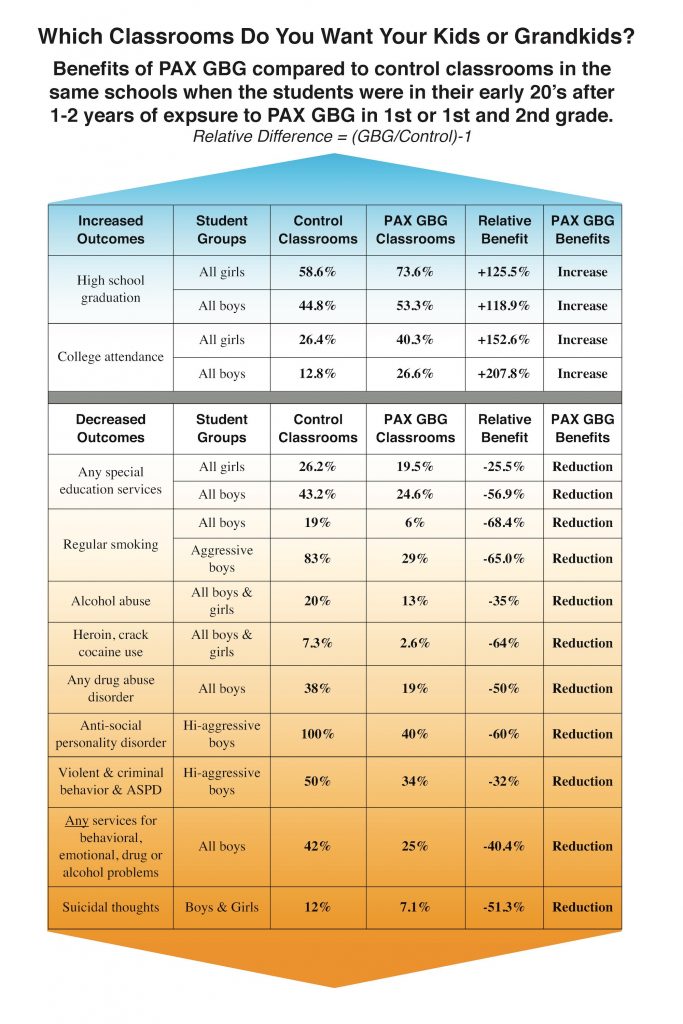

Related to the key concept of primary prevention is promotion. Promotion involves empowering individuals to increase control of their health and well-being through literacy and programming. Community psychologists identified that the goal of preventing problems can be done through promoting well-being. Generally, there are two approaches to promotion. The first is through reducing the chances that the problem will arise. The second is through increasing skills, strengths, and competencies of individuals and settings to reduce the risk for problems arising. Cost-benefit analyses of promotion have shown that efforts that focus on health promotion are very cost-effective compared to reactive or treatment-oriented approaches (Durlak & Wells, 1997). Community psychologists argue that promotion must also take into consideration ecological approaches to improving the human condition. That is, those who are interested in preventing social problems and promoting human competencies and well-being must call attention to the relationship between broader social forces and rates of disease and social distress seen in communities (Albee, 1983). For example, Case Study 12.4 describes a community-based advocacy program developed by community psychologists to promote well-being among girls in the juvenile justice system.
Case Study 12.4
Resilience, Opportunity, Safety, Education, Strength (ROSES)

Resilience, Opportunity, Safety, Education, Strength is a community-based program in New York City that pairs a trained advocate with girls involved with or at-risk for juvenile justice system involvement. The program works to provide the girls with resources and education, defining personal goals, developing self-efficacy skills, encouraging engagement with various social contexts (i.e., school, family, peers) and promotion to reduce justice system involvement. Resilience, Opportunity, Safety, Education, Strength aims to learn more about justice-system-involved girls’ needs. Research shows that those girls who have participated in this program reported greater resilience and self-efficacy; fewer risk behaviors, including violence, crime, and substance use; and decreased negative emotions such as depression, anxiety, and anger (Javdani & Allen, 2016).
Learn more about ROSES.

Another key concept is the role of risk and protective factors. Risk factors are variables that are related to an increased risk for developing a disease or problem. While the term comes from a public health perspective, community psychologists use risk factors to understand factors associated with increased risk for various social problems such as homelessness, juvenile delinquency, or gender-based violence. For example, Figure 3 below depicts some of the most common risk factors, especially among children and adolescents, which prevention programs need to consider in reducing the development of social problems. Case Study 12.5 provides a specific example of risk factors for human trafficking, a pervasive problem around the globe. In contrast to risk factors, protective factors include variables that are related to a decreased risk for developing a disease or a social problem. Protective factors can include variables such as positive relationships, academic achievement, parental support, and strong economic conditions.
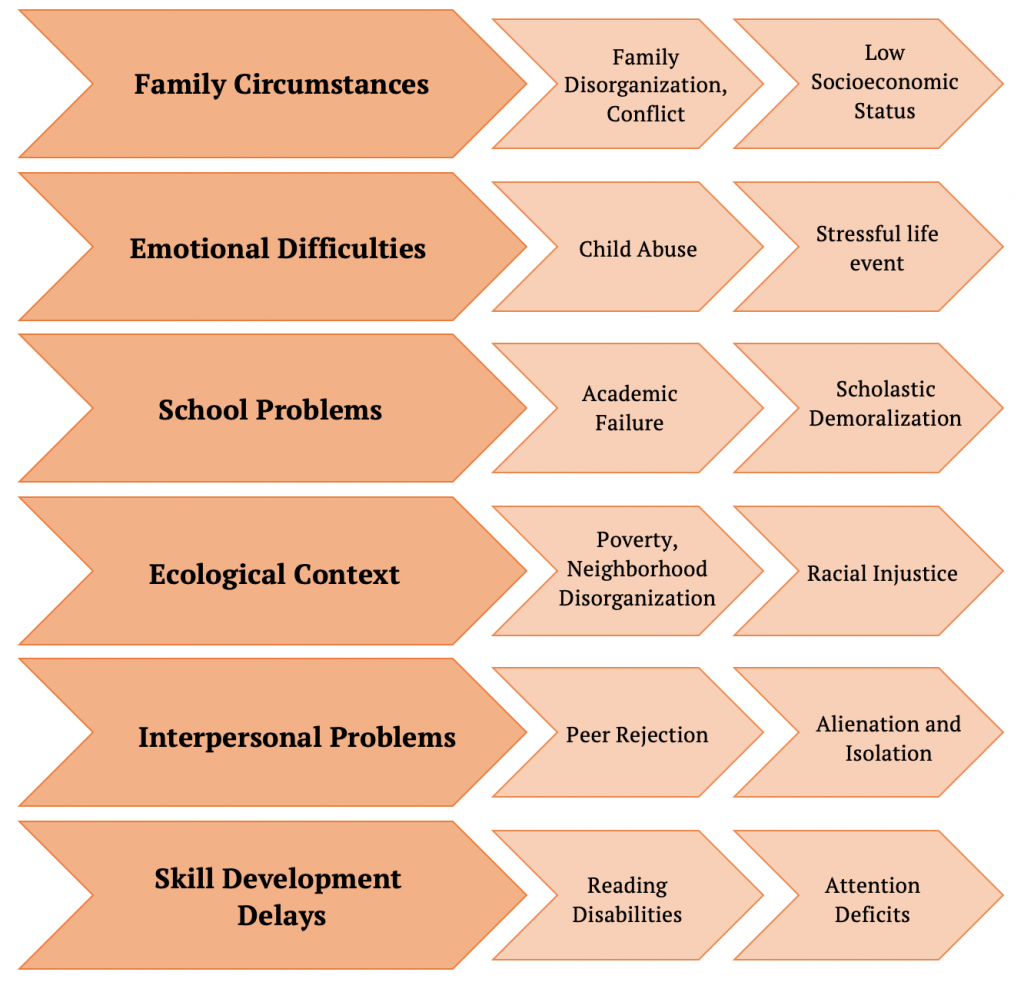
Case Study 12.5
The Most Vulnerable, The Risk Factors, and The Most Effective Programming

Human trafficking is a serious social problem in the US and around the world. Human trafficking involves the use of force, fraud, or coercion for commercial sex or involuntary labor (Trafficking Victims Protection Act of 2000). For sex trafficking cases, there are a number of risk factors for youth. Taking an ecological perspective, these can include factors related to an individual’s sociodemographic characteristics as well as social, behavioral, and broader community risk factors. Figure 4 below includes a list of risk factors for human trafficking.
Thus, the most effective prevention programming, such as The Prevention Project program, should target the most vulnerable population (e.g., female youth) engaged in social or behavioral correlates of sex trafficking (e.g., running away), or involved with community systems and programs such as the juvenile justice system or foster care, or social problems more generally, like poverty. The most effective types of services tend to be integrated and target multiple risk factors.

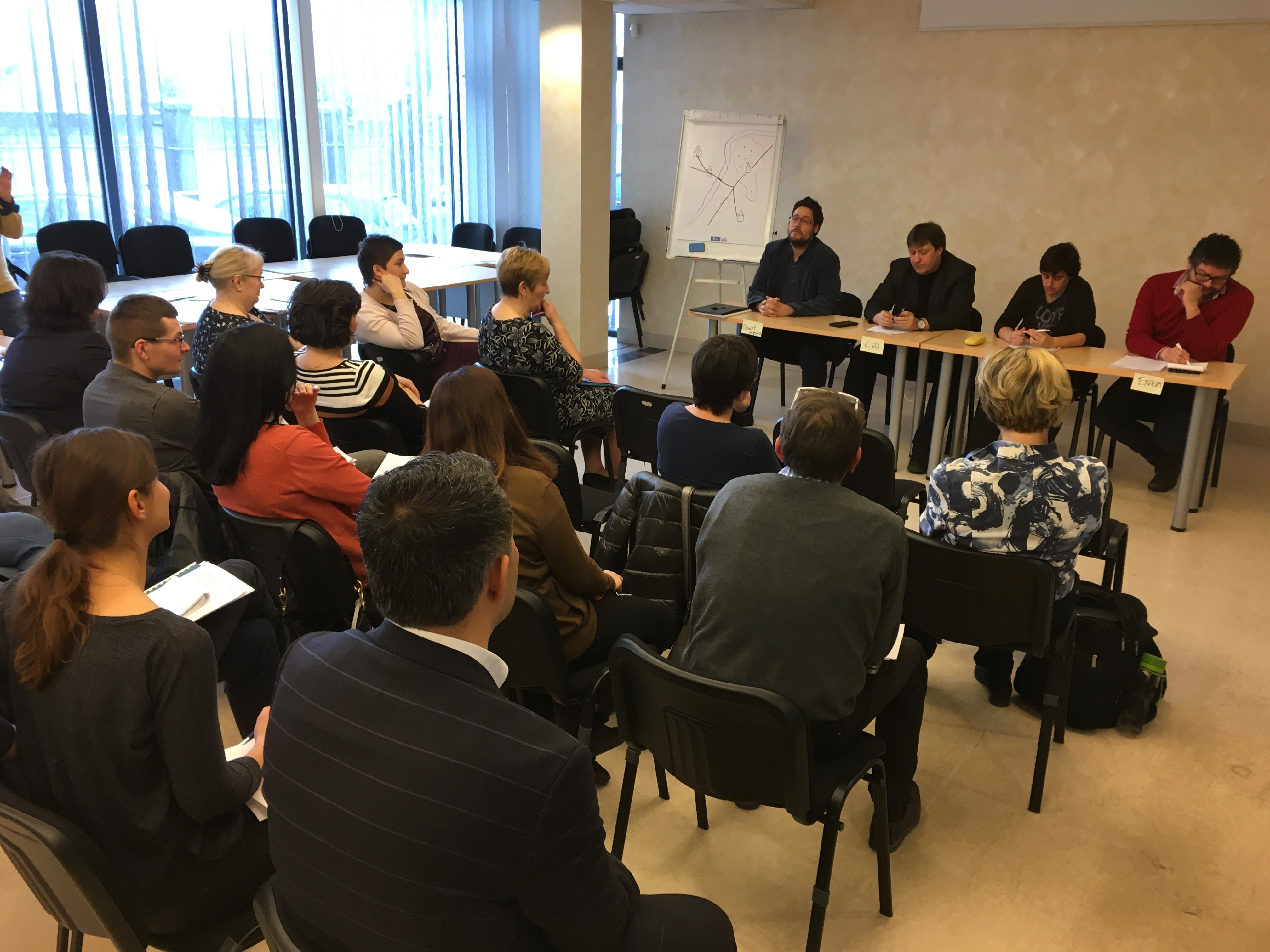
The Institute of Medicine (1994) developed a model for problem assessment, intervention, and dissemination strategies. For example, this research cycle includes assessing the prevalence of risk and protective factors of a problem area, developing prevention innovations, researching the effectiveness of those innovations, and disseminating innovations into the community. Figure 5 below outlines each aspect of the preventive intervention research cycle.
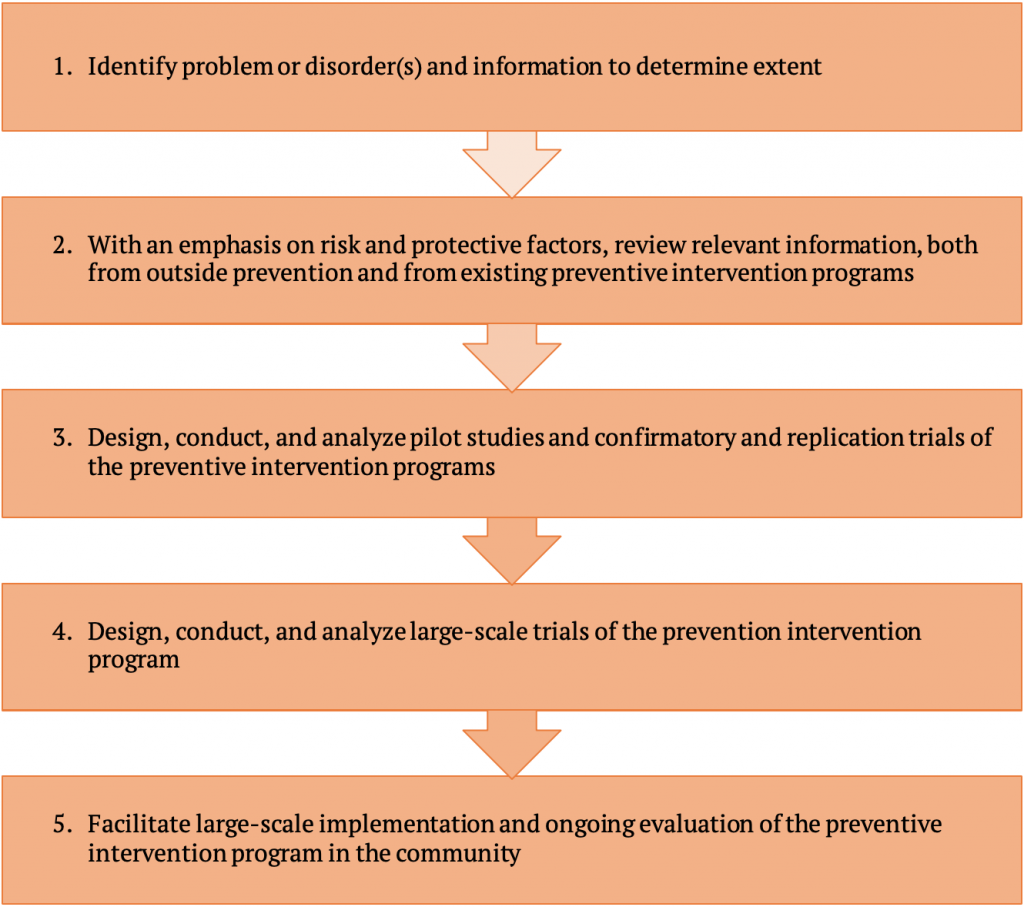
There are a number of challenges to conducting prevention research and using these models since they identify what needs to be done but provide very little detail on how these things will happen. Most models, such as the Institute of Medicine framework, focus on the functions that are part of the innovation, implementation, and dissemination process, but not on the systems that support these functions. To address this gap, Wandersman and colleagues (2008) proposed a framework that describes relevant systems to help bridge the gap. The Interactive Systems Framework works to connect step four (conducting trials of the program) and step five (implementing the program in the community) of the Institute of Medicine model. Figure 6 below details the critical components of the Interactive Systems Framework to bridge this gap. For example, Halgunseth and colleagues (2012) used the Interactive Systems Framework to understand the relationship between program capacity and implementation in after-school settings. They examined eight after-school sites that received the Good Behavior Game (described in case study 12.2). Aligned with the Prevention Support System element of the Interactive Systems Framework, the after-school staff was trained and received weekly on-site support in implementing the intervention. It was found that after-school settings that were more organized and maintained strong links to individuals or community-based organizations scored higher in program fidelity and quality. Funders can utilize the Interactive Systems Framework to identify what kinds of support they should provide for the Prevention Synthesis and Translation System element; similarly, practitioners can gather information from that same component for what they need as well as from the Prevention Support System element. Additionally, practitioners can see what they need to do to build capacity from the perspective of the Prevention Delivery System component.
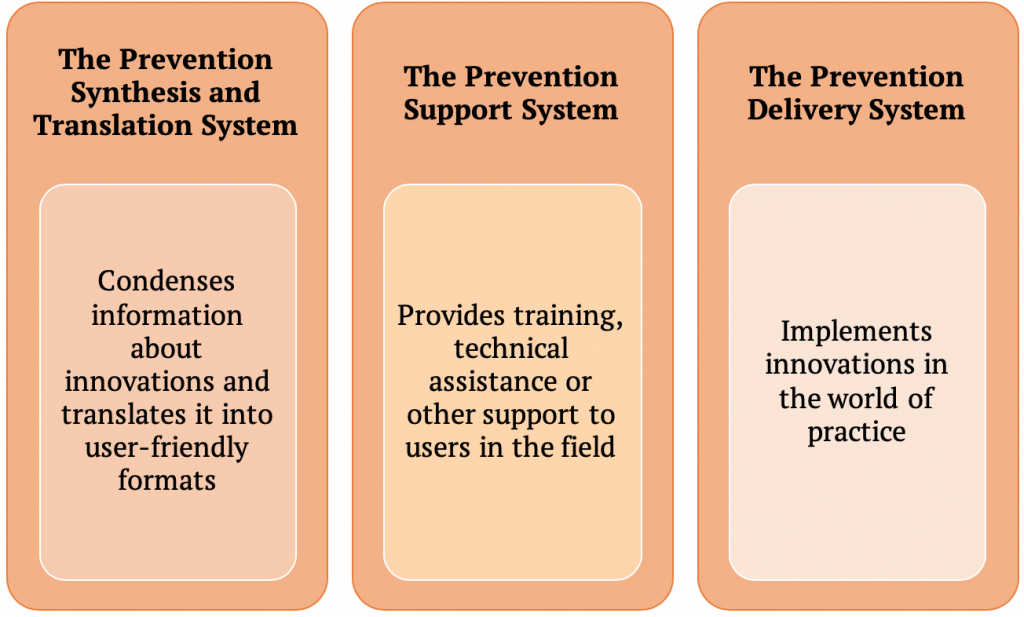
Program evaluation is a cornerstone of Community Psychology research and action. Broadly, program evaluation involves measuring the effectiveness of interventions and policies. This can include both processes (e.g., how were intervention activities implemented) and outcomes (e.g., did the intervention achieve the outcome objectives). Community psychologists engaged in prevention and promotion research and action use logic models to guide these efforts. To read more about program evaluation, check out these resources from the Centers for Disease Control and The Community Tool Box. Conducting program evaluations is a key way that community psychologists can measure whether or not our prevention and promotion efforts are having the intended effect.

Even though prevention and promotion are seminal concepts in Community Psychology, they are not without drawbacks. Community psychologists have outlined two key critiques. First, prevention and promotion is limited in its focus on empowerment (Rappaport, 1981). Rappaport argued that prevention is “one-sided” in part because it is derived from a needs model, rather than a rights model. Further, Rappaport argued prevention programs may not be enough to change social institutions, but rather just add on to what is already in place. Rappaport made the case that empowerment is a better model because it prioritizes rights and offers a more transformative perspective to change social problems. Second, Miller and Shinn (2005) outlined another critique of prevention and promotion: the failure to adopt prevention programming is rooted in difficulties in implementation and dissemination.

Miller and Shinn (2005) described potential problems with the Institute of Medicine model of dissemination and potential ways community psychologists can directly counteract these problems in their dissemination efforts. They identified four distinct problems in disseminating prevention and promotion innovations. First, many communities have limited capacity (as shown in the video link) to implement a program causing dissemination failure. The context in which community-based organizations function shapes that capacity, so folks interested in disseminating programs must take into account ecological factors. Second, often times there is an incongruence of values—a lack of compatibility and/or consistency between the setting and the prevention program. Third, Miller and Shinn argued that there is a presumption that innovations that “prove their worth” in a controlled, experimental setting are better than what they might replace when implemented. They referred to this as “innovation bias” that wrongly characterizes communities as passively waiting to adopt a prevention program rather than problem-solving themselves. Finally, they argued that the Institute of Medicine prevention and promotion model proposes an overly simplistic model of decision-making. It assumes that the evidence of the success of an innovation in a controlled, experimental setting is sufficient to promote decisions about adopting the innovation in practice. We know that many other considerations are also relevant in the decision-making of community agencies. Miller and Shinn (2005) proposed two potential solutions to these pitfalls of the Institute of Medicine framework. Rather than curating innovations in the context of a university and then translating them to a different environment in the community, community psychologists should identify promising prevention and promotion interventions already functioning in communities and study those to understand their effectiveness. Finally, they proposed that researchers should focus less on specific programs and more on powerful ideas that can improve the quality of life. This focus on powerful ideas may actually come from the process of understanding how prevention and promotion programs work in communities by specifying the core elements of a program that could be applied in other community contexts. Thus, we should be “learning from communities” and disseminating their prevention and promotion efforts that work.
Despite these critiques, prevention is still an important framework in Community Psychology and has the potential to create sustainable change in communities. Looking at precipitating factors, an attempt is made to make meaningful changes in environmental or personal factors to eliminate the barriers to success and wellness. Disease and community disorder will always require reactive responses and treatment; however, one goal of Community Psychology is to prevent some of it. Prevention lowers the demand for treatment and allows for increased access to resources that individuals may otherwise not have access to. As noted in this chapter, prevention also has the potential to reduce societal costs in the long run, which means resources can continue being spread for a greater amount of time.
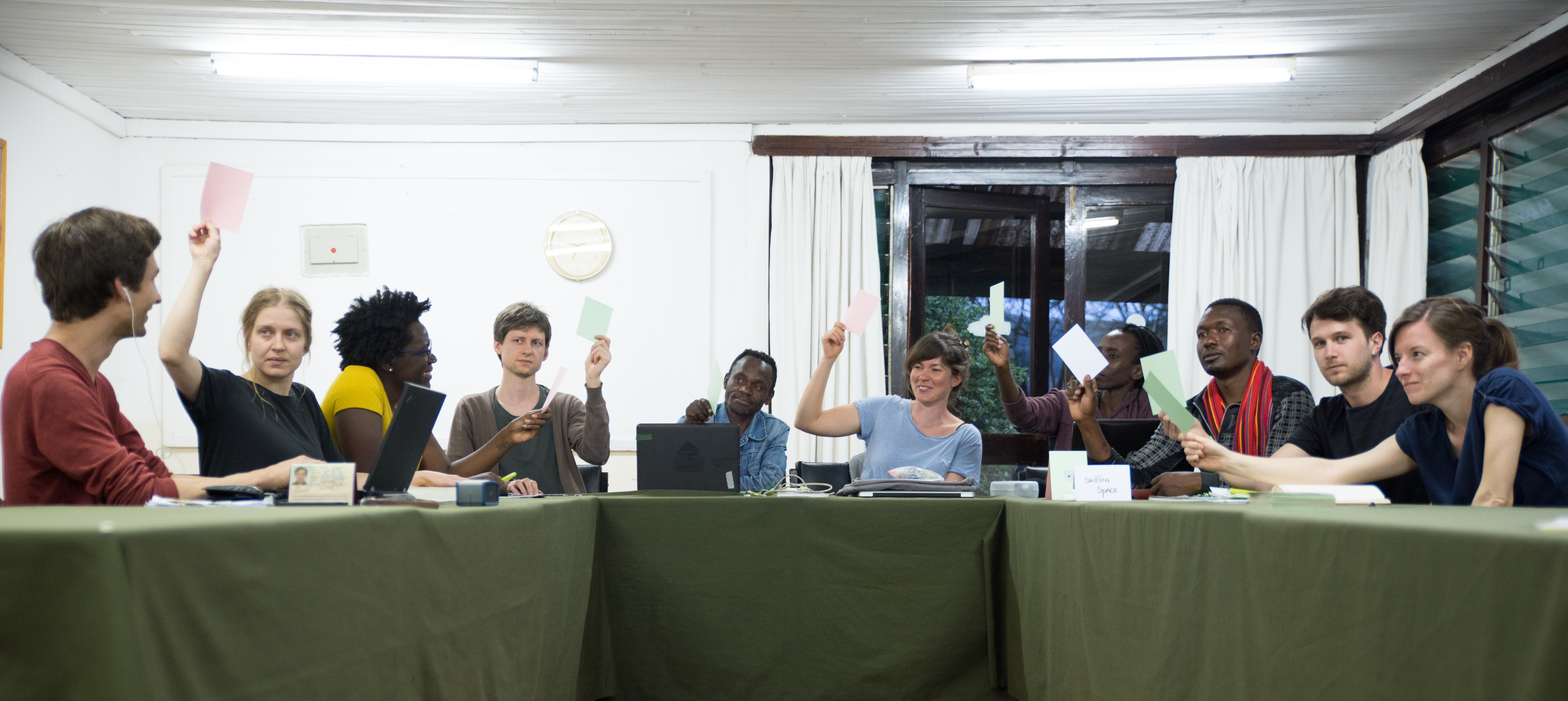
This chapter outlined the importance of prevention and promotion as key concepts in Community Psychology. We highlighted the historical and contemporary perspectives on prevention and promotion including different types of prevention (e.g., primary, secondary, tertiary), risk and protective factors, and the various aspects of prevention programs and the techniques needed to evaluate such programming. As seen throughout the chapter based on the wide range of examples—from childhood obesity prevention efforts to examining risk factors for human trafficking—there are a vast number of social issues community psychologists can explore with an eye towards prevention and promotion. These are important frameworks to use to target change across multiple levels (e.g., individuals, groups, settings, social systems) in order to prevent negative outcomes and promote well-being.
Critical Thought Questions
Take the Chapter 12 Quiz
View the Chapter 12 Lecture Slides
____________________________________________________________________
Albee, G. W. (1983). Preventing psychopathology and promoting human potential. American Psychologist, 37, 1043–1050.
Caplan, G. (1964). Principles of Preventive Psychiatry. New York, NY: Basic Books.
Costello, E. J., Egger, H., & Angold, A. (2005). 10-year research update review: the epidemiology of child and adolescent psychiatric disorders: I. Methods and public health burden. Journal of the American Academy of Child & Adolescent Psychiatry, 44(10), 972-986.
Durlak, J. A. & Wells, A. M. (1997). Primary prevention mental health programs for children and adolescents: a meta-analytic review. American Journal of Community Psychology, 25, 115-152.
Durlak, J. A. & Wells, A. M. (1998). Evaluation of indicated preventative intervention (secondary prevention) mental health programs for children and adolescents. American Journal of Community Psychology, 26, 775-802.
Goldschmidt, A. B., Wilfley, D. E., Paluch, R. A., Roemmich, J. N., & Epstein, L. H. (2013). Indicated prevention of adult obesity: How much weight change is necessary for normalization of weight status in children?. JAMA Pediatrics, 167(1), 21-26.
Halgunseth, L. C., Carmack, C., Childs, S. S., Caldwell, L., Craig, A., Smith, E. P. (2012). Using the Interactive Systems Framework in understanding the relation between program capacity and implementation in afterschool settings. American Journal of Community Psychology, 50, 311-320.
Jason, L. A., Glantsman, O., O’Brien, J. F., & Ramian, K. N. (2019). Introduction to the field of Community Psychology. In L. A. Jason, O Glantsman, J. F. O’Brien, & K. N. Ramian (Eds.), Introduction to Community Psychology: Becoming an agent of change. Retrieved from https://press.rebus.community/introductiontocommunitypsychology/chapter/intro-to-community-psychology/
Jason, L. A., Weine, A. W., Johnson, J. H., Warren-Sohlberg, L, Filippelli, L. A., Turner, E. Y., & Lardon, C. (1992). Helping Transfer Students. San Francisco, CA: Jossey-Bass.
Javdani, S., & Allen, N. E. (2016). An ecological model for intervention for juvenile justice-involved girls: Development and preliminary prospective evaluation. Feminist Criminology, 11(2), 135-162.
Miller, R. L. & Shinn, M. (2005). Learning from communities: Overcoming difficulties in dissemination of prevention and promotion efforts. American Journal of Community Psychology, 35(3-4), 169-183.
Mrazek, P. J., Haggerty, R. J., & The Institute of Medicine, Committee on Prevention of Mental Disorders, Division of Biobehavorial Sciences and Mental Disorders. (1994). Reducing risks for mental disorders: Frontiers for preventive intervention research. Washington, DC: National Academy Press.
Nastasi, B. K. (2004). Meeting the challenges of the future: Integrating public health and public education for mental health promotion. Journal of Educational and Psychological Consultation, 15(3-4), 295-312.
Rappaport, J. (1981). In praise of paradox: A social policy of empowerment over prevention. American Journal of Community Psychology, 9(1), 1.
Storr, C. L., Ialongo, N. S., Kellam, S. G., & Anthony, J. C. (2002). A randomized controlled trial of two primary school intervention strategies to prevent early onset tobacco smoking. Drug and Alcohol Dependence, 66(1), 51-60.
U.S. Department of Health and Human Services Administration for Children and Families. (2010). Directory of program services. Washington, DC. Office of Public Affairs. Retrieved from http://www.ncdsv.org/images/ACF_DirectoryOfProgramServices.pdf
Trafficking Victims Protection Act of 2000. 22 U.S.C § 7101.
Wandersman, A., Duffy, J., Flaspholer, P., Noonan, R., Lubell, K., Stillman, L., … Saul, J. (2008). Bridging the gap between prevention research and practice: The interactive systems framework for dissemination and implementation. American Journal of Community Psychology, 41, 171-181.
Wilcox, H. C., Kellam, S. G., Brown, C. H., Poduska, J. M., Ialongo, N. S., Wang, W., & Anthony, J. C. (2008). The impact of two universal randomized first-and second-grade classroom interventions on young adult suicide ideation and attempts. Drug and Alcohol Dependence, 95, S60-S73.
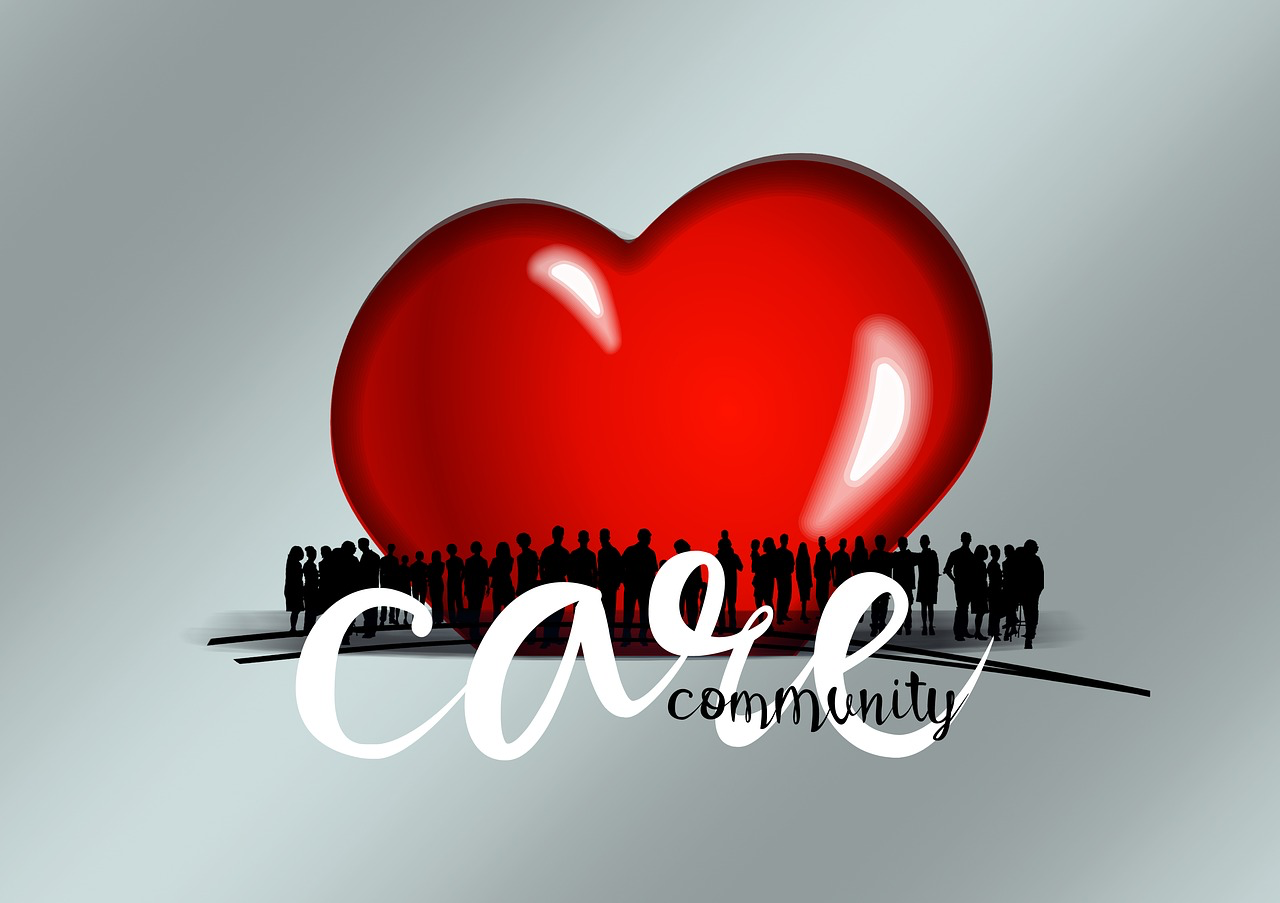
Chapter Thirteen Objectives
By the end of this chapter, you will be able to:

It’s 2 am and your head is swarming with thoughts, none of them pleasant or relaxing: Did I reply to that important email? Am I ready for the upcoming presentation? Should I have studied more for tomorrow’s test? How long will it take me to fall asleep? Why is this always happening to me? All of these thoughts manifest as stress, an ever-present variable in our lives. You are not alone and as you will find out in this chapter, there are ways of coping and managing these stressors. Furthermore, there are ways that we can help communities better deal with these types of challenges too.

So what is stress? This shouldn’t be a trick question, but why is it so hard to answer? Stress can be three things: a stimulus event (i.e., a stressor), a process for understanding the stimulus and its context, and a reaction we have to this event. Essentially, to be stressful the event has to become an overload of incoming information into our system. Stress can cause both biological responses such as sweaty palms or a racing heart, as well as psychological responses such as nervousness. It is known to have effects on our behavior when we might avoid others, and it also affects cognitive performance when we might have difficulty concentrating.
A number of genetic studies have begun to identify candidate genes that may play a role on diverse forms of stress reactions. It is highly probable that genetics account for some of our responses to stress, but other factors are also of importance. Environmental stressors can also affect our behaviors and emotions. Environmental stressors can be grouped into different types: Major Life Events (e.g., experiencing a breakup, getting married, or having a baby), Life Transitions (e.g., puberty or transition into high school), Daily Hassles (e.g., family arguments or waiting in long line at a security checkpoint of an airport) and Disasters (e.g., experiencing a car accident or a computer crashing causing lost of important information). These types of environmental stressors can cause you to be fearful and have a racing heartbeat. And our perceptions of these responses can actually make the symptoms worse. It is also important to note that these stressors can be perceived differently by different people. For instance, two people can get stuck in the same elevator and while one would find the experience as a nuisance, another will tell you it was the worse situation they have ever been in. Here is a podcast describing a poll about the role of stresses and stress responses in the natural world. This supplementary article explores what is the right amount of stress.
While most of the time we think about stress in a negative way, some stress is adaptive and can even give us an edge. Part of the stress reaction involves the secretion of hormones, which in turn will stimulate the cardiovascular system, which includes your heart. In this way, the right amount of stress may release hormones and increase our ability to focus better on an exam or to quickly maneuver our car when we are trying to avoid an accident. Most stressors in our daily life are psychological in nature – dating, exams, presentations, and deadlines, so the adrenaline and cortisol (i.e., stress hormones) released into the bloodstream do not get burned off. These types of psychological stressors can initiate an over-activation with a tendency to make the stress response worse. So, a response to an environmental stressor may start as fear and turn into a panic attack.

One of the goals of our body is to maintain stability (i.e., homeostasis). We can therefore, define stress as an actual or perceived threat capable of throwing our homeostasis off balance. Stress exposure starts the responses. When a person is exposed to prolonged stress, overload may occur. When the stress response is triggered too often and/or remains active too long, it can cause the “wear and tear” on the body from lowering your immune system and bone density, to hypertension, to heart attack.
There are two different types of stressors that we typically encounter. Acute stressors are observable stressful events that are time-limited such as an upcoming test or a family gathering. An acute stressor brings activation to our neuroendocrine system and makes us ready to act (i.e., “fight or flight”). Remember that pumped up feeling you got the last time you were getting ready to give a speech in front of the class? Chronic stressors, in contrast, are persistent demands on you; they are typically open-ended, using up your resources in coping but not having any resolution. Here is a short article and podcast on stress effects on health and suggestion for stress preventive activities.
A chronic illness, poverty, and racial discrimination are all examples of chronic stressors. Prolonged stress can lead to an eventual breakdown, such as destroying our DNA or contributing to aging. A number of recent studies have shown that lower socioeconomic status is associated with higher stress load. In addition, perceptions of racism, for example, serve as a chronic social stressor for ethnic minorities and can, in part, explain some of the health issues of African Americans and other ethnic minority groups in the US and other countries.

Robert Service, a Canadian Poet, cautioned, “Be master of your petty annoyances and conserve your energies for the big, worthwhile things. It isn’t the mountain ahead that wears you out – it’s the grain of sand in your shoe.”
In addition to many stressors in our lives being psychological and chronic in nature, we should also pay attention to everyday hassles, which can be as harmful, if not more harmful than the life changing events. Everyday hassles may include things like worrying about one’s weight, having too much work with too little time, a stressful commute to school or work, etc. Major life changes usually bring about more hassles, which may lead to more physical stress symptoms.
In summary, stress can be adaptive—in a fearful or stress-causing situation, we can run away and save our lives or concentrate better on a test. Biologists might even say it is necessary. But, stress can also be maladaptive. This is especially true if it is prolonged (i.e., chronic stress) because it increases our risk of illness and health problems. Thus, reducing stress, especially prolonged stress, is essential to healthcare. This video explains the effects of daily hassles on our health.

To deal with stress in your life, it is important to figure out where that stress originates and notice how you tend to react to it. Later in this chapter, we will show you how community psychologists consider the environment and ecological perspectives as intertwined in stress and coping. Lazarus and Folkman (1984) have been among the most influential psychologists in the stress and coping field, and they defined coping as efforts to manage demands that could exceed our resources. It is important to highlight from this definition that when a person perceives a life circumstance as taxing and exceeding the resources they have, this person will experience stress. Therefore, coping involves your efforts to manage stress, which is illustrated in Figure 1.

Lazarus and Folkman (1984) felt that when humans perceive a life circumstance as taxing and exceeding their resources, stress will be experienced, which we have already defined in prior section as an overload of incoming information into a system. Therefore, coping involves persons’ efforts to manage stress, whether the process of dealing with stress is adaptive or not (Lazarus, 1993). When we talk about coping, we will need to consider the intensity of the stressor, the context of coping, and an individual’s appraisal of coping expectations.
Research on coping has usually found five type of coping styles (Clarke, 2006; Skinner, et al., 2003; Folkman & Moskowitz, 2005). These include the following: (1) problem-focused coping style involves addressing the problem situation by taking direct acting, planning or thinking of ways to solve the problem, (2) emotional-focused coping style involves expressing feelings or engaging in emotional release activities such as exercising or practicing meditation, (3) seeking-understanding coping style refers to finding understanding of the problem and looking for a meaning of the experience, and (4) seeking help involves using others as a resource to solve the problem. Finally, people might respond to stressors by (5) avoiding the problem and trying to stay away from the problem or potential solution to the problem.
Coping strategies are the choices that a person makes in order to respond to a stressor. A strategy can be adaptive (effective) or maladaptive (ineffective or harmful). The ideal adaptive coping strategy varies depending on the context, as well as the personality traits of the person responding. The coping strategies can be problem-solving or active strategies, emotional expression and regulation strategies, seeking understanding strategies, help or support-seeking strategies, and problem avoidance or distraction strategies.
Here is one example of an intervention strategy that shows how to effectively cope with daily and transitional stressors. The strategy is called Shift-and-Persist (Chen & Miller, 2012), and it requires individuals to first shift views of the problem. To shift, you need to (1) recognize and accept the presence of stress, (2) engage in emotional regulation and control negative emotions, and (3) practice self-distancing from the stressor to gain an outsider’s perspective of the stressful context. To persist, you would need to (1) plan for the future through goal setting, (2) recognize a broader perspective when obstacles arise, (3) determine what brings meaning to your life, and (4) become flexible to determine new pathways to goals. The Center for Disease Control and Prevention and the American Heart Association offer other coping strategies. Two more discussions on coping strategies are found in these two Ted Talk Videos here and here.
Table 1 below Presents a list of coping strategies and is a summary of strategies reported in Clarke, 2006; Skinner, et al, 2003; Folkman & Moskowitz, 2005. Although completed lists are more extensive, this table presents styles reported across the three studies and presented similar response focus and orientation.
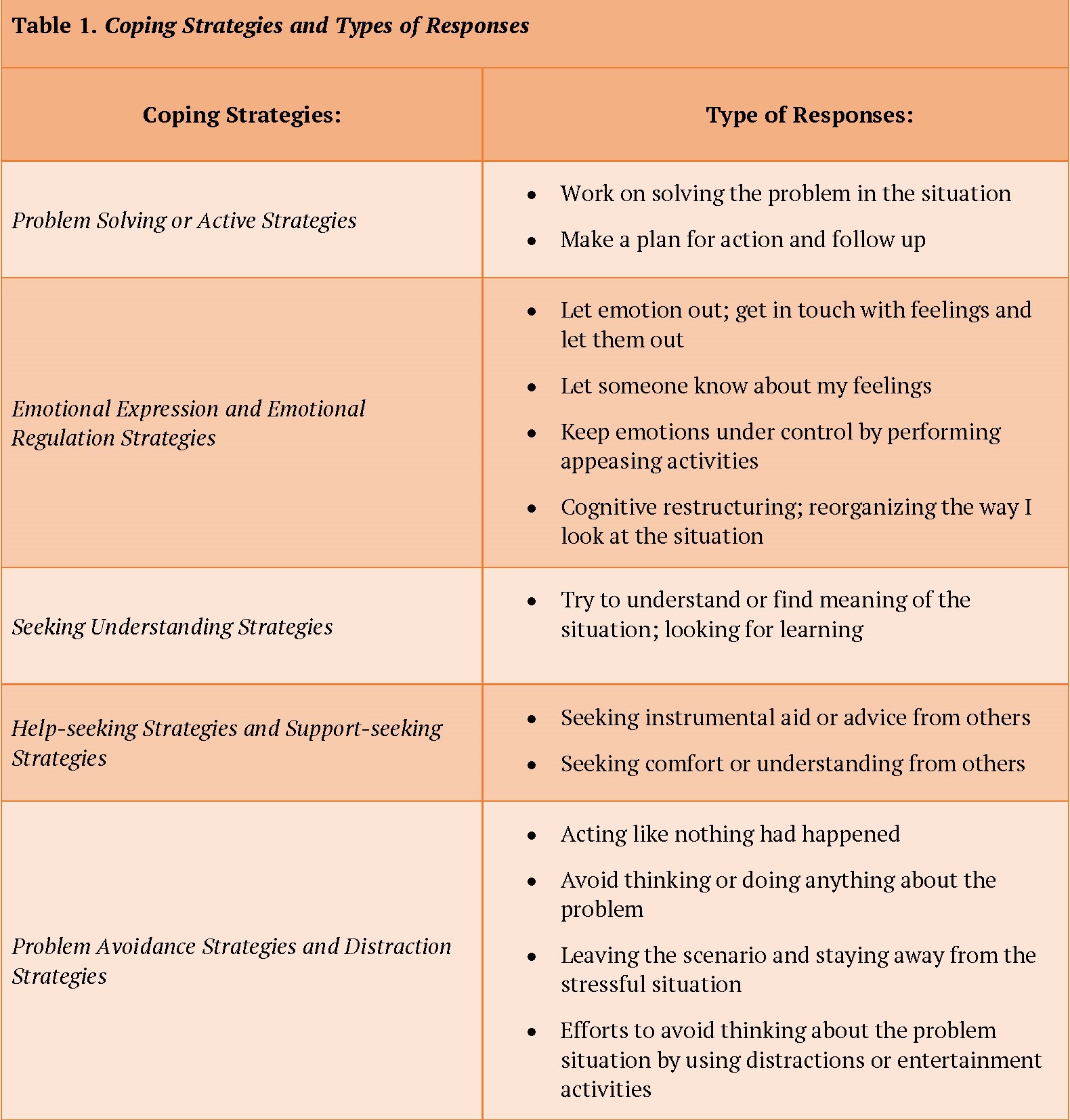
To understand coping as a process, we need to understand people’s reaction to stress in context. This includes assessing whether the coping thoughts or actions are good or bad for that given challenge and given context. In addition, the process of coping includes the particular person, the particular encounters with the stressor, the time of the person’s reactions, and the outcome being examined. Practical Application 13.1 can help you examine your reaction to stress and understand your coping process.
Practical Application 13.1
Understanding Stress in Your Life
Think about an important stressful experience in your life:

Community psychologists try to understand coping beyond individual perceptions and reactions to stress. In general, new coping models are looking into what the characteristics of people that will elicit a given coping style are. In addition, it is important to learn more about the effectiveness of different coping styles when used across different contexts (which includes the environment and nature of the stressors). A community psychologist is interested in understanding the contextual element that produces or reduces a given stressor, so they create interventions to help people cope with their stressors. Finding the best fitting coping strategy may improve people’s experiences and outcomes when confronted with challenging/stressful life transitions.
All people are exposed to transitions, with youth being even more likely (e.g., starting elementary/middle school, finishing high school, first job, etc.), and the experience of mastery of these situations might help school-age youth successfully cope with future transitions. The following Case Study 13.1 highlights how community psychologists might use preventive strategies to help youth deal with these types of natural stressors that they will encounter in life.
Case Study 13.1
Preparing Students for High School Graduation

Leonard Jason and Betty Burrows (1983) provided youth about to graduate from high school practice crisis experiences to work through so that they could generate successful outcomes for stressful situations. The youth were first informed that during times of transition, heightened levels of emotions are often experienced. These elevated levels of arousal can become maladaptive if experienced over a prolonged period of time. They then had a chance to practice techniques to effectively reduce excessive arousal or anxiety such as progressive muscle relaxation, meditation, or listening to quiet music. The youth were then given anxiety-promoting transitions to imagine. They were asked to try one of these strategies to alleviate the anxiety of this crisis situation.
The seniors also had a chance to discuss how personal beliefs and self-statements can affect one’s mood. When difficult transitions are encountered, irrational beliefs or negative self-statements might arise. An example of an irrational belief is that it is a necessity for us to be loved and approved by everyone we know. The seniors were provided with situations involving transitions to role-play. Within each of these scenes, one actor adopted an irrational belief; the other attempted to show a more rational way of thinking. Following each role-play, the participants had a chance to discuss how the adoption of a rational or irrational belief might affect their ability to successfully handle transitions. Following the role-plays, all the students discussed how effective the various coping strategies might have been in resolving transitional events.
This study found that seniors about to graduate from high school can profit from being provided a preventive intervention that prepares them for dealing with transitions. Here are some of the students’ comments: “You really helped me to really think out all my problems and how to answer them. Thanks!! …. It helped me to help other people who are in difficult situations.” “I think that problem solving is the most helpful to people at my age because we face problems every day.” “I feel that I have benefited from the sessions as I have gone through a lot as my mother has been divorced twice and is married for the third time and I just moved from a small town to a large city.”
But sometimes, crises occur, and then we need to find ways to deal with those situations. Case Study 13.2 will provide an example of helping individuals and communities with dealing with a natural disaster, Hurricane Maria.
Case Study 13.2
Coping with Hurricane Maria

On September 20th, 2017, Hurricane Maria devastated Puerto Rico. Watching the compounding difficulties over the course of that fall, Melissa Ponce-Rodas and a team of 20 members, four faculty, one alumna, 13 students, and two other staff members with backgrounds in undergraduate and graduate psychology, community and international development, and social work decided to spend their Spring break helping with the recovery. The ultimate goal of the mission was to “Accept, Talk, Heal,” providing mental health training in churches and communities to give those affected by the disaster the tools they needed to help them through the trauma of the aftereffect of the hurricane and to help them recover beyond the physical reconstruction of their community. This intervention was about more than cleaning up debris or restoring a school, it was about empowering a community to overcome trauma.
Prior to the intervention, the team contacted local church agencies and asked about their experiences and what was truly needed. This process of inquiry resulted in another group of people with expertise in the community to be invited into the collaborative process. The local collaborators included social workers, police officers, certified nursing assistants, staff from the four schools, church groups, and others who were directly affected by the natural disaster. It is not surprising that the team was quickly accepted and trusted by the community. Ponce-Rodas believes one contributor to this is her Puerto Rican heritage that helped bridge the intervention team to the community and facilitate connections between community members and those from the mainland.
Understanding the complexity of the coping process was one of the reasons Dr. Ponce-Rodas drew on her Community Psychology to partner with existing agencies on the island. Because so many community members had experienced symptoms of Post-Traumatic Stress Disorder the intervention aimed at normalizing the emotional reactions affecting the individuals. The team reminded the community members participating in the intervention that the whole community was going through this and no one should feel isolated in their experience and that it is normal to seek help from others when faced with adversity. The team emphasized this with the “Healing is a Process” slogan, highlighting the dynamic nature of this concept.
The team also agreed that a strength-based approach fits this intervention well. To help combat the loss and desperation, the community participants were encouraged to turn to the strengths the community still has. The message across the island was Puerto Rico Se Levanta (Puerto Rico Will Rise). Many heroic stories of selflessness and self-sacrifices emphasized resilience in the wake of such massive destruction and highlighted the power and strength in the community. The community members also often commented on their faith, which meant that the team included faith in their intervention. The team firmly believed that the best way the community could get help was by understating the community’s background, by recognizing the dynamic process of coping, by alleviating the stigma of help-seeking, by drawing on their own strengths, and by helping themselves.

Coping can be aided by asking others for support to help overcome problems. Support-seeking strategies include seeking advice or information or direct assistance. Individuals who engage in these types of help-seeking strategies are more likely to obtain social support. Seeking help from relatives may prove to be successful, which might contribute to it becoming a frequently employed coping mechanism. Barker (2007) suggests that youth’s help-seeking behaviors set up the conditions to create a rich supportive network for them, such as the feeling that there is available support. Case Study 13.3 illustrates how one can go about studying supports using multiple points of view.
Case Study 13.3
Support Seeking Behavior
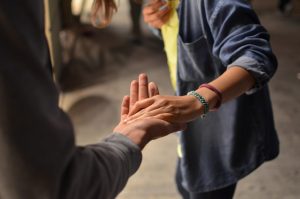
Having at least one friend in a recovery home was found to be about the best predictor among residents of recovery homes of having a good outcome, which involves not using drugs or engaging in illegal activities. To better understand what seeking support might be about, several community psychologists used focus groups to better understand natural friendship and mentoring relationships. For example, participants were asked about how individuals determined who they would go to in the house for support, the type of support they received from housemates, and the characteristics that those individuals have. The findings from the focus groups had a theme of promoting social support within their recovery homes, as one female participant explained:
“When I come in this door and I’ve got something to talk about, I don’t care which of these girls is here, I’m just going to talk about it. And that’s because they play a positive mentor or role model in my life. I don’t have to pick out two or three or one to say who I want to talk to.”
Instrumental supports were often related to the ability of other house members to provide tangible support for residents. As one female participant described:
“I have not been employed . . . I’ve always been concerned about if my rent’s going to get paid on time. These sisters came together and told me if you can’t get your rent paid, we know what you’re doing and we know that you want to be here and they were willing to go into their own pockets to help me pay my rent.”
Focus-group themes indicated that men were also able to form supportive relationships within the recovery home settings, but not as quickly as the females (Lawlor et al., 2014).

Individuals who experience significant and chronic stressors are often referred to as being “at-risk” of something, whether it be poor school performance, problems with alcohol or drugs, or engaging in illegal activities. However, not all individuals “at risk” of negative outcomes end up struggling with the outcomes. Some people are able to avoid negative outcomes and even thrive despite the adversity they face. Why is it that some people are successful in spite of seemingly insurmountable obstacles?
These questions were at the heart of early studies of resilience. Resilience is a dynamic process characterized by positive outcomes despite adversity or stress (Luthar, Crossman, & Small, 2015). In other words, resilience refers to how people maintain, or in some cases develop, healthy and positive outcomes in spite of stressful situations. The study of resilience stemmed from researchers who began to notice that a subset of their participants, often children facing significant adversity, did well despite their difficult circumstances. For example, Garmezy (1974) studied children of parents with schizophrenia. Among this group of at-risk children, all were expected to struggle in various aspects of life and likely develop schizophrenia. But a subset of children exhibited surprisingly positive and adaptive behavioral patterns despite their level of risk. Another large-scale study recruited all of the children born on the island of Kauai, Hawaii (Werner, 1996). The original goal of the study was to assess the long-term consequences of stressful living environments (e.g., family discord, divorce, parental alcoholism, mental illness). Most of the children living in these stressful environments struggled academically and behaviorally. However, one-third of these “high-risk” children did not develop learning or behavioral problems; in fact, many of them thrived. Studies like these helped to shift our focus from a deficits-only approach to one more able to consider both deficits and strengths.
Resilient children were thought to have been invulnerable and able to weather any storm. Traits found to characterize resilience include high creativity, effectiveness, competence, and ability to relate well to others. Now, resilience is viewed as the interaction between the person and their environment, and given the right combination of individual and environmental supports, it might be possible for anyone to be resilient. From a Community Psychology perspective, research had found that among others, these children are positively affected by their immediate and extended family networks and religious organizations (Wright et al., 2013).
“Resilience does not come from the rare and special qualities, but from the everyday magic or ordinary, normative human resources in … children, in their families and relationships, and in their communities.” (Masten, 2001, pp. 235)
So far, we have considered resilience as an individual construct. Individuals can be resilient to adversity. However, it is also possible to apply this idea of resilience to groups of people. Community resilience is the collective ability of a defined group of people to deal with change or adversity effectively (Aldrich & Meyer, 2015). When adversity, like a disaster, financial struggle, or war strikes a community, will the community as a whole be able to overcome and bounce back?
Resilient communities often have many characteristics in common. Communities that are resilient frequently have access to both resources and relationships that support resilient outcomes. An important element of community resilience includes local knowledge of the community, both its weaknesses and strengths. In addition, they have strong community social networks in which people work together to achieve goals, with competent governance and leadership. Often there is also an economic investment, both before and after adversity strikes. Another important factor is individual, family, and government preparedness. And finally, resilient communities have positive attitudes and acceptance of the change (Patel, Rogers, Amlôt, & Rubin, 2017). Both research and community work is now being done to help communities build these resources and relationships to protect against adversity.
Case Study 13.4
Promoting Community Resilience

From 2000 to 2010, poverty rates in the Belmont Cragin neighborhood in Chicago doubled. Consisting of 80% Latino residents, Belmont Cragin residents have experienced soaring poverty rates associated with the gentrification of nearby neighborhoods. In addition, many residents in the neighborhood experienced significant trauma when they were younger. These adverse childhood experiences include living in extreme poverty; suffering physical, sexual, or emotional abuse; being exposed to community violence; having a parent struggling with substance abuse, or many other potentially traumatic experiences. Having adverse childhood experiences can be detrimental to emotional and physical health, and individuals who have experienced them are more likely to experience additional negative emotional or behavioral outcomes. In recognition of the increasing poverty in the neighborhood and the trauma experienced by many residents, community leaders formed the Resilient Belmont Cragin Community Collaborative. Community Psychologists Suzette Fromm Reed and Judith Kent worked with Belmont Cragin leaders to help residents cope with adverse childhood experiences by facilitating trauma-informed programming at schools using mentoring, tutoring, and counseling to help at-risk youth stay on track. They also helped train police to de-escalate the conflict. The Resilient Belmont Cragin Community Collaborative utilized existing community resources and established partnerships with resources outside of the community to ensure collective healing and growth. It brought together members of the community, from schools, health care settings, businesses, police departments, families, faith leaders, and others to help residents address these traumatic experiences and thrive. Programs like these exemplify community resilience and help individuals, and the community as a whole, grow and heal together.
There is a need to apply this type of work to help those from disadvantaged neighborhoods and communities who frequently experience chronic stressors. This might be done by promoting the use of multilevel and interdisciplinary work that meshes with Community Psychology’s values of promoting social justice, as indicated in Chapter 1 (Jason, Glantsman, O’Brien, & Ramian, 2019).
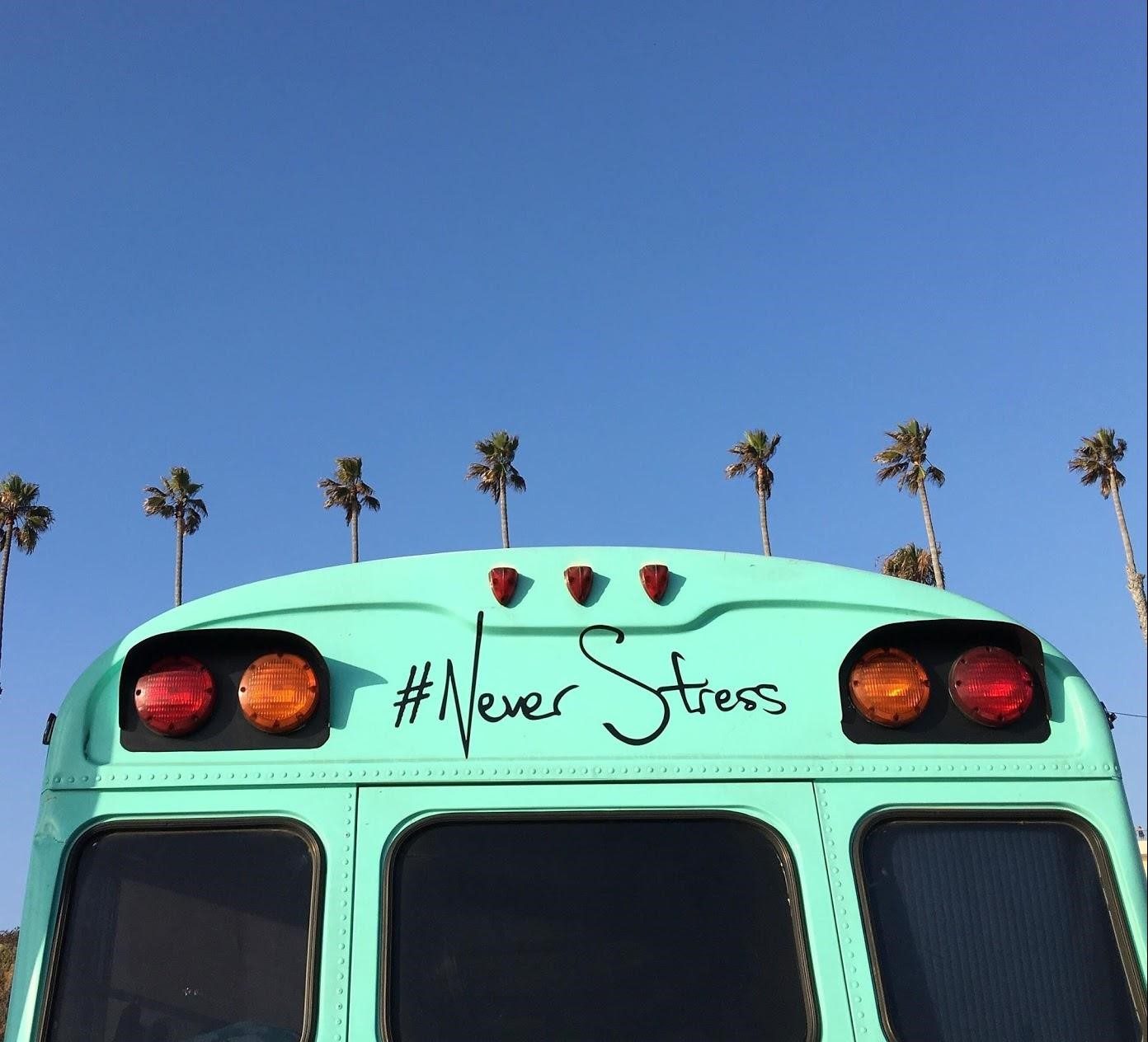
We all experience stress. However, we respond to this stress in different ways. Sometimes low levels of stress can actually be helpful as it could motivate you to study for an exam. Although the experience of stress is very subjective, stress elicits physiological, emotional, and cognitive reactions in us all. To deal with these stressors, we mobilize resources for coping with the problems confronting us. The success of our coping efforts will depend on ourselves as well as the environmental challenge. For example, most of us have the resources to deal with the stress of a thunderstorm but we might really be challenged if we are confronted with a tornado that comes through our neighborhood. So there are different levels of stressors that we face. In this chapter, we examined the relationship between stressors and coping, we reviewed the different coping styles and the relationship between individual and context and coping outcomes, including resilience. We hope that this review of stress has provided you with some new insights about how you might use a variety of coping strategies to deal with stress and to work toward the reduction of stress among others.
Critical Thought Questions
Take the Chapter 13 Quiz
View the Chapter 13 Lecture Slides
____________________________________________________________________
Aldrich, D. P., & Meyer, M. A. (2015). Social capital and community resilience. American Behavioral Scientist, 59(2), 254–269. https://doi.org/10.1177/0002764214550299
Barker, G. (2007). Adolescents, social support and help-seeking behavior. An international literature review and programme consultation with recommendations for action. Geneva, Switzerland: Instituto Promundo, Brazil.
Chen, E., & Miller, G. E. (2012). “Shift-and-Persist” strategies: What low socioeconomic status isn’t always bad for health. Perspectives on Psychological Science, 7(2), 135-158.
Clarke, A. T. (2006). Coping with interpersonal stress and psychosocial health among children and adolescents: A meta-analysis. Journal of Youth and Adolescence, 35(1), 11-24.
Folkman, S., & Moskowitz, J. T. (2005). Coping: Pitfalls and promise. Annual Review of Psychology, 55, 745-774.
Garmezy, N. (1974). Children at risk: The search for the antecedents of schizophrenia. Part I. Conceptual model and research methods. Schizophrenia Bulletin, 1(8), 14- 90.
Jason, L.A., Glantsman, O., O’Brien, J. F., & Ramian, K. N. (2019). Introduction to the field of Community Psychology. In L. A. Jason, O. Glantsman, J. F. O’Brien, & K. N. Ramian (Eds.), Introduction to Community Psychology: Becoming an agent of change. Retrieved from https://press.rebus.community/introductiontocommunitypsychology/chapter/intro-to-community-psychology/
Jason, L. A., & Burrows, B. (1983). Transition training for high school seniors. Cognitive Therapy and Research, 7(1), 79-92.
Luthar, S. S., Crossman, E. J., & Small, P. J. (2015). Resilience and adversity. In R. M. Lerner and M. E. Lamb (Eds.), Handbook of Child Psychology and Developmental Science (7th ed., Vol. 3, pp. 247-286). New York, NY: Wiley.
Lawlor, J. A., Hunter, B. A., Jason. L. A., & Rosing, H. B. (2014). Natural mentoring in Oxford House recovery homes: A preliminary analysis. Journal of Groups in Addiction Recovery, 52, 126–142.
Lazarus, R. S. (1993) Coping theory and research: Past, present, and future. Psychometric Medicine, 55, 234-247.
Lazarus, R. S., & Folkman, S. (1984). Stress, Appraisal, and Coping. New York: Springer.
Masten, A. S. (2001). Ordinary magic: Resilience processes in development. American Psychologist, 56, 227-238.
Patel, S. S., Rogers, M. B., Amlôt, R., & Rubin, G. J. (2017). What Do We Mean by ‘Community Resilience’? A Systematic Literature Review of How It Is Defined in the Literature. PLoS currents, 9, ecurrents.dis.db775aff25efc5ac4f0660ad9c9f7db2.
Wright M. O., Masten A. S., & Narayan A. J. (2013) Resilience processes in development: Four waves of research on positive adaptation in the context of adversity. In: Goldstein S., Brooks R. (Eds.) Handbook of Resilience in Children. Springer, Boston, MA
Skinner E. A., Edge, K., Altman, J., & Sherwood, H. (2003). Searching for the structure of Coping: A Review and Critique of Category Systems for Classifying Ways of Coping. Psychological Bulletin, 129(2), 216-269.
Werner, E. E. (1996). How children become resilient: Observations and causations. Resiliency in Action, 1(1), 18-28.

Chapter Fourteen Objectives
By the end of this chapter you will be able to:
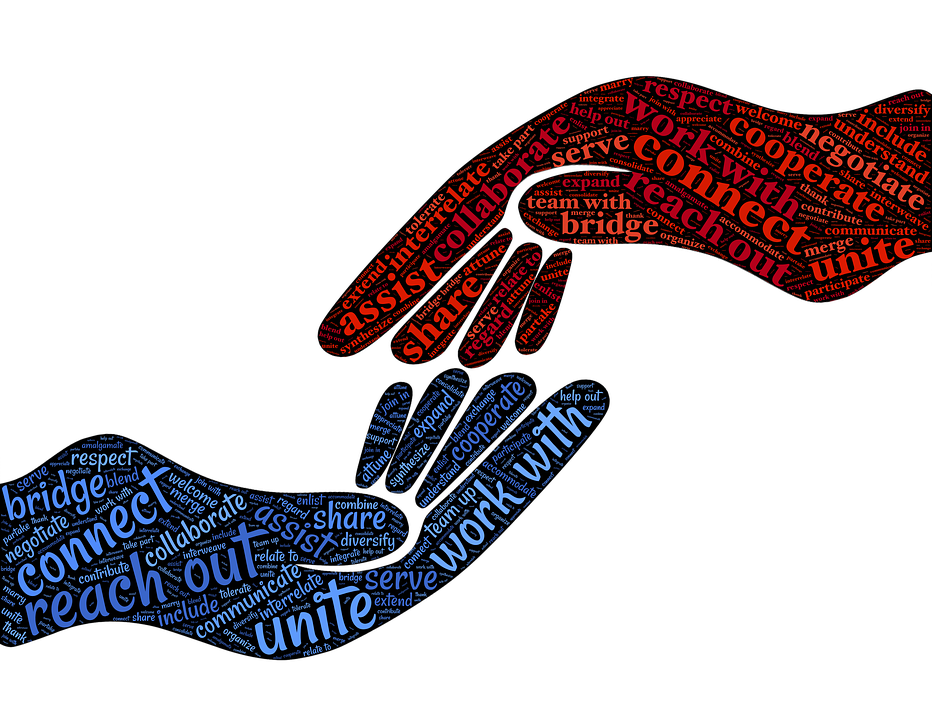
Maria had to take out thousands of dollars in student loans to afford college tuition, and then she had to spend a large percentage of her post-graduation income paying off those loans. This is not an unfamiliar story, and more and more college students face this situation. In fact, millions who attended college seeking an education and a better life now face crippling student loan debt. For example, in the US, student loan debt totals $1.5 trillion dollars, increasing by nearly 400% in the last 30 years and more than tripling since 2005. This loan crisis is now causing financial strain to many who are trying to repay their student loans, disproportionately impacting low-income students of color (Miller, 2017).
This chapter is about policies that often are not visible but create these types of hardships, and it will often take a historical perspective to see the reasons so many have diminished life opportunities and long-term financial hardship. Let’s examine some of the public policies that have caused this problem. Tuition costs for both public and private institutions have risen, state investments in higher education have been reduced, and many student loans are now privatized. The solution to the student loan problem will require policy changes such as increasing grant aid awarded to low and middle-income students, and passing legislation that would make tuition more affordable. Even more daring and bold policies are being tried such as waiving tuition costs entirely. In 2018 New York University’s School of Medicine began waiving tuition fees for all students in an effort to ease both student debt and the ongoing physician shortage. Kasiser Permanente’s new medical school will also be free to attend. Other academic institutions are trying to reduce or eliminate tuition by asking students to pay the schools a small amount of their earnings following graduation. These are examples of real policy interventions that can help revolutionize the problem of excessive student debt.
But there are other ways that we can make a difference as community psychologists. For example, offering free online college textbooks is another way of lowering economic burdens that students encounter at school, indicated in Case Study 14.1.
Case Study 14.1
Free Online Textbook

When the DePaul University Library surveyed students about the impact of textbook affordability on their education, almost 1,000 students completed the survey within the first week. Many students indicated that the cost of textbooks was negatively affecting their lives. Students reported choosing not to purchase textbooks or purchasing them later in the quarter. Of those who did not purchase a textbook, 41.6% cited cost. 56% of the respondents were in their first two years at DePaul and reported receiving a poor grade because they could not afford the textbook for their course. The authors of this book decided to try to make a small difference by developing this free online textbook (Jason, Glantsman, O’Brien, & Ramian, 2019), which we hope will help to reduce this economic burden on our undergraduates taking an introductory course in Community Psychology. We consider this very consistent with the values of our field. The authors also worked for almost two years developing a Society for Community Research and Action (SCRA) “Student Associate” free membership status for undergraduates, and this is very much within the tradition of second-order policy change by lowering barriers to active participation in SCRA.

When our new free textbook was introduced in a Community Psychology course at DePaul University, the immediate reaction was very positive (the students uttered a collective sigh of relief) as they mentioned how grateful they were for not having to purchase it. A typical reaction was “This is wonderful, a free textbook!” Our work with this textbook is part of a larger movement to provide textbooks free, online, and available to everyone, and this movement is growing every day. These types of very real structural changes really can make a difference. In this chapter, we will provide an overview of what public policy is and how community psychologists engage in this work to address the underlying roots of the problems we face. This chapter will also provide ways you can become involved with public policy.

Almost every aspect of our lives is impacted by public policy. Public policy is broadly defined as the laws, regulations, course of action, and funding priorities issued by the government to address a social issue at the local, state, and national level. Essentially, social change often requires the development of a new policy or the revision of an existing policy. Public policies can address societal issues in different areas, including education, healthcare, housing, mental health, immigration, and crime. Policies in these areas can have a far-reaching and long-lasting impact on individuals and communities. Policies also vary in scope. For instance, the legalization of same-sex marriage, how much funding is allocated towards public libraries and colleges, and even what is served for lunch at public schools are all examples of public policy.

The impact of policies can also transcend nations by having a global effect. Countries with environmental policies that fail to regulate the use of resources and reduce pollution are making the world less habitable for everyone. The burning of fossil fuels – such as oil, natural gas, and coal—increases greenhouse gas emissions which causes the earth’s climate to rise to warmer than normal temperatures. The solution to this problem will require new policies that will cause countries to switch from using fossil fuels to using greener and more renewable sources of energy (such as solar or wind power). Some may wonder if we can ever be successful with such a daunting goal. Well, others have realized their dreams, such as Mahatma Ghandi who repeatedly confronted the British-controlled government with acts of civil disobedience to bring about freedom for India. The struggle to gain India’s freedom took a long time, and this long-term perspective is often needed to deal with the many policy actions that are causing current problems such as climate change.
Policies created to address specific social issues can either be effective or ineffective. One example of an effective policy is The Housing Choice Voucher Program created to address the lack of affordable housing for low-income households and homelessness by providing rent subsidies. This program has proven to be highly effective in reducing and preventing homelessness and helping low-income families remain housed (Wood, Turnham, & Mills, 2008). On the other hand, mass incarceration as a means to deter drug use is an example of an ineffective policy. As indicated in Chapter 1 (Jason, Glantsman, O’Brien, & Ramian, 2019), the war on drugs (which has led to increased use of harsher drug laws) and three-strike laws (which result in life sentences for drug offenses) have proven to be ineffective in preventing drug use. Rather, these policies perpetuate the incarceration cycle among those with substance use disorders.
Through research and advocacy, community psychologists have directly influenced public policy to produce second-order change. The work on subsidized housing programs is one way to end homelessness. Another Community Psychology example involves work with Oxford House, described in Chapter 1, where over 20,000 people today live in these democratic, self-governing homes. Yet there are communities that oppose sharing their neighborhoods with group homes for people with disabilities or substance use disorders. For example, some cities have tried to pass laws that make it illegal for more than five unrelated people to live in an Oxford house—and this deliberately targets recovery homes which usually need six to ten house members to make rent affordable. Case Study 14.2 is an example of working at the judicial level in order to preserve access to affordable housing for those with substance use disorders.
Case Study 14.2
Not in My Backyard
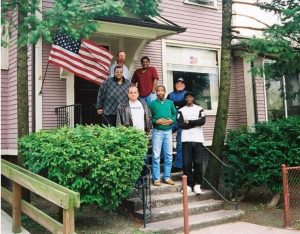
Leonard Jason was called by a lawyer who asked for help with a dispute involving a town trying to close the local Oxford House recovery home by passing legislation whereby no more than five unrelated individuals could live in one home. But small homes of this size are very difficult to sustain as there are too few people to pay for the house expenses. This is an example of Not in My Backyard thinking, where some community members try to exclude those in recovery homes from their neighborhoods. Jason quickly looked into a national Oxford House data set and examined how the number of residents in Oxford House affected residents’ individual outlooks for recovery. He and his research team found that larger house sizes, of eight or more residents, actually had less criminal and aggressive behavior than houses with fewer residents. The findings were influential: they were used in this court case and others to successfully argue against closing larger house size Oxford Houses (Jason et al., 2008). The founder of these Oxford Houses, Paul Molloy, sent this note to Jason regarding one judicial case that was resolved with the help of these data: “The dispute has been ongoing for six years! The town will pay attorney’s fees, which are about $105,000 and a fine to the Department of Justice. The key to their decision appears to be your research showing that larger houses had better outcomes than the smaller ones. Thanks. Once again reason and logic prevailed.”
When involving yourself with public policy, it is possible to make a difference, as Case Study 14.2 shows. The following sections provide an overview of the many ways in which community psychologists can influence public policy.

Efforts at the public policy level have always been at the forefront of the efforts of community psychologists to address social issues. Work at this level is considered a core competency for Community Psychology practice and is described as the ability to develop effective working relationships with policymakers, elected officials, and community leaders (Dalton & Wolfe, 2012). To meet this competency, community psychologists are trained in a variety of skills including how to write brief statements used to influence politicians, how to translate research findings into policy recommendations, how to build advocacy coalitions with various community organizations, and how to develop good communication and relationship-building skills.
Public policy interventions often focus on a second-order/systems change approach to address the systemic issues such as the inequitable distribution of resources. Importantly, Community psychologists value of involving individuals affected by an issue in the policy formulation and implementation process.
Often work at the public policy level involves prevention. Community psychologists have worked in public policy at the local, state, and national levels, in the areas of substance abuse prevention, school violence prevention, and HIV/AIDS prevention. As an example, Case Study 14.3 describes policy work that has focused on social-emotional learning to enhance positive youth outcomes.
Case Study 14.3
Social-Emotional Learning in Schools
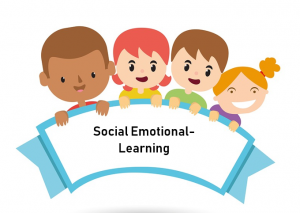
Students within K-12 educational settings can be supported through policies and programs that promote positive youth development and prevent negative outcomes. One example of an effective prevention program developed and implemented involves social-emotional learning, which equips students with tools to set and achieve goals, handle their emotions, interpersonal relationships, and life events, and to engage in responsible decision-making. A leader in this field is the Collaborative for Academic, Social, and Emotional Learning, which have been working to extend programs involving social and emotional learning to school children for more than two decades. This organization, founded by community psychologist Roger Weissberg, collaborates with leading experts and supports districts, schools, and states nationwide to drive research, guide practice, and inform policy. The Collaborative for Academic, Social, and Emotional Learning supports federal efforts to increase funding for research and evidence-based practice related to social and emotional learning. Through their Collaborating States Initiative, they work with 25 states to support social and emotional learning, and all 50 states have incorporated this approach into their preschool standards; a growing number are doing the same for grades K-12. Learn more by viewing their State Scan Scorecard project, Emerging Insights Report, and extensive CSI resources.

There are four stages of working on public policy. They involve (1) agenda setting, (2) policy formation and adoption, (3) policy implementation, and (4) policy evaluation and revision. The figure above illustrates the cyclical nature of these stages in the policymaking process. Moreover, each phase requires attention to relationships and communication amongst diverse stakeholder groups. Groups involved in public policy include the government advocacy organizations, citizens, and media (as will be indicated below), but first, let’s define these four phases.

(1) Agenda setting. During the first phase of the policymaking process, it is important for those who set policy to take the issue seriously. If, for example, the public officials do not think that climate change is of importance, they will devote little of their time and energy to this issue. So, the agenda-setting phase involves determining whether people with power and influence care about a particular issue. As there are many social problems that may exist in a community or society, only a select number of them might get on the agenda and receive attention for possible action. It is important for community psychologists to work toward bringing attention to an issue so that others will care about it in order to devote time and resources toward improving the situation.
Kingdon (1995) described the process by which a pressing social issue makes it on the policy agenda as three influential “streams.” First, the problem stream involves the range of social issues that may affect a given population, ranging from high levels of unemployment and low levels of available housing, to rates of drug addiction and homelessness within neighborhoods. For example, if a problem affects many people, it is more likely to secure some attention. Second, the policy stream embodies potential solutions that can address each of these social issues, and of course the costs of these solutions. If there are some practical and affordable solutions to the problems, it raises the likelihood of people willing to consider these issues. Lastly, the political stream involves the level of public concern to actually devote time and resources to one of these topics and possible solutions. If the public is more concerned, the topic is more likely to receive attention.
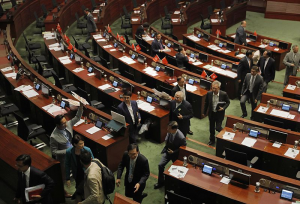
(2) Policy formation and adoption. In the second phase, a solution to address the social issue is adopted. As an example, if inadequate funding for public schools is agreed upon as an issue needing attention, the politicians could pass laws that channel more funds to schools. The primary places where these types of actions might occur are in legislative bodies, in which elected officials vote on laws.
But policies can also be adopted at the executive level by someone in a high position, such as a president or mayor of a city. A president can create policy through executive orders, such as the “Travel Ban “(E.O 13769), which tried to limit the ability of individuals wanting to travel to the US. In addition to a president, agencies within the executive branch can adopt policies. For example, the Department of Housing and Urban Development is an executive agency that has been able to move resources into Housing First, which was described in Chapter 1 as an important solution to the homelessness problem in the US.
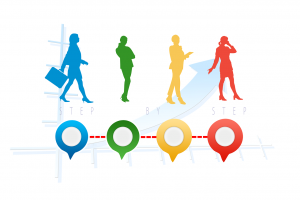
(3) Policy implementation. Once a policy is adopted, there are many different ways it can be implemented. A well-thought-out policy can be adopted but if limited or inadequate funds are provided for it to be carried out, it is unlikely to have any effects. For example, a prevention program introduced into a school classroom might be compromised and much less effective if the school district has policies which result in inadequate funds being provided for books and other resources such as staff wages.
(4) Policy evaluation and revision. The last phase of the policy process is the policy evaluation and revision phase. During this phase, an effort is made to determine if the policy had its intended outcomes, and whether it can be improved to more effectively address the social issue. The policy might need to be replaced with an improved policy or terminated in its entirety. For example, the No Child Left Behind Act aimed to address educational inequity by increasing the government’s role in holding schools accountable for the academic progress of their students. This law put an emphasis on standardized testing by implementing frequent assessments measuring students’ educational improvement and rewarding the schools with the highest assessment scores. No Child Left Behind was found to have unintended consequences such as placing too much emphasis on testing, and it even resulted in some school closures. There are now efforts to revise and even replace this set of policies.
Overall, the policymaking process illustrates the cyclical and recursive nature of public policy. As demonstrated by the descriptions of the four phases, there are several points in the policy process through which community psychologists can engage in policy efforts. The ways in which community psychologists engage in this cyclical process are discussed in the next section.
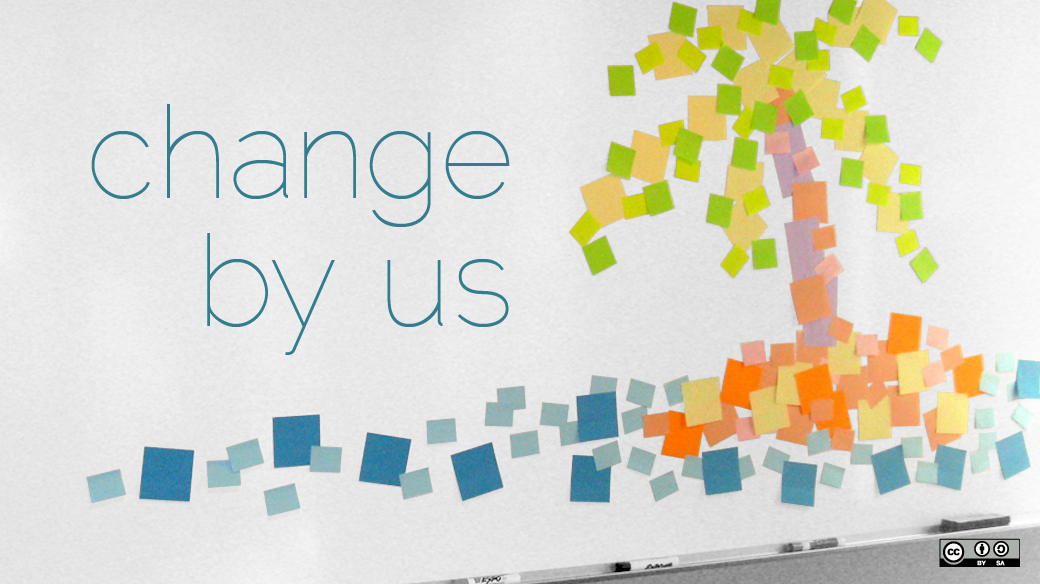
Community psychologists can influence public policy at any step of the policymaking process by working alongside or within advocacy groups. Advocacy groups, community psychologists, community members, and policymakers are all involved in these policy decisions. Some of the key players on the policy front can be large intermediary organizations such as professional membership organizations, foundations, and research and evaluation firms. For instance, community psychologists can work with Mathematica or the Urban Institute, which are research and evaluation firms that are hired by federal agencies to conduct policy evaluations. Foundations like the William T. Grant Foundation also provide opportunities to engage in policy work, given their focus on funding policy initiatives that address social issues which are important to community psychologists. In fact, the Collaborative for Academic, Social, and Emotional Learning, which was described in case study 14.3 was begun by a grant from the William T. Grant Foundation. Community psychologists also work with other types of advocacy organizations including member-led social action groups (e.g. Black Lives Matter) or even small informal groups (e.g. a group of students and teachers advocating for funding for afterschool programs).
SCRA is one example of an intermediary organization that is the central professional home of many community psychologists. This organization is open to researchers, practitioners, and students (and as stated in case study 14.1, you can be an Associate Student member at no cost). Advocating for federal and legislative policies that promote social justice is an important goal of SCRA. This organization issues policy statements to take public positions on social issues offers research and scientific evidence that support their positions and provides recommendations to policymakers and other stakeholders. The first public policy statements SCRA released was on the role of recovery homes in promoting long-term addiction recovery and can be viewed here. SCRA also releases rapid responses, which are public stances and action plans on policy issues that are time sensitive and require immediate action. In addition, SCRA has a Public Policy Committee, which provides members with resources and training to facilitate their policy involvement.
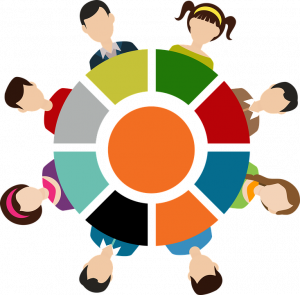
Many community psychologists are engaged in policy advocacy work as researchers within universities. As faculty members, community psychologists are able to contribute to policy in many different ways. For example, Community Psychology faculty can develop expertise in a given policy area, generate research findings with specific policy implications and recommendations, advocate for policies that are empirically supported, and work as policy consultants for advocacy organizations like the ones described above. Most of all, university faculty educate students on policy-relevant issues and provide ways they can become involved in policy advocacy.
In addition, community psychologists can work as policy insiders within local, state, and federal levels of the government. Policy roles within the government can be obtained through direct election, appointment by an elected official, or by obtaining employment as a civil servant. Some examples of these roles include working as a congressional staffer or working as a member of a local school board. Working as policy insiders within the government allows community psychologists to oversee policy implementation and possibly the creation of new legislation.
There are several methods through which community psychologists can work in public policy. The following methods may be used throughout the four stages of the policymaking process:
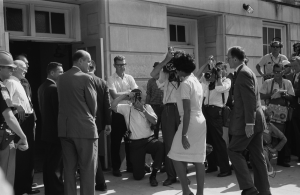
Research. As mentioned earlier, research is a key tool community psychologists use to influence policy and there are different types used to influence policy (National Academy of Science, 2012). One of these ways is conceptual research, which is used to educate policymakers and stakeholders on social issues and propose possible solutions. Community psychologists often use this type of research to help policymakers view a social issue as a systemic problem caused by ineffective and harmful policies rather than individual deficits. Such research has been used to show how segregation leads to increased stigma for those being excluded from the mainstream. A prime example of how conceptual research influenced policy is the historic U.S Supreme Court’s decision in Brown vs Board of Education, which led to the desegregation of schools. Conceptual research by psychologists Kenneth and Mamie Clark (1947) demonstrated the harmful psychological effects of segregation, which was cited by the Supreme Court as having played a crucial role in their decision that racial segregation of schools was inherently unethical and unconstitutional.
Instrumental research can be used to persuade policymakers to adopt a policy. Over the past few decades, the disability community has used policy interventions to bring about major changes to the ways that individuals with disabilities can have greater access to opportunities. These include altering pavements and curbs at intersections so they allow people in wheelchairs to safely navigate through them, and providing individuals with movement disabilities access to buildings, public transportation, and parking spots (Jason & Jung, 1984).
Consultation. Community psychologists often act as consultants in public policy by sharing their research and advocacy expertise with organizations or governmental agencies. This often begins when community psychologists develop personal relationships with policymakers and government officials. Consultation is a way of influencing policy (Block, 2006) by providing policymakers with relevant evidence and data. Community psychologists, during the consultative process, have been instrumental in providing content-level expertise on current efforts to reduce human trafficking and to condemn hate and terrorism by white supremacists.
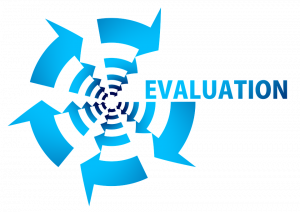
Program evaluation. Evaluation is important across the policymaking process, but particularly within the policy implementation and evaluation stages. In evaluation, community psychologists might aim to examine whether a social program works well, who it works well for, under what conditions it works well, and whether it can work better (Miller, 2017). For example, the Meals on Wheels program delivers meals to older adults in need to help with their nutrition as well as reduce their isolation. Evaluations of this program have found a number of positive outcomes for meal recipients, and the findings from the evaluations have been used to make the programs even more effective.
Coalition-building. Community psychologists also use their communication and relationship-building skills to form coalitions with community members, organizations, and policymakers. Members of a coalition share a common policy interest and agree to work together to influence or develop a public policy. Forming and maintaining coalitions is an effective way to influence policy. Nelson Mandela, imprisoned for decades in South Africa, inspired coalitions to continue their activist work, and these coalitions were eventually successful in abolishing the system of apartheid.
Media and written communication. Community psychologists use a variety of communication methods to influence public policy. For example, they can share knowledge as guests on multimedia outlets like news radio, television, or podcasts. More commonly, community psychologists can influence policymaking decisions through written communication in “white papers.” These concisely provide scientific evidence and recommendations directly to those in decision-making positions. Communication strategies vary depending upon the audience. For example, appearances on podcasts and public radio may be informal, to target voters in order to garner support for a public policy issue. Providing “white papers” to congressional officials, on the other hand, requires concise written language with straightforward suggestions that are sensitive to the policymakers’ busy schedules. When coal miners have been killed by negligent mining practices, white papers and publicity surrounding their deaths led to better laws and regulations. These types of tragedies have been used to highlight and bring attention to abuses of power, which have been used by policy activists to change the status quo and bring about social justice. Another example is Rachel Carson’s influential book Silent Spring, which powerfully identified abuses in the use of pesticides and helped start the global environmental movement.
There are many ways in which students and community psychologists can get involved with public policy. Below are some practical suggestions:
Choosing an issue to advocate for. There are many social issues that require advocacy and many social issues with which we may be interested in getting involved. Before getting involved in public policy work on a particular issue, it is important to examine which issues are most aligned with your interests, skills, and access to resources like time, funds, materials, or energy. One way that you can examine your competencies related to an issue is through the Advocacy Self-Assessment (Jason, Beasley, & Hunter, 2015).
Practical Application 14.1
Advocacy Self-Assessment Tool
To complete the self-assessment in this activity box, first consider several social issues with which you are interested in engaging in advocacy work. Once you have selected the social issues, complete the self-assessment questions for each social issue. Then, total up your scores for each issue to determine which received the high score. This will help you determine what you are most passionate about.
Using the range below, rate your agreement to each question for each of your chosen issues. Once you have determined which social issues might best fit your advocacy competencies and commitment, consider making a plan for your involvement. For the issue you score highest on, develop a plan to advocate directly and indirectly to initiate social change through policy.
1 = Strongly Disagree, 2 = Disagree, 3 = Neither Agree/Disagree, 4 = Agree, 5 = Strongly Agree
COMMITMENT
CENTRALITY
RESOURCES
Stay informed. Listen to the news and stay informed of current events occurring both locally and at a national level. This could even include following current bills and resolutions being presented before your city council or congress, procedures to be implemented by executive offices (e.g. Department of Education), or cases to be heard before the Supreme Court. A useful tool is the GovTrack website, which shows where bills and resolutions are within their legislative process.

Contact policymakers. There are several ways in which you can communicate with policymakers at all levels of government. Federal elected officials have offices in your cities and towns, as well as in Washington D.C., to whom you can write letters or make phone calls. Similarly, state elected officials can be reached by phone and by mail at their neighborhood or state offices. Another way to interact with policymakers is through social media (e.g., Twitter) or through email in which you can express your concerns and opinions about ongoing legislation. You can find out who your elected officials are by visiting this website. A helpful resource for contacting elected officials is Resist Bot (which automates faxes and messages from your cell phone).
Policy and advocacy organizations. There are many opportunities for getting involved with existing policy organizations. If you have an interest in a particular social issue, such as rising economic inequalities, you can find local and national organizations that are focused on that work. A good way to get informed is to ask to be listed on an organization’s email list and follow them on social media. Getting connected to organizations may allow for engagement through events, town halls, or event Capitol Hill days in which organizations arrange visits to legislative offices to speak with policymakers. Furthermore, students may also explore working with the organization through volunteer or internship positions.
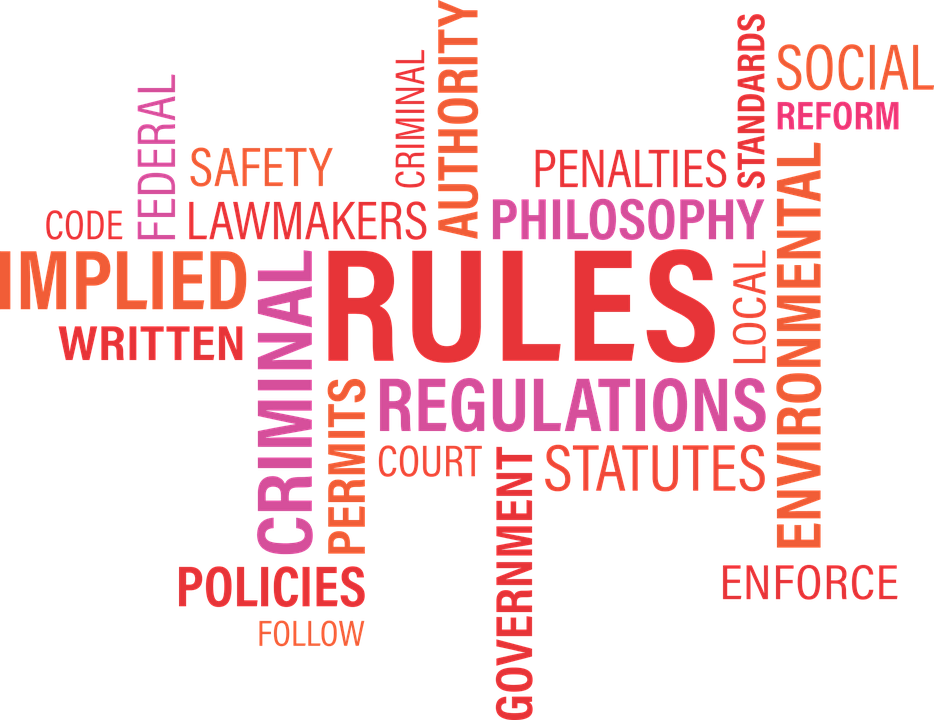
Engaging in policy work is not easy. There are many challenges that community psychologists often will need to overcome when attempting to influence policy. A major challenge in policy advocacy is that it can take many years before a policy is adopted, implemented, and revised. The key lesson learned by community psychologists is to stay committed to a social issue for the long run. Another major challenge community psychologists face is navigating issues of power when working with policymakers and advocacy organizations. For example, powerful stakeholders with different vested interests may actively try to stand in your way. Policy work requires effectively navigating these challenges.
The topic of school shootings illustrates all these complexities. For example, does the community find this topic to be a pressing issue? Concern for school shootings may arise from public feedback or an event related to the issue. For example, school shootings may be perceived as a more pressing social issue directly after a shooting occurs in a community. Many solutions may be proposed and compared with one another. These solutions offered for school shootings have included the restriction of access to weapons, increasing school security personnel or procedures, and some have even advocated increasing access to guns by teachers. Further, the costs, feasibility, and availability of evidence for each of these solutions need to be evaluated as potential policy solutions. Finally, issues of partisanship can emerge. For example, membership to the Republican or Democratic party may influence how receptive a policymaker is to consider a policy to address school shootings. Moreover, broader cultural and societal moods about guns and school violence can influence how a policymaker considers addressing school shootings through policy.

Several principles of social change have been used as a guide to initiate and sustain change, as well as to navigate some of the challenges that arise in policy work (Jason, 2013). For example, it is important to see the big picture and be careful to identify who the power holders are. Often they like to see things stay the same, particularly if they are gaining resources and privileges in these roles. When identifying power holders, it is useful to understand their motives for continuing to maintain control, and the influence and power that they wield. Certainly, the National Rifle Association has a powerful role in shaping the dialogue on the availability of guns, and their position has contributed to the wide availability of guns throughout the US. To bring about structural and long-term second-order change, rather than just short-term fixes to a problem, it is often useful to work with coalitions and other allies in order to form strategies to confront those who are abusing the power. Often youth who have been traumatized by a school shooting, as well as parents of children who have been killed, have become powerful agents of change, trying to reduce the availability of guns. Being willing to stay committed to an issue over time is another helpful strategy, as it provides opportunities to know the central gatekeepers who might need to be dealt with to bring about second-order change. Ultimately, the situation in the US with school shootings will require patience and persistence, and savoring small wins is crucial to sustaining the motivation to work toward long-term goals.
Throughout this policy process, intuition is an essential quality that is relevant, as it often involves a feeling or sense of next steps that need to be taken in strategic coalition building or political action. Having an intuition that one’s vision will be fulfilled in the long run can be a sustaining and life-affirming force in the face of oppressive conditions. Social policy change leaders will often rely on conjuring up a dream and sustaining it with intuition in order to overcome the obstacles that are faced in community work.

While full participation and involvement are dominant themes within this textbook, the remnants of elitism and non-democratic processes have been present through recorded history, and continue to be widely present today. Anyone can do the following experiment: Think about the setting you spend time in such as your college. The Democracy Quiz question is “Who has the power to make decisions?” This deceptively simple question can inform us about whether there is any power-sharing when decisions are made or whether an elite, non-elected group are firmly and totally in charge of decisions. Change at this level will ultimately involve policies that have been reviewed within this chapter and this book.
Today, millions of Americans are locked up or controlled in total institutions whether they are substance abuse treatment settings, nursing homes, mental institutions, prisons or even schools. If one were to administer our Democracy Quiz in such settings, the answers would be telling. In many cases, the participatory spirit of decision-making would be hardly noticeable. For those with fewest resources, for those with greatest needs, for those with the least opportunities, there is minimal input on decision-making. In other words, few democratic-type settings are available for those who are discharged from substance abuse treatment facilities, prisons, or mental institutions. Often with no extended supportive families, they need settings where they can participate as full members, with responsibility and dignity. It is at the policy level that we need to institute many change efforts for those most in need. The broadening self-help moment described throughout this textbook show us the possibilities when individuals with assorted afflictions are provided decision-making responsibilities and power.
To address many of the difficult policy level problems that we face, it is often important to take a few steps back and consider a historical perspective that accounts for changes that have put our world at risk for its current problems, and provides a way to explore and eventually address these problems on a deeper policy level (Jason, 1997). Throughout history, it was within the village that people helped one another, not out of charity, but because it was the natural way of life. The positive features of mutual respect, shared goals, cooperation, and neighborliness were strong features that provided nurturance and meaning. But over time there has been a weakening of long-term bonds with the land, family, and community and a reduction of a sense of coherence, and as well as interest, in community participation. Policy level intervention could include goals to support and enhance practices where everyday life is imaginatively transformed and saturated with meaning. At the deepest levels, our interventions might strengthen rituals and customs which make life more vital, energizing, and comprehensible. Policy interventions that consider these factors might provide us the guidance on how to strengthen our collaborations and connectedness to one another and to the world in a larger sense.
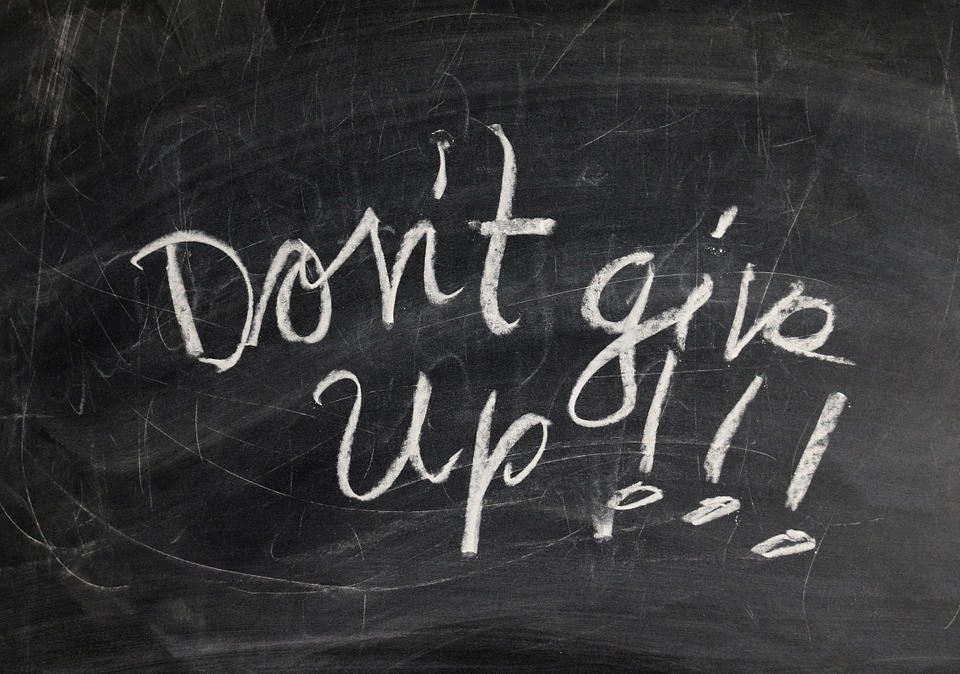
We began this foray into the policy arena by considering mounting student debt, an issue that is complicated and ultimately will need to be solved by addressing the many streams that have influenced this unfortunate situation. Often whether it is dealing with student debt, poverty, or increasing economic inequalities, there are historical factors that will need to be understood so we can both understand what has caused these problems and what policies might be considered.
This type of work at the policy level will often need a long time commitment, and sticking with these types of issues will more likely occur when you are really invested and committed to a social issue. If the problem is not important to you, it is less likely you will continue to fight for change when the inevitable disappointments and feelings of frustration occur. We can look for guidance from those who battled for civil rights and women’s rights, as these struggles occurred over decades. These activists have demonstrated that with a policy perspective, it is possible to overcome even the most significant problems to reach our social justice goals.
Critical Thought Questions
Take the Chapter 14 Quiz
View the Chapter 14 Lecture Slides
_____________________________________________________________________
Block, P. (2006). Flawless consulting: A guide to getting your expertise used. Learning Concepts/University Associates. Austin, TX.
Clark, K. B., & Clark, M. P. (1947). Racial Identification and Preference in Negro Children. Readings in Social Psychology, 602-611.
Dalton, J., & Wolfe, S. (2012). Competencies for community psychology practice. The Community Psychologist, 45(4), 8-14.
Jason, L. A. (1997).Community building: Values for a sustainable future. Westport, CT: Praeger.
Jason, L. A. (2013). Principles of social change. Oxford University Press.
Jason, L. A., Beasley, C. R., & Hunter, B.A. (2015). Advocacy and social justice. In V. Chien & S. M. Wolfe (Ed.). Foundations of Community Psychology Practice. (pp. 262-289) New York: Sage.
Jason, L. A., Groh, D. R., Durocher, M., Alvarez, J., Aase, D. M., & Ferrari, J. R. (2008). Counteracting “Not in My Backyard”: The positive effects of greater occupancy within mutual-help recovery homes. Journal of Community Psychology, 36, 947-958.
Jason, L. A., Glantsman, O, O’Brien, J. F. & Ramian, K. N (2019). Introduction to the field of Community Psychology. In L. A. Jason, O. Glantsman, J. F. O’Brien, & K. N. Ramian (Eds.), Introduction to Community Psychology: Becoming an agent of change. Retrieved from https://press.rebus.community/introductiontocommunitypsychology/chapter/intro-to-community-psychology/
Jason, L. A., & Jung, R. (1984). Stimulus control techniques applied to handicapped-designated parking spaces. Deterring unauthorized use by the non-handicapped. Environment and Behavior, 16, 675–686.
Kingdon, J. W. (1995) Agendas, alternatives, and public policies (2nd Ed.). Boston, MA: Little, Brown, and Company.
Miller, B. (2017, October 19). New federal data show a student loan crisis for African American borrowers. The Center for American Progress. Retrieved from https://www.americanprogress.org/issues/education-postsecondary/news/2017/10/16/440711/new-federal-data-show-student-loan-crisis-african-american-borrowers/
Miller, R. L. (2017). The practice of program evaluation in community psychology: Intersections and opportunities for stimulating social change. In M. A Bond, I. Serrano-García, & C. B. Keys (Eds.), APA Handbook of Community Psychology: Methods for Community Research and Action for Diverse Groups and Issues (Vol. 2). Washington, DC: American Psychological Association.
National Academy of Science (2012). Using science as evidence in public policy. Washington, DC: Author.
Wood, M., Turnham, J., & Mills, G. (2008). Housing affordability and family well‐being: Results from the housing voucher evaluation. Housing Policy Debate, 19(2), 367-412.

Chapter Fifteen Objectives
By the end of this chapter you will be able to:
“The basic requirement for the understanding of the politics of change is to recognize the world as it is. We must work with it on its terms if we are to change it to the kind of world we would like it to be. We must first see the world as it is and not as we would like it to be.”
— Saul Alinsky, Rules for Radicals

At some point, everyone wants something about their community—or how their community is treated—to change. Maybe they feel a law is unfair, or wish their group had more resources. One way to accomplish community goals is to engage in community organizing, or the act of engaging in cooperative efforts to promote a community’s interests. Just as there are many things people may wish to change, community organizing comes in many shapes and forms and can be used to initiate small changes within a community or larger changes throughout society. Engaging in community organizing involves actively cultivating relationships with a number of people, some of whom may have different ideas about solutions. If it sounds complicated, that’s because it is! Thankfully, we have many examples of successful community organizing, some of which come from collaborative partnerships.
COLLABORATIVE PARTNERSHIPS

To understand collaborative partnerships, let’s first break down these two terms into their simplest form. A partnership is a mutual relationship between two or more people. This relationship can be hierarchical, as is the case between you and your boss, or equal, like the relationship between you and your co-workers. Collaboration, on the other hand, is an action. Specifically, collaboration is the action of working with one or more people to produce or create something.
Taken together, a collaborative partnership is a reciprocal relationship between two or more people with a shared goal in mind. Collaborative partnerships are often dynamic, characterized by constant change, activity, or progress. Thinking about what you have read so far, what are some examples of collaborative partnerships you have encountered in the case study boxes throughout this book? Before reading further, take a moment to list them. Now that you have revisited the case studies and have a list of collaborative partnerships, are there commonalities between them? Do they differ from what you think of as community organizing? Often in Community Psychology, collaborative partnerships have common themes with and key differences from other forms of community organizing. Let’s take a look at some of these commonalities and differences.

As you may recall from the introductory chapter (Jason, Glantsman, O’Brien, & Ramian, 2019), a major focus of Community Psychology is that of social justice. It is common for community psychologists to develop collaborative partnerships with organizations that serve oppressed groups. As cutbacks in the public sector have become more and more common the past three decades, collaborative partnerships between community psychologists and community organizations have provided one solution to dwindling resources within organizations (Nelson, Prilleltensky, & MacGillivary, 2001). These partnerships can also assist when the organization lacks expertise in certain areas. For example, community psychologist Amie McKibban partnered with the YMCA Caldwell Center in Evansville, Indiana to assist the organization in gathering feedback from the diverse population the center served to better meet their needs. After completing focus groups with the neighborhood residents, Dr. McKibban and her Community Psychology students developed a needs-based survey that was administered to the same residents. As a result, the center was able to write evidence-based grants and obtain funding for different types of programs that better met the residents’ needs (McKibban & Steltenpohl, 2019; see the following case study).
Case Study 15.1
The Caldwell Center Partnership
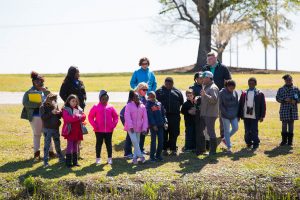
The YMCA Caldwell Center is in the Glenwood neighborhood, a racially diverse, economically disadvantaged area with 46.8% of the residents living below poverty and 53.5% having less than a high school education. The goal of working with this YMCA branch was twofold: the project aided community psychologist Amie McKibban in teaching her students real-world, marketable skills relevant to community psychological research, and the community partners received assistance in developing a tangible product that could be utilized to better serve community members’ needs. This partnership was established through the University of Southern Indiana’s Outreach and Engagement office, which is designed to connect community entities in need of services with researchers on campus. The collaborative effort rested on two demonstrable outcomes for the Caldwell Center: to provide qualitative feedback from different age groups utilizing their services (a bottom-up focus on residents’ needs) and to create a quantitative measurement tool that could be used to collect data more easily and quickly once they ended our partnership.
Collaborative partnerships, as illustrated in Case Study 15.1, are often more formal in nature, designed to meet a specific need of the organization, and have a specified timeline with an end goal. Although not always true, collaborative partnerships tend to take a top-down approach to social change. That is, they tend to be designed by experts or community leaders who are often not part of the community the social change will impact. Top-down approaches carry with them the benefit of expertise and legitimacy, but also run the risk of reflecting the experiences and world views of the experts. In other words, the needs and voices of the community may be lost in translation (Fawcett, et al., 1995). This approach also runs the risk of reinforcing existing power structures, and as you learned in Chapter 1, inequality in power structures is often the root cause of other inequalities, such as poverty and income.
Often, when we think of community organizing, a top-down approach isn’t the first thing that comes to mind. Although this is a beneficial approach in certain settings, sometimes the most powerful forms of social change utilize a bottom-up approach, which originate at the grassroots level. That is, they are designed by community members rather than experts or professionals. An easy way to illustrate this difference is with mental health care. Seeking the services of a therapist is a top-down approach to mental health care. You seek the expert advice of a therapist to feel better. On the other hand, self-help groups represent a bottom-up approach, where you seek the support of others with mental health difficulties to feel better.

Let’s consider another example—that of food insecurity. A top-down approach to food insecurity may include a city mandate that public schools send snacks home with children living in food deserts, where the snacks are provided by those in power. In contrast, a bottom-up approach may include a community garden initiative where local residents plant and tend to gardens, with the food being provided by those living in the food desert. This is precisely what one group of concerned citizens in Evansville, Indiana did when they started the first Urban Seeds community garden in 2005. Their efforts have since grown into a non-profit organization that serves the region of Southern Indiana. Of course, with any kind of partnership, it is important to consider the potential for iatrogenic effects, or unintended consequences. You may find it helpful to talk about values and goals early on in the process of working with community organizations and groups, looking specifically for areas of overlap and differences. It is also a good idea to define important terms, talk about how you will deal with conflict (for example, a disagreement between university researchers and the school district), and discuss how long the relationship will last. Partners should revisit these agreements to make sure any changes are addressed. See Case Study 15.2 for an example and some good ideas to consider.
Case Study 15.2
Innovative Channels of Change in California

Regina Day Langhout and her team worked with an after-school program in Maplewood, California to aid students in designing, researching, and implementing action research in their school. Students learned about research design and methodology, developed and completed actions to address their selected issues, and presented their findings. As the partnership developed, Langhout and her team ran into challenges around limited budgets, power differentials between students and their school institutions, limitations on what projects were considered “worth” pursuing, and what the “right” channels of change were. It was important for Langhout’s team to continue to communicate with students and faculty throughout the partnership and address these challenges as they came up (Kohfeldt, Chhun, Grace, & Langhout, 2011).
Now that you know the difference between these two approaches, think about changes you would like to see in your own community. What type of approach do you feel would be best to achieve that change? Sometimes figuring out which approach may be best can be difficult, and community psychologists generally agree that neither approach is best, as they both offer benefits. Whereas bottom-up approaches tend to embrace the values inherent in Community Psychology, top-down approaches are often needed for their resources—such as funding and expertise. In many cases, like the one described in Case Study 15.1, the two approaches are combined in hopes of achieving the best results.
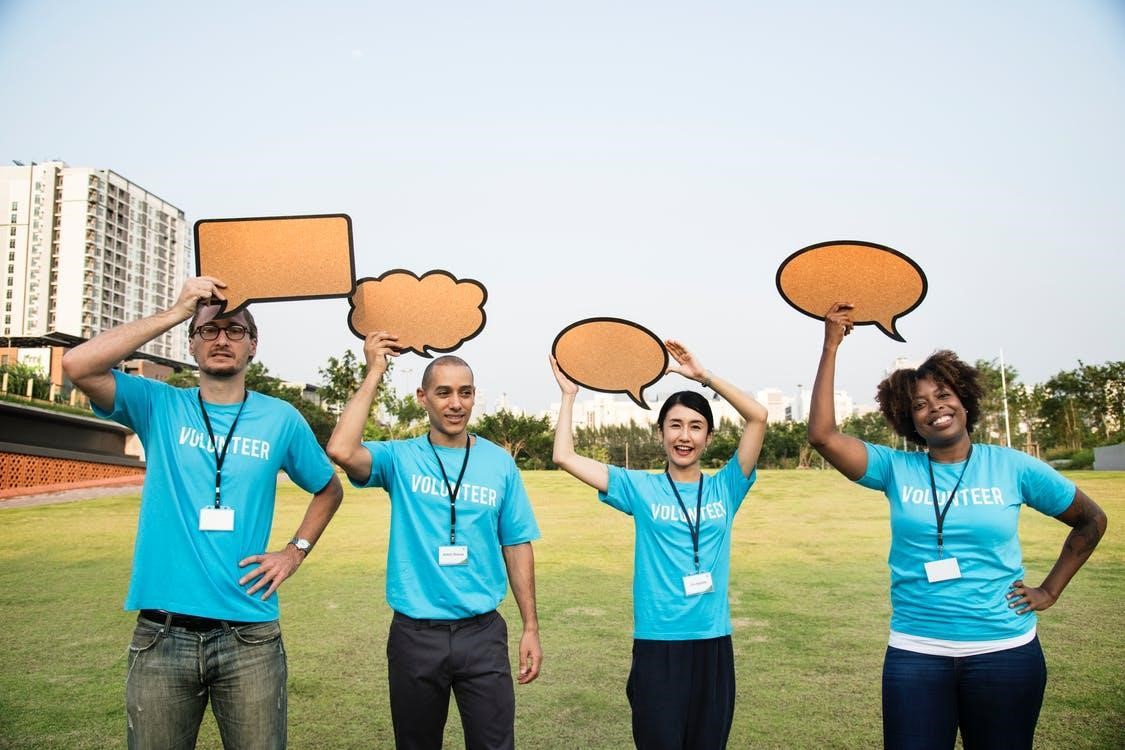
Let’s go back to the things you would like to see changed in your local community. Is there something on that seems insurmountable? Perhaps a problem that seems impossible to change? Oftentimes this is the case when we think about social problems and their solutions. Indeed, some social problems are wide-reaching and require long-term, complex solutions that extend beyond the scope of collaborative partnerships. Community coalitions, on the other hand, tend to tackle larger social issues by bringing together a representation of community citizens and organizations—both private and public—situated in a way to address large social problems at multiple levels within a community. Like collaborative partnerships, community coalitions have become more popular in recent years following cutbacks to funding for social services, therefore putting pressure on communities to do more with less (Nelson, Prilleltensky, & MacGillivary 2001).
Given the organizational structure of community coalitions, members often agree upon a mission, vision, and set of shared values, all of which help coalitions write and implement action plans. These action plans help guide the coalition in their work, whether the work is carried out by the coalition itself or by affiliated organizations (Wolfe, 2001a). Not only do coalitions help strengthen citizen participation, a staple of Community Psychology, they hold the potential to change policy at local and state levels, and increase community resources (Wolfe, 2001b). To illustrate coalitions in action, let’s consider two very different community coalitions—one that came out of a grassroots effort to tackle a host of community issues where the work is done by the coalition itself (Case Study 15.3a), and one that developed over decades of work to decrease economic disparities, where much of the work is carried out by affiliated organizations (Case Study 15.3b).
Case Study 15.3a
Congregations Acting for Justice and Empowerment

Congregations Acting for Justice and Empowerment is an interfaith coalition comprised of 22 religious organizations in Southern Indiana. It started by members of different religious congregations coming together to better understand what community issues were mutually important to them through listening sessions, a practice that continues today and draws hundreds of community members from different congregations. Through these listening sessions, members decide on one or two issues to address throughout the year and develop an evidence-based action plan. One example of how this coalition impacted community practice was their success in reaching an agreement with three county sheriff’s offices and the city fire department to equip officers and firefighters with Narcan, a life-saving medication for drug overdoses.
Watch this this PSA on the success of a similar approach to drug overdoses in Massachusetts.
Case Study 15.3b
The Community Action Program of Evansville
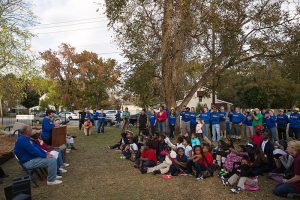
The Community Action Program of Evansville is a multi-organization coalition that developed under the auspices of the City of Evansville in the 1960s with the mission of promoting economic and social self-sufficiency for the area’s racial minority populations. The coalition develops action plans under the guidance of a Board of Directors consisting of representatives from three different counties that represent both the public and private sector. Twenty-four community programs are housed under this coalition— including programs such as Head Start, Financial Literacy for Home Buyers, and Emergency Need Pantry—with multiple organizations carrying out the work. One example of how this coalition impacted community practice was in their development of partnerships to provide affordable, apartment-style housing for multi-person households.
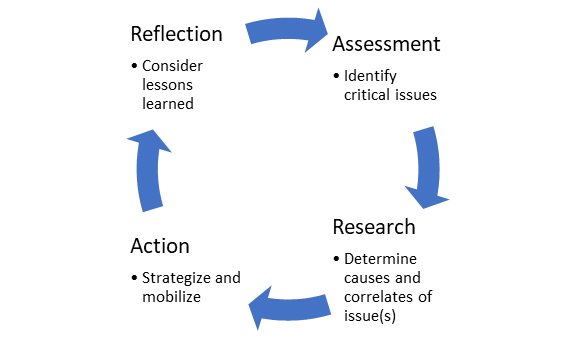
Successful community organizing tends to follow a cycle: assessment, research, mobilization (action), and reflection (Speer, Hughey, Gensheimer, & Adams-Leavitt, 1995). A student organization wanting to improve access to mental health resources on their university campus may first assess what resources already exist on campus. They may also have one-on-one or small group meetings with students, staff, and faculty to better understand their experiences. If they can, they may also do a survey of a representative sample of students. Their main questions may be things like: What issues do students face when dealing with their own mental health? Are students able to meet with counselors when they need to? Are there differences in what groups readily have access to resources? Do faculty know what the process of referring students to various resources on campus looks like?
After this assessment stage, the student organization will want to enter the research stage. Here, it will be important to meet with campus leaders to understand what funding and other resources are allocated to mental health. They may meet with the dean of students to discuss different programming goals or the counseling center to understand what mental health concerns students come into the center with most often and how those concerns are addressed. The student organization may hold public meetings on the issue for students, staff, and faculty to raise concerns or to build public support. This will help them move into the action phase.
In the action phase, the student organization may host events raising awareness of mental health concerns and how to address them, with a call for more resources on campus dedicated to helping students thrive socioemotionally. They may create and distribute a petition calling for administrators and the board of trustees to allocate more funding to hire more counselors or provide the counseling center more or updated space. They may even participate in sit-ins, march on campus, or publish opinion pieces in the student or local newspapers. With the increased use of social media, they may create a social media campaign, incorporating the use of hashtags and encouraging community members to share their stories.
After these actions have been taken, the student organization will move into the reflection stage. Here, student leaders and their allies will want to reflect on what happened. What went well? What didn’t go well? What’s next? As Saul Alinsky (1971) suggests in Rules for Radicals, ideal organizers are curious (“Is this true?”), irreverent (“Just because it’s always been this way, does that make it right?”), and imaginative (“Let’s try to come up with another way to do this!”). They have a good sense of humor, a bit of a blurred vision of a better world, and an organized personality. Nurturing these qualities would help increase the quality of the student leaders’ reflections about their experiences. As the student leaders engage in reflection, they will also be looking forward to the next assessment stage.
It is important to recognize that time may be needed for communities to see the full effects of their efforts, as systemic change often takes time. As changemakers are considering what actions to take, they should always be mindful of intended impact. What outcomes would these student leaders hope for? Perhaps the goal is shorter wait times for students needing access to services, or a reduction in the number of medical withdrawals for mental health concerns. These are easy to measure and track, assuming the students have access to these metrics. Some outcomes, however, are harder to measure: how do we measure a reduction in stigma against those with mental health-related diagnoses? For something like that, it will be important to consider change over time, both on campus and nationally. Perhaps it would be good for students to work with faculty to develop a yearly survey to estimate attitudes surrounding mental health issues and maybe even prevalence of common mental health diagnoses.
As you might be able to see, measuring impact can get complicated pretty quickly, and often requires change leaders and others to think ahead and envision what factors will positively and negatively affect their ability to judge how things have gotten better or worse as a result of the actions they take. Some of the common obstacles found when trying to measure outcomes of coalitions include:
As we have learned throughout this textbook, communities can vary widely in their membership, the contexts they inhabit, and their access to resources. While the complexity of working on and measuring the impact of community work makes this work challenging, Berkowitz encourages us to rise to that challenge and find new ways to measure what we need to measure in a reasonable and scientifically valid way.
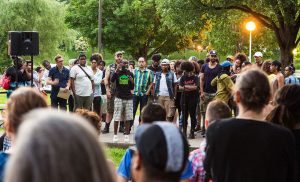
Typically, when communities organize, their goals fall within two broad categories: resource provision, or ensuring a community is provided with a resource it is lacking (a form of first-order change), and transformation, or fundamentally changing a community and its structures such that resources and power are more equitably distributed (a form of second-order change; Hale, 2014). For example, a community may be interested in improving the educational outcomes of its children. If the community’s focus is on resource provision, they may push for smaller student-to-teacher classroom ratios or better pay for teachers. If the community’s focus is on transformation, they may push for a change in culture whereby community members share ownership of students’ educational outcomes with teachers and create programs that engage all members of the community.
Those who put transformational change above resource provision argue that resources are necessary for communities and community change, but without attention to changing the systems that caused the lack of resources, there is a danger of recreating systems that allow for some groups to be left behind. For instance, if a community pushes for better pay for teachers, this may benefit teachers in some schools or school districts more than others.
A key consideration for someone interested in community organizing is finding ways to keep volunteers engaged; organizations can only be as effective as their volunteers are when working together over an extended period. Some estimates suggest only one-third of first-time meeting attendees show up to later meetings (Christens & Speer, 2011). So, what factors affect whether someone stays involved? Some factors that seem to positively influence attendance include face-to-face meetings designed to build interpersonal relationships and attendance at research related actions (see above, where we talk about the research stage of community organizing).
For change to happen, a community must engage in a process known as capacity building, or a process in which communities or organizations work to improve their collective skills and resources. In other words, before actions happen, communities need to make sure they can do the things they need to do to make that action happen and sustain the results they want. These things can include tangible resources like money or space, power, leadership, or the networks of people who care about an issue.
But why is capacity building important? Engaging in capacity building can improve community readiness for members to do the things they need to do for change to happen. For example, one study of seven Kansas communities trying to reduce underage drinking found that increasing a community’s readiness through capacity building resulted in new programs, policies, and practice changes being more easily facilitated (Anderson-Carpenter, Watson-Thompson, Jones, & Chaney, 2017).
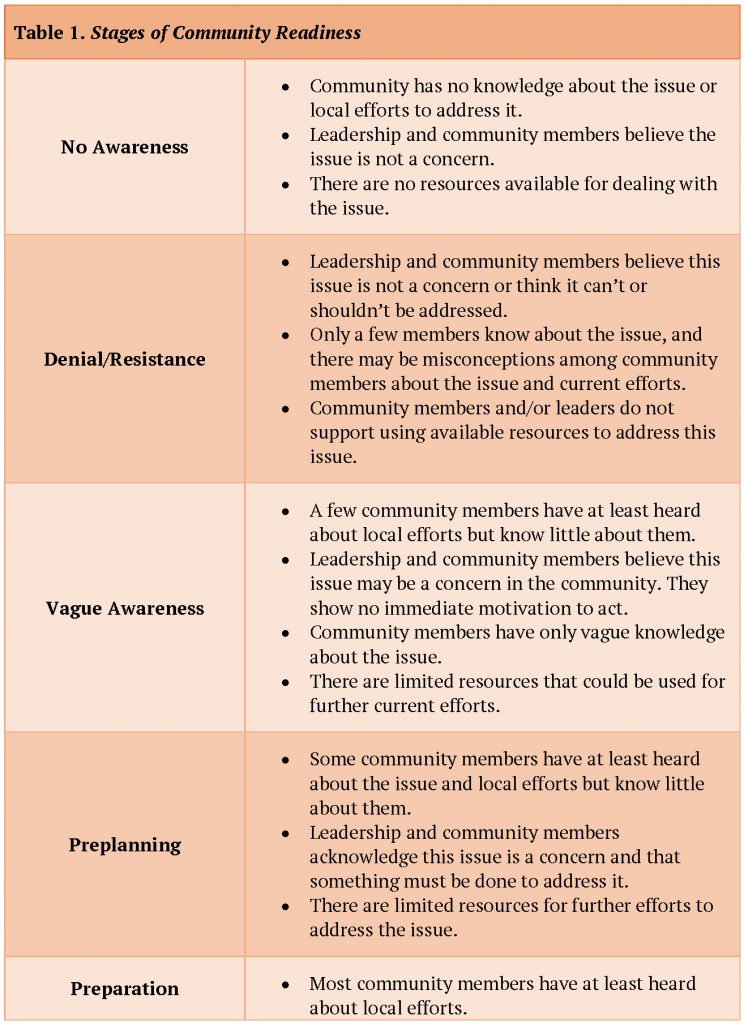
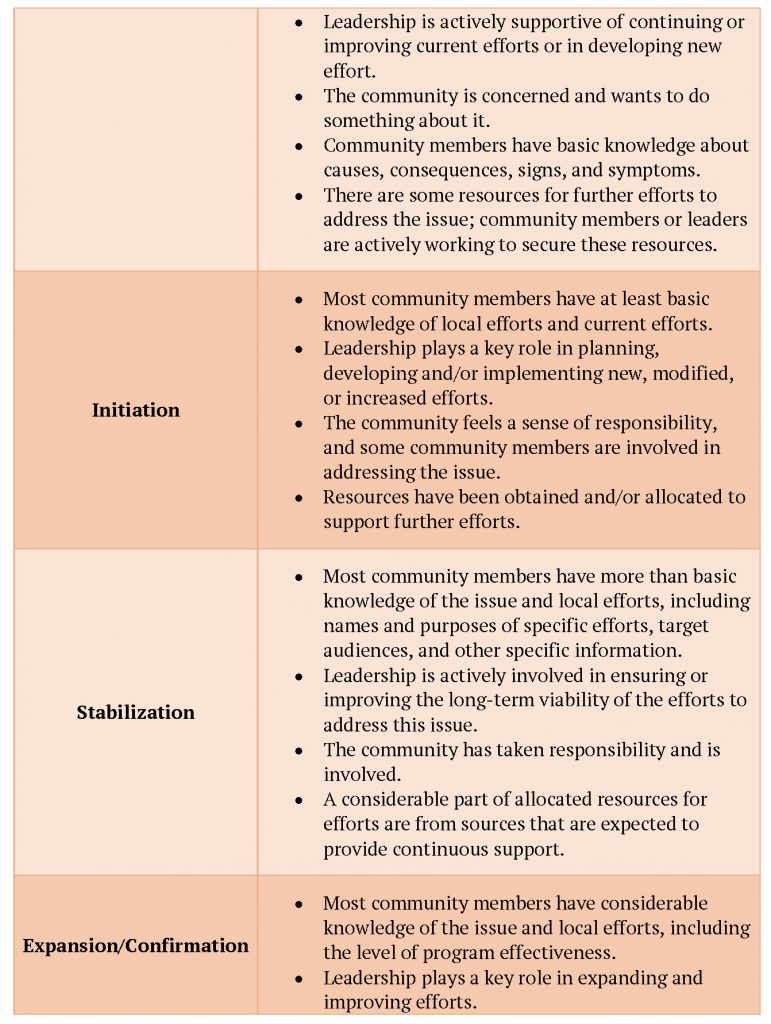
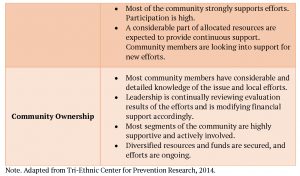
Community readiness typically moves through nine stages (see The Stages of Community Readiness above) and can increase or decrease depending on the community issue, the intensity of community efforts, and external events. Community readiness to implement interventions to prevent underage drinking, for example, may drastically increase following a terrible car accident where underage drivers had been drinking. Case study 15.4 provides an example of community psychologists using stages of community readiness to guide their intervention.
Case Study 15.4
Community Readiness to Address Youth Tobacco Use
Jason, Pokorny, Ji, and Kunz (2006) found that police departments and citizen community groups are often in different stages of readiness to change regarding reducing youth access to cigarettes. Some communities initially had minimal awareness that a problem existed locally and had no intention to invest in change, whereas others had an awareness of the problem, but no commitment to action and still others had a clear recognition of the problem and willingness to make some preliminary trials. A few other communities were ready to work hard at programs that should lead to behavior change. When working with a community in the denial stage, the Community Psychology research group often needed first to show them data from the schools to indicate that there was, in fact, a significant problem with youth smoking in their communities. The researchers also showed them data, which had been collected from the assessment of local merchants’ tobacco sales patterns, indicating that these merchants were illegally selling tobacco to minors. When the research group worked with communities in the preparation stage, police chiefs often found it helpful to rate the community’s level of readiness and where the community might like to be in a year so that the community could monitor their anticipated changes. The very process of discussing these issues often facilitated the communities in preparing for change and taking action. Sometimes the assessment called for the development of new tobacco control ordinances for towns, and the community psychologists were able to help the communities bring about important policy changes. It was only by understanding this readiness to take action that they could tailor the interventions to the needs of each community, and slowly work with them to become more motivated to prepare, take and maintain active social policies that could reduce youth access to tobacco and ultimately youth rates of smoking. As an example, for over a year, the research team worked collaboratively with one community to insure that this ordinance was carefully crafted and had broad community support to pass. The research team was invited to testify at a local city counsel meeting to provide evidence supporting the need for the revised ordinance. This policy development and advocacy were not required in every town, but this example shows how the team needed to carefully target their collaborative work to address the unique needs and readiness to change of each community. As a result of the success of this study, these community psychologists next used their Community Readiness Interview Scale in a larger randomized study involving 24 communities.

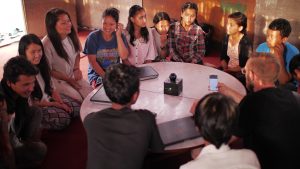
As we have learned throughout this chapter, the work of community psychologists relies heavily on community members acting collectively and intentionally (Foster-Fishman, et al., 2001). It also relies on a sense of collective efficacy, that is, the belief that the actions of the group can be successful in creating change (Zimmerman, 2000). Collective efficacy depends on many factors, such as the task at hand, access to resources, and leadership. It also depends on personal participatory efficacy—your own belief that you can effectively participate in community organizations. Both vary from situation to situation. For example, you may feel that the student group you belong to can effectively change the campus housing visitor policy (collective efficacy) and that your research skills will contribute to the group’s efforts (participatory efficacy). On the other hand, you may feel that the local homeless coalition you volunteer for will effectively establish partnerships for affordable housing (collective efficacy) but feel that you cannot contribute effectively to that mission (participatory efficacy).

We can all relate to feelings of stress. In community partnerships and coalitions, stress can lead to burnout – that feeling of overall exhaustion when there’s too much pressure (stress) and not enough sources of satisfaction or feelings of support (Maslach, Schaufeli, & Leiter, 2000). When coalition or team members experience burnout, it comes as no surprise that the quality of their work or willingness to participate deteriorates. Researchers have found six organizational factors that contribute to burnout: high workload, little influence in decision making, inadequate rewards (e.g., compensation, recognition), lack of social support, lack of fairness, and disagreement on values (Maslach & Leiter, 2008). Effective leadership and organizational capacity can aid in preventing many of these factors, and the way in which you define the social problem and decide how to change it can make a difference.

Think about the last time you received a high score on a paper you put a lot of time and effort into writing. It felt good, right? Successes, and the recognition of those successes, can go a long way in community organizing. When the social issue your organization is tackling has opposition, seems insurmountable, or is controversial, it is important to identify and establish small wins early in the planning phase. Organizational theorist Karl Weick (1986) found that when proposed changes are wide-sweeping and extensive, it tends to increase feelings of threat, and hence, increases a community’s resistance to change, and inaction among change agents. However, when proposed changes are small, concrete, and of moderate importance, risks seem more tolerable and manageable. These “small wins” also have the added benefit of attracting allies, preventing inaction, and deterring opponents. Take a moment to read the excerpt from Weick himself on small changes in Case Study 15.5.
Case Study 15.5
The Small Changes and Big Success of the Task Force on Gay Liberation
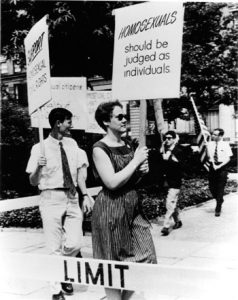
“The successful effort by the Task Force on Gay Liberation to change the way in which the Library of Congress classified books on the gay liberation movement is another example of a small win. Prior to 1972, books on this topic were assigned numbers reserved for books on abnormal sexual relations, sexual crimes, and sexual perversions (HQ 71-471). After 1972, the classifications were changed so that homosexuality was no longer a subcategory of abnormal relations, and all entries formerly described as ‘abnormal sex relations’ were now described as varieties of sexual life (Spector & Kitsuse, 1977, pp. 13-14). Labels and technical classifications, the mundane work of catalogers, have become the turf on which claims are staked, wins are frequent, and seemingly small changes attract attention, recruit allies, and give opponents second thoughts” (Weick, 1986, p. 42).
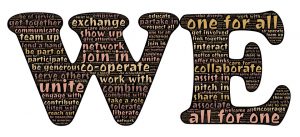
Community members may engage in community organizing for many reasons and in a variety of ways, though typically these goals fall within two categories: resource provision and transformation. As we learned in this chapter, collaborative partnerships may be organized using a top-down approach, where communities work with experts who are likely not a part of the affected community, or a bottom-up approach, which is driven by the community members themselves. Community coalitions tackle larger societal issues by bringing together people from across the community and its organizations.
Regardless of the exact method, community organizing often follows a cycle in which communities assess critical issues affecting the community, research causes and correlates of the issues, act through strategization and mobilization, and reflect on lessons learned. Successful organizers engage in capacity building and improving community readiness, both of which increase a community’s chances of success. Part of increasing community readiness involves building a sense of participatory and collective efficacy, which involve people’s sense that they—and their community—can change things. When things don’t go well, community members may experience burnout, or feelings of overall exhaustion that negatively impact one’s ability to engage in community organizing, which is why it’s important to focus on small wins.
Critical Thought Questions
Take the Chapter 15 Quiz
View the Chapter 15 Lecture Slides
____________________________________________________________________
Alinsky, S. D. (1971). Rules for radicals: A practical primer for realistic radicals. New York, NY: Vintage Books.
Anderson‐Carpenter, K. D., Watson‐Thompson, J., Jones, M. D., & Chaney, L. (2017). Improving community readiness for change through coalition capacity building: Evidence from a multisite intervention. Journal of Community Psychology, 45(4), 486-499.
Berkowitz, B. (2001). Studying the outcomes of community-based coalitions. American Journal of Community Psychology, 29(2), 213-227.
Christens, B. D., & Speer, P. W. (2011). Contextual influences on participation in community organizing: A multilevel longitudinal study. American Journal of Community Psychology, 47, 253-263. doi: 10.1007/s10464-010-9393-y
Fawcett, S. B., Paine-Andrews, A., Fransisco, V., Schulz, J. Richter, K., Lewis, R., . . . Lopez, C. (1995). Using empowerment theory in collaborative partnerships for community health and development. American Journal of Community Psychology, 23, 677-698.
Foster-Fisherman, P., Berkowitz, S., Lounsbury, D., Jacobson, S., & Allen, N. (2001). Building collaborative capacity in community coalitions: A review and integrative framework. American Journal of Community Psychology, 29, 241-262.
Hale, M. R. (2014). Community organizing: For resource provision or transformation? A review of the literature. Global Journal of Community Psychology Practice, 5, 2-9.
Jason, L. A., Glantsman, O., O’Brien, J. F., & Ramian, K. N. (2019). Introduction to the field of Community Psychology. In L. A. Jason, O. Glantsman, J. F. O’Brien, & K. N. Ramian (Eds.), Introduction to Community Psychology: Becoming an agent of change. Retrieved from https://press.rebus.community/introductiontocommunitypsychology/chapter/intro-to-community-psychology/
Jason, L. A., Pokorny, S. B., Ji, P., & Kunz, C. (2006). Developing community-school-university partnerships to control youth access to tobacco. Journal of Educational and Psychological Consultation, 16, 201-222.
Kohfeldt, D., Chhun, L., Grace, S., & Langhout, R.D. (2011). Youth empowerment in context: Exploring tensions in school-based yPAR. American Journal of Community Psychology, 47(1-2), 28-45.
Maslach, C., Schaufeli, W. B., & Leiter, M. P. (2000). Job burnout. Annual Review of Psychology, 52, 397-422.
Maslach, C., & Leiter, M. P. (2008). Early predictors of job burnout and engagement. Journal of Applied Psychology, 93, 498-512.
McKibban, A. R., & Steltenpohl, C. N. (2019). Community psychology at a regional university: On engaging undergraduate students in applied research. Forthcoming at Global Journal of Community Psychology Practice.
Nelson, G., Prilleltensky, I., & MacGillivary, H. (2001). Building value-based partnerships toward solidarity with oppressed groups. American Journal of Community Psychology, 29, 649 – 677. doi: 10.1023/A:1010406400101.
Speer, P. W., Hughey, J., Gensheimer, L. K., & Adams-Leavitt, W. (1995). Organizing for power: A comparative case study. Journal of Community Psychology, 23(1), 57-73.Retrieved from http://dx.doi.org/10.1002/1520-6629(199501)23:1<57::AID-JCOP2290230106>3.0.CO;2-9
Tri-Ethnic Center for Prevention Research. (2014). Community readiness for community change (2nd ed.). Fort Collins, CO: Colorado State University.
Weick, K. (1984). Small wins: Redefining the scale of social issues. American Psychologist, 39, 40-49.
Wolfe, T. (2001a). Community coalition building: Contemporary practice and research. American Journal of Community Psychology, 29, 165-172.
Wolfe, T. (2001b). The future of community coalition building. American Journal of Community Psychology, 29, 263-268.
Zimmerman, M. A. (2000). Empowerment theory: psychological, organizational and community levels of analysis. In J. Rappaport & E. Seidman (Eds.), Handbook Of Community Psychology (pp. 43-63). New York: Kluver/Plenum.

Chapter Sixteen Objectives
After reading this chapter you will be able to:
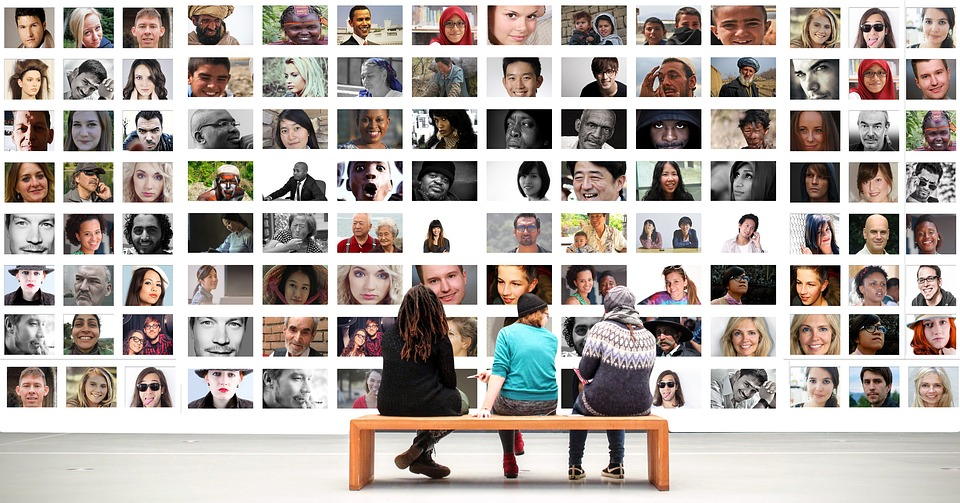
You may have heard of B. F. Skinner, who pioneered the use of behavioral approaches to show how rewards and punishments can change the behaviors of animals and people. This behavioral revolution has had a tremendous effect on psychology in terms of how therapy is now practiced in countries throughout the world. The old Freudian perspective has been replaced by a variety of behavioral-type therapies, used to help patients with a wide variety of common problems such as anxiety and depressive disorders. Most behavioral studies have been conducted in hospitals in inpatient settings or other types of institutions with much less behavioral research occurring in community settings such as homes or neighborhoods (Hanley et al., 2003). When behavioral-type work is conducted in community settings and has the values from the field of Community Psychology (as reviewed in Chapter 1, Jason, Glantsman, O’Brien, & Ramian, 2019), it has been referred to as Behavioral Community Psychology.
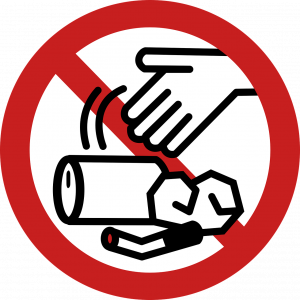
As we will see in this chapter, the Behavioral Community Psychology approach allows for a more focused and targeted method to define and change a range of community and social problems. In a sense, this approach breaks down large and complex problems into smaller ones that are much more manageable to solve. By specifying and measuring specific behaviors, such as littering or tobacco use, behavioral community psychologists can chart those behaviors over time to determine whether or not a particular intervention is effective. We will show in this chapter how these types of practical and easy-to-implement interventions can lead to what are called small wins, which can be reinforcing and sustain the work of community psychologists over time. We can change the world through being extremely strategic and focused by breaking down large problems into smaller ones that are solvable.
OK, let’s give an example of a problem that seemed very difficult to solve. If you can believe it involved uncollected dog droppings in Chicago. There as a time when nobody knew how to even approach this problem, let alone study or solve it. But as you will see, by collecting data and showing that there was a possible solution, change did occur for not only Chicago but also other urban areas in the US. The behavioral community psychology Case Study 16.1 was carried out at a time when there were no formal laws that required dog owners to pick up after their dogs.
Case Study 16.1
Getting the Scoop on Behavioral Interventions
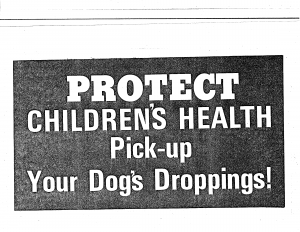
Leonard Jason invited his Alderman in Chicago to his community psychology class, and Jason said to himself that he would tackle whatever the Alderman mentioned as the most pressing community issue. When informed that it was uncollected dog feces, Jason’s mouth fell open in disbelief, but he pledged to work on this issue. Jason’s team first counted all fresh dog feces within an eight by five block area surrounding DePaul University. The fact that 1,147 droppings were within this area suggested that dog litter was a serious and prevalent problem within this community. Next, the team for five hours daily recorded the number of dogs, the number who defecated, and the number of dog defecations picked up by their owners. In addition, all defecations were picked up and weighed each morning. During the baseline phase, few dog owners were observed to pick up after their dogs and over 19 pounds of dog defecations were deposited in the target block. When dog owners were given instructions and a demonstration concerning how to use a plastic bag to pick-up dog feces, 82% of the dog owners proceeded to pick up after their dogs.
These findings indicated that the prompting intervention, which applied instructions and modeling, effectively motivated dog owners to dispose of their dogs’ waste properly.
At the study’s end, the Chicago alderman asked Jason to present the above data at City Hall in order to support a proposed ordinance which would require dog owners to have in their possession a pooper scooper when walking dogs. This ordinance was passed by the City Council, making Chicago one of the first cities in the country to pass a pooper scooper ordinance. The alderman to whom Jason had originally provided the data mentioned to him that this study, which received considerable media exposure, had helped change the politicians’ perception of the problem. The Alderman wrote to Jason: “In the past, this problem has often been scoffed at and not taken seriously. Your comments regarding the dog defecation problem altered that perception greatly.” Chicago’s ordinance became a model for other similar ordinances in towns around the country (Jason, 2013).
Although the subject matter of this study is a bit hard to believe, it is a true story. It shows the usefulness of listening to the community for ideas about what is important, even if it sometimes involves getting one’s hands dirty in the process. In other words, the subject matter of the intervention was decided upon by the needs of the community, and this is a critical part of behavioral community interventions. Also, by focusing on one small area and collecting data on dogs and their owners, it was possible to show that change could occur. In fact, it was found through the behavioral intervention that dog owners were willing to pick up after their dogs. Most importantly, the findings were transmitted to the legislative process, and a new ordinance came into law that made a real difference to the community. By getting into the trenches, getting our hands dirty, and being willing to study dog litter, we were able to influence dog owners to pick up. Just think what else is possible to accomplish.

Some of the first developments of learning theory started in the 1890s when Ivan Pavlov demonstrated the importance of the environment on behavior. Pavlov wanted to measure the amount of salivation in dogs when they were given food, predicting that the dogs would begin to salivate in response to being fed. A researcher would bring food to the dogs whenever he walked into the lab. Pavlov noticed that after a while, the dogs began to salivate in response to hearing the researcher’s footsteps, meaning they began to associate the footsteps with being fed, which caused a behavioral response (e.g., salivation).
Pavlov (1897) examined this discovery further with a series of experiments, in which the dogs underwent numerous trials and were exposed to a sound that was immediately followed by food. Pavlov discovered that when he just made the sound that accompanied food, the dogs began to salivate even if the food was not presented. Through the systematic control of the environment (i.e., onset of a sound and delivery of food), the animals learned to associate the sound with the food that followed. This fundamental learning process is referred to as Classical Conditioning.


Later, B. F. Skinner further examined behavioral responses and developed Operant Conditioning through the use of small boxes that contained a lever that lab rats pressed to release food. In these experiments, a rat was placed in the box and then observed. At first, the rat scurried around and then accidentally pulled the lever that released the pellets of food. In successive trials, Skinner observed that the time in which it took the rat to release the pellets of food decreased each time it was placed in the box. The rat began to learn that pulling the lever resulted in the delivery of food. Skinner taught the rats to pull the lever by rewarding the behavior, which became the basis for Operant Conditioning. This theory builds upon the work of Pavlov in understanding the relationship between one’s environment and behavior. Skinner coined the term Behavioral Analysis (1953) to systematically demonstrate how the behavior of individuals and groups is influenced by the environment. His work led the way to understand how animal and human behavior changed through reinforcement and punishment.
These theories demonstrate the importance of the environment on shaping behavior. Environments have a powerful influence on individuals, and this work has provided insights for community psychologists as they try to understand larger and more complex ecological systems.
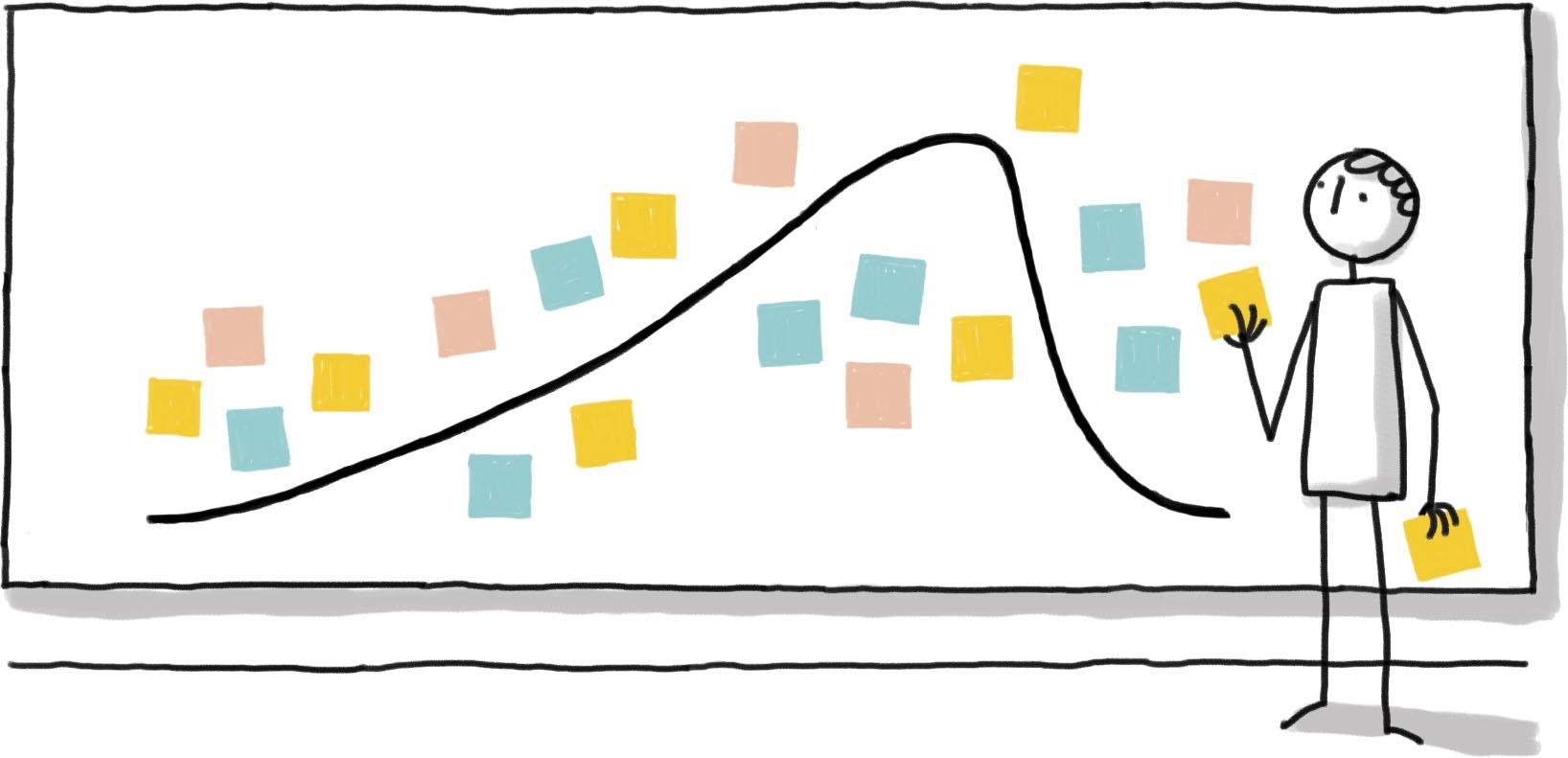
Behavioral community psychologists often use the term Applied Behavior Analysis to understand and explain human behavior as a function of the interaction between behavior and the environment. Applied Behavior Analysis is rooted in Learning Theory, which focuses on objectively observable behaviors and how learning occurs when individuals respond to environmental factors or stimuli. Positive reinforcement and punishment can be used to teach and sustain behavior and shape individual as well as community behavior.
Another term that is often used in the behavioral literature is Behavior Modification, which refers to the systematic application of learning principles and techniques to assess and change an individual’s behavior (Martin & Pear, 2015). Often the terms Behavior Modification and Applied Behavior Analysis are used interchangeably within the field of Behavioral Community Psychology. Below are some terms used frequently in this field:
Positive Reinforcement leads to increases in the chances that a behavior will continue to occur. On the other hand, Punishment often leads to the reduction of the rate or likelihood of a behavior, which can result in the behavior being Extinguished.

Here is an example: Imagine that you see a person driving on the highway at a speed exceeding the local limit and the police give the person a speeding ticket. It is possible that this ticket (i.e., consequence) reduces the likelihood of future speeding behavior. So, the person’s behavior is changed by the consequences as they now drive at the speed limit.
Shaping of behavior involves establishing a complex set of behaviors using a set of steps. Teaching a child to cross a street involves teaching several behaviors connected in a certain order. This might look something like this: walk up to the corner, push the button to activate the crosswalk and traffic light, wait until you get the correct “walk” signal and the cars are stopped, and then quickly get across the street before the light changes.
Stimulus control highlights how characteristics of the environment might influence the occurrence of a behavior. To give an example of this principle, in Case Study 16.2 below, a group of Behavioral Community Psychology investigators examined the effects of altering traffic light pattern sequences on driver compliance at a busy, urban intersection in Chicago. In this case study, you will see that by making a small change to the traffic light pattern, car accidents were reduced.
Case Study 16.2
A Change in Lights: A Reduction in Car Accidents

This study began when a hazardous situation was observed with two sets of traffic lights that were separated by only about 100 feet. Drivers that were stopped at the first traffic light that was red, next saw this light turn green, and they began driving to the second traffic light which was in the process of turning from yellow to red. The drivers already had waited a long time for the first light to turn green, and were probably annoyed at facing another light that was going to delay them. As a consequence, more than half of the drivers sped right by the next light changing from yellow to red and this resulted in many accidents. Working with officials from the city of Chicago, the investigators then slightly altered light pattern sequences so that when the second set of traffic lights were approached, the lights were not changing from yellow to red. This small change resulted in almost all of the drivers not passing through a yellow or red light at the second traffic light. Following the completion of the study, the traffic engineer approved the permanent alteration of the light timing pattern that increased traffic rule compliance. Accident data collected before and after the light timing changes indicated a reduction in automobile accidents (Jason, Neal, & Marinakis, 1985).
Several additional important developments in the behavioral approach have occurred. For example, Albert Bandura (1986) discovered that behavior is also learned from the environment through the process of observation (see the video below for a brief history of Bandura’s Bobo Doll Experiment).
Bandura showed that it is possible to learn by just observing another person engaging in a particular behavior. So, a child might watch a parent use a fork to eat food, and then the child might engage in that behavior from just watching the parent engaging in the behavior. This work has helped scientists better understand how aggressive behavior can be learned by youth, and this can occur when youth observe violence being reinforced. In addition, Bandura helped us better understand the importance of the thoughts and feelings that intervene between the stimuli and responses. In a sense, we are active information processors, and therefore cognitive factors are also involved in learning.

A final development that has attracted considerable media attention is the emergence of the field of behavioral economics, which is derived from the fields of psychology and economics. In essence, we are susceptible to temptations and often make bad decisions even though there are better options. For example, it is not uncommon to eat high fat and high-calorie snacks rather than healthier foods, which has resulted in an obesity crisis in the US. Reed, Niileksela, and Kaplan (2013) suggest that this apparent irrationality can still be understood based on the principles of operant learning. Some risk-taking behaviors, such as unhealthy food choices, have more reinforcing value than less risk-taking behaviors such as healthy food choices. Often high fat and high-calorie foods are appealing and tasty, which reinforces continuing to eat them. Therefore, it is possible to understand responses such as these types of food choices (even though these foods can lead to obesity and other health complications) by the fact that these behaviors are being reinforced.
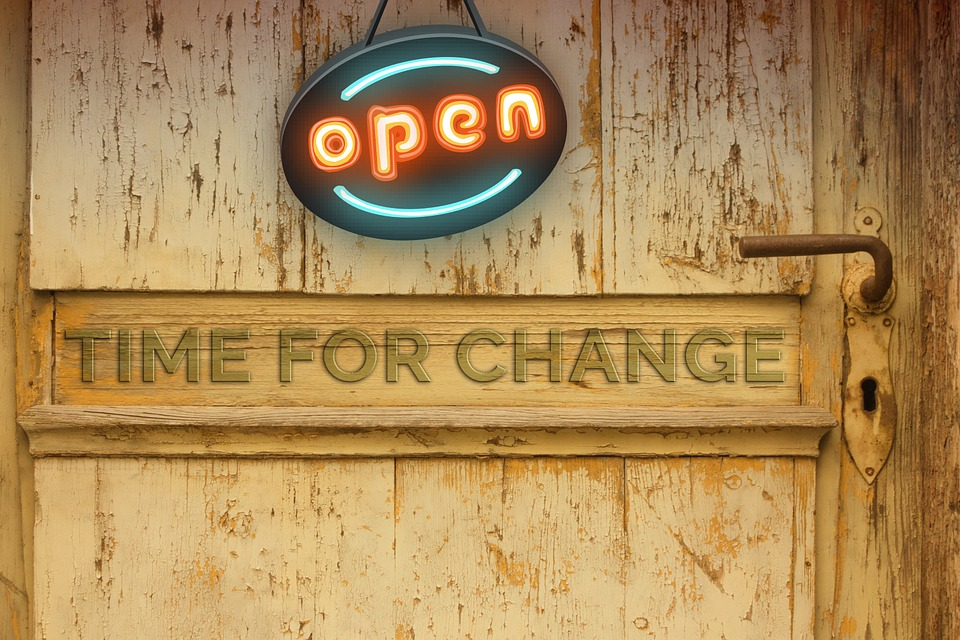
Most applications of Applied Behavior Analysis and Behavior Modification have been within the medical model, such as working one on one with patients having severe developmental disabilities. However, Behavioral Community Psychology interventions have addressed issues such as littering (Clark, Burgess, & Hendee, 1972); recycling (Zulas, 2009); illegal sales of cigarettes to minors (Jason, Ji, Anes, & Birkhead, 1991); drug addiction (Silverman, Roll, & Higgins, 2008); bullying in schools (Embry, 2002); blood donations (Ferrari & Jason, 1990); and identifying and conducting behavioral analyses on concerns of community members (Arellano et al., 2016; Balcazar, Garcia-Iriarte, & Suarez-Balcazar, 2009; Suarez-Balcazar & Balcazar, 2016). Many of these interventions have embraced Community Psychology values summarized by Fawcett (1991), and include:
1) Valuing collaborative relationships
2) Focusing on behavior-environment relationships of importance to communities
3) Conducting research focusing on modifiable and sustainable environmental events
4) Involving setting and research measures relevant to community concerns
5) Using measurement systems that capture the dynamic relationship between behavior and environment
6) Developing interventions owned by the community and sustainable with local resources
7) Providing interventions focused on maximizing impact and benefits to the community
8) Spreading effective interventions
9) Communicating effectively to the community stakeholders
10) Contributing to fundamental change. These values have guided the work of behavioral community psychologists (Glenwick & Jason, 1980).
Below are case studies that provide several examples of Behavioral Community Psychology interventions. Case study 16.3 shows how behavioral community psychologists collaborated with community-based organizations to influence legislative officials to support laws that contributed to second-order change, in this case protecting the safety of infants and children. Before child car restraints became law, thousands of children in the US were either injured or killed in car accidents. In fact, the leading cause of death for children under one year of age was car accidents due to not being protected in infant seats.
Case Study 16.3
A Behavioral Community Psychology Approach: Changing Laws and Saving Lives
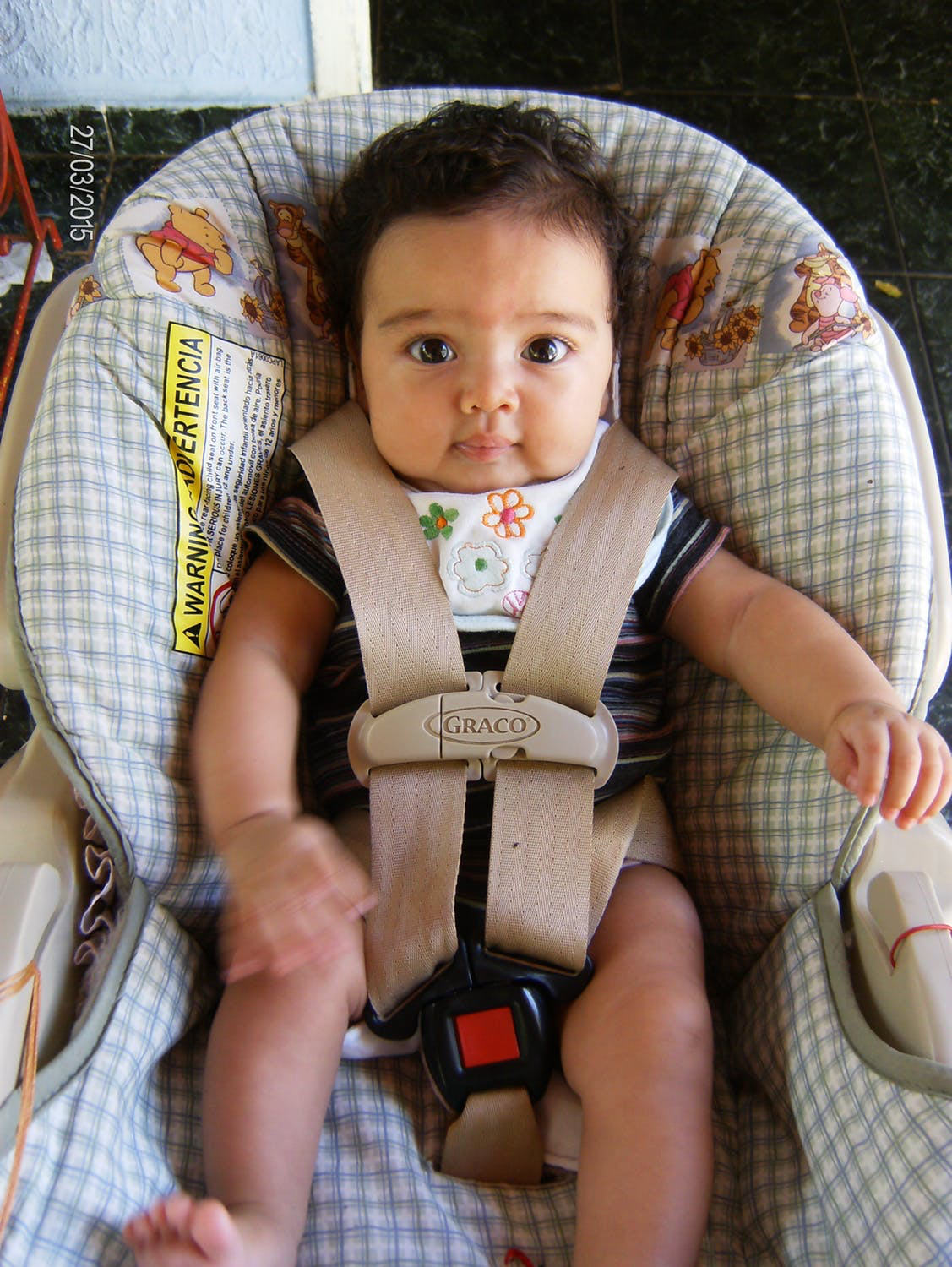
A national coalition of behavioral community psychologists, that included Leonard Jason and Stephen Fawcett, was trying to influence legislators to pass legislation that would require infants and children to wear a seatbelt or to be placed in an appropriate car or infant seat while in cars. In Illinois, Jason and his colleagues worked with a community-based organization that was trying to pass needed child restraint legislation. Their hunch was that data gathered on behavioral and self-report information could be used to influence the debate about passing needed legislation. For months, they looked inside cars to see whether or not infants and children were placed in car restraints. They also used telephone surveys to collect information about the public’s attitude toward the child-restraint bill. The goal was to use both data collection on attitudes and firsthand observations to build a more convincing case when trying to influence policy officials. Although they were also working closely with an Illinois organization that was advocating for the passage of this bill, they were unsure if the data would persuade legislators. They sent the collected information to a randomly selected half of the Illinois state legislators prior to a vote on the child passenger restraint bill. In that letter, the senators were informed that 140 children in Illinois were killed and 25,828 injured in automobile accidents over the last six years in Illinois. The authors also pointed out that, through their observations, 93% of Illinois children were not placed in adequate restraints while riding in cars. They also provided the legislators with the results of the survey, in which 78% of adults supported the child passenger restraint bill. By sending this critical information to half of the legislators, they were able to see whether the targeted letter had made a difference in encouraging support for this important legislation. Significantly more senators (79%) who received the information voted for passage of the bill, whereas only 53% of senators who did not receive the letter voted for the bill. Their intervention was a success, and even the governor requested a copy of the findings before finally signing the legislation. With the passage of the legislation, for children between the ages of one to four, the use of appropriate car restraints increased from 13% to 42%. Rates of appropriate restraints increased from 49% to 74% for infants less than one year of age. Most importantly, children’s deaths caused by traffic accidents decreased by 53%. Comments made by members of the Illinois Child Passenger Safety Association included: “The data were very, very interesting. It was a building block in the passage of the bill.” “Those who had the data and understood them, it made them more forceful and vocal in support of the bill” (Jason & Rose, 1984).
For many social and community problems, working at the policy level can have more substantial and enduring results, as the car restraint case study illustrated. Psychologists often provide therapy to those who are injured in car accidents, but there are clear advantages to using our more preventive behavioral community psychology strategies to change laws that influence parents to appropriately protect their children while being driven in cars.
The next case study illustrates how the community researchers used principles of Applied Behavior Analysis to study a concrete behavior—compliance with traffic signs by drivers–and developed operational definitions of terms to observe the behavior in a community context. The authors worked with community residents to identify an issue of concern to them and their children with disabilities: traffic safety. As you will see, specific roles for the investigators included developing a strong reciprocal partnership with the community, identifying issues the community cared about, helping design a coding system to observe the behavior in context, and developing action steps to address the issue in collaboration with the community. The community in this example refers to Latino parents of youth and young adults with disabilities.
Case Study 16.4
Familias Saludables (Healthy Families)

Yolanda Suarez-Balcazar and her team, in collaboration with residents of a predominantly Latino neighborhood and staff from a local community agency, initially designed a healthy lifestyles program called Healthy Families (Familias Saludables) to address a concern identified by the community about a lack of culturally relevant healthy lifestyles programming for their families with developmental disabilities (Suarez-Balcazar et al., 2016; Suarez-Balcazar et al., 2018). Eight evidence-based sessions were then provided that focused on enhancing healthy routines at home and in the community, and addressed neighborhood issues that families cared about. During these sessions, many mothers reported cars in their neighborhood driving over the speed limit or failing to stop for crosswalks, leading them to worry for their children’s safety and their own. Furthermore, one of her collaborators (The Consortium to Lower Obesity in Chicago Children, n.d.) was at the time sponsoring a city-wide effort to collect walkability data across Chicago’s diverse neighborhoods and address walkability safety concerns. The lack of pedestrian traffic safety in program participants’ neighborhoods further made worse the numerous environmental barriers that youth and young adults with Intellectual and Developmental Disabilities already faced to participating in their communities (e.g., over-stimulating sensory features, challenging physical layout). Utilizing Applied Behavior Analysis, the team designed a study in collaboration with their community partners to examine the behavior of traffic patterns in this neighborhood.
To assess the neighborhood’s walkability, data on traffic safety were collected based on direct observations. Independent researchers stood on street corners throughout the target area to observe and record traffic patterns including the number of cars failing to stop for the crosswalk, the smoothness of sidewalks, the speed of cars, and general street conditions. Data were collected at 25 intersections and focused on the behavior of car drivers on selected neighborhood streets, previously identified by community residents and agency staff as places/streets frequented by local families due to proximity to parks, schools, places of worship, and stores. Behaviors of interest that were recorded included drivers complying with street signs, drivers engaging in a complete stop whereby the car is not moving for a minimum of five seconds, and cars yielding to pedestrians.
They found that only one out of every three cars stopped at stop signs, and only half stopped before the crosswalk to allow pedestrians to pass. A pedestrian survey regarding walkability safety and engagement in the community found that participants walked to about six to nine places within the neighborhood weekly. Survey respondents also shared concerns about traffic safety. Consistent with a Behavioral Community Psychology approach, the data were utilized by the research team, the community residents, and staff from the local partner organization. For example, over fifteen families participated in a community health walk to raise awareness of safe driving practices. The health walk was organized by a number of organizations and participating families who decided to use this walk as an opportunity to educate the community about walkability safety. Parents and children created signs in both English and Spanish with self-selected messages such as, “Do not text and drive” and “Maneja con cuidado” [drive carefully] to carry during the walk. Then together, the team and the families joined the health walk alongside other community residents to continue promoting pedestrian safety in their areas.
This case study nicely illustrates the core values of Behavioral Community Psychology. First, the target population was actively involved in all aspects of the intervention, including identifying the concerns and taking action. Second, increased fostering of the target population’s sense of personal control and empowerment was accomplished by families designing the signs to carry during the health walk and identifying the streets to be observed. Third, there was the use of objective and subjective assessments when evaluating outcomes, using an instrument developed by a local traffic safety expert group. Fourth, they saw an increased emphasis on antecedent events, and in this case, an important antecedent was the traffic signs posted at street corners indicating to drivers that the desired behavior is for them to stop. Finally, increased interdisciplinary collaboration occurred, as this project included a team of community psychologists, several graduate students from occupational therapy and nutrition, and one faculty member from public health.
Some might think that focusing on dog litter or traffic safety is just not important, given the other types of serious problems that we face. But behavioral community psychologists have tackled even larger issues, as the next case study demonstrates.
Case Study 16.5
The I-Files: A Community Movement for the Big Island

The project began during the first day of a two-day behavioral training workshop in Honolulu in the spring of 1997. The workshop was on the development of community coalitions for health improvement and was delivered at the request of the Chronic Disease Branch Chief of the State of Hawai’i Department of Public Health. In attendance were many employees of the health departments from Honolulu and several of the neighboring islands. Also present were health educators, public health nurses, epidemiologists, branch chiefs from several divisions, and the Directors of District Health Offices from Kauai and Hilo. By noon on the first day, one table was absolutely buzzing with excitement. At the table were six public health nurses, three health educators, and the district health officer. On the back of a napkin, they sketched an idea for a community health improvement initiative that would later be named I-Files. The idea was simple—for each of the six districts on the Big Island, they would develop teams of three people including someone specializing in community mobilization and action planning, another person specializing in grant writing, and another person who would be trained in behavioral evaluation. They would develop community partnerships to address the most pressing health issues in each district, and mobilize the people and financial resources needed to resolve the issues.
Many of the behavioral programs and efforts that began in 1997 continue to this day. Some of the major behavioral accomplishments include: the development of a drug and alcohol-free surf competition for area teens; a community leadership development program where the fire department trained teens in firefighting, community service, and leadership skills; a community coalition comprised of businesses, professional fishermen, and community members in Kona to minimize destructive fishing practices near the area’s reefs. Further accomplishments were a community coalition to support the continued success of the Ka’u Hospital to promote community health improvement and build the capacity of residents to prevent health outcomes such as diabetes, the development of a neighborhood watch and diabetes self-management program by public health nurses, and a community policing program. To learn more about these outcomes, see the Prezi presentation.
In this case study, community members and employees of the District Health Offices were involved in a project that led to breakthrough approaches in community health improvement. By empowering the community health workers to respond to what they were learning from community members, more responsive programming was developed to meet real-world needs as they emerged in communities. By creating coalitions that represented multiple sectors in communities, programs and policies were developed that affected behavioral changes to reach more people, resulting in improvements in a variety of valued life outcomes. The new and modified programs, policies, and practices developed by and with community members represented a variety of behavior change strategies. By involving both the community members and the public health workforce, programs and policies were more relevant and had a long term positive influence. As this case example indicates, Behavioral Community Psychology investigators can make a difference using their innovative methods with a wide variety of community issues.
Clearly, the behavior of individuals and groups takes place in complex environments across a variety of settings including families, homes, schools, neighborhoods, community agencies, places of worship, and work settings. These behaviors can be complex as they are in constant interaction with and impacted by the environment.
Behavioral community interventions do not operate in a vacuum but rather compete with other competing messages, which can affect and influence the effectiveness of the interventions. As mentioned in Chapter 1, for many years smoking prevention interventions were implemented in schools, and yet children reported that they were almost always sold cigarettes by store vendors. The fact that youth were sold these dangerous substances did have a negative effect on school smoking prevention programs, for there were youth who wondered how dangerous cigarettes could be if they were sold cigarettes by adults. Therefore, additional behavioral interventions were needed to reduce youth access to retail sources of tobacco. As another example, commercials on the media constantly advertise the benefits of food that have high levels of sugar and fat, and these media influences will also need to be addressed by those working on childhood obesity behavioral programs.

Some feel there are no generalizable laws of behavior that can be used to understand something as complex as a community, which has complicated layers of ecological influences operating at the individual, group, organizational, and societal levels. In other words, an intervention that might work in one setting might not be effective in a different place, so they feel that behaviorists who believe in universal laws of behavior are overly simplistic. We have an answer to this concern. We believe that the principles of learning reviewed in this chapter are operating in community settings, but there might be important differences in how they are implemented in different settings (Jason et al., 2016). As an example, a behavioral school-based program that has been shown to work well in environments that have adequate staff and resources might have very different outcomes when located in an environment where there are inadequate resources and other multiple problems due to gangs and violence. What is important to remember is that an excellent intervention in one setting might not work well when it is implemented in another that is less supportive and reinforcing. Also, an intervention for one age group might now work for another age group, as indicated below in Case Study 16.6.
Case Study 16.6
Prevention of Prejudice
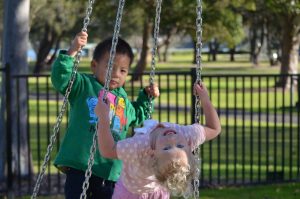
Behavioral Community psychologists attempted to impact inter-ethnic relations of elementary school age children by implementing a peer tutoring program. These youth were shown how to tutor their classmates. Direct observations of social interactions on the playground and sociometric indices of interpersonal ratings were used to measure inter-ethnic associations before and after the eight-week program. For first-graders, inter-ethnic interactions and sociometric choices increased and improvements were found in arithmetic and reading grades. However, no significant changes were found among the third-grade program children. The first-grade children carried the benefits of the peer tutoring program from the classroom to the playground. First-grade youngsters quickly developed cohesive, interdependent groups and some continued to use their group name from the study on the playground eight months following the program’s end. The findings suggest the importance of fostering cooperation and addressing prejudice early on, as indicated by the lack of significant changes for third-graders in their ratings of fellow children of different ethnic backgrounds. These findings further suggest that a behavioral cooperative peer tutoring classroom structure may improve the inter-ethnic relationships of first-grade children, who have experienced only a short history of competitive academic exercises and whose overt ethnic prejudice may be less ingrained (Rooney-Rebeck & Jason, 1986).
It is by attending to the unique history, age, and resources available in these school settings that we might be better about to understand these types of different outcomes. Basic behavioral principles are operating throughout these settings, and our task is to better identify and understand these complex environmental factors.
Some have also been concerned about the language and terms used by behavioral psychologists, who often used words such as “controlling behavior” (Mattaini, Jason, & Glenwick, 2016). With dictators using this type of repressive language to control their citizens, it is understandable that some might be concerned with the terms sometimes used by behaviorists. But these phrases do not capture the rich collaborations that occur in behavioral community interventions, when researchers work closely with community members in both defining the goals of interventions and actively participating in bringing about changes (Glenwick, & Jason, 1980). As shown by the case studies above, behavioral community psychologists are able to gain control of key aspects of the environment, but it is through a collaborative, mutually agreed upon process with key members of the community (Bogat & Jason, 2000).

In this chapter, the principles of Applied Behavior Analysis were utilized in the Behavioral Community Psychology case studies to illustrate how to promote real community change in a variety of settings. Behavioral community psychologists focus on the complex relationship between individual/group behavior and the environment. By attending to the relationship between behavior and the environment, whereby each impacts the other, it is possible to bring about important change.
As we end this chapter on Behavioral Community Psychology, it is useful to point out that many of our social and community problems, such as substance abuse, school failure, and juvenile delinquency, share many developmental roots such as poverty and lack of resources. Coordinating our behavioral community interventions so that they uncover common environmental causes, and take them into consideration as we implement change, will ultimately increase the enduring impact of this work.
Critical Thought Questions
Take the Chapter 16 Quiz
View the Chapter 16 Lecture Slides
____________________________________________________________________
Arellano, R., Balcazar, F. E., Alvarado, F., & Suarez, S. (2016). A participatory action research and intervention in a rural community of Mexico concerns report method/Titulo en Español. Universitas Psychologica, 15(2), 15.
Balcazar, F., Garcia-Iriarte, E., & Suarez-Balcazar, Y. (2009). Participatory action research with Colombian immigrants. Hispanic Journal of Behavioral Sciences, 31(1), 112-127.
Bandura, A. (1986). Social foundations of thought and action: A social cognitive theory. Prentice-Hall, Inc.
Bogat, G. A., & Jason, L. A. (2000). Toward an integration of behaviorism and community psychology. In J. Rappaport & E. Seidman (Eds.), Handbook of Community Psychology, (pp. 101-114). New York: Kluwer Academic/Plenum Publishers.
Clark, R. N., Burgess, R. L., & Hendee, J. C. (1972). The development of anti-litter behavior in a forest campground. Journal of Applied Behavior Analysis, 5(1), 1-5.
Consortium to Lower Obesity in Chicago Children [CLOCC]. (n.d.). Neighborhood walkability initiative. Retrieved from http://www.clocc.net/our-focus-areas/physical-activity-and-built-environment/neighborhood-walkability-initiative/
Embry, D. D. (2002). The good behavior game: A best practice candidate as a universal behavioral vaccine. Clinical Child and Family Psychology Review, 5(4), 273-297.
Fawcett, S. (1991). Some values guiding community research and action. Journal of Applied Behavior Analysis, 24(4), 621-636.
Ferrari, J., & Jason, L. A. (1990). Incentives in blood-donor recruitment – response. Evaluation & the Health Professions, 13(3), 374-377.
Glenwick, D. & Jason, L. A. (1980). Behavioral community psychology: Progress and prospects. New York: Praeger.
Jason, L. A. (2013). Principles of social change. Oxford University Press.
Jason, L. A., Glantsman, O., O’Brien, J. F., & Ramian, K. N. (2019). Introduction to the field of Community Psychology. In L. A. Jason, O. Glantsman, J. F. O’Brien, & K. N. Ramian (Eds.), Introduction to Community Psychology: Becoming an agent of change. Retrieved from https://press.rebus.community/introductiontocommunitypsychology/chapter/intro-to-community-psychology/
Jason, L. A., Ji, P., Anes, M., & Birkhead, S. H. (1991). Active enforcement of cigarette control laws in the prevention of cigarette sales to minors. The Journal of the American Medical Association, 266(22), 3159-61.
Jason, L. A., Neal, A. M., & Marinakis, G. (1985). Altering contingencies to facilitate compliance with traffic light systems. Journal of Applied Behavior Analysis, 18, 95-100.
Jason, L. A., & Rose, T. (1984). Influencing the passage of child passenger restraint legislation. American Journal of Community Psychology, 12, 485-495.
Jason, L. A., Stevens, E., Ram, D., Miller, S. A., Beasley, C. R., & Gleason, K. (2016). Theories in the field of community psychology. Global Journal of Community Psychology Practice, 7(2), 1-27. Retrieved from https://www.gjcpp.org/en/article.php?issue=22&article=125
Hanley, G., Iwata, B., & McCord, B. (2003). Functional analysis of problem behavior: A review. Journal of Applied Behavior Analysis, 36(2), 147–185. Ka’u Rural Health Community Association. (n.d.). Home. Retrieved from https://krhcai.com/
Martin, G., & Pear, J. (2015). Behavior modification: What it is and how to do it (10th ed.). New York: Routledge.
Mattaini, M. A., Jason, L. A., & Glenwick, D. S. (2016). Behavioral and time-series approaches. In L. A. Jason & D. S. Glenwick (Eds.), Handbook of methodological approaches to community-based research: Qualitative, quantitative, and mixed methods. (pp. 177-186). New York, NY: Oxford University Press.
Pavlov, I. P. (1897). The work of the digestive glands. London: Griffin.
Reed, D. D., Niileksela, C. R., & Kaplan, B. A. (2013). Behavioral economics: a tutorial for behavior analysts in practice. Behavior analysis in practice, 6(1), 34–54.
Rooney-Rebeck, P., & Jason, L. A. (1986). Prevention of prejudice in elementary school students. The Journal of Primary Prevention, 7(2), 63-73.
Silverman, K., Roll, J. M., & Higgins, S. T. (2008). Introduction to the special issue on the behavior analysis and treatment of drug addiction. Journal of Applied Behavior Analysis, 41(4), 471-480.
Skinner, B. F. (1953). Science and human behavior. New York: The Macmillan Company.
Suarez-Balcazar, Y., & Balcazar, F. (2016). Functional analysis of community concerns in participatory action research. In L. Jason & D. Glenwick (Eds.), Handbook of methodological approaches to community-based research, (pp. 315-324). New York: Oxford University Press.
Suarez-Balcazar, Y., Hoisington, M., Orozco, A. A., Arias, D., Garcia, C., Smith, K., & Bonner, B. (2016). Benefits of a culturally tailored health promotion program for Latino youth with disabilities and their families. American Journal of Occupational Therapy, 70, 7005180080.
Suarez-Balcazar, Y., Early, A., Maldonado, A., Arias, D., Garcia, C., Zeidman, A., & Agudelo-Orozco, A. (2018). Community-based participatory research to promote healthy lifestyles among Latino immigrant families with youth with disabilities. Scandinavian Journal of Occupational Therapy.
Zulas, A. L. (2009). Environmental change: The application of three theories of behavior change on recycling behavior and ecological values. Retrieved from ProQuest Dissertations and Theses. (ID: 1954848701).

Chapter Seventeen Objectives
By the end of this chapter you will be able to:
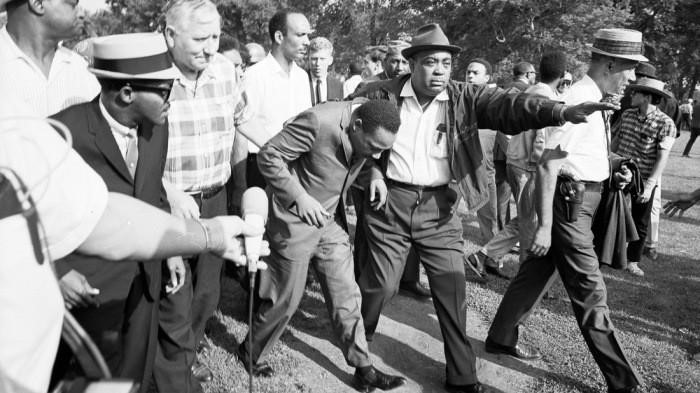
In the photo above, Dr. Martin Luther King Jr. is pictured leading 600 demonstrators on a civil-rights march through angry white crowds in the Gage Park section of Chicago’s southwest side. After King was struck by a rock, he was escorted by his bodyguard Frank Mingo. Frank later said: “No need to tell you anything different, I was sure scared. I got hit five or six times that day. But I didn’t mind. That was what I was there for, to protect Dr. King. My wife and I have three boys growing up. I felt that anything I could do to improve society would help them too.”
Part of the community organizing aspect of Community Psychology is understanding the long game, as the quote above nicely demonstrates. Many community psychologists work to reduce the symptoms of oppression through programming and community-based participatory research. Critical and liberation community psychologists, particularly ones engaged in activism, work to use psychology to confront oppressive actors and organizations. Frank Mingo worked diligently for the Poor Peoples Movement and the Back Home Movement, which was a part of a repatriation of the south by African Americans, laying claim to land that was legally theirs. Both Mingo and Dr. Martin Luther King Jr. set examples of ways community psychologists can learn about courage and persistent involvement toward social change. Dr. Martin Luther King Jr.’s writings and speeches, in particular, demonstrate ways in which community psychologists can use their skills to be effective and, at the same time, remain ethical and positive in their activism.
Community Psychology programs often focus on changing inequalities for people who are suffering, but the means have to be considered with extreme care. The message of this chapter is that rather than community psychologists being thought as the sole agents to “empower” others, we need to work together with community groups in collaborative efforts to foster their own empowerment. In other words, we can bring people together and work as allies with those who experience injustice (Olson, Viola, Fromm-Reed, 2011).
Part of being an effective ally is turning our attention toward those responsible for structural violence. Structural violence is a way to understand that violence and harm are caused not only by individual actors but by unjust laws, dehumanizing structures, and other features of the environment—all of which, of course, were created by human beings. To summarize, we feel that attention should be placed on the actors, policies, rules, and structures that harm community members. As the well-known psychologist Amos Wilson said, “If you want to understand any problem in America, you need to focus on who profits from that problem, not who suffers from the problem” (1998). Wilson is referring to those who have power to engage in any form of injustice whether it is due to greed, indifference, or racism.
The key question is: how do community psychologists attempt to tip the scale and change oppressive organizational, corporate, or governmental policies? It is often difficult to fight a powerful opposition, and the obstacles can seem insurmountable, as they were during the civil rights movement of the 1960s. When the goals seem impossible, and a sense of hopelessness and helplessness has set in, values and passion can provide the drive to continue working for social justice. We will show in this chapter examples of how this might be accomplished, as well as how you can remain inspired and motivated through it all.
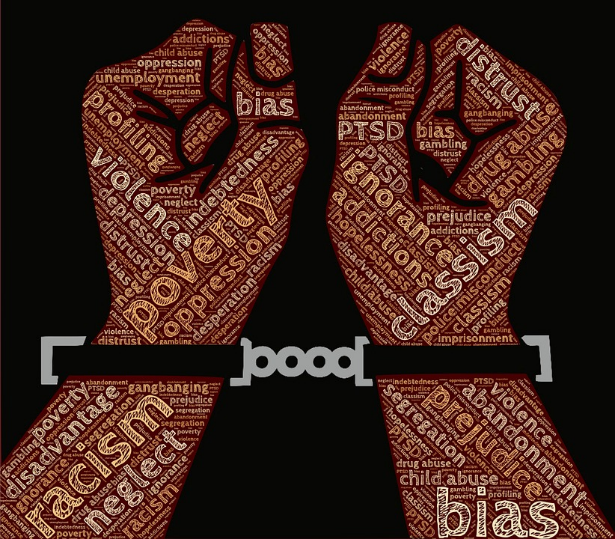
Amos Wilson (1998) felt that the elite effectively secure and enhance their power, hiding their real actions and motivations, all the while appearing not to do so. This can often leave those who have been oppressed to believe that they themselves were responsible for their struggles. Part of the work of community psychologists is to pay attention to those who have experienced oppression as a result of this structural violence. This work within communities is to help its members unravel these kinds of manipulations. To understand oppression and those who are oppressed, Paulo Freire’s Pedagogy of the Oppressed offers important insights. For Freire (2007), the oppressors’ psychology is one of hierarchy, suppression, and dehumanization, and those oppressors will never liberate the oppressed. Freire felt that our ordinary way of thinking, “an eye for an eye,” would just lead to the oppressed replacing the oppressor, only to keep dehumanizing structures the same. Community psychologists work with community members to help them identify aspects of structural violence in order to change those structures. Follow this link for some helpful definitions related to oppression and power.
Examples of oppressive systems are the Guantánamo Bay detention camp, located in the Guantánamo Bay U.S. Naval Base in Cuba, and secret Central Intelligence Agency black sites throughout the world. At Guantánamo, prisoners’ conditions of detention fell under human rights definitions of torture (find more about the abuses at Guantánamo from the perspective of a detainee). The torture program at the Central Intelligence Agency black sites designed by psychologists led to permanent psychological harm of the Muslim detainees. There were some psychologists who sought to expose these human rights violations. This is how it came about: due to media reports of extreme interrogations by the US government, the American Psychological Association (APA) convened a task force in 2005 to examine psychological ethics in national security, and this task force endorsed the continued presence of psychologists to use their psychological tools against detainees.
Following the task force report, members of the Coalition for an Ethical Psychology mobilized to hold APA accountable to its own ethical standards. The hallmark of the Coalition was the unmasking of policies regarding unethical psychologist involvement in torture. The following case study describes this coalition and some of their work.
Case Study 17.1
Coalition for an Ethical Psychology and the Hoffman Report
A community psychologist, a psychoanalyst, a historian of psychology and other clinical psychologists are leaders of the Coalition for an Ethical Psychology. The members of this coalition created a collaborative, non-hierarchical place for their activist work. They shared information and developed key allies with other organizations who could aid them in their efforts to expose the collusion, pertaining to the torture program, between the APA and the national security sector. By working with these allies, stakeholders in and outside of the field of psychology, their efforts eventually led to James Risen’s New York Times articles that detailed this collusion. The articles revealed APA’s collusion in allowing psychologists to be engaged in interrogation procedures that involved torture, and this led to the APA commissioning an independent review by David Hoffman, eventually culminating in what has been called the Hoffman Report. The Hoffman Report presented communications and actions taken by APA officials and members of the Department of Defense, Central Intelligence Agency, and Department of Justice that pointed to coordinated efforts and knowledge of APA Ethics Code subversions. The Hoffman Report and the aftermath led to increased accountability within the organization. Video discussions by Coalition members and their allies can be found below.
The creation of the Coalition for an Ethical Psychology is an illustration of what psychologists can do to combat oppressive forms of injustice, and in this case, the violation of human rights.
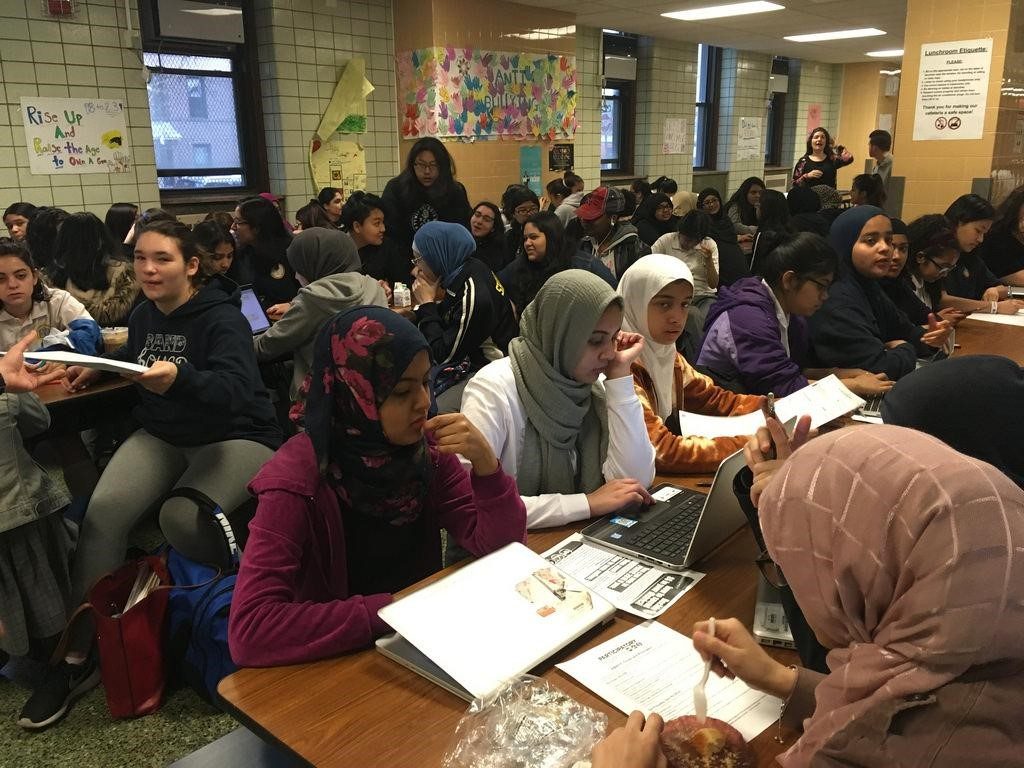
One job of community psychologists is to engage in dialogue with the oppressed and find what Freire called their generative themes, the core issues that face a group (Freire, 2007). Freire believed that community members are the best ones to identify the nature of the problems they face and participate in the solutions. When they align themselves with those facing oppressive conditions, they can, together, start directing their attention to unjust actors who control structures. For example, when the UN created the Convention on the Rights of Persons with Disabilities (United Nations, 2006), those in the disability community objected because they had been left out of this process. People with disabilities were successful in demanding that they were the best ones to shape the foundational principles of the Convention, and they indeed became instrumental members. The famous phrase that came out of the disability community was “nothing about us without us.” Follow this link to hear young participants’ perspectives within the process.
Within Community Psychology, Julian Rappaport (1981) coined the term empowerment, which is very compatible with the value of helping the oppressed gain access to resources and increase self-determination. Rappaport often cautioned community psychologists against suggesting they were in charge of “empowering” community members. Rather, the empowering process is one in which all parties work together to bring about a greater sense of collective efficacy and work to equalize power throughout society.
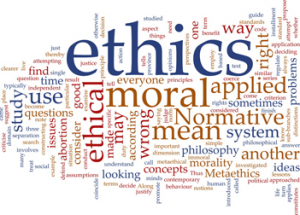
Rappaport made an important distinction between empowerment and other approaches called needs-based and rights-based strategies. Needs-based strategies put those with the lived experiences on the dependent side of the hierarchy. Trying to deal with their needs, and focusing on pathologies or limitations becomes the focus. When focusing on the rights-based strategies, it is too easy to adopt a position of fighting “for” but not “with” community members. The Third Way of Empowerment (Rappaport, 1987), as described in this chapter, is very much aligned with working with community members. However, sometimes it is difficult to work directly with the community that is oppressed. As in the example of the Coalition in Case Study 17.1, it was impossible to work with the detainees because they were in secluded and restricted detention settings. Nevertheless, the Coalition communicates with multiple groups in an effort to help “educate” rather than “train” others. “Training is defined as teaching a group what to think rather than how to think. This makes the people dependent rather than assisting in developing skills which could be used for independent activity. It rewards behavior that operates against their group’s interest, promoting individual rather than group achievement, and instilling negative self-concepts and low self-esteem”
– Bobby E. Wright (Anonymous, 1982)Freire’s Pedagogy of the Oppressed was similarly all about a new form of non-hierarchical education. Like the “empowerment process”, it was about collaboration and dialogue––where the teacher is also the student, and the student also the teacher. When working with communities, empowerment involves everyone working toward common, mutually-decided upon goals.
Community psychologists who engage in activism can also learn much from Rappaport’s notion of paradox, which is something that combines what seem to be contradictory qualities (Rappaport, 1981). In doing community work, we often encounter paradoxes, where two apparently contradictory truths do not necessarily contradict each other. For example, one paradox is that the Coalition for an Ethical Psychology was engaged in an empowerment process, but there was no direct contact with the prisoners, the people they were attempting to empower. Although this might seem to be a paradox, it is possible to do empowerment work and not be in direct contact with those who are oppressed. In engaging, investigating, and highlighting the side not receiving enough attention, empowerment can occur.
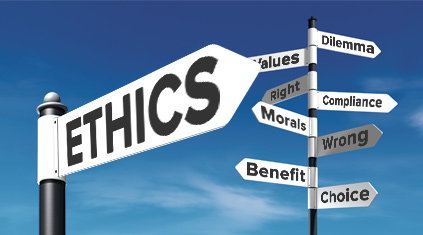
Praxis means putting an idea or theory into practice. This is often a repetitive process where a theory, lesson, or skill is turned into an actualized action. Community psychologists learn from community members, co-design research projects, and try to put that learning into real action and activism. They then see how things work, and then return to the drawing board. Ethics, morals, and values are all essential parts of the praxis process. But here there is sometimes a division between those who use any means to get to their goals met and others who feel the means have to be ethical. Several community activists, such as Saul Alinsky and Malcolm X (particularly in his early life) felt that any means could be used as long as the ultimate goal is just. Sometimes using any means results in cutting corners or even harming others.

To use an analogy, the ring of power in Tolkien’s Lord of the Rings is often attempted to be used for good, but it can only be used for evil. The characters with the best of ends in mind can become corrupted, due to the influence of the ring. So, what we are suggesting is that the means of reaching one’s goals in social justice is of importance. Poet and activist Audre Lorde famously declared, “the master’s tools will never dismantle the master’s house” (2007). If the problem is oppression and violence, using oppression and violence to achieve one’s goals might not be effective or just. Malcolm X realized this toward the end of his life when he sojourned to Mecca and saw people of all races, nationalities, and backgrounds praying together in unity. This radically altered his views on working to dismantle the oppressive power structures in this country, and he began preaching more about love and collaboration. To demonstrate the difference in approach to the means of activism, Case Study 17.2 compares different means of two influential social activists.
Case Study 17.2
Alinsky and Gandhi
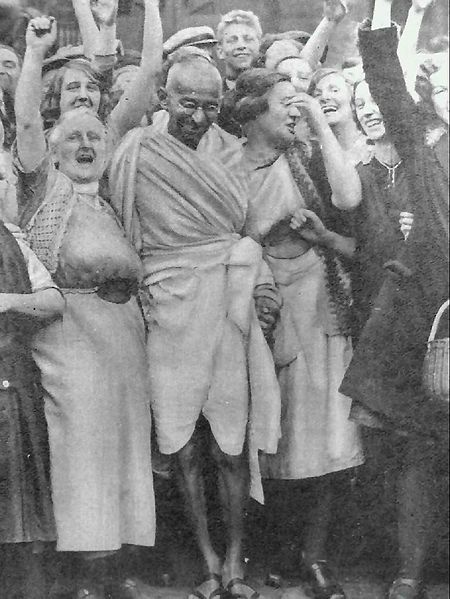
Alinsky and Gandhi were both tricksters in defying powerful individuals, but they were also different in the means with which they carried out their work. Alinsky in Chicago believed in confidently insulting those in power and even using tactics of deception. In other words, all means could be used to get to the objective. As an example, in Alinsky’s book Rules for Radicals, he recommended: “find their [the opposition’s] rules and use those rules against them–because they find these rules precious and they cannot live up to them.”
A different approach was used by Gandhi in British Colonial India, where he engaged in nonviolence and humility, attempting to make the means ethical, and always striving to work with love for all human beings. In India in the 1930s, a British “rule” or “law” was a salt tax, making it illegal for the people of India to make or sell salt or even to collect it from the sea. Gandhi engaged in civil disobedience by initiating a march to the sea to collect the salt. This act inspired all of India and made the British look foolish, as they were unable to stop the march. In this way, Gandhi successfully took on the British without using their oppressive and violent tactics. His means were just and not corrupted in radical opposition to British rule. But, as is often the case when engaging in defiance of oppressive systems, Gandhi was punished by incarceration for his salt march.
It is in choosing the means of activism that a tempting crossroads presents itself to community psychologists, and we would argue for the adoption and use of ethical means to reach the goals.
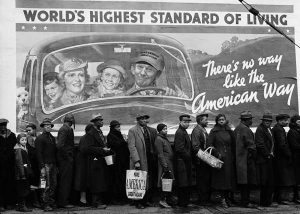
The means by which we partner with community members also matters. Community members are sometimes labeled with oppressive terms: the disenfranchised, vulnerable, the marginalized, the poor, those of “high risk”. The words we use do matter, and even the term “community organizer” suggests a person who is in charge of the collaborative spirit. Therefore words that suggest hierarchy, where one might have more power than others in the change process, are outside the spirit of Community Psychology.
In any praxis-based campaign, there is also a need to address the oppressor’s dehumanizing and colonizing nature. But, as we saw with Gandhi and with Martin Luther King’s work, this can be done in an ethical way that does not replicate the oppressors’ way of being. For an example of how to practically consider and address colonization using Community Psychology tools, learn more from Demystifying Decolonization: A Practical Example from the Classroom.
Ultimately, an important task of the community psychologist engaged in activism is to try to ethically persuade others using the tools of research and community-based action. Some individuals will never change and with others, it will take considerable time. Sometimes in a democracy, what is needed is to convince a majority of people, and encourage them to continue to engage in voting and social action. Community psychologists can also help keep groups of people cohesive, effective, and willing to engage in a long-term struggle despite criticism, insults, threats, and even risks to one’s career.
The activist’s journey is not only outwards toward bringing about change, but is also inward. It involves a thorough examination of one’s own imbalances, flaws, virtues, and motivations. This is often referred to as part of the “self-purification” process. When considering one’s motivations, one might ask if they are for accomplishing one’s own goals and priorities or if they are for the advocacy of others. An important civil rights activist who became the first female African American Episcopal priest was Pauli Murray who expressed a modest realism that comes from a life of self-purification. She stated, referring to the many activist campaigns she engaged in:
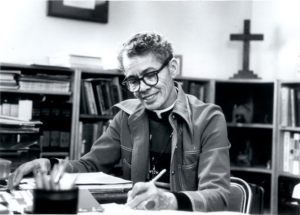
“In not a single one of these little campaigns was I victorious. In other words, in each case, I personally failed, but I have lived to see the thesis upon which I was operating vindicated. And what I very often say is that I’ve lived to see my lost causes found.”
This self-purification process is often a necessary element in social and political change, which as described earlier, is by doing it “with” not just “for” others. Gandhi, for example, believed purification processes were the most powerful antidote to external violence in the world, and helped a person sacrifice one’s well-being for the larger cause. Gandhi’s purification was a daily process which was clear to anyone who looked at how he both dressed and ate. The purification process could even be seen in how he responded to being attacked. Gandhi was incarcerated by the British after the salt march, and many other times was abused by powerful officials. But due to these abuses, social change occurred when the public was shocked and angered by the way he was treated by government officials. The act of sacrifice shifts public perceptions of the horrendous situations facing those being oppressed. The sacrifice and pain endured by such individuals as Martin Luther King Jr. and Nelson Mandela of South Africa existed in a broad, public view, which can galvanize public support for social change.
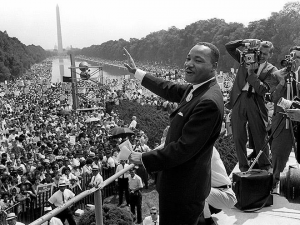
It might appear that activism has only a loosely structured set of rules. In fact, there are no definitive rules to the liberation process, as much depends on context and on the many paradoxes one encounters when trying to change societal systems. Many community activists, such as Alinsky, focused on finding the immoral weaknesses or vulnerabilities of those in power, and inciting the police or public officials to over-react. The activist takes action, like in Gandhi’s salt march, in order to get the powerful system of oppression to react to the defiance.
Therefore there are patterns that help us, but activism is less a set of procedures that can be learned and memorized and more a process of experimentation. This perspective frees one to take risks, but our goal is to use ethical means so that when we are wrong, we will not bring about harm to others. It also gives us additional motivation, and that is of learning, invention, and searching for truth. Altering the path of an abusive power structure is intimidating, and Gandhi saw this as experimentation toward truth. Gandhi and King’s commitment to nonviolence showed the real possibilities, even death, to those that challenge the status quo. These activists embraced a self-purification process, but as Gandhi said, “non-violence laughs at the might of the tyrant” (Gandhi, 2001, p. 57). Nevertheless, both Gandhi and King used self-purification to avoid hating the enemy. Gandhi described this through a story about a burglar breaking into one’s house and the need to treat the thief as family, a concept referred to as critical kinship (Olson, Viola, & Fromm-Reed, 2011). We need to be critical, but at the same time see the opposition as kin.
One might ask whether students can participate in this process of taking on the power structure. The next case study shows it is possible, and it began with student reactions to the lynching of 128 African Americans living in the south. These killings had been unsolved for decades, and when the Justice Department withheld information about these civil rights injustices, it operated as an oppressive power structure. The hiding of this information can lead to cross-generational trauma, as the victims’ immediate loved ones and descendants have to live with the agony of unanswered questions, such as “What happened? Who did it? And why?” The students in Case Study 17.3 sought to answer these questions by confronting the source of the structural violence.
Case Study 17.3
Students Taking Action For Justice
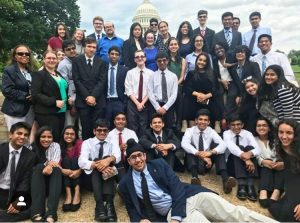
A teacher of Government and Politics at Highstown High School in New Jersey told the students about this historical civil rights injustice, the unsolved lynching of 128 African Americans. They merely asked, “Should we try to do something?” (Jackman, 2019). In a true community organizing fashion, the class made it their mission to bring some semblance of peace of mind to the loved ones of the victims. The class drafted a bill that would force the compilation and immediate release of all the withheld case files to the public. The students understood the importance of focusing on the historical injustices and rectifying them. With the implementation of their activism, the students demonstrated a successful model of praxis. The students conducted research in order to fully understand the issue, took the time to meet with the families of the victims, and made sure to set the agenda through a strategic media campaign. Their efforts were noticed by two US lawmakers, who advocated for the bill and encouraged citizens to pressure the President to sign the proposed bill into law. The students also engaged the President through social media, and the high school allowed the cancellation of classes to undertake the social media effort. The President did sign the bill to release the withheld cases.
The students demonstrated the power of effective community organizing, community engagement, and speaking truth to power in order to take on an oppressive power structure.
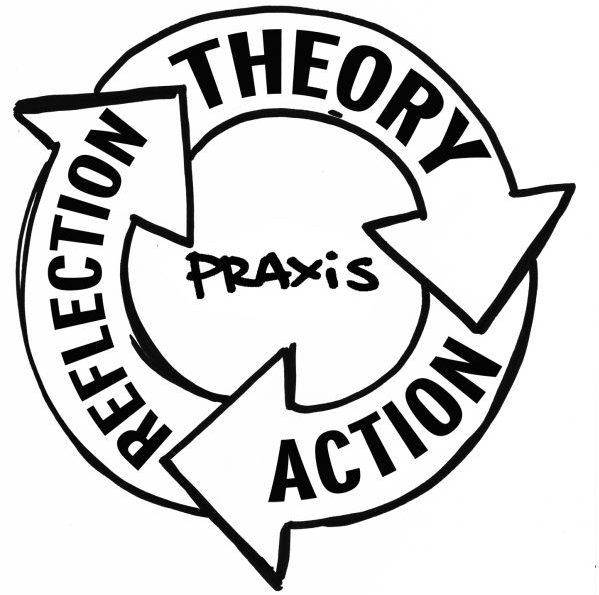
A social justice campaign is rarely a single event or a single march. Organizations begin and fizzle but activists continue to fight for justice. Having a framework for the intricacies of social change is needed for the long-term process to be successful. As discussed earlier, this process is referred to as praxis, which is the cycles of participatory action and research: community input, research, action, and reflection (Olson et al., 2011). Part of praxis is seeing what works and what does not work. When barriers and obstacles are insurmountable, certain tactics need to be let go of in order to search for new creative ways. Community psychologists plan for readjustments, adaptations, setbacks, small wins, and unexpected barriers. They also need to remind themselves of the higher goals they are trying to achieve. A long-term commitment is often the best ally a change agent has, along with allies from the community, in bringing about real change against those who control the status quo (Jason, 2013).
The analysis moves in spirals toward the best possible fit: the combination, the generation, the cyclical action–this is what a temporal campaign involves, until there is progress–a small win, and then another, and another, until transformational change gets going. To implement these processes, finding or creating alternative social settings helps protect individuals and the community from daunting oppression and barriers to change.
We are all part of many settings, some of which are more or less consistent with our social justice identities. To the extent one finds oneself in settings that support oppressor norms, it is possible to work from the inside to change them. When impossible to change, it is often possible to leave a setting, and seek or create new settings that better support one’s values. The creation of alternative settings has been described by Seymour Sarason, whose book The Creation of Settings and The Future Societies has much information on these alternative settings (Sarason, 2000). The creation of such settings is exactly what is needed for the sustainability of campaigns for social justice. The creation of alternative settings takes time and commitment, but they can provide an essential home base for sustainable activist work.
Sustainability of the Campaign Process
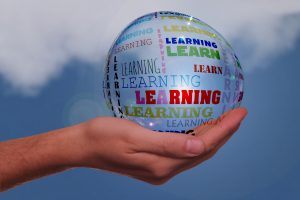
In a praxis-based campaign, it is important to consider what needs to be done first. One of the earliest stages involves generating, with others, hypotheses or ideas for change. A logic model can be developed that provides an outline, and a theoretical structure of how assets and activities are likely to help obtain short, intermediate, and long-term goals. The plan can be simple sketches that represent how one is going to break through the barriers ahead to meet the eventual long-term objectives. This is like a planning notebook and one can connect it with experiences, arguments, and evidence. If the logic model is created as a visual with concepts and arrows, it is possible to see the whole plan in a single glance. The whole group can then discuss and revise, using it as a conversation piece to connect it with all of the group’s experiences and where the group is trying to go together.
Ultimately, community psychologists measure whether or not their actions and efforts were successful in the short and long term. But what should the outcomes be? Certainly, it is useful to know if the program was successful. What actions helped? When it worked, what was the active combination of ingredients that had the effect? How do we study and help amplify where good grassroots connections are happening? Another goal is to understand how we can make a campaign more sustainable. How can capacity be built when campaigns fizzle out? Can we hold onto the small wins and keep going? To answers these questions, and to avoid burnout and keep the campaign sustainable, it is important to pace oneself, and ensure that self-care and mutual education are present at every part of the process (Olson et al., 2011).
Let’s provide another example of a problem that was encountered at a university. One of the highest members of the university’s administration had been actively involved in the APA’s collusion that made it permissible for psychologists to be involved in interrogation settings that included torture. As described earlier in the example with the coalition, this collusion came to the public light following the July 2015 publication of the Hoffman Report. The administrative official was mentioned dozens of times in this Report, and when the school student newspaper emailed Jack O’Brien asking for his reaction, the following case study shows what next occurred.
Case Study 17.4
The Vincentians Against Torture Coalition
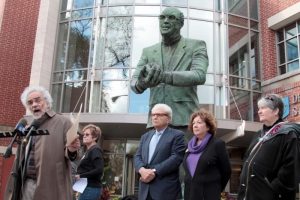
Jack O’Brien was interviewed with the reporter for the school newspaper, and he gave his thoughts regarding the university official who was alleged to have been instrumental in the facilitation of changing APA policy and procedures that allowed for human rights violations perpetrated by psychologists in interrogation settings. After being quoted in the school paper, O’Brien started a petition to remove the official from the university and organized the Vincentians Against Torture Coalition. He collaborated with several local human rights organizations such as the World Can’t Wait and Voices for Creative Non-Violence. He also networked with student groups, such as Students for Justice in Palestine and Movimiento Estudiantil Chicano de Aztlan, that were invested in the issue. His petition amassed over 700 signatures, and this ongoing struggle was prominently featured in many articles in the student newspaper. O’Brien next organized a press conference on campus, which was featured on local television news channels and written about in newspaper articles in the Chicago metropolitan area.
However, even though there was a high level of media visibility and protests involving faculty, staff and students, ultimately, the President of the university announced that the school would not be taking any actions against the university official. In the short run, the campaign had not dislodged this official, but a few years later, both the university President and the official that had been the focus of these protests left the university. Although the protests and the media attention might not have been a direct cause of both officials departing, they contributed to concerns that many university employees had regarding their performance.
Following graduating from college, O’Brien continued to invest himself in the torture/human rights issue affecting psychology, such as organizing a symposium addressing the issue at a national psychology convention. As in case study 17.1, both activists had to stick with the torture issue for a long time in order to see meaningful change occur in the profession of psychology.
The work of Community Psychology does not support hierarchical social and political change. Rather it is non-hierarchical, working from the bottom up with grassroots sources in the community. The voices of the people are the main data that is used. Praxis possesses an improvisational quality, and it is experimentation at its best—as there are many advantages to this approach when working with the community to advocate and engage in social change.
Community psychologists work with community members to mutually educate each other in order to reach more complete understandings of the issues they are facing, and the nuanced impact of these issues. As activists, community psychologists are facilitators, a part of the process, and are intentional and respectful. When community psychologists analyze systems, they use skill and an ecological lens (as pointed out in the first chapter, Jason, Glantsman, O’Brien, & Ramian, 2019), combined with respect for the people they work with. As Coalition for an Ethical Psychology member Roy Eidelson advises, aim to call “…attention to daily injustices, whether that’s working hard for less than a living wage or facing discrimination in housing, education, or law enforcement,” as a first step in challenging and changing dehumanizing structures (2018, p. 203).
Community psychologists, whether they are practitioners or scholarly activists, try to untangle the blocking points and hurdles to social change. Often, the job is to find the paradoxes and tension points, and to help show the world the abuses, just as was done by the leading activists of the past. By using honesty, truth, and the strategies outlined in this chapter, you and your community partners can begin to advocate for long-term change, and bring about a more equitable distribution of resources for a better world.
Critical Thought Questions
Take the Chapter 17 Quiz
View the Chapter 17 Lectures Slides
____________________________________________________________________
Anonymous. (1982). Bobby E. Wright. Journal of Black Psychology, 9(1), iii-vi.
Eidelson, R. (2018). Political mind games: How the 1% manipulate our understanding of what’s happening, what’s right, and what’s possible (1st ed.). Bala Cynwyd, PA: Green Hall Books.
Freire, P. (2007). Pedagogy of the oppressed. New York: Continuum.
Gandhi, M. K. (2001). Non-violent resistance (satyagraha). Mineola, N.Y.: Dover.
Jackman, T. (2019, February 23). ‘From students in high school all the way to the president’s desk.’ How a government class fought for the release of unsolved FBI civil rights case files. Retrieved from https://www.washingtonpost.com/crime-law/2019/02/23/students-high-school-all-way-presidents-desk-how-government-class-fought-release-unsolved-fbi-civil-rights-case-files/?utm_term=.f7d295ead2dc
Jason, L. A. (2013). Principles of social change. New York, NY: Oxford University Press. http://dx.doi.org/10.1093/acprof:oso/9780199841851.001.0001
Jason, L. A., Glantsman, O., O’Brien, J. F., & Ramian, K. N. (2019). Introduction to the field of Community Psychology. In Jason, L. A., Glantsman, O., O’Brien, J. F., & Ramian, K. N. (Eds.), Introduction to Community Psychology: Becoming an agent of change. Retrieved from: https://press.rebus.community/introductiontocommunitypsychology/chapter/intro-to-community-psychology/
Lorde, A. (2007). The master’s tools will never dismantle the master’s house. In A. Lorde (Ed.) Sister outsider: Essays and speeches (pp. 110- 114). Berkeley, CA. Crossing Press.
Olson, B. D., Viola, J., & Fromm-Reed, S. (2011). A temporal model of community organizing and direct action. Peace Review, 23, 52-60. doi: 10.1080/10402659.2011.548253
Rappaport, J. (1987). Terms of empowerment/exemplars of prevention: Toward a theory for community psychology. Journal of Community Psychology, 15(2), 121-48.
Rappaport, J. (1981). In praise of paradox: A social policy of empowerment over prevention. American Journal of Community Psychology, 9(1), 1-25. doi:10.1007/BF00896357
Sarason, S. B. (2000). Barometers of community change: Personal reflections. In J. Rappaport & E. Seidman (Eds.), Handbook of community psychology (pp. 919-929). New York, NY: Kluwer/Plenum.
United Nations. (2006, December 13). Convention on the Rights of Persons with Disabilities. Retrieved from https://www.ohchr.org/en/hrbodies/crpd/pages/conventionrightspersonswithdisabilities.aspx
Wilson, A. (1998). Blueprint for black power : A moral, political, and economic imperative for the twenty-first century (1st ed.). New York: Afrikan World InfoSystems.
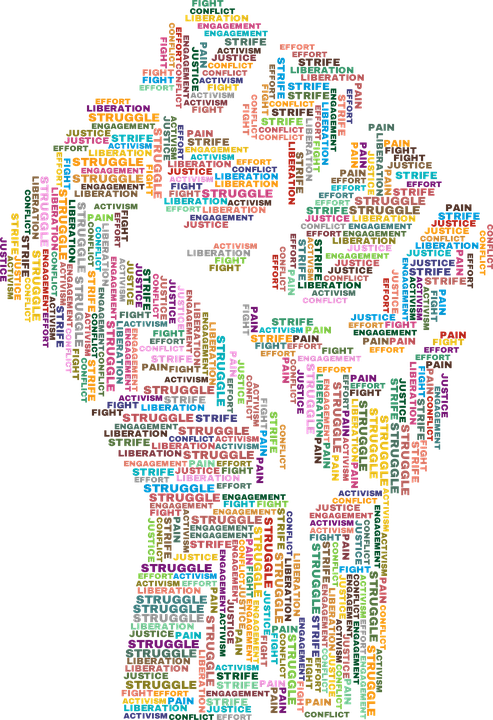
Chapter Eighteen Objectives
By the end of this chapter you will be able to:

What if our research on bringing about change was not used by society to deliver better services to others? In other words, if all the programs and interventions that have been reviewed in this book were never used by others, this would be tragic. Well, two major publications about 20 years ago highlighted this problem of getting the public to use programs that have been validated by research.
The first influential report from the Institute of Medicine (IOM) showed that US healthcare was of low quality (IOM, 2001). So you might ask, why haven’t programs that have been shown to work and are effective been widely implemented throughout our health care system? We need to find answers to this question as we all have a stake in getting the most effective and safe healthcare interventions. When this IOM report was released, everyone was shocked to learn how the US healthcare system fell short of national goals for quality programs being used by the public.
There are long delays between scientific discovery and use of research findings in communities.These healthcare quality concerns were followed by a second report that showed it took an average of 17 years of science before an effective health practice program reached patients (Balas & Boren, 2000). Even more depressing, at the end of the 17 years, adoption of these practices only occurred among 15% of providers. Imagine, the health care you should be getting at age 20 may not reach you until you are 37 years old! And of course, that’s only if you are the lucky one out of six patients (the 15%) whose healthcare is guided by research. Based on these findings, researchers began to focus on the gap between research evidence and healthcare practices.
Ten years after the original IOM report, Health Affairs, an influential journal, published new research on the “quality chasm.” And now, after twenty years, researchers are still finding that their discoveries are not used (Brownson, Proctor, & Colditz, 2018). These high impact findings led to the development of a new field called implementation science. Read more about implementation science here.
Implementation science began because health practices, programs, and policies were not achieving their expected benefits based on their research evidence. When research shows that a treatment works, or a program addresses a problem, we want to realize those benefits in the broader world. In other words, we need to find ways to get effective practices used (or implemented) outside of research studies. Dissemination is the process by which this valuable information is made available for our use. But before we come up with solutions to this dissemination problem, let’s first review the different types of evidence, by which programs are evaluated.
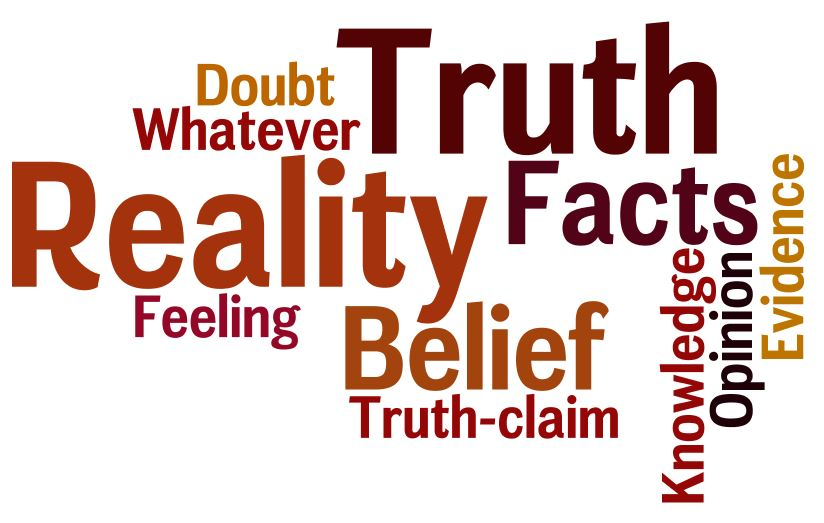
Scientists often differentiate different types of evidence. Efficacy trials (Type I evidence) are often a first step in program development. These trials establish the cause and effect of a program on its intended outcomes. Efficacy trials determine whether a program changes a health outcome under scientifically controlled conditions. Individuals connected to a university often implement these studies. The next step in developing research evidence is typically effectiveness trials. This Type II evidence evaluates cause and effect in community settings, and in these studies the people implementing the studies are often right from the community setting such as a teacher in a school. So, what has been learned by well-trained researchers from the university now are implemented from people in the field to see if positive effects are once again found. Evidence-based practices are identified through a series of efficacy and effectiveness studies published in peer-reviewed literature. The third type of evidence (Type III evidence) evaluates the implementation context, such as an organization’s readiness to implement a new practice. So, one community might be ready and interested to implement a program on birth control, whereas another community might not want to even try to do something in this area due to a number of issues, including the controversies that surround this topic or even lack of leadership to take on such a topic. The readiness of the community is a factor that community psychologists point to as key in whether or not an intervention is successfully implemented (Scaccia et al., 2015). An important is being able to work with communities differently so that we take into consideration their readiness to implement an intervention.
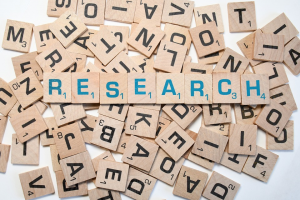
Community psychologists often link imbalances in resource allocation to social problems. But even in the creation and distribution of the research knowledge, there might be inequitable practices. For example, some say that we should only rely on knowledge created during randomized clinical trials, as this is the best way to know whether an intervention is effective. Many members of the community, however, do not have access to the resources or skills to implement these types of expensive interventions. And more to the point, there might be many other ways to understand whether an intervention is effective. There is an important role that community members might play in the creation of knowledge. Collaborative teams involving researchers and community members might be one way that allows information that is created to be actually perceived as valuable and widely disseminated. We will come back to this important issue, but first let’s see how the field of Community Psychology has come up with some strategies to overcome these dissemination problems mentioned at the start of this chapter.

Many people still believe that research knowledge moves efficiently from the research setting (e.g., University) to the community. But this is not always the case. Community psychologists Wandersman and Florin (2003) have examined the gap between research and practice, and they identified a number of the issues that need to be addressed if we are going to effectively deal with the ongoing challenge of putting research to use. It is unfortunate, but just showing that an intervention can improve health does not mean others in society will use those exciting ideas. In other words, just because there is evidence that a particular intervention can solve a health problem, there is no guarantee that it will be adopted by community members and groups. For example, many people might never even get a chance to learn about the innovation, or an intervention is being poorly implemented so its effectiveness is compromised. Clearly, getting effective programs to be used by others is a complex process, and there are often multiple barriers that need to be addressed. Case Study 18.1 shows a real example of community psychologists addressing these types of implementation issues.
Case Study 18.1
The Veterans Health Administration

The Veterans Health Administration is the only national US healthcare system. For over 15 years, the Veterans Administration trained thousands of providers to deliver evidence-based addiction and mental healthcare. The Veterans Administration mandates evidence-based care and offers financial incentives for meeting quality measures. Yet, like most US healthcare, only 3-28% of the Veterans Administration patient population receives the highest quality care. Understanding this limited reach of evidence-based practices is critical to the Veterans Administration policy-makers, providers, Veterans, and their families.
To address this problem, Lindsey Zimmerman and her research team of community psychologists used a partnership approach to equitably involve the Veterans Administration stakeholders in implementation research. The program, Modeling to Learn, was designed according to Community Psychology values, methods, principles, and theories. They sought to develop a systems understanding of the Veterans Administration addiction and mental health services. This occurred by empowering frontline providers to improve the limited reach of evidence-based care with their existing staff and local resources (Zimmerman et al., 2016). They prioritized participatory learning, so frontline staff could better meet the needs of their local veteran communities and sustain improvements over time. They also developed and implemented effective methods to address complex problems with care coordination, medication management, psychotherapy, and the overall mix that services teams offer to reduce impairment, relapse, overdose, and suicide.
Preliminary research findings indicate that this innovative program called Modeling to Learn significantly increased the number of patients who received evidence-based care in the Veterans Administration. One important way to increase the chances that research findings, like the case study above, will be used is the use of Community Psychology participatory methods, as we will illustrate in the next section. These approaches emphasize more equitable engagement by citizens and scientists in the creation and use of scientific knowledge. When this occurs, it is more likely that effective interventions and improvements will be available to us.

Community Psychology began when psychologists saw a better way to address some of the most pressing needs and challenges within their communities (see Chapter 1; Jason, Glantsman, O’Brien, & Ramian, 2019). As indicated throughout this book, participatory research methods are a core strategy used by community psychologists (Jason et al., 2004), and they can be effectively used to address implementation problems.
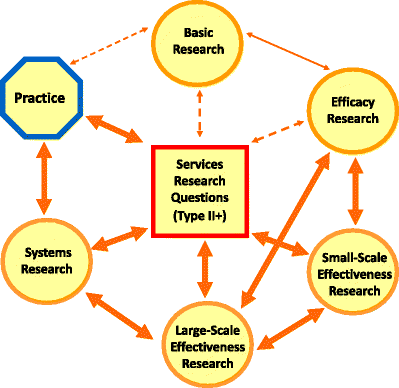
More and more researchers have learned from the field of Community Psychology to bring in community representation in early stages of research. Figure 1 of the National Institute for Drug Abuse Prevention Research Cycle above depicts the need for community input to inform all steps of research development (Robertson, et al., 2012). The NIDA research cycle allows for opportunities to include community input and address contextual factors (dashed lines) earlier in research vs. when input is often used (solid lines). Researchers should pursue knowledge of how community factors will impact program implementation and success. The community-centered approach to implementation is community-driven. With a community-centered approach, community psychologists can ensure that their efforts in health, education, practice, policy, and/or research are actually used, as is indicated in Case Study 18.2.
Case Study 18.2
The Infectious Disease Elimination Act Exchange
The Test and Treat Rapid Access Model is designed to start someone who is diagnosed with HIV on Anti-Retro-Viral medications immediately. Angela Mooss and her team from Behavioral Science Research Institute partnered with the Infectious Disease Elimination Act Needle Exchange in Miami-Dade County, Florida, to process map pathways to implement this model for their clients in collaboration with community partners (e.g., HIV treatment providers). The needle exchange clientele were active injection drug users who received support to reduce the harm associated with drug use. Although Test and Treat was effectively practiced in Miami with multiple community-based organizations, the Infectious Disease Elimination Act Needle Exchange staff had concerns about their ability to use Test and Treat to link their clientele to HIV care.
Although the Test and Treat model was a best practice, effective use required addressing barriers to implementation so that it could benefit the needle exchange’s clientele. So, what did the Infectious Disease Elimination Act Needle Exchange staff do to put Test and Treat into practice? They used community-centered values and participatory methods to develop their implementation plan. A consumer, Jane Doe, helped with planning from the first meeting and identified key barriers that could have gone unnoticed and impacted the program’s success. Jane pointed out that given the timeframe, individuals who are active injection drug users would experience a “come down” during the Test and Treat process. Even with a care navigator, this would make them more likely to leave mid-way rather than complete enrollment. This would minimize the program’s effectiveness linking vulnerable individuals to life-saving treatment. Read more about the Infectious Disease Elimination Act Needle Exchange program here.
By engaging consumer voices and valuing the expertise of their community, the needle exchange staff prevented a failed implementation and they continue fine-tuning the process with ongoing feedback. As a result, the Infectious Disease Elimination Act Needle Exchange staff have found ways to make services more accessible. This includes Medication Assisted Treatment for individuals willing to begin treatment for opioid use, and the provision of Telehealth services so consumers can enroll directly in Test and Treat from the Infectious Disease Elimination Act Needle Exchange hub. Jane Doe’s voice and expertise were highly valued, and this again shows how community psychologists can partner with community members from the very beginning of their work to have programs more effectively implemented.
Successful implementation means that programs often need to be adapted to meet the special needs of the local community, whether they are care managers, foster parents, nurses, teachers, therapists, or physicians. One key question is how much a program needs to be adapted to fit with the local context (adaptation) versus how much it needs to be implemented as intended by developers (fidelity). Fidelity often declines when a program or practice developed under tightly controlled research conditions is then translated to a new community setting. There is some evidence that the closer the community members can implement the programs in similar ways to the researchers, the more positive the health benefits.
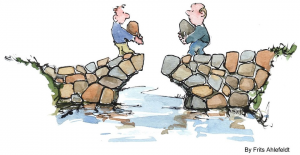
However, fidelity and adaptation need not be at odds. For example, Anyon and colleagues (2019) argue that when adaptations follow some key guiding principles, successful fidelity and adaptation can be achieved (Spoth et al., 2013). If there is a core effective method in an innovation, and it is culturally tailored to a particular community, there is no reason it might not be as effective or even more effective with the selected audience. The key issue is whether the intervention continues to have those basic components that are effective and that it is implemented in a way that the community members are receptive to. Participatory methodologies bridge the research and practice gap through a mutual flow of knowledge among researchers and communities. Bidirectional knowledge sharing goes on throughout the implementation and evaluation phases of the project.
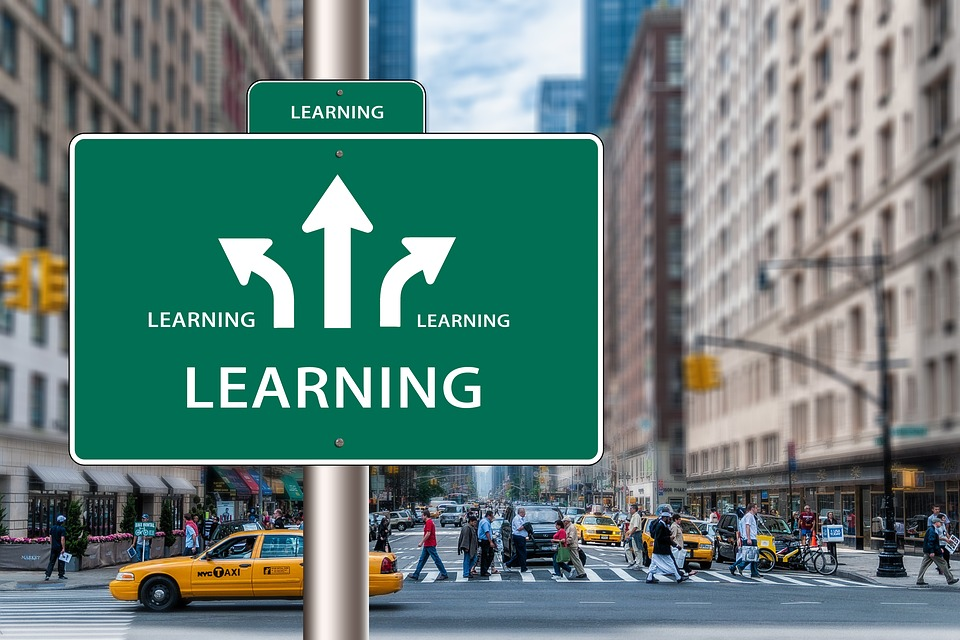
However, there is another problem that often arises, that even when a new program is adopted and used in a setting, it is not sustained. This sometimes occurs because the community has not been provided the means and training to take over the intervention. Here we can rely on another community psychology principle which involves building capacities for local communities to sustain their efforts over time.
In Chapter 7, Wolfe (2019) reviewed practice competencies that are used by community psychologists. Community capacity building is one of the key practice competencies to sustain the benefits of research and practice efforts. Capacity building describes activities that build tangible resources, such as a prevention program, and enable the community to sustain it. Capacity building helps to maintain staff, facilities, and other resources to deliver effective programs over time, especially when research funding ends (Brownson et al., 2018). Capacity building activities include developing a communications strategy, establishing a fund-raising plan, improving data collection and measurement systems, training, and strategic planning. Community psychologists are trained for community leadership and mentoring, facilitating small and large group processes, consultation and resource and organizational development (Dalton & Wolfe, 2012). All of these competencies support community and organizational capacity building. By using community-centered processes to build community capacities, community psychologists help community members gain access to important resources. Learn more about an example of community-centered processes by visiting the “Power Through Partnerships” Community Based Participatory Research toolkit for domestic violence researchers. These type of empowering processes lay the groundwork for achieving desired outcomes and sustainability, as is indicated in Case Study 18.3.
Case Study 18.3
Children’s Trust of South Carolina

Children’s Trust of South Carolina (Children’s Trust) is a statewide nonprofit organization focused on the prevention of abuse and neglect. The vision of Children’s Trust is a South Carolina free from child abuse and neglect. The mission of Children’s Trust is to build strong families and empower communities to prevent child abuse by supporting and delivering programs, building coalitions, providing resources, and leading prevention training.
Children’s Trust is considered an intermediary organization, which means that it does not provide direct services, but partners with community-based organizations across the state, who do provide community services. As an intermediary, Children’s Trust performs five core functions: partnership engagement and communications, implementation support, research and evaluation, workforce development, and policy and finance. These functions form the foundation of the Children’s Trust Partnership Assessment, a tool by which Children’s Trust measures their success at building capacities of partner organizations to provide services within the community. The Partnership Assessment examines if specific capacities have been built and if not, what supports are needed to achieve those specific capacities. In this way, Children’s Trust demonstrates its impact as a partner with community-based organizations to build their capacities for successful and sustained service implementation. Learn more about Children’s Trust here.

In Chapter 1, the ecological model was described, and it involved multiple layers involving individuals, groups, organizations, communities, and the larger society. As is evident from the many case studies in this textbook, individuals can influence communities and communities can influence societies. In addition, societies can influence communities and communities can influence individuals. This ecological model provides a useful framework to better understand the complex relationships among factors that contribute to social and community problems. Program developers and implementers need to aware of this ecological model, as it provides a strong rationale to target our work toward multiple levels of influence. By considering ecological issues, we are better able to avoid and reduce biases (e.g., attribution effect, victim-blaming, racial prejudice, etc.) that can contribute to and perpetuate injustice. This can be particularly important for program implementers who support practitioners working in difficult and under-resourced settings. Case Study 18.4 applies the ecological model to the risk and protective factors involving child abuse and neglect.
Case Study 18.4
The Empower Action Model ®
Children’s Trust, led by Melissa Strompolis, a Community Psychologist, and an interdisciplinary team of researchers, practitioners, and community members developed “The Empower Action Model™” as a blueprint for communities to prevent child abuse and neglect and build well-being and resilience.
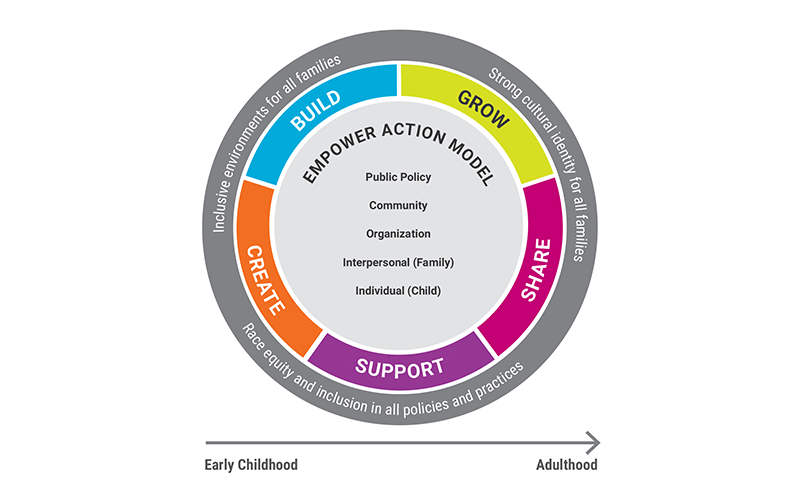
The Empower Action Model™ uses an expanded version of the ecological model to ensure that levels of influence are identified and protective factors are promoted among children, families, organizations, communities, and public policies (Srivastav, Strompolis, Moseley, & Daniels, 2019a). For example, parents and caregivers can protect their children by focusing on child resilience. Organizations can emphasize policies and practices that promote employee health and well-being. Communities can build protective environments for children, including parks, schools, faith-based settings, social services, and health facilities. Policy-makers can also prioritize programs and initiatives that support child health and well-being (Srivastav, Strompolis, Moseley, & Daniels, 2019b). Adapting the ecological model to the mission of Children’s Trust is helping communities all over South Carolina address the very challenging problem of abuse and neglect.
Figure 3 below is useful in addressing some of the specific implementation problems discussed in this chapter.

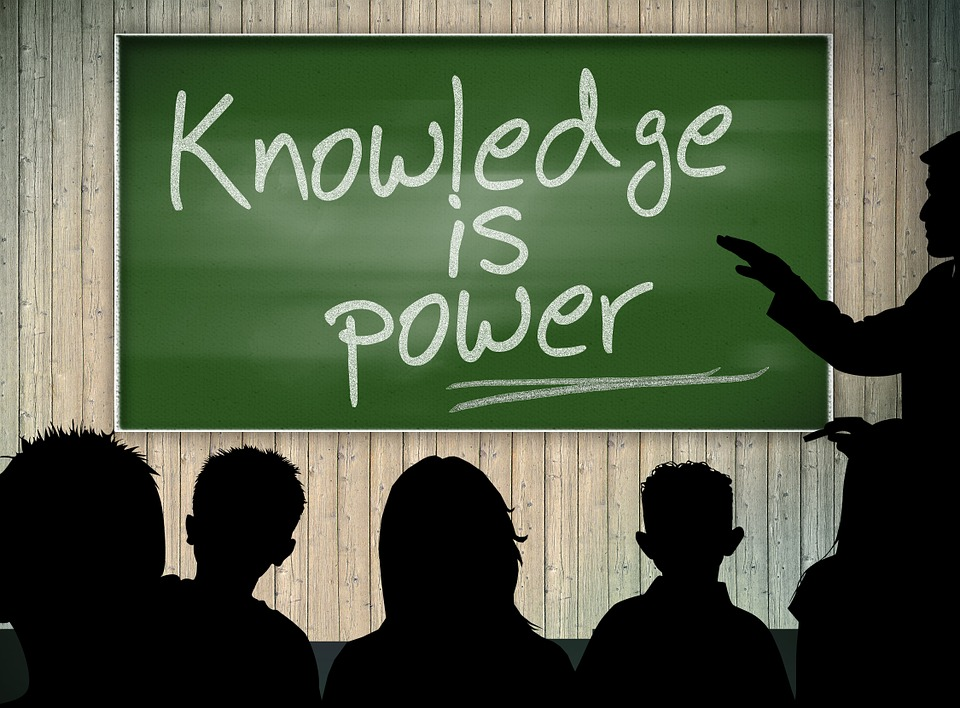
We conclude this chapter with another barrier that confronts so many people, that critical knowledge about the effectiveness of programs remains in privileged settings, such as among academic and scientific audiences, behind paywalls and professional dues. Just as researchers who use participatory methods value community-held knowledge, participatory methods increase the utility and ownership of research findings in communities. Participatory methods aim to support community partners who need to have ongoing access to information and resources.
Community psychologists work to share information to reduce the access imbalance between scientists and communities. As one example, this textbook is an open-access book designed to provide an accessible, free introduction to Community Psychology. Undergraduates can now freely join the Society for Community Research and Action as an Associate member, something that the editors of this textbook successfully advocated for with the leadership of this organization. The Community Psychologist and Global Journal of Community Psychology Practice are also online and open access. Throughout this book, consistent with community-centered values and capacity-building principles, you can learn about free and open blogs, podcasts, and webinars that community psychologists collaborate with communities to share so that new research knowledge can be put to greater use.

In this chapter, we have shown that often research conducted by psychologists does not have an impact on the social and community problems that need our attention. One reason that this information is not widely spread is that many programs, practices, and policies continue to be developed with minimal input from community members. More and more, we are recognizing the problems with this one-sided unidirectional transfer of knowledge.
But the field of Community Psychology does offer a solution to this problem, and by following its values, there is a higher likelihood that the research will be used by community members and those in a position of policy. This chapter has shown the advantages of using participatory research methods, which emphasizes more equitable engagement in the creation and use of scientific knowledge. When using such methods, there is a higher chance that the research will actually translate into programs and be used by members of the community even when the researchers have finished their work. A key to this approach is building capacities for local communities to sustain and grow their efforts. Often problems that we face are complicated, and the field of Community Psychology offers an ecological approach to target multi-layered contributors to problems so that useful and effective approaches are widely implemented.
Critical Thought Questions
Take the Chapter 18 Quiz
View the Chapter 18 Lecture Slides
____________________________________________________________________
Anyon, Y., Roscoe, J., Bender, K., Kennedy, H., Dechants, J., Begun, S., & Gallager, C. (2019). Reconciling adaptation and fidelity: Implications for scaling up high quality youth programs. The Journal of Primary Prevention, 40, 35–49
Balas, E. A., & Boren, S. A. (2000). Managing clinical knowledge for health care improvement. Yearbook of Medical Informatics, 9, 65-70.
Brownson, R. C., Coldtiz, G. A., & Proctor, E. K. (2018). Dissemination and implementation research in health: Translating science to practice (2nd edition). New York, NY: Oxford University Press.
Dalton, J., & Wolfe, S. M. (2012). Joint column: Education connection and the community practitioner. The Community Psychologist, 45, 7-13.
Institute of Medicine (2001). Crossing the quality chasm: A new health system for the 21st century. Washington, DC: National Academy Press. Retrieved from http://www.nationalacademies.org/hmd/Reports/2001/Crossing-the-Quality-Chasm-A-New-Health-System-for-the-21st-Century.aspx
Jason, L. A., Glantsman, O., O’Brien, J. F., & Ramian, K. N. (2019). Introduction to the field of Community Psychology. In L. A. Jason, O. Glantsman, J. F. O’Brien, & K. N. Ramian (Eds.), Introduction to Community Psychology: Becoming an agent of change. Retrieved from https://press.rebus.community/introductiontocommunitypsychology/chapter/intro-to-community-psychology/
Jason, L. A., Keys, C. B., Suarez-Balcazar, Y., Taylor, R. R., Davis, M., Durlak, J., & Isenberg, D. (Eds.). (2004). Participatory community research: Theories and methods in action. Washington, DC: American Psychological Association.
Robertson E. B., Sims B. E., & Reider E. E. (2012). Partnerships in drug abuse prevention services research: Perspectives from the National Institute on Drug Abuse. Administration and Policy in Mental Health and Mental Health Services Research, 39, 327–330.
Scaccia, J. P., Cook, B. S., Lamont, A., Wandersman, A., Castellow, J., Katz, J., & Beidas, R. S. (2015). A practical implementation science heuristic for organizational readiness: R = Mc2. Journal of Community Psychology, 43(4), 484–501. doi.org/10.1002/jcop.21698
Spoth R, Rohrbach L. A., Greenberg M., Leaf P., Brown C.H., Fagan A., … & Hawkins, J. D. (2013). Addressing core challenges for the next generation of type 2 translation research and systems: The translation science to population impact (TSci Impact) framework. Prevention Science, 14, 319–351.
Srivastav, A., Strompolis, M., Moseley, A., & Daniels, K. (2019a). The Empower Action Model©: Mobilizing prevention to promote well-being and resilience. Retrieved from https://scchildren.org/wp-content/uploads/Empower-Action-Model-research-brief.pdf
Srivastav, A., Strompolis, M., Moseley, A., & Daniels, K. (2019b). The Empower Action Model©: A framework for promoting equity, health, and well-being. Health Promotion Practice.
Wandersman, A., & Florin, P. (2003). Community interventions and effective prevention. American Psychologist, 58, 441-448.
Wolfe, S. M. (2019). Practice competencies. In L. A. Jason, O. Glantsman, J. F. O’Brien, & K. N. Ramian (Eds.), Introduction to Community Psychology: Becoming an agent of change. Retrieved from https://press.rebus.community/introductiontocommunitypsychology/chapter/practice-competencies/
Zimmerman, L., Lounsbury, D. W., Rosen, C. S., Kimerling, R., Trafton, J. A., & Lindley, S. E. (2016). Participatory system dynamics modeling: Increasing stakeholder engagement and precision to improve implementation planning in systems. Administration and Policy in Mental Health and Mental Health Services Research, 1–16.
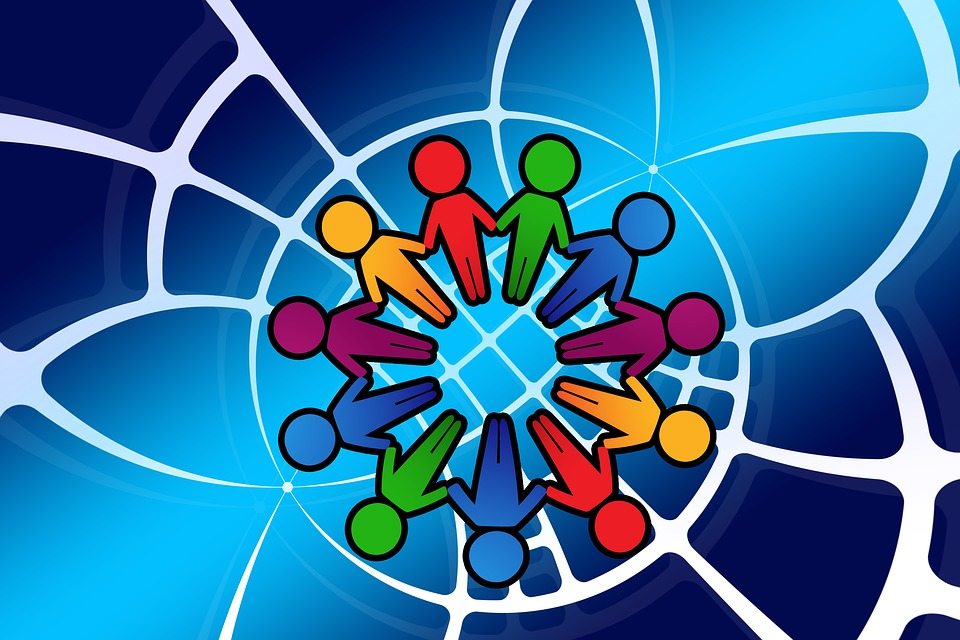
Chapter Nineteen Objectives

Now that you have learned about the basics in the field of Community Psychology, how do you want to build upon your understanding of Community Psychology? To what extent would you like to engage in a career that incorporates Community Psychology? What types of educational degrees are available in Community Psychology? What competencies are central in the field of Community Psychology? How do you engage in and contribute to growing the field? What opportunities are there for becoming a social activist? This chapter will address these questions about education, competencies, and engaging in the field in order to provide you with an overview of some next steps.
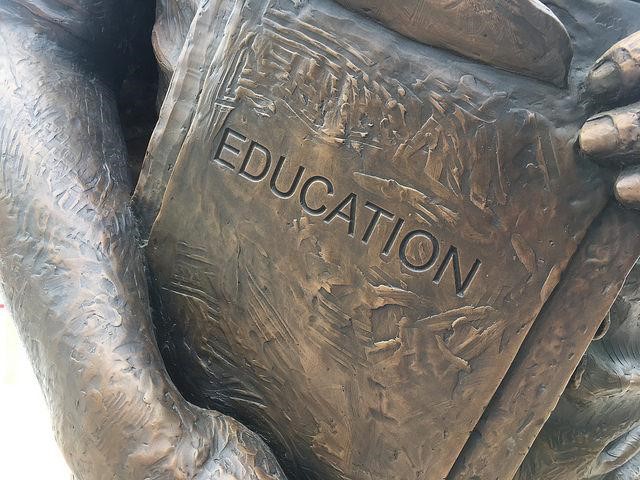
There are different types of educational programs available in Community Psychology. We will describe some of the core components of Community Psychology degree programs at the undergraduate, master’s, and doctoral levels, and you can find a list of Community Psychology programs across levels available on the Society for Community Research and Action’s website (SCRA27.org). Most programs in Community Psychology focus on master’s and doctoral level training. In addition, there are several resources that may be helpful as you explore and consider educational options in Community Psychology (see Glantsman, McMahon, & Njoku, 2015; Jimenez, Sánchez, McMahon, & Viola, 2016; McMahon, Jimenez, Bond, Wolfe, & Ratcliffe, 2015; Serrano-García, Pérez-Jiméne, Rodrigues Medina, 2016).
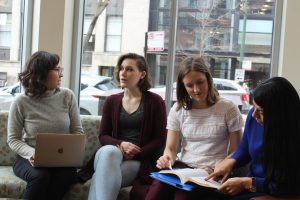
If you are interested in attending a university that has a Community Psychology focus, check out its curricular options in advance because there are few institutions that have a significant focus on Community Psychology at the undergraduate level. For those that have coverage, there is typically a single course. Some universities, though, have developed concentrations or degrees in Community Psychology (Glantsman et al., 2015; McMahon, Jason, & Ferrari, 2010; McMahon et al., 2015). When there is a concentration or a degree in Community Psychology, students will likely gain exposure to multiple content courses, as well as a community-based practicum/fieldwork/internship experience. These experiences may involve working with a non-profit organization that addresses important social issues such as mental health/illness, homelessness, domestic violence, or LGBTQ issues.
Students can receive course credit and group supervision for their hands-on experiences. Even if there is not a Community Psychology concentration at your university, look for Community Psychology relevant internships; students can visit their career center or advisors to find out more. Fieldwork experiences can be tailored to student interests, and students can put the knowledge and skills they have learned into practice. It is often the case that students who engage in these applied experiences with organizations get jobs following the completion of their undergraduate degrees. They are equipped with a range of knowledge and experience related to research, evaluation, systems theory, and intervention.
In addition to internships, another strategy is to reach out to faculty who are engaged in Community Psychology research and interventions. Seek volunteer positions to assist faculty members who are doing community work that you are interested in and passionate about. This will give you invaluable experiences and skills to further your education and training in the field. Develop connections within and outside of your university to be better prepared to take a job in a community-based organization or pursue graduate studies.
Even if you decide not to pursue Community Psychology for graduate school or work with a community-based organization, an undergraduate course, concentration, or degree in Community Psychology is helpful for a range of career options, including clinical psychology, counseling psychology, social work, law, public health, education, and many other career paths. Basic knowledge and skills in Community Psychology (see Table 1 below) are transferable and helpful in addressing social issues, such as poverty, immigration, violence, substance use, mental health, and criminal justice. In addition to courses in Community Psychology, consider taking relevant business courses to enhance your financial and organizational knowledge, and become technologically, methodologically, and statistically savvy (McMahon & Wolfe, 2016; McMahon et al., 2015; Viola & McMahon, 2010). These skills will be useful, whether you decide to enter graduate school or a career with non-profits, and especially helpful if you are interested in consulting, owning your own business, or the financial aspects of non-profits.
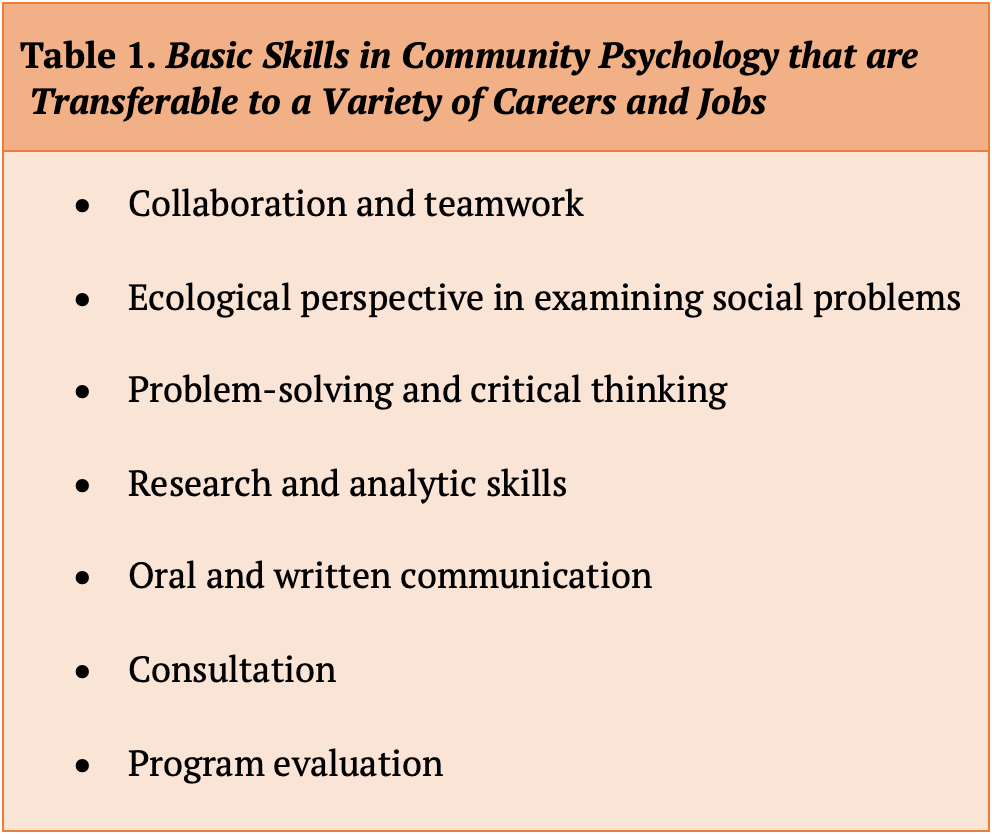
Master’s programs in community research and action may have different names, such as Community Psychology, community social psychology, clinical-community psychology, counseling, and interdisciplinary programs in community research and action. Serrano-García, Pérez-Jiméne, and Rodrigues Medina (2016) identified 75 graduate programs in Community Psychology around the world. Master’s programs include more intensive theory-practice integration than undergraduate programs and many include intensive practicum experiences. A major difference between master’s and doctoral programs is that master’s programs place less emphasis on research and advanced statistical approaches (Dziadkowiec & Jimenez, 2009) and more emphasis on practice than doctoral programs (McMahon et al., 2015).
In many countries, master’s programs are the most typical type of post-graduate program. Most students who enroll in master’s programs are preparing for practice careers in Community Psychology. The timeline to complete a master’s degree is about 2-3 years versus 4-6 years in a doctoral program. Master’s students, in general, are less likely than doctoral students to enroll full time, and many part-time students are employed full-time in local community organizations (McMahon et al., 2015). Thus, there are rich opportunities for students to apply the new knowledge and skills they gain in Community Psychology master’s programs to their organizational and community work.
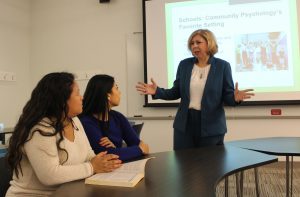
Doctoral programs in Community Psychology tend to include advanced theory, practice, and comprehensive research competencies, and they prepare students for many career options. There are about 45 self-identified community research and action doctoral programs that are community, clinical-community, or interdisciplinary programs. Many of these doctoral programs are in the U.S. and have a primary focus on research, but programs worldwide vary in the extent to which various competencies are emphasized. In the U.S., some programs train students in clinical-community psychology while others are focused solely on Community Psychology. The difference between clinical-community and Community Psychology is that students in clinical-community programs receive training in both clinical (e.g., courses in psychopathology, therapeutic approaches, and clinical areas) and Community Psychology, while students in Community Psychology do not receive clinical training but may receive an interdisciplinary education with Community Psychology as the central focus.
The tradition of doctoral education has historically emphasized the discovery and production of new knowledge through field-specific, and often mentor-based, research opportunities (Austin & McDaniels, 2006). Although traditional doctoral programs may primarily prepare students to become researchers and academicians, doctoral programs are also providing training in the Community Psychology practice competencies (Sánchez, Jimenez, Viola, Kent, & Legler, 2017) such as evaluation, consulting, and grant-writing. This skill set enables students to go onto a variety of career paths, including community-based organizations, healthcare, education, public policy, government, foundations, and business [see Kelly and Viola’s (2019) Chapter 3 in this book for careers in Community Psychology].

There are over 35 master’s programs throughout the world, including those in Argentina, Australia, Canada, Chile, El Salvador, Egypt, Greece, Italy, New Zealand, Portugal, South Africa, Spain, United Kingdom, and the US. Doctoral programs also span a variety of countries, including Australia, Canada, Italy, New Zealand, Puerto Rico, and the US (Serrano-García et al., 2016). Outside of the US, educational programs cater to niches based on the country’s culture, history, and career opportunities. For example, a master’s program in Community Psychology at Pontificia Universidad Católica del Perú (PUCP) prepares students for careers in the government, and graduates enter positions in which they develop and evaluate programs for Peruvian people within various governmental branches (T. Velázquez Castro, personal communication, June 12, 2013). The master’s program in Community Psychology at the American University in Cairo, Egypt focuses on preparing students to work as consultants or in non-governmental organizations (NGOs) where they primarily engage in capacity building activities and community development (M. Amer, personal communication, October 25, 2013). In Latin America, some programs have an emphasis on community social psychology; many graduates work with community organizations, healthcare, education, and to a lesser extent, clinical practice (N. Portillo, personal communication, October 25, 2013). Educational programs are nested within their cultural context, so if you are interested in working with a particular population, you may choose to seek training in that region of the world.
Practical Application 19.1
Who Should Write my Letters of Recommendation for Ph.D. Program Applications?
We recommend that you ask at least one faculty member with who you have engaged in research. If you have two-three significant research experiences, all of your letters could be from research mentors. If you only have one notable research experience, then your other letters should be from a mentor or supervisor from an internship or volunteer experience, and from an advisor, instructor, or mentor with whom you have a strong relationship. The strongest letters will come from people who know you well, have worked with you for at least six months, and can speak to a range of your abilities, your fit with the program, your career goals, your research and academic skills, your motivation, work ethic, character, etc. Letters from instructors who simply taught courses that you took tend not to provide the edge that you need to get into competitive doctoral programs. Finally, when you ask individuals for a letter of recommendation, ask them, “Can you write a strong letter of recommendation for me?” If they hesitate and can’t give you a definitive “Yes,” then you don’t want them to write you a letter of recommendation.

If you believe that graduate study in Community Psychology is an excellent fit with your career goals, there are several strategies that may be helpful including 1) ensuring you have significant research experience, and if you don’t, volunteering to join a research team doing work you find interesting; 2) preparing to take the Graduate Record Exam (GRE), and considering a formal course, tutoring, or re-taking the test if your scores are weak; 3) building relationships with faculty and people working in the field, as you generally need three strong letters of recommendation (see Practical Application 19.1 above); 4) exploring and applying to a range of programs including both master’s and doctoral programs, and making sure the program is a good fit with your interests and career goals; 5) if you are invited for a visit, try and attend one – it will be beneficial for faculty to learn more about you, and you will get a good sense of which programs will be the best fit for you; 6) talking with current students to get a sense of the program from a student perspective; 7) assessing the balance of theory, research, and practice, as well as the core competencies that are taught in the program; and 8) learning about the various career paths of graduates of the program. People who are engaged in the field of Community Psychology tend to be passionate about the values of the field and the mission toward social justice and action, so getting advanced training is an excellent way to become better equipped to make a difference in the world and follow your passion.
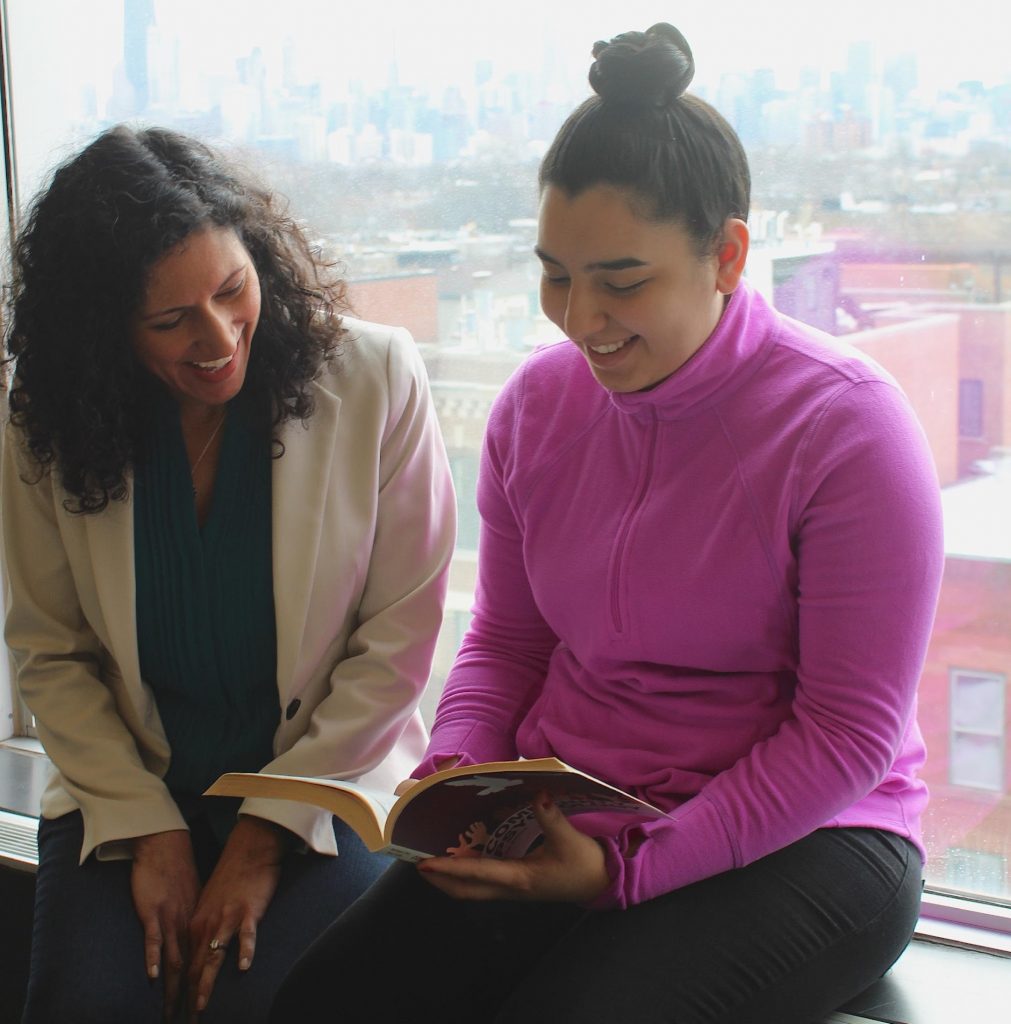
As you consider what educational level you want to achieve and the programs that are a good fit with your interests and career goals, it is important to consider the competencies that you hope to achieve through your undergraduate and/or graduate education. Although there is overlap across programs, different programs emphasize certain competencies more than others. Some are focused more on theory and others are more focused on practice. Thus, you will want to examine exactly what certain programs are training students to do. Below we summarize an array of competencies that have been identified in the field, specifically related to practice and research.
The Society for Community Research and Action (SCRA), the official organization of Community Psychology, has identified 18 core practice competencies (described in Chapter 7 by Wolfe, 2019) related to five themes that are commonly used in Community Psychology careers: 1) foundational principles (ecological perspectives; empowerment; sociocultural and cross-cultural competence; community inclusion and partnership; ethical and reflective practice), 2) community program development and management (program development, implementation, and management; prevention and health promotion), 3) community organization and capacity building (community leadership and mentoring; small and large group processes; resource development; consultation and organizational development, 4) community social change (collaboration and coalition development; community development; community organizing and community advocacy; public policy analysis, development and advocacy; community education, information dissemination, and building public awareness) and 5) community research (participatory community research; program evaluation; Dalton & Wolfe, 2012). Most careers will tap into multiple competencies, while some will emphasize and require advanced skills in particular areas.
SCRA has also identified research competencies that are important for community psychologists. Similar to the practice competencies, it is not expected that community psychologists gain mastery in all of these research competencies but will gain at least exposure to them and experience with some. There are five foundational competencies that underlie all areas of research, including a) research questions and leverage points, b) participatory community research, c) managing collaborations, d) developing community change models, and e) program evaluation (Haber et al., 2017). Further, there are specific research competencies in the areas of research design (e.g., survey design, sampling, mixed methods), data analysis (e.g., descriptive quantitative analyses, basic qualitative methods, missing data and data reduction techniques), and theories and perspectives (e.g., ecological theories, empowerment, policy change; Haber et al., 2017).
In their review of graduate program competencies, as well as the SCRA practice competencies listed above, Serrano-García and colleagues (2016) suggest that these competencies fall into four general categories: knowledge (e.g., application, articulation, integration), research (e.g., methodology, data analysis, writing proposals and reports), cognition, (e.g., identify, analyze, understand, and communicate injustice, values, social context) and practice/profession (e.g., develop, implement, and evaluate interventions, promote social change, demonstrate multicultural competence). Here are some questions to reflect on as you consider educational programs, review the curricula, consider your interests and desired skills, and focus on developing the competencies that will be most relevant for your desired career path. Which competencies are you most interested in learning about? Which competencies do you envision using in your desired career? Which graduate programs will help you develop your desired competencies?
Many individuals pursue the field of Community Psychology because of their interests in social change, and perhaps you are one of these individuals. There are a variety of ways in which you may become an activist to influence the assessment, interventions, or policies that relate to a particular population or social issue. While the field of psychology has traditionally focused on understanding individual behavior and problems as well as treating them at the individual level, Community Psychology is focused on the interaction between the individual and the environment and understanding individual problems from an ecological perspective (See Chapter 1 by Jason, Glantsman, O’Brien, & Ramian, 2019). Because of the values of our field (e.g., diversity, social justice), community psychologists are also interested in changing community and societal issues to ultimately better the lives of individuals. Some community psychologists have dedicated their lives to being scholars and activists in order to create social change. For example, Balcazar and Suarez-Balcazar (2016) have developed and tested community-based interventions that target individual behaviors (e.g., skills, awareness, knowledge) as well as factors in the environment (e.g., accessibility, resources, policies) that affect the lives of people with disabilities. They have also used the Concerns Report Method to help identify community members’ concerns, which are then used to take action on their concerns (see Case Study 19.1 for a description of the Concerns Report Method and how it has been used in various communities around the world).
Case Study 19.1
The Concerns Report Method

While a graduate student at the University of Kansas, community psychologist Yolanda Suarez-Balcazar participated in the development of a community-based participatory methodology, informed by Community Psychology Ecological Systems Theory as well as Applied Behavior Analysis, to identify community concerns and take action. The methodology, called the Concerns Report Method, includes mixed methods, such as focus groups in which community concerns are identified by groups of individuals, development of a concerns survey, survey administration and data analysis, followed by town hall meetings to discuss results and plan actions to address identified issues of concern. Early applications of the Concerns Report Method included addressing the concerns of people with disabilities, such as handicap parking violations. Both Yolanda and Fabricio Balcazar have applied this participatory intervention methodology in collaboration with diverse community contexts. These Include collaboration with residents of Golfito, Costa Rica, who were experiencing displacement by a large multinational corporation; immigrant Latino families living in a suburb of Chicago to identify and address health concerns; Colombian immigrants in the city of Chicago. Most recently Fabricio and a group of community partners applied the Concerns Report Method in Juanaclatan, Mexico. As a result of the implementation of the Concerns Report Method in Mexico, the community addressed several issues such as getting the Governor to allocate funds to treat the contamination of a local river, providing new services for families affected by domestic violence with funds from immigrants living in Chicago, establishing a new community center built by community volunteers on land donated by the local church, and developing new recreational programming for youth. For applications of the Concerns Report Method, check the following resources in the references (Balcazar, Garcia-Iriarte & Suarez-Balcazar, 2009; Suarez-Balcazar, Martinez & Casas-Byots, 2005; Suarez-Balcazar & Balcazar, 2016).
Another approach to creating social change is by influencing social policy, and there are several ways that you may go about affecting it. Policy work is important because it is an avenue for psychologists to apply psychological principles to benefit public interest. Community psychologists are well positioned to conduct policy-relevant research and influence social policy to improve the quality of life for many people. Maton (2017) interviewed 79 psychologists (mostly developmental, social and/or community psychologists) about their careers as influencers of social policy. These interviews revealed that there are four key skills that participants used to change social policy, including a) building relationships with policymakers, staff members at intermediary organizations, media, practitioner groups, and/or researchers, b) research skills to conduct original research, evaluate research evidence, and to synthesize research literature, c) oral and written communication skills, and d) strategic analysis skills. Further, there were a variety of ways that these psychologists influenced social policy, such as serving as a member or chair of a policy advisory group, advocacy and lobbying, educating the public through the media, and sharing relevant psychological research and theory with key court cases. A key lesson that community psychologists share is the importance of being patient and persistent, as creating social change takes a long time and one may face many barriers and failures along the way. Jason (2013) advises community psychologists to take small steps to influence social change; small steps may include creating and signing petitions, attending a protest, contacting local legislators, and writing a policy brief.
There is much work to be done by community psychologists in both research and practice that is relevant to social action and social change. Systems can support or even promote violence and oppression. Langhout (2016) mentions several examples of state-sanctioned violence in the U.S., as well as movements that emerged in response to this violence in Fuerguson, Charleston, and other locations in the US. The violent act occurs in society on the ecological level, and the society responds by organizing and creating a movement in defense of those unjustly harmed.
Langhout (2016) argued that community psychologists need to use liberatory approaches and practices in order to transform society and truly free oppressed peoples. She calls on community psychologists to build on the work of feminist scientists, critical feminist social psychologists, and critical feminist social-community psychologists who focus on “the study of subjectivity, process, change, connectivity, desire, and difference” in order to build solidarity with the people most affected by state-sanctioned violence and disrupt the structures (e.g., whiteness, patriarchy, class privilege) that support the violence (p. 325).
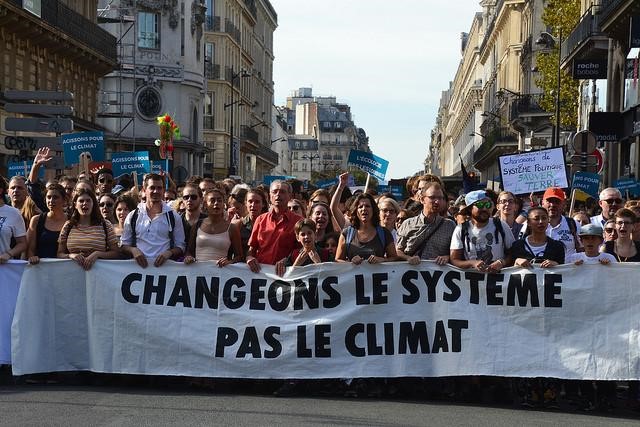
Several textbooks including the current one by Jason, Glantsman, O’Brien, and Ramian (2019) have identified areas of future work for community psychologists, which are summarized below. These are topics that any student in Community Psychology can pursue in their career and/or educational path.
Given increasing globalization and migration in various societies around the world, an appreciation for different types of diversity based on background, experiences, or cultures is important in helping individuals and communities with problem-solving, innovation, creativity and informed decision making. In addition to an appreciation for diversity, compassionate attitudes are essential in order to effectively help others who are suffering. Our field could benefit from research investigating appreciation of diversity and compassion as outcomes rather than only as predictors. For example, researchers can examine the structural qualities that predict appreciation of differences and develop interventions that create compassionate communities (Moritsugu et al., 2014).
Climate change and waste of natural resources have been pressing issues around the world. Many view climate change as a human rights and social justice issue, as it disproportionately impacts poor communities around the globe (Levy & Patz, 2015). For example, the environmental consequences of climate change influences access to safe food and water, which negatively affects health. Foodborne and waterborne diseases, respiratory disorders, and malnutrition are a few of the consequences (Levy & Patz, 2015). Given our field’s values towards helping oppressed communities, addressing climate change along with environmental classism and racism would prevent further health and economic problems in communities.

In the United States, the gap between the rich and poor is at an all-time high. Specifically, the median wealth of upper-income families was seven times greater than middle-income families and 75 times greater than lower-income families in 2016; for comparison purposes, the median wealth of upper-income families was 28 times the wealth of lower-income families in 1983 (Pew Research Center) (Kochhar & Cilluffo, 2017). There are also racial differences in wealth with Latinx and African-American families having disproportionately less wealth than White families (Kocchar & Cilluffo, 2017). These economic and racial inequalities influence access to quality schooling, health care, and job opportunities. As indicated in Chapter 1, Jason, Glantsman, O’Brien, and Ramian (2019) indicated that policy changes and increased political involvement are necessary to reduce these disparities. Further, they suggest that community psychologists examine ways to remove structural obstacles in order to reduce disparities.
Issues of aging are generally understudied in psychology, and Moritsugu et al. (2014) encourage community psychologists to research and create interventions to help with enhancing the quality of life for our growing elderly population around the globe. Further, our society values life and vitality, and hence, discussions of death and dying are taboo. Community psychologists could do much to help individuals and their families and communities better deal with and face death and dying head on and support loved ones as they grieve. There are countless important global issues to address and populations to work with to make a difference – the choice is yours and will depend on where your passion lies.
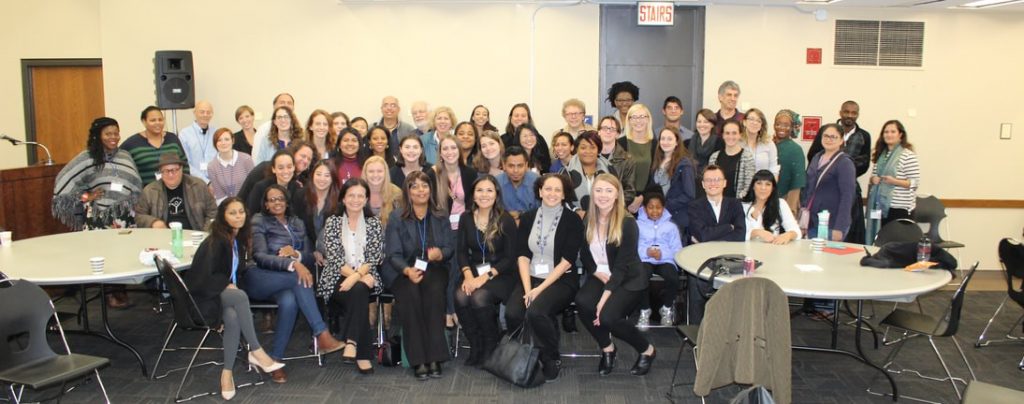
Engaging in the field is an important next step and can give you energy, social connections, and resources that will facilitate pursuing your passion. There are many opportunities to connect with people who have similar values and are interested in applying these values to their work. Join SCRA and the SCRA listserve, and get involved in leadership opportunities. SCRA27.org provides helpful information for members, including opportunities to get involved in interest groups, committees, councils, and the Executive Committee. In addition, the website includes lists of undergraduate, master’s, and doctoral programs in Community Psychology, teaching materials, policy statements, webinars and blogs, and other helpful resources. Build your networks within and across your discipline and collaborate with others (McMahon et al., 2015; McMahon et al., 2016). Engage in professional development to stay current and grow your knowledge and skills through conferences, webinars, and workshops. Continuing education opportunities provide an avenue to grow stronger networks of community psychologists sharing their work and promoting community change across generations and settings (Jimenez et al., 2016). For example, the regional student-run Eco-Community Psychology Conferences (Flores et al., 2013) are a great place to network with other students, and these conferences have been occurring for the past 40 years. Another way to learn more about specific skills of interest is to explore and become familiar with the Community Toolbox. This online resource has a plethora of helpful guides to facilitate social action, including assessing community needs and resources, developing a model of change, developing strategic and action plans, developing an intervention, evaluating the initiative, and applying for grants.
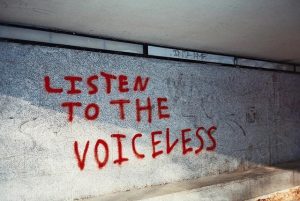
Use the field to guide your work. Research is an important component of Community Psychology, so check out the literature on topics of interest, read the current research, and explore what others have done before you start something new. There are many empirically-based programs, so don’t re-invent the wheel without first learning what others have spent years creating and testing. Assess the extent to which existing theories, strategies, and programs have been applied to work in your area. Using resources such as university libraries (if you have access), Google Scholar, Research Gate, and other online tools can help you access literature that can guide your work. If you can’t access articles you need that are relevant to your work, try requesting them from the authors via email.
Follow your passion to make a difference. Appreciate “small wins” and engage in self-care. Working systemically to promote health and well-being among underserved populations is important work that can have far-reaching effects at the local, regional, state, national, and international levels. Be patient, and don’t try to do it all at once; figure out where your talents lie and where you can make a difference and work with others to have a larger impact.
Our field is small but of utmost importance – can you think of anything better than to work toward solving the world’s problems through strategic, systemic, evidence-based practices in collaboration with organizations, communities, and government? You can help grow the field through a variety of strategies, such as 1) connecting with your local and national organizations to increase awareness of Community Psychology competencies and the fit with their work; 2) using technology and social media to increase visibility of good work in the field, such as through Twitter, blogs, Linked In, Instagram, Facebook, and videos that illustrate exemplary projects and public discourse on social issues; 3) looking for opportunities to introduce yourself as a community psychologist or someone who has training in Community Psychology. You should have an “elevator speech,” in which you provide brief bullet points about the field and what we do. Community psychologists add distinctive value through the ways in which we combine science, understanding of systems, and an ecological approach to contribute to an adaptive, collaborative team approach to sustainable change (Community Psychology Practice Council, 2010). You need to be able to describe to others what you bring to the table quickly and in user-friendly ways.
Disseminate your work through various outlets to yield greater visibility and impact for our field (Jimenez et al., 2016). Be politically and socially active in your community and share your work with communities across levels (e.g., locally, regionally, nationally). In addition to traditional academic outlets, submit articles and Op-Eds about your work to local newspapers, newsletters, websites, blogs, and other sources to let the public know about your Community Psychology-related work and impact (McMahon & Wolfe, 2016). Disseminating your work through social media helps keep the work current, relevant, and linked with those who find it most helpful (Jimenez et al., 2016). Communitypsychology.com is a website that SCRA created to interact with the public and share the important work we are doing; consider submitting your research or practice work – there is an array of topics, including education, healthcare, children, environmental issues, prevention, criminal justice, public policy, substance use, violence, and housing. The field of Community Psychology offers a wealth of knowledge, skills, strategies, research methodologies, and interventions to create a more socially just society – now it is up to us to grow the field using a multi-pronged approach to action and dissemination.
Here are some questions to consider as you reflect on the next steps in your potential future career in Community Psychology. What are the issues that you care about most? How can you as an individual get involved in addressing these issues? What would you do differently based on the material you learned about in this book? How can you join with others, such as through local, regional, national, or international organizations, to make a difference? We have created an “Action Checklist” below to help you answer these questions.
Practical Application 19.2
Action Checklist
Below is a list of ways you can get more involved in Community Psychology.

After learning about the field of Community Psychology, consider which path will facilitate your journey and what your next steps might be. There are undergraduate, master’s, and doctoral level courses and programs around the world that can be beneficial depending on your experience and career goals. Consider social issues that matter to you and the Community Psychology competencies that will help you address these issues as you plan for your career. Gaining research skills and applied experiences through Community Psychology education will provide you with tools to effect social change. Join and become meaningfully involved in SCRA to connect with the field and a community of scholars and practitioners with similar values. Learn about others’ work, share resources and knowledge, and collaborate with colleagues to become the next generation of transformative community psychologists.
Critical Thought Questions
Consider the following questions to assess whether you may be best equipped for an undergraduate, master’s, doctoral, and/or international education.
1. What would you like to do when you finish your education? How might Community Psychology be part of your career plans?
2. What skills would you like to use in your work?
3. With what populations and in what settings would you enjoy working?
4. Have you been involved with research? If so, do you like it? Many people think they don’t like research, but once they try it, they find it to be very interesting.
5. How much do you see research or evaluation as part of your job description? How might you apply research or evaluation in a setting to assess and modify work being done?
6. How much do you see program development and management as part of your role?
Take the Chapter 19 Quiz
View the Chapter 19 Lecture Slides
_____________________________________________________________________
Austin, A., & McDaniels, M. (2006). Using doctoral education to prepare faculty to work within Boyer’s four domains of scholarship. New Directions for Institutional Research, 2006(129), 51-65.
Balcazar, F., Garcia-Iriarte, E., Suarez-Balcazar, Y. (2009). Participatory Action Research with Colombian Immigrants. Hispanic Journal of Behavioral, Sciences, 31(1), 112-127.
Balcazar, F. E. & Suarez-Balcazar, Y. (2016). On becoming scholars and activists for disability rights. American Journal of Community Psychology, 58, 251-258.
Community Psychology Practice Council (2010). An Evidence-Informed Community Psychology Value Proposition. Retrieved from http://www.scra27.org/files/4513/9007/7333/Evidence_based_CP_Value_Proposition__Final_20110829.pdf
Dalton, J., & Wolfe, S. (Eds.). (2012). Education connection and the community practitioner. The Community Psychologist, 45(4), 7-13.
Dziadkowiec, O., & Jimenez, T. (2009). Educating Community Psychologists for community practice: A survey of graduate training programs. The Community Psychologist, 42(4), 10-17.
Flores, S., Jason, L. A., Adeoye, S. B., Evans, M., Brown, A., & Belyaev-Glantsman, O. (2013). The evolution and growth of the Eco-Community Psychology Conferences. Global Journal of Community Psychology Practice, 4(2), 1-8. Retrieved from http://www.gjcpp.org/pdfs/2012-006-final-20130502.pdf
Glantsman, O., McMahon, S. D., & Njoku, M. G. C. (2015). Developing an undergraduate Community Psychology curriculum: A case example. In M. G. C. Njoku, C. C. Anieke, & P. J. McDevitt (Eds.), Frontiers in Education: Advances, Issues, and New Perspectives. Enugu, Nigeria: ABIC Books.
Haber, M. G., Neal, Z., Christens, B., Faust, V., Jackson, L., Wood, L. K., Scott, T. B., & Legler, R. (2017). The 2016 survey of graduate programs in Community Psychology: Findings on competencies in research and practice and challenges of training programs. The Community Psychologist, 50(2), 12-20.
Jason, L. A. (2013). Principles of Social Change. New York: Oxford University Press.
Jason, L. A., Glantsman, O., O’Brien, J. F., & Ramian, K. N. (2019). Introduction to the field of Community Psychology. In L. A. Jason, O. Glantsman, J. F. O’Brien, & K. N. Ramian (Eds.), Introduction to Community Psychology: Becoming an Agent of Change. Retrieved from https://press.rebus.community/introductiontocommunitypsychology/chapter/intro-to-community-psychology/
Jimenez, T. R., Sánchez, B., McMahon, S.D., & Viola, J. (2016). A vision for the future of Community Psychology education & training. American Journal of Community Psychology. 58, 339-347.
Kelly, A., & Viola, J. (2019). Who we are. In L. A. Jason, O. Glantsman, J. F. O’Brien, & K. N. Ramian (Eds.), Introduction to Community Psychology: Becoming an agent of change. Retrieved from https://press.rebus.community/introductiontocommunitypsychology/chapter/who-we-are/
Kochhar, R., & Cilluffo, A. (2017, November 01). How U.S. wealth inequality has changed since Great Recession. Pew Research Lab. Retrieved from http://www.pewresearch.org/fact-tank/2017/11/01/how-wealth-inequality-has-changed-in-the-u-s-since-the-great-recession-by-race-ethnicity-and-income/
Langhout, R. D. (2016). This is not a history lesson; this is agitation: A call for methodology of diffraction in US-based Community Psychology. American Journal of Community Psychology, 58, 322-328.
Levy, B. S., Patz, J. A. (2015). Climate change, human rights and social justice. Annals of Global Health, 81(3), 310-322. https://doi.org/10.1016/j.aogh.2015.08.008
Maton, K. I. (2017). Influencing social policy: Applied psychology serving the public interest. New York: Oxford University Press.
McMahon, S. D., & Wolfe, S. (2016). Career opportunities for Community Psychologists. In M. Bond, I. Serrano-García, & C. Keys (Eds.), Handbook of Community Psychology: Volume II. (pp. 645-659), Washington DC: American Psychological Association.
McMahon, S. D., Jason, L. A., & Ferrari, J. R., (2010). Community psychology at DePaul University: Emphasizing urban education in America. In C. Vázquez, D. Pérez Jiménez, M. F. Rodríguez, & W. P. Bou (Eds.), International Community Psychology: Shared Agendas in Diversity. (pp. 419-449). Puerto Rico: Actividades d Formación Comunitaria, Inc.
McMahon, S. D., Jimenez, T. R., Bond, M. A., Wolfe, S. M., & Ratcliffe, A. W. (2015). Community Psychology education and practice careers in the 21st century. In V.C. Scott & S.M. Wolfe (Eds.). Community Psychology: Foundations for Practice, (pp. 379-409). Thousand Oaks, CA: Sage Publishing, Inc.
Moritsugu, J., Duffy, K., Vera, E., & Wong, F. (2014). Community Psychology (5th ed). New York: Routledge.
Sánchez, B., Jimenez, T., Viola, J., Kent, J., & Legler, R. (2017). The use of Community Psychology competencies in a fieldwork practicum sequence: A tale of two graduate programs. Global Journal of Community Psychology Practice, 8(1), 1-24.
Serrano-García, I., Pérez-Jiméne, D., & Rodrigues Medina, S. (2016). Education & training in Community Psychology. In M. Bond, I. Serrano-García, & C. Keys (Eds.), APA handbook of Community Psychology: Methods for community research and action for diverse groups and issues (Vol. 2, pp. 625-644). Washington DC: American Psychological Association.
Suarez-Balcazar, Matinez, L., & Casas-Byots C. (2005). A participatory action research approach for identifying the health service needs of Hispanic immigrants: Occupational Therapy in Health Care, 19, 145-163.
Suarez-Balcazar, Y., & Balcazar, F. (2016). Functional analysis of community concerns: A participatory action approach. In L. Jason & D. Glenwick (Eds). Handbook of Methodological Approaches to Community-based Research. (pp. 315-323). New York: Oxford University Press.
Viola, J. J. & McMahon, S. D. (2010). Consulting and evaluation with nonprofit and community-based organizations. Sudbury, Massachusetts: Jones and Bartlett Publishers.
Wolfe, S. (2019). Community Psychology practice competencies. In L. A. Jason, O. Glantsman, J. F. O’Brien, & K. N. Ramian (Eds.), Introduction to Community Psychology: Becoming an agent of change. Retrieved from https://press.rebus.community/introductiontocommunitypsychology/chapter/practice-competencies/

Acknowledgments: We are very grateful to the following graduate students who contributed to the photographs, glossary, and quiz: Kayleigh Zinter, Wendy de los Reyes Moore, and Kailyn Bare.
Refers to collegiate environments where teaching and research activities take place.
Research that generates knowledge through participatory university/community partnerships in the hope of bringing about social change.
Assures a higher level of involvement in partnerships involving both community psychologists and community members.
In Community Psychology terms, activism is any action taken in an effort to bring about second-order change to address an injustice in society.
Observable stressful events that are time-limited.
Focuses on interactions between persons and their environments to better understand why behavior that is effective in one setting may not be useful in others.
Refers to the effectiveness of a given coping response within a given context and for a given challenge or problem that the individual experiences as stressful.
Advocacy involves active promotion of a cause or principle involving actions that lead to a selected goal.
The process by which social problems and the solutions to these problems gain or lose the attention of policymakers or the public.
The developmental changes and transitions that comes with being a child, adolescent, or adult.
A novel, new community of people that are allowed to live freely and pursue that matters on the individual and group levels.
Anything preceding a behavior that signals the likelihood of a consequence if the behavior is performed.
The application of principles of behavioral science to applied problems.
Individuals who experience significant and chronic stressor events and are at-risk for developing associate physiological (e.g., cardiovascular complications) and psychological (e.g., anxiety, depression) symptoms.
Involves avoidant actions and cognitive avoidance, these strategies attempt to manage emotions by trying to avoid thinking about the stressor.
An American psychologist known for his influential work in behavioral psychology.
A technique used to change the frequency or duration of a behavior.
Natural or developed ecological environments
where behaviors evolve over time. A process by which different types of settings can be expected to influence the behaviors of people within a variety of different types of situations.
A science of behavior focusing on the relationship between behavior and its consequences, resulting in a greater understanding of the principles of behavior that are observable and replicable.
The application of the principles of behavioral science to applied problems in community settings.
A research ethics principle that requires that researchers do no harm and maximize possible benefits, and they can do this by finding less risky methods to achieve research goals.
A conference held every two years by The Society for Community Research and Action.
An approach to community change that originates with community members rather than experts.
A feeling of overall exhaustion that results from too much pressure and not enough sources of satisfaction or support.
A process in which communities or organizations work to improve their collective skills and resources.
Also called a market economy, is an economic system in which a country's trade and industry are controlled by private owners for profit, rather than by the state.
Persistent demands on an individual; typically open-ended, using up our resources in coping but not promising resolution.
Someone employed by the government to work in the public sector to implement policies and laws.
Refers to a procedure of learning in which a stimulus (e.g., food) is paired with a previously neutral stimulus (e.g., a bell) to shape behavior.
A type of doctoral program that provides students both clinical training, such as psychopathology, therapy, and assessment, as well as Community Psychology skills, such as consultation, evaluation, and community intervention.
A reciprocal relationship between two or more people with a shared goal in mind.
The belief that the actions of the group can be successful in creating change.
Understanding and encouraging the state of good health for groups of people and communities.
Described in four interrelated domains: control of economy (land appropriation, exploitation of labor, control of natural resources); control of authority (institution, army); control of gender and sexuality (family, education) and control of subjectivity and knowledge (epistemology, education, and formation of subjectivity).
The extension of a nation's sovereignty over territory beyond its borders by the establishment of either settler colonies or administrative dependencies in which indigenous populations are directly ruled or displaced. Colonizing nations generally dominate the resources, labor, and markets of the colonial territory, and may also impose socio-cultural, religious, and linguistic structures on the conquered population.
A set of organizations, institutions and community agents that cooperate to improve the living conditions of the community.
Empowerment occurring at the community level, in which members uses resources, develop skills, exert influence, and effectively organize to address the issues that matter to the community.
Prevention or promotion programs that aim to promote behavioral change in defined community contexts to address social problems.
A national movement in the 1960s to more efficiently and cost-effectively treat mental illness in community settings rather than solely psychiatric hospitals.
Engaging in actions with in a collaborative way with other psychologists, professionals in other disciplines, community members, organizations, and local government.
A person who seeks to improve community wellbeing through a cycle of collaborative planning, action and research in partnership with local community members.
A field that goes beyond an individual focus and integrates social, cultural, economic, political, environmental, and international influences to promote positive change, health, and empowerment at individual and systemic levels (SCRA27.org).
The 18 competencies help define and clarify the unique combination of skills and values that differentiate community psychologists from other people working in community settings.
Having the required skills to effectively engage in community psychology practice.
Degree to which the community is prepared for the behavioral and social changes that are intended by the intervention.
The collective ability of a defined group of people or geographic area to deal with change or adversity effectively.
Some Community Psychology programs are embedded within a larger frame of social psychology, the study of how individuals are influenced by others.
An approach that encompasses understanding the interrelated parts and dynamics of a community. Each part has its own organizing processes that influence, and in turn are influenced by, other parts. The total systems then are organized at a higher level that transcends the organizing process of any one part.
An online resource that provides detailed guides on how to work with organizations and communities to engage in social action, including information on assessing community needs and strengths, creating a model of change, designing plans, interventions, and applying for grants.
Research that involves an exchange of resources and ideas between researchers and the community members as a way of underdstanding that is guided by community needs.
Refers to designing an intervention or program with an awareness of community factors and active participation and input from community members.
A set of courses within a larger degree program that enables you to specialize in a discipline such as Community Psychology.
Research that is used to educate policymakers and stakeholders on social issues and propose possible solutions.
Using expertise and skills to provide advice, and support to other organizations looking to make decisions or change something within their organization.
The surroundings, circumstances, environment, background, or settings which determine, specify, or clarify the meaning of an event or other occurrence.
The individual, psychological, familial, community, and societal factors that influence people.
Advanced education programs, courses, webinars, workshops, or conferences that provide additional training in particular Community Psychology-related issues or skill sets.
A design decision that dictates whether or not there is a control group (a group that is used for a baseline without intervention and to compare with the group of participants with the intervention).
Refer to approaches that explain the processes of how an individual handles a stressor(s). An individual’s coping model will be determined by cultural, social, and personality characteristics of people and will elicit a given set of coping strategies.
Ongoing cognitive and behavioral efforts to manage external or internal demands/problems/challenges perceived by the individual as stressful. The process for coping is influenced by the context where the demand arises, the time the stressors last, and how long before one responds.
The personality dispositions or traits that transcend the influence of the situational context and time when choosing a coping strategies (Lazarus, 1993).
Becoming knowledgeable of the injustices or the oppressions in an individual’s life and in society around them.
This perspective seeks a psychological understanding within historical, social, cultural, and political contexts.
Possessing the skills and knowledge necessary to effectively work with members of a culture.
Ongoing process of learning about other cultures and being sensitive to cultural differences. Cultural humility includes acknowledging one’s own lack of knowledge about aspects of culture and recognizing power dynamics that impact the relationship.
Dynamic concept of shared meanings and experiences that are passed down over time and generations. Culture includes shared beliefs, values, practices, definitions and other elements that are expressed through family socialization, formal schooling, shared language, social roles, and norms for feeling, thinking, and acting.
The systematic process of using and developing materials and resources that impact community growth and development.
As a revolutionary epistemology, decolonial theory and methods feature critical insights into knowledges from subaltern voices concerned with how the implementation of modern technologies shape colonial structures, inequalities, the daily lives of the colonized, and resistance strategies.
Deconstruction is a concept central to postmodernism. It is a process of rigorously analyzing and making apparent the assumptions, judgments, and values that underlie social arrangements and intellectual ideas.
The reclaiming of power as liberation from oppression. Theoretical concepts such as empowerment and decolonization provide a baseline for community capacity building and self-determination.
Involves redefining the targets of prejudice and violence by making them seem less human (that is, less civilized or less sentient) than other people.
Also known as power structures; structures created in society that benefit the oppressor class in the form of institutions, policies, influence, and other societal constructs.
The long-term process of reducing the number of psychiatric hospitals and replacing them with less isolatory and community-based alternatives for people with disabilities or mental illnesses.
Visible or hidden and temporary or permanent conditions that provide barriers or challenges, and impact individuals of every age and social group.
To deprive of a franchise, of a legal right, or of some privilege or immunity especially; to deprive of the right to vote.
The deliberate sharing of research findings to groups and communities that would benefit from said findings.
Refers to how much of the intervention they do deliver: for example, number of sessions, number of hours, time of application of the program, and so on.
Understanding the relationships between people and their social environments (e.g., families, groups, communities, and societies).
A subfield of psychology related to Community Psychology which focuses on the real-world relationships between people and their environments.
Achievement of the results intended by the intervention (it is an indicator that the intervention works properly).
A short summary (about 2 minutes) that you share with anyone who asks about your work, interests, and/or the field of Community Psychology.
When an individual responds with efforts to manage the emotional response to a stressful event by focusing directly on it in a constructive way.
The research whose results fall strictly on observable and verifiable evidence. It can be based on quantitative or qualitative methods.
The process of gaining power emerging at the individual, organizational, community, and societal levels, which are affected by peoples' previous experiences, skills, actions, and context.
Originally described by Julian Rappaport (1981), empowerment refers to the capacity for individual growth, self-determination and autonomy through the prescribed use and access of community resources.
Engaging in thinking and reflecting upon community work to ensure it is efficient, productive, and ethical from a moral and science-based framework.
One’s social identity based on culture of origin, ancestry, or affiliation with a cultural group.
The act of judging another culture based on preconceptions that are found in the values and standards of one's own culture.
The use of different research methods to understand person-environment interactions and also determine whether community interventions have been successful.
The degree to which the outcome data supports a scientific assertion.
An approach to intervention based on research that systematically demonstrates its effectiveness.
The level of competence whereby students or CP practitioners have engaged in supervised practice, in performing the tasks related to the competency (Dalton & Wolfe, 2012).
The level of competence whereby community psychology practitioners have developed further experience and continuing education in a competency to the extent that they are able to teach and supervise others (Dalton & Wolfe, 2012).
Exploitation occurs when one social group is able to take for itself what is produced by another group.
The level of competence whereby students or community psychology practitioners have become aware of the competency, understand its value, and know how it can be applied in community psychology practice (Dalton & Wolfe, 2012).
Decreasing undesirable behaviors by stopping the delivery of reinforcers that follow the behavior.
Government organizations that are set up to oversee specific systems at the national level such as education, housing, and the criminal justice.
The degree to which a program is implemented as designed by the developers.
Involves minor changes that lead to small, short term improvements by focusing exclusively on the individuals.
Socially-constructed perceptions of what it means to be male or female in our society and how those genders may be reflected and interpreted by society.
A person’s external expression of being male, female, or other.
A person’s inner psychological sense of being male, female, or another category.
The process of the movement and integration of local and national economies, including workers and governments, into a worldwide market with the goal of creating a global market economy.
A legislative, executive or judiciary department, agency or commission that establishes and enforces laws, and regulations and provides basic infrastructure, health, education, public safety, and commerce/trade to supports its citizenry.
The Graduate Record Examination is a standardized test that is an entry prerequisite for the majority of graduate schools and universities in the United States.
Individuals at the ground level of a community group or an organization are brought into key roles in intervention design and planning.
Organizations that provides health care or related services (e.g., health focused research).
When an individual responds by using other people as a resource to assist in finding a solution, understand the problem, or express feelings of distress related to the problem.
When a person who engages with underprivileged, disadvantaged populations and delivers critical solutions or consultations.
An ideal “set point” that depends on the person and context. The homeostatic process is a tendency toward a relative equilibrium between independent processes.
Resulting in unintended consequences.
The political and economic control of one nation over another.
Sequence of actions that goes from the planned on paper to actions in natural community contexts. Good implementation depends on the skills of the community psychologists involved and the degree of community readiness.
The study of the optimal methods for the adoption of successful interventions and programs by community settings.
The number of new cases during a specified period of time.
Programming that targets people who have detectable signs of maladjustment that foreshadow more significant mental disorders or who have biological markers that are linked to disorder.
Native, or aboriginal, meaning belonging to a locality. Native implies birth or origin in a place or region and may suggest compatibility with it.
A process in which one believes in one’s capabilities and develops skills to take control over aspects of one’s life.
A focus on the individual where the influence of larger environmental or societal factors is ignored.
New knowledge or information such as programs or policies that could be useful to prevention efforts in the field.
Research used to persuade policymakers to adopt a specific policy.
Because everything is connected, changing one aspect of an environment will have many ripple effects.
The interrelated relationships between the factors in the ecological model and how they influence people adapting to their environments.
Scientists from multiple disciplines work together to try to understand complex social and community problems.
Programs that involve utilizing more than one academic approach to study and knowledge acquisition.
More than just a consequence of racism, internalized racism is a systemic oppression in reaction to racism that has a life of its own. In other words, just as there is a system in place that reinforces the power and expands the privilege of white people, there is a system in place that actively discourages and undermines the power of people and communities of color and mires us in our own oppression.
An intersectional approach takes into account the historical, environmental, socio-cultural, and political context and recognizes the unique experience of the individual based on the intersection and implications of all relevant grounds.
Activities or actions that promote empowerment between departments or divisions within an organization.
A research ethics principle that indicates research should have similar benefits, risks and burdens to all populations.
In community psychology practice, the ability to enhance the capacity of individuals and groups to lead effectively, by collaboratively engaging, energizing, and mobilizing individuals and groups regarding an issue of shared importance (Dalton & Wolfe, 2012).
A method of learning that occurs when individuals respond to environmental factors or stimuli.
Analyses that emphasizes social concern for the poor and the political emancipation for oppressed peoples.
A hypothesized description of the process, step by step, of how a prevention or promotion intervention should work.
In psychology, the medical model involves a therapist delivering one-on-one psychotherapy to patients. In medicine, it involves physicians providing treatments for one patient at a time.
The ability to assist community members to identify personal strengths and social and structural resources they can develop further and use to enhance empowerment, community engagement, and leadership.
A method for statistically summarizing the findings of multiple studies to quantify an average effect and identify possible predictors of variability of outcomes.
An annual Community Psychology conference organized and led by students in the Midwest. Other regional conferences include the Southeast, Northeast, and Eastern ECO conferences, as well as the Community Research and Action in the West Conference.
Thoughtful combining of qualitative and quantitative data collection methods.
Liberating education between psychologists and community members accomplished through a cycle of open dialogue, dissemination, dialogue, repeat.
A person’s status of belonging to a specific nation by birth or citizenship.
Addressing the needs of a population, such as adequate health care or racial, economic, social, and educational justice.
Local or national organizations that focus on a specific cause. They invest their income back into the organization to further their cause as opposed to distributing the earnings to shareholders, leaders, or members.
A person who pursues training in other academic fields or have lived experiences as a community advocate.
A method of learning where an individual makes an association between a specific behavior and a consequence.
The group of individuals who do not benefit from the power structures in society and lack basic resources, rights, treatment, and opportunity in society.
Oppression can be described as the collusion of dehumanization and exploitation.
The group of individuals who have the power, influence, and power structures in place that further their goals while taking away the rights, needs, and resources of others.
A process in which an organization exerts its control and influence to facilitate the empowerment of its members. The process includes supporting organization members, building coalitions with other organizations, and making changes in the community around the organization.
The “wear and tear” on the body when stress response is triggered too often and/or remains hyperactive too long.
A seemingly contradictory set of ideas that are intertwined, and must often be embraced when enacting social change.
A pool of people that are volunteering or being paid to participate in a study.
The belief that you can effectively participate in community organizations.
The tendency of a member of a political party to strongly support their party’s policies and have a reluctance to compromise with members of other political parties.
Working with legislative, executive, or judicial branches of government to bring about change at the local, community, and societal levels.
Policy work that is guided by set of principles and that involves the active promotion of these principles (e.g., social justice).
The last phase of the policy process in which a policy is evaluated to determine whether it successfully addressed a social issue, and whether it can be improved to more effectively address the social issue.
The second phase of the policy process in which a policy solution to address a social issue is adopted.
The third phase of the policy process in which a specific policy is executed.
The potential solutions that can address a social issue and the costs of these solutions.
A four step cyclical process that illustrates how a policy gains the attention of policymakers, is adopted, implemented, and revised.
The level of public concern to actually devote time and resources to one of these topics and possible solutions.
A group of individuals that share a characteristic which is the focus of scientific research.
When something rewarding happens after the onset of a behavior.
A test designed to gauge participants’ scores post-intervention.
Is the ability to resist coercion and unwanted commands/demands.
The ability to compel or dominate others, control resources, and enforce commands.
The ability of people to pursue personal and/or collective goals and to develop their own capacities.
Environments that allow for the application of Community Psychology practice principles in an applied environment.
A key component of undergraduate and graduate Community Psychology programs that involves supervised, hands-on learning through work in a community setting that is also helpful to that setting.
An approach that assesses the truth of meaning of theories or beliefs in terms of the success of their practical application.
A repetitive process of turning a theory, lesson, or skill into an actualized action.
A test designed to gauge participants’ baseline scores.
The total number of cases in a population.
The focus on actions that stop problems before they happen by boosting individual skills as well by engaging in environmental change.
Interventions designed to prevent the onset or future incidence of a specific problem.
Unearned advantages that individuals have based on membership in a dominant group.
The range of social issues that may affect a given population.
When the individuals respond with cognitive and behavioral efforts at managing or altering the problem causing distress.
A way to stay current and grow your knowledge and skills, network, and establish and grow connections with colleagues in your field. This can be done through attendance of conferences, webinars, and workshops.
Empowering individuals to increase control of their health through literacy and programming.
Variables that are related to a decreased risk for developing a disease or a social problem.
A process by which one first increases critical awareness and understanding of the power dynamics that occur at multiple levels in their lives. To address these power dynamics, one then develops skills for gaining control over affected aspects of their lives.
The relationship between thought and behavior, and social factors.
The laws, regulations, course of action, and funding priorities issued by the government to address a social issue at the local, state, and national level.
A consequence associated with a behavior or group of behaviors that decreases the rate or likelihood of the behavior in the future.
Methods involving collecting data that typically consists of words that provide comprehensive descriptions of participants’ experiences.
Methods involving collecting data in the form of numbers using standardized measures in an attempt to produce generalizable findings.
Social construct based on observable physical criteria, such as skin color or other physical features. Racial differences include economic, historical, and other social factors that contribute to a system of disadvantage and privilege.
A design decision that involves the random assignment of participants into either an experiment group or a control group.
The process of claiming and redefining identities; the process can includes naming the places where one needs to take charge and act more powerfully, plan changes and take action that reconnect the person with their inherent power.
The degree to which a study produces results that prove to be consistent, no matter who is conducting the research.
Shared systems of beliefs and values, symbols, feelings, actions, and experiences that often focus on relationships with the divine.
The ability to replicate a study’s findings.
A collection of decisions a researcher(s) makes tailored to what is being studied.
A dynamic process characterized by positive outcomes despite adversity or stress.
Ensuring a community is provided with a resource it is lacking.
Acknowledgment, acceptance, and respect for the full range of human characteristics in their social, historical, and cultural contexts.
A research ethics principle that states children, prisoners, and pregnant individuals are considered vulnerable populations, and they require special protections when involved in research.
Addressing the rights of a population, such as legal, political, and social justice.
Variables that are related to an increased risk for developing a disease or problem.
Involves initiating more structural, long term, and sustainable transformational changes.
Early intervention that decreases the prevalence.
When an individual responds by finding mining and understanding, not seeking to put a positive interpretation on the problem, but to learn.
Programming that targets people who are at high risk for the development of a disorder but do not show any indication of disorder.
An internal belief in one’s innate ability to achieve a desired goal.
An examination of one’s own true motivations, flaws, virtues, and willingness to sacrifice when engaging in activism.
An individual's perception of similarity to others, giving to others what one expects from them, and the feeling that one is part of a larger dependable and stable group.
Biological descriptor involving chromosomes and internal/external reproductive organs.
A person’s emotional, romantic, erotic, and spiritual attractions toward another in relation to their own sex or gender.
A complex set of procedures that results in a change in topography, or the sequence, of behaviors.
A strategy for adapting to stress that requires individuals to first shift their views of the problem and themselves within the context of the problem/stressors.
Progress that occurs when breaking down a goal into manageable parts.
Social construct based on a person’s income or material wealth, educational status, and/or occupational status.
Understand how people adapt to their social contexts, how they survive traumatizing contexts, and how contexts adapt to persons within that context; addressing the power and fragility of social settings.
Involves the fair distribution of wealth, opportunities, and privileges that provide equal opportunities for education, health care, work, and housing.
A method for identifying how relationships may influence attitudes and behaviors.
Empowerment occurring at the societal level; considers the equitable distribution of resources and access to power broadly across groups.
SCRA is the official organization of Community Psychology in the United States, yet it also supports global connections and goals, with about 20% of its membership international.
Spirituality focuses on an individual’s relationship with the divine and a quest for meaning.
Those who have something to gain or lose from a study.
The process where rules (antecedents) become associated with consequences, and then make a behavior or group of behaviors more or less likely to happen in the future.
Focuses on building competencies and skills, rather than fixing deficits.
The process by which we perceive and respond to certain events that we appraise as threatening or challenging.
Systemic violence or oppression perpetrated by those who have power and influence in society toward those who are disadvantaged by society.
Refers to the fact that communities are in a constant process of change, and this process causes changing requirements for adaptation.
Strategies for coping with stress, which includes seeking advice or information, or direct assistance from others.
Focusing on the commitment to the long-term goal of a campaign by planning for adjustments, adaptations, collaboration, and unexpected barriers in the activism process.
The 1965 inaugural conference in Swampscott, Massachusetts that led to the creation of the field of Community Psychology.
A “social order or pattern that has attained a certain state or property…and [owes] [its] survival to relatively self-activating social processes” (Jepperson, 1991, p. 145). In other words, institutions are enduring, historical facets of social life that shape our behavior. Examples of institutions include the family, marriage, media, medicine, law, education, the state, and work. These institutions can be said to structure thought and behavior, in that they prescribe rules for interaction and inclusion/exclusion and norms for behavior, parcel out resources between groups, and often times rely on formal regulations (including laws, policies, and contracts).
A consideration of individual, group, community, and ecological contextual factors when examining a phenomena of interest.
Implementing programming after the disorder has occurred.
Education style used predominantly in graduate level training, incorporating both theory and concepts pertaining to a subject, as well as getting hands-on training in the field.
Empowerment as an iterative process that will ultimately increases the number of opportunities for people to control their own lives.
An approach to community change that originates with experts, community leaders, and other individuals in power.
Fundamentally changing a community and its structures such that resources and power are more equitably distributed.
Correlates of primary prevention; targets all the people in a given population.
A term that refers to physical and psychological health, as well as attainment of personal goals and well-being.